This document provides an introduction and table of contents to the textbook "An Introduction to Relational Database Theory" by Hugh Darwen. The introduction dedicates the book to researchers at IBM in the 1970s who designed the relational database language ISBL. The table of contents outlines the 8 chapters and 2 appendices that make up the book, providing an overview of the key topics to be covered including relational algebra, constraints, database design, and more.

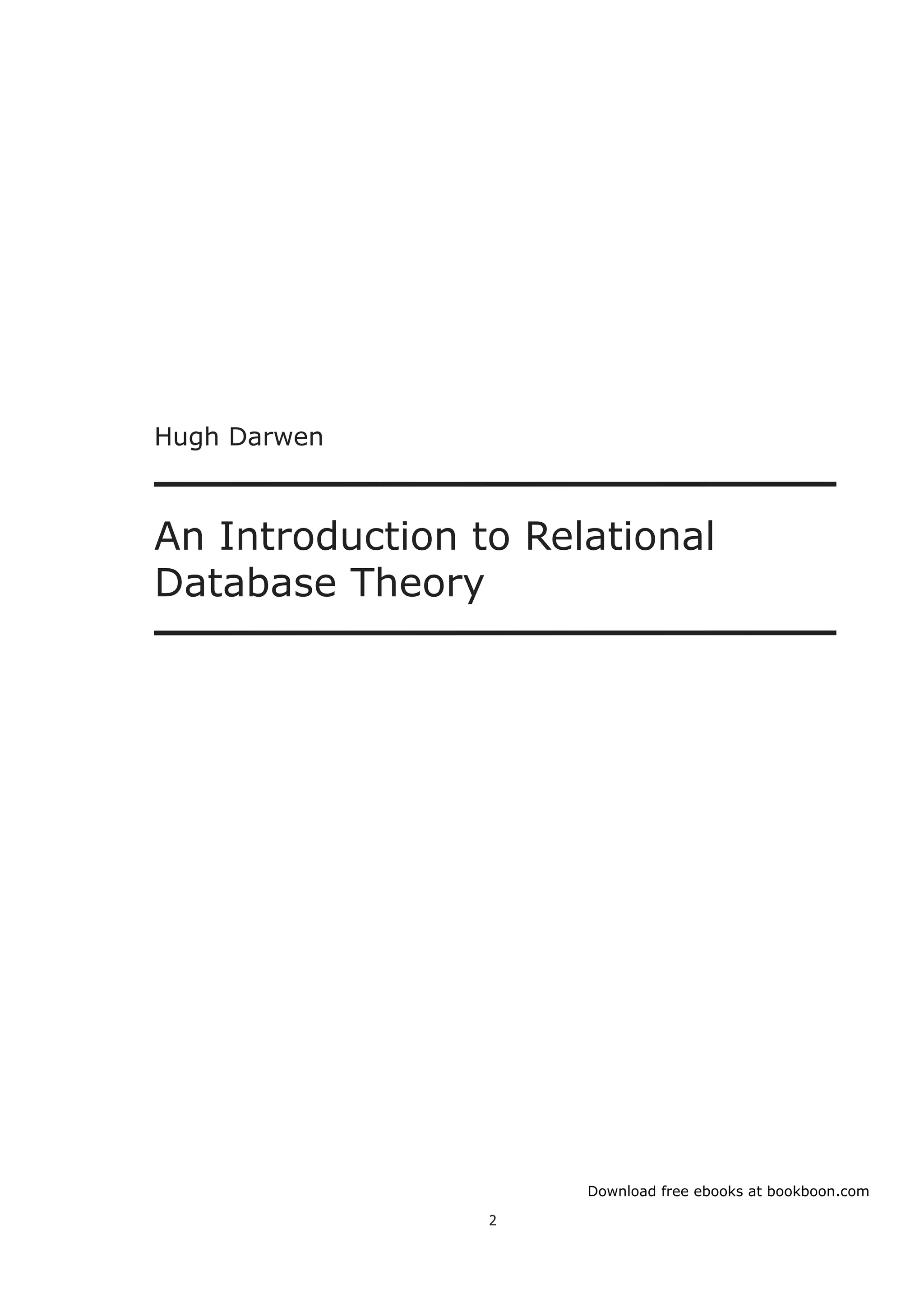
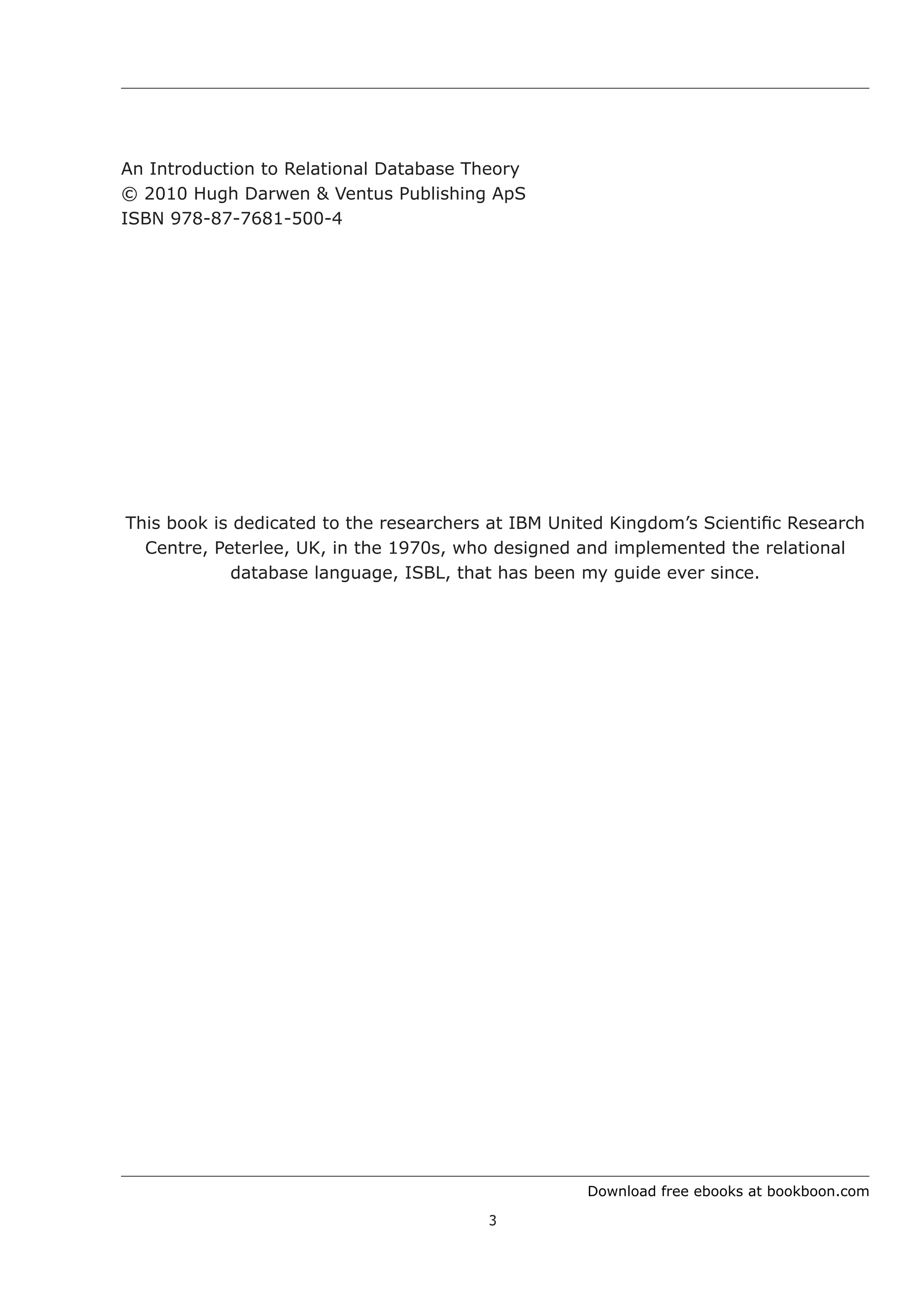
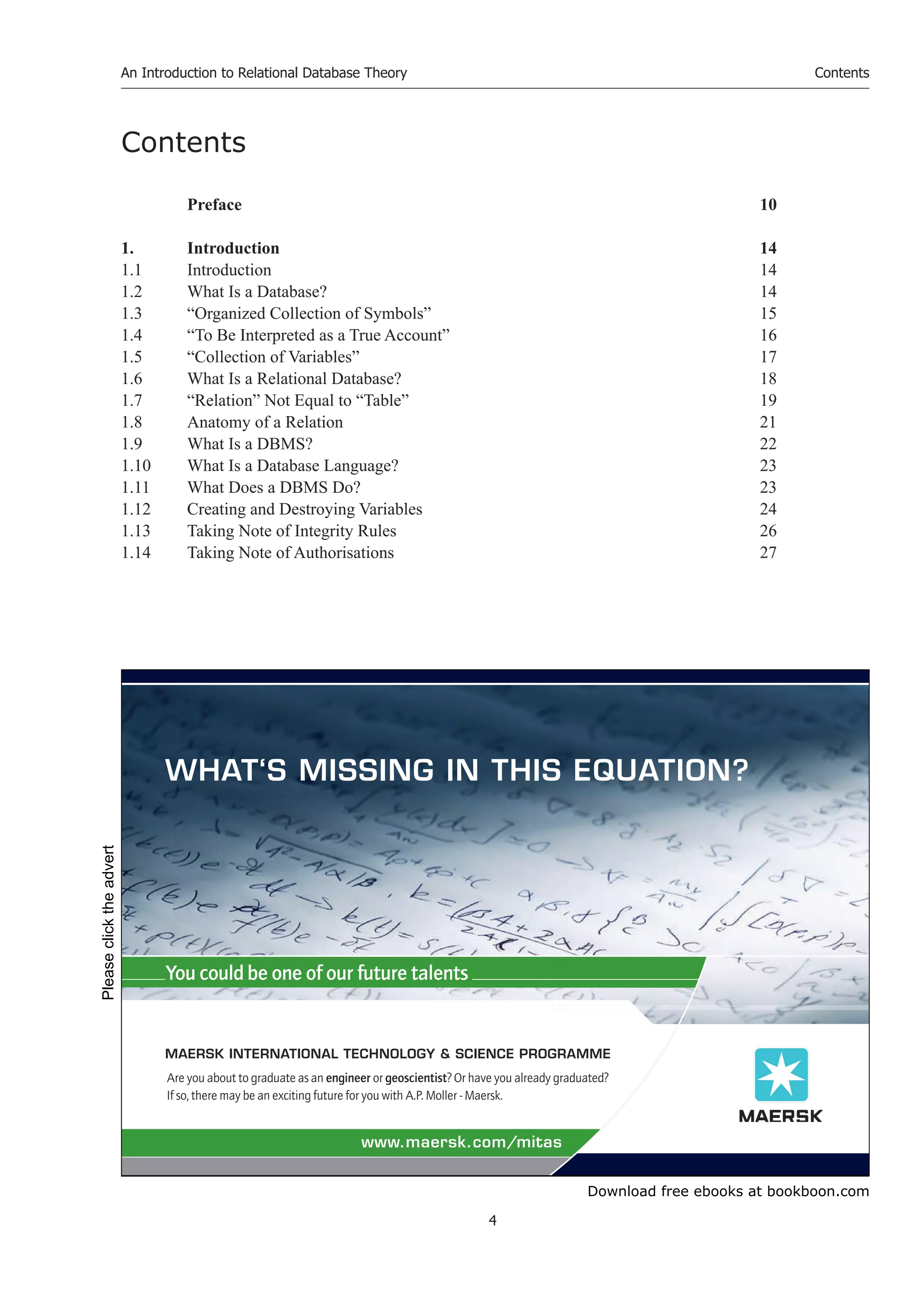

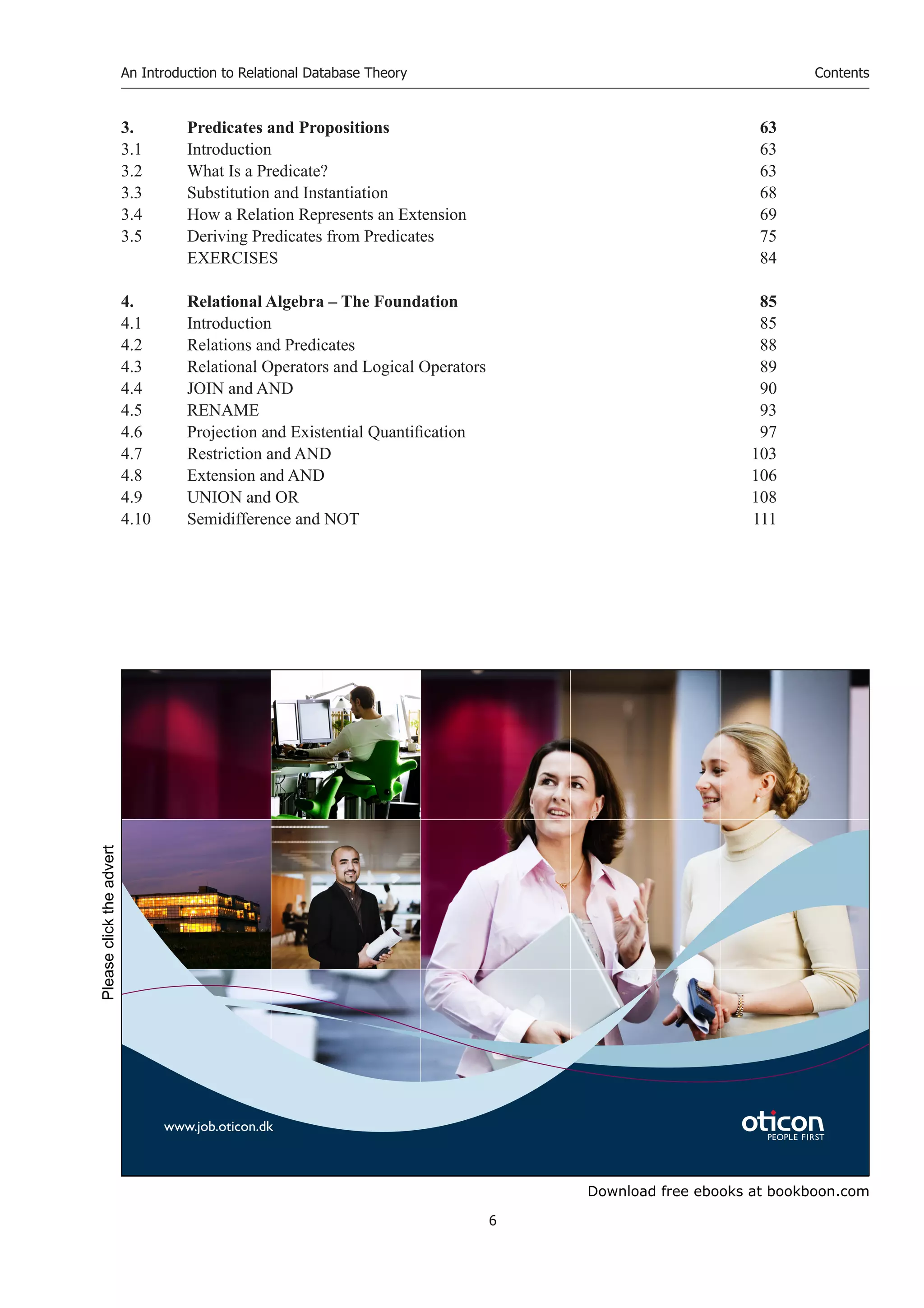



![Download free ebooks at bookboon.com
An Introduction to Relational Database Theory
10
Preface
Preface
This book introduces you to the theory of relational databases, focusing on the application of that theory to
the design of computer languages that properly embrace it. The book is intended for those studying
relational databases as part of a degree course in Information Technology (IT). Relational database
theory, originally proposed by Edgar F. Codd in 1969, is a topic in Computer Science. Codd’s seminal
paper (1970) was entitled A Relational Model of Data for Large Shared Data Banks (reference [5] in
Appendix B).
An introductory course on relational databases offered by a university’s Computer Science (or similarly
named) department is typically broadly divided into a theory component and what we might call an
“industrial” component. The “industrial” component typically teaches the language, SQL (Structured
Query Languagei
), that is widely used in the industry for database purposes, and it might also teach other
topics of current significance in the industry. Although this book is only about the theory, I hope it will be
interesting and helpful to you even if your course’s main thrust is industrial.
The book is directly based on a course of nine lectures delivered annually to undergraduates at the
University of Warwick, England, as part of a 14-lecture module entitled Fundamentals of Relational
Databases. The remaining five lectures of that module are on SQL. We encourage our students to
compare and contrast SQL with what they have learned in the theory part. We explain that study of the
theory, and an example of a computer language based on that theory, should:
enable them to understand the technology that is based on it, and how to use that technology (even
if it is only loosely based on the theory, as is the case with SQL systems);
provide a basis for evaluating and criticizing the current state of the art;
illustrate of some of the generally accepted principles of good computer language design;
equip those who might be motivated in their future careers to bring about change for the better in
the database industry.
Examples and exercises in this book all use a language, Tutorial D, invented by the author and C.J. Date
for the express purpose of teaching the subject matter at hand. Implementations of Tutorial D, which is
described in reference [11], are available as free software on the Web. The one we use at the University of
Warwick is called Rel, made by Dave Voorhis of the University of Derby. Rel is freely available at
http://dbappbuilder.sourceforge.net/Rel.html.
This book is accompanied by Exercises in Relational Database Theory, in which the exercises given at the
end of each chapter (except the last) are copied and a few further exercises have been added. Sample
solutions to all the exercises are provided and the reader is strongly recommended to study these solutions
(preferably after attempting the exercises!).
The book consists of eight chapters and two appendixes, as follows.](https://image.slidesharecdn.com/an-introduction-to-relational-database-theory-230210032734-035be350/75/an-introduction-to-relational-database-theory-pdf-10-2048.jpg)
![Download free ebooks at bookboon.com
An Introduction to Relational Database Theory
11
Preface
Chapter 1, Introduction, is based on my first lecture and gives a broad overview of what a database is,
what a relational database is, what a database management system (DBMS) is, what a DBMS is expected
to do, and how a relational DBMS does those things.
In Chapter 2, Values, Types, Variables, Operators, based on my second lecture, we look at the four
fundamental concepts on which most computer languages are based. We acquire some useful terminology
to help us talk about these concepts in a precise way, and we begin to see how the concepts apply to
relational database languages in particular.
Relational database theory is based very closely on logic. Fortunately, perhaps, in-depth knowledge
and understanding of logic are not needed. Chapter 3, Predicates and Propositions, based on my
third lecture, teaches just enough of that subject for our present purposes, without using too much
formal notation.
Chapter 4, Relational Algebra – The Foundation, based on material from lectures 4 and 5, describes
the set of operators that is commonly accepted as forming a suitable basis for writing a special kind of
expression that is used for various purposes in connection with a relational databasenotably, queries
and constraints.
Chapter 5, Building on The Foundation, describes additional operators that are defined in Tutorial D
(lectures 5-6) to illustrate some of the additional kinds of things that are needed in a relational database
language for practical purposes.
Chapter 6, Constraints and Updating, based on lecture 7, describes the operators that are typically used
for updating relational databases, and the methods by which database integrity rules are expressed to a
relational DBMS, declaratively, as constraints.
The final two chapters address various issues in relational database design. Chapter 7, Database Design I:
Projection-Join Normalization, based on lectures 8 and 9, deals with one particularly important issue
that has been the subject of much research over the years. Chapter 8, Database Design II: Other Issues,
discusses some other common issues that are not so well researched. These are not dealt with in my
lectures but they sometimes arise in the annual course work assigned to our students.
Tutorial D was revised very slightly shortly after publication of this book. The revised version is given in
reference [10]. Because the revisions have not yet (as of March, 2011) been incorporated into Rel, this
book continues to use the unrevised definition, Version 1. The revisions in Version 2 are listed in
Appendix A and the relevant chapter in [10] is available for download from www.thethirdmanifesto.com.
References and bibliography are in Appendix B.
Note to Teachers
Over the years since 1970 there have been many books covering relational database theory. I have aimed
for several distinguishing features in this one, namely:](https://image.slidesharecdn.com/an-introduction-to-relational-database-theory-230210032734-035be350/75/an-introduction-to-relational-database-theory-pdf-11-2048.jpg)
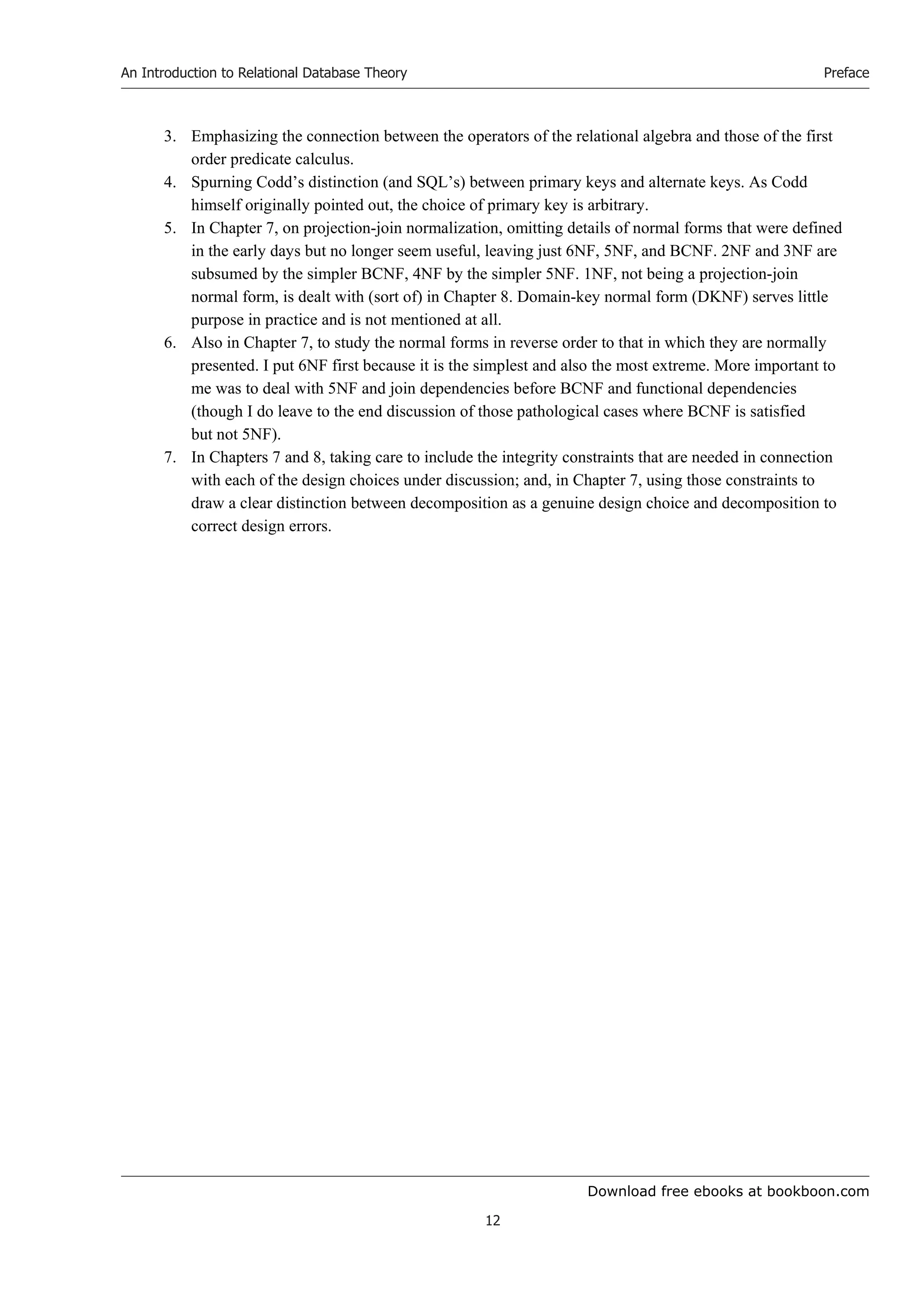
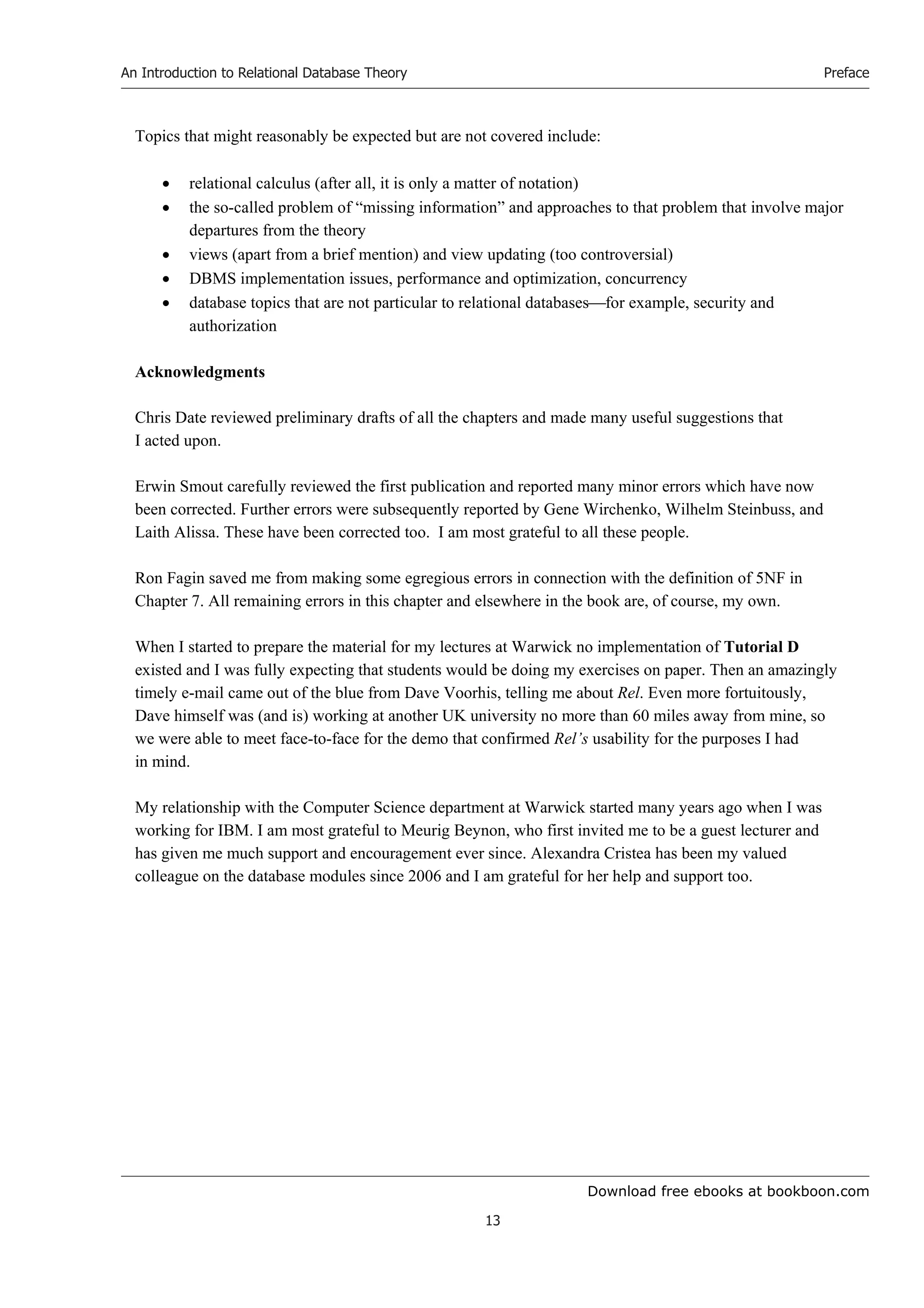
![Download free ebooks at bookboon.com
An Introduction to Relational Database Theory
14
Introduction
1. Introduction
1.1 Introduction
This chapter gives a very broad overview of
what a database is
what a relational database is, in particular
what a database management system (DBMS) is
what a DBMS does
how a relational DBMS does what a DBMS does
We start to familiarise ourselves with terminology and notation used in the remainder of the book, and we
get a brief introduction to each topic that is covered in more detail in later sections.
1.2 What Is a Database?
You will find many definitions of this term if you look around the literature and the Web. At one time (in
2008), Wikipedia [1] offered this: “A structured collection of records or data.” I prefer to elaborate a little:
A database is an organized, machine-readable collection of symbols, to
be interpreted as a true account of some enterprise. A database is
machine-updatable too, and so must also be a collection of variables. A
database is typically available to a community of users, with possibly
varying requirements.
The organized, machine-readable collection of symbols is what you “see” if you “look at” a database at a
particular point in time. It is to be interpreted as a true account of the enterprise at that point in time. Of
course it might happen to be incorrect, incomplete or inaccurate, so perhaps it is better to say that the
account is believed to be true.
The alternative view of a database as a collection of variables reflects the fact that the account of the
enterprise has to change from time to time, depending on the frequency of change in the details we choose
to include in that account.
The suitability of a particular kind of database (such as relational, or object-oriented) might depend to
some extent on the requirements of its user(s). When E.F. Codd developed his theory of relational
databases (first published in 1969), he sought an approach that would satisfy the widest possible ranges of
users and uses. Thus, when designing a relational database we do so without trying to anticipate specific
uses to which it might be put, without building in biases that would favour particular applications. That is
perhaps the distinguishing feature of the relational approach, and you should bear it in mind as we explore
some of its ramifications.](https://image.slidesharecdn.com/an-introduction-to-relational-database-theory-230210032734-035be350/75/an-introduction-to-relational-database-theory-pdf-14-2048.jpg)
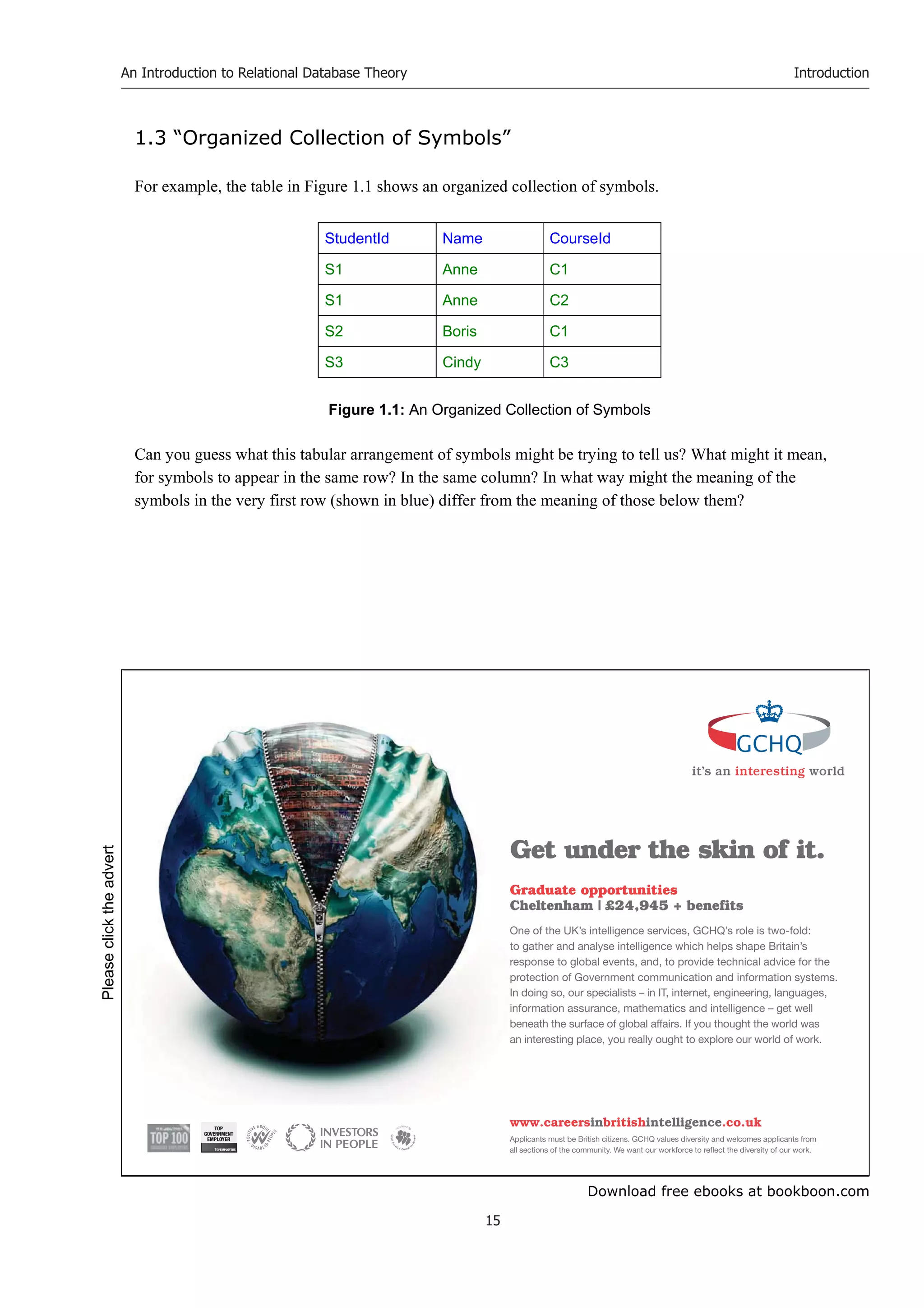
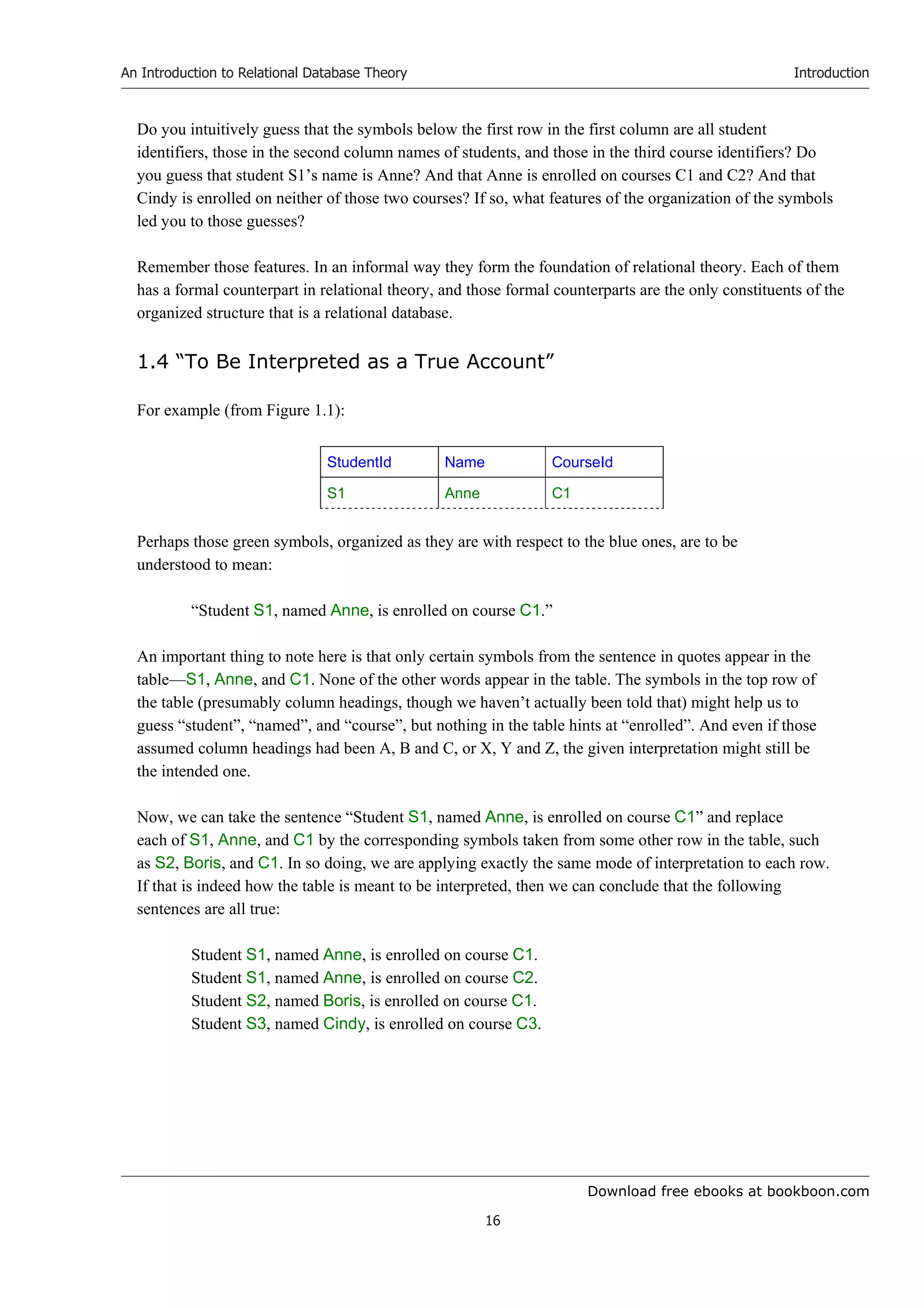

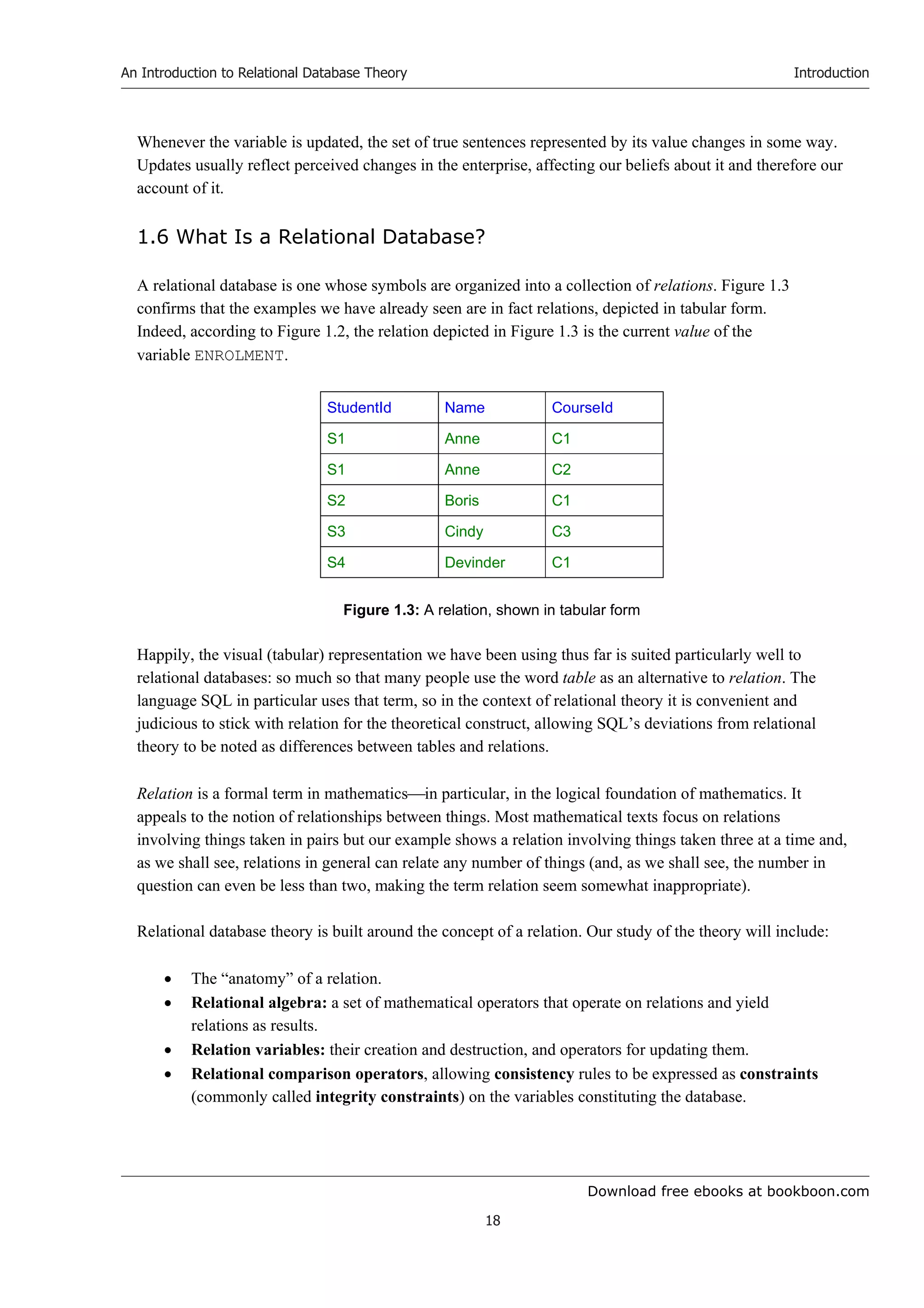
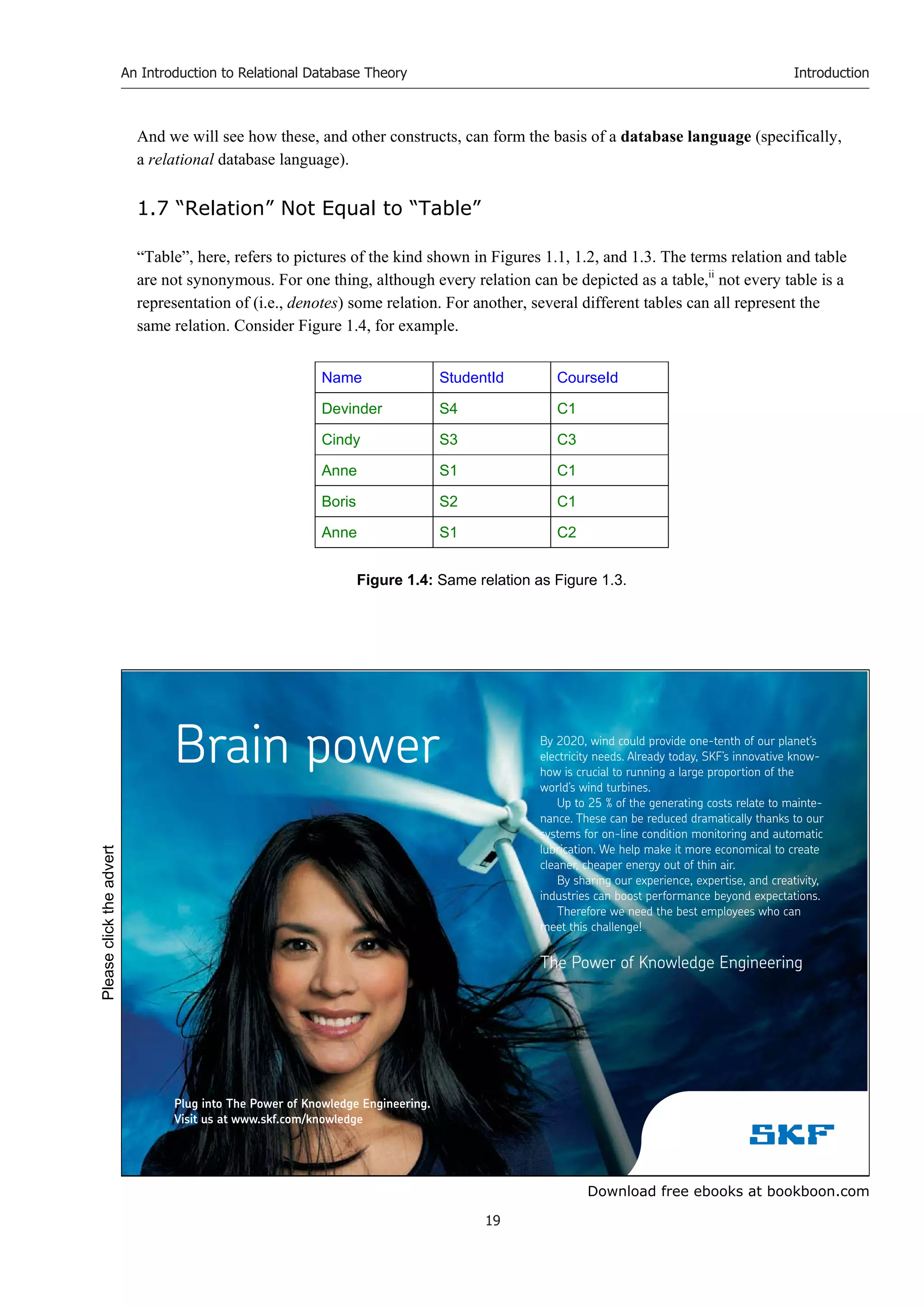
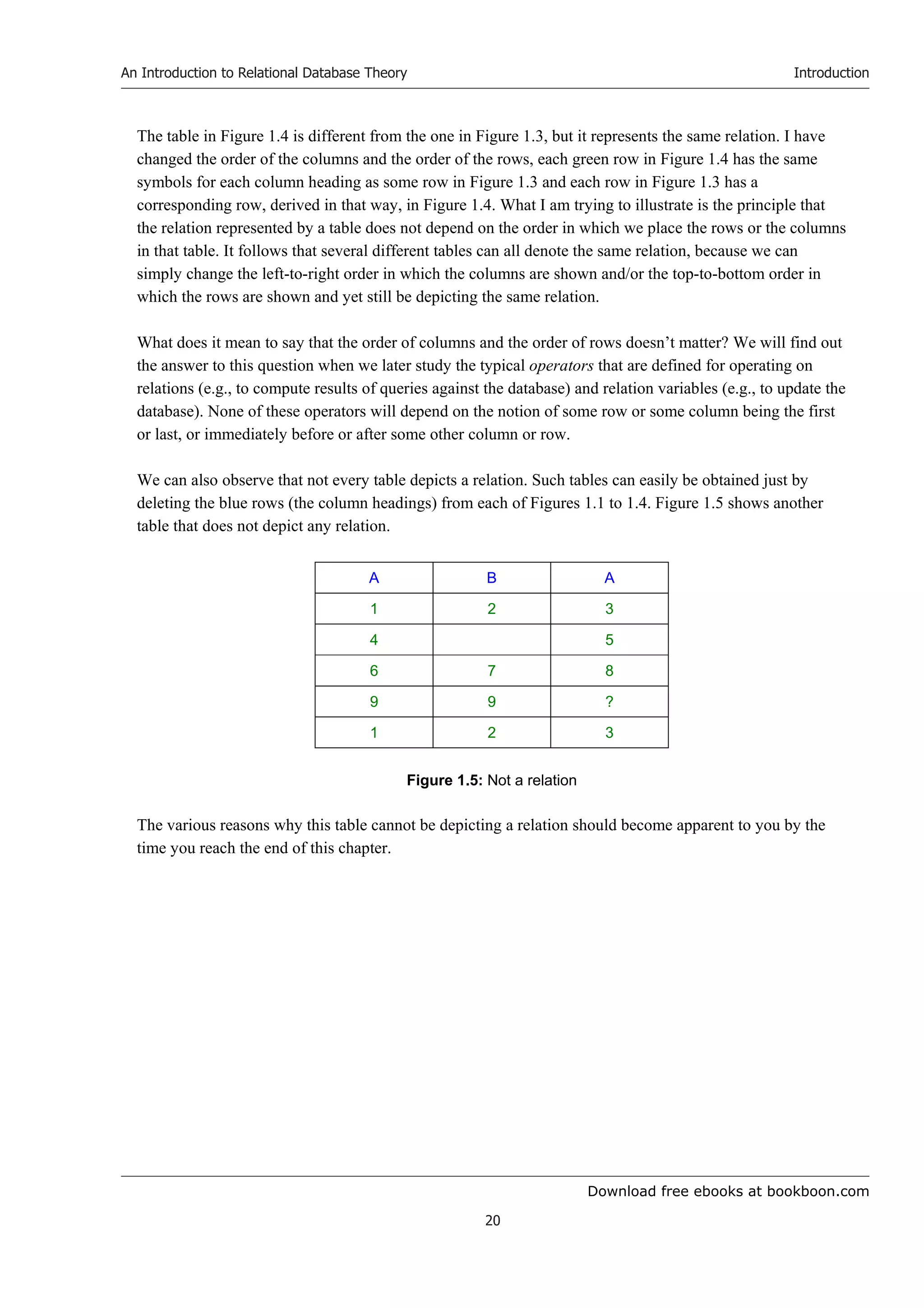
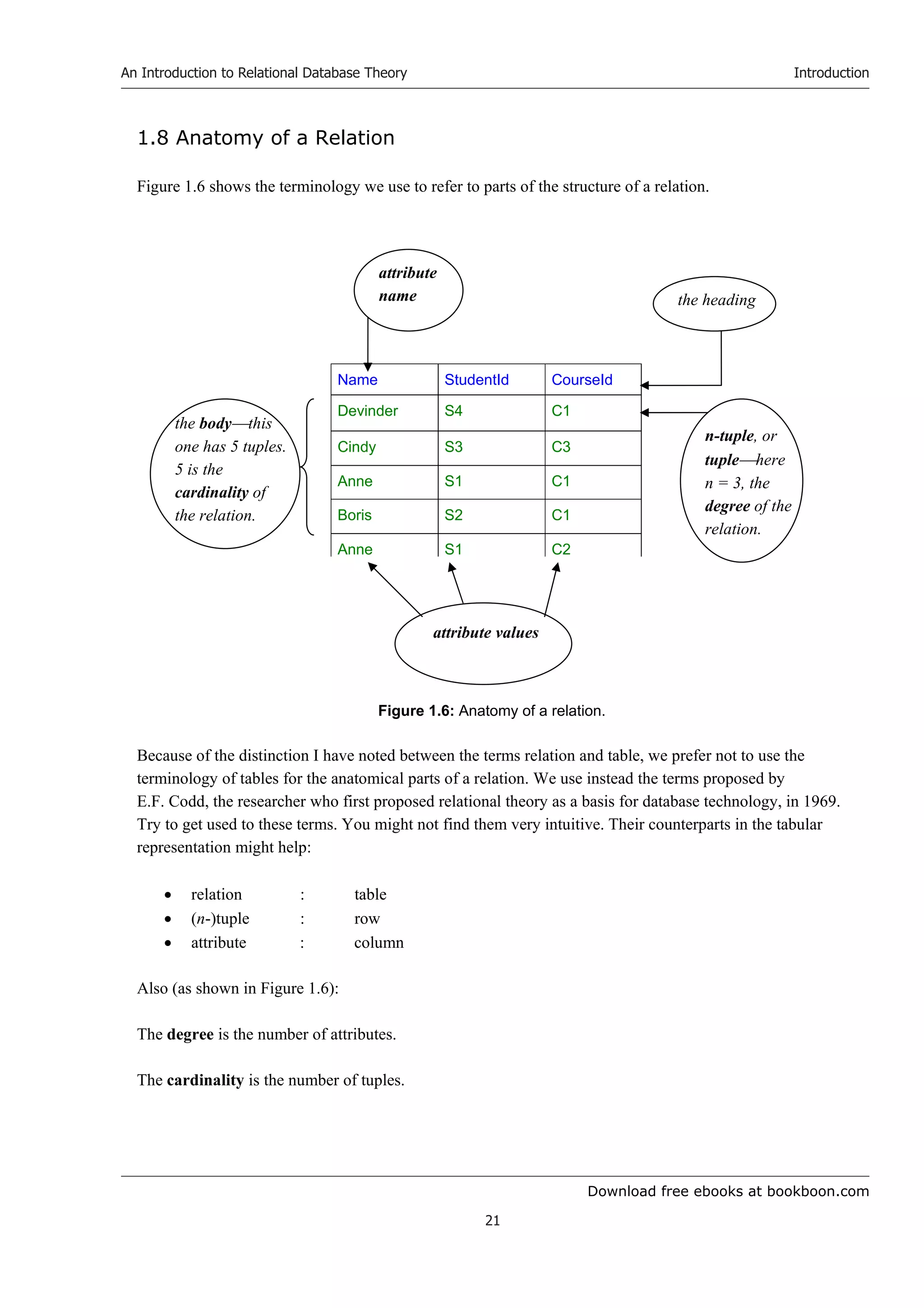
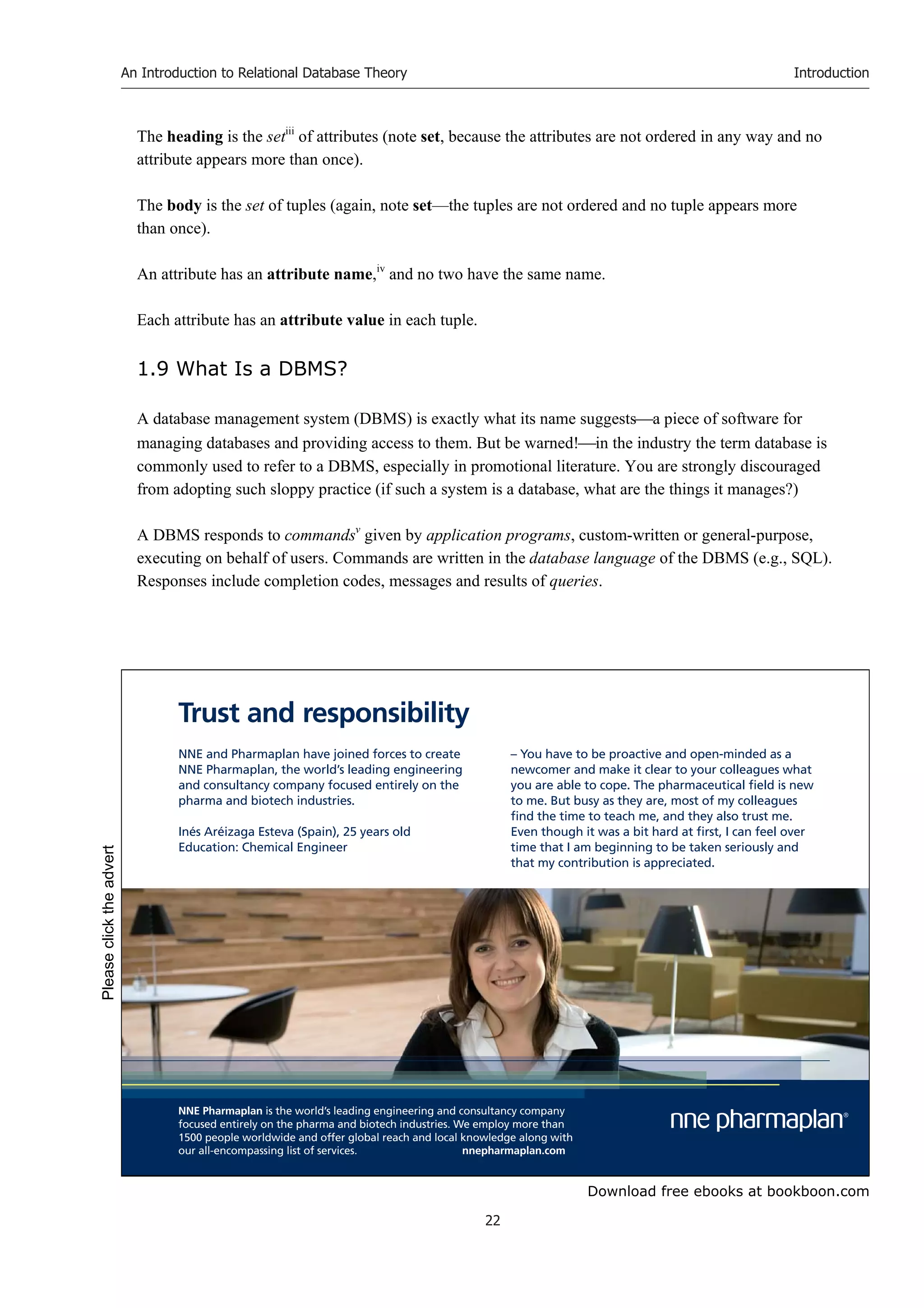
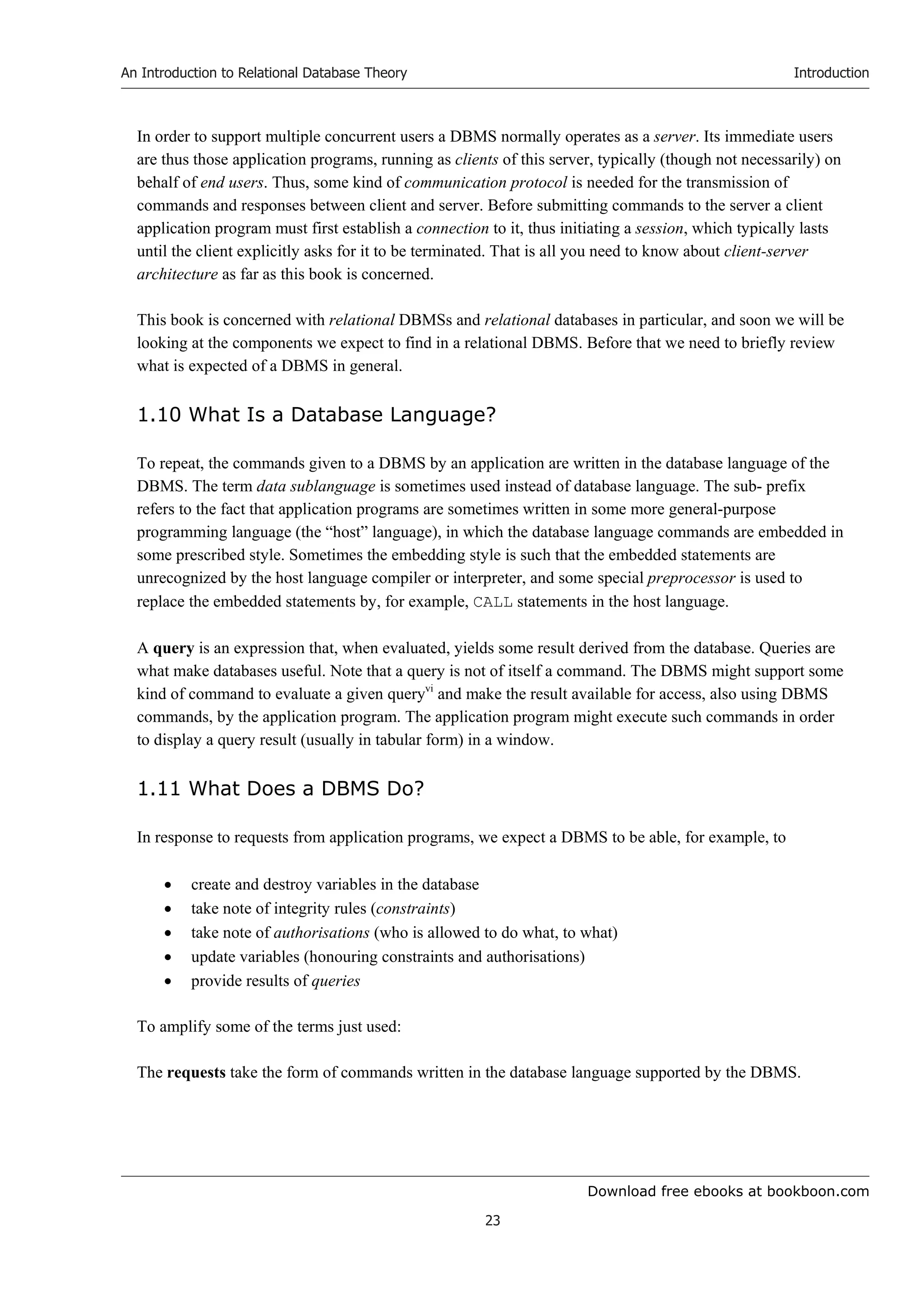

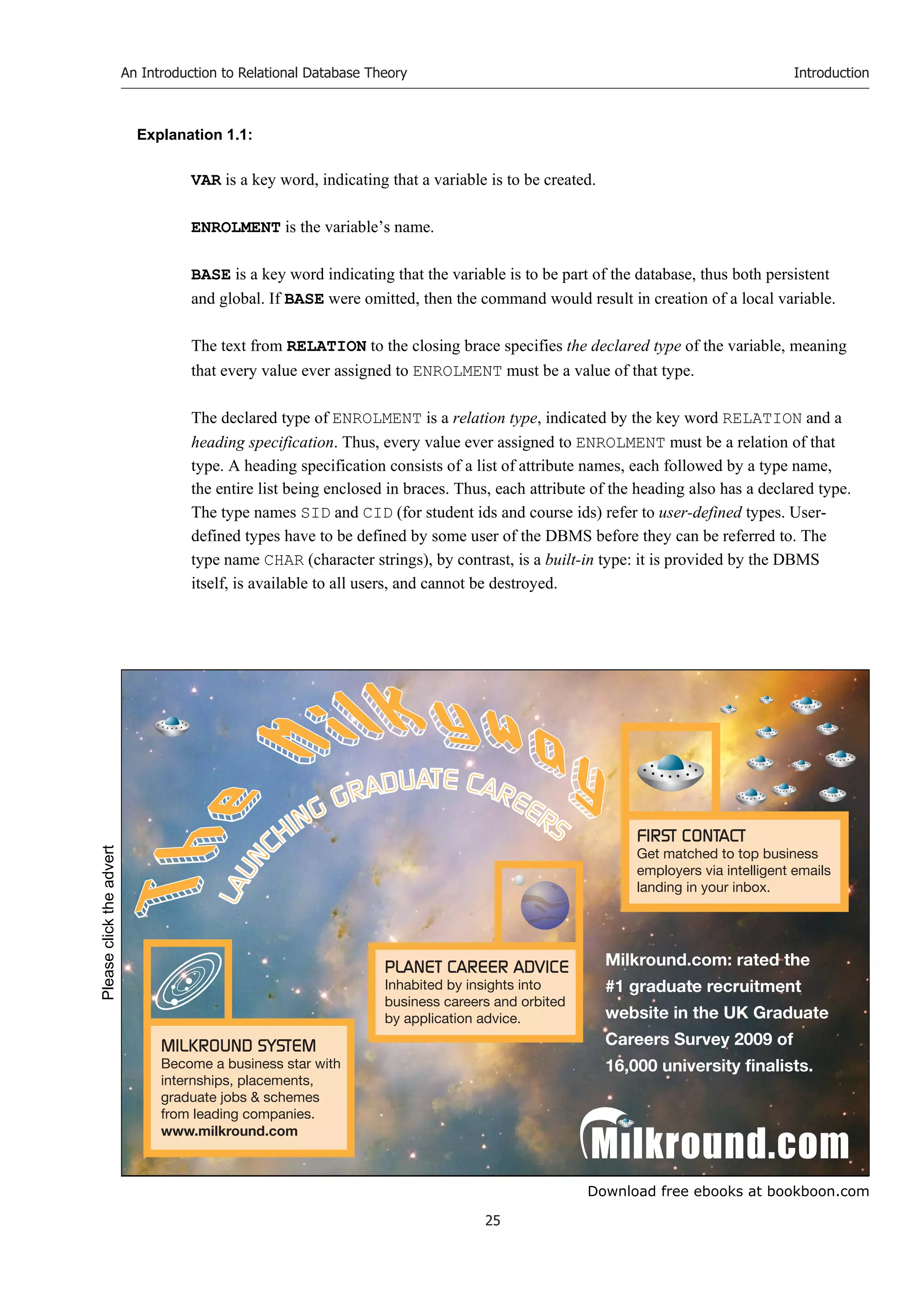

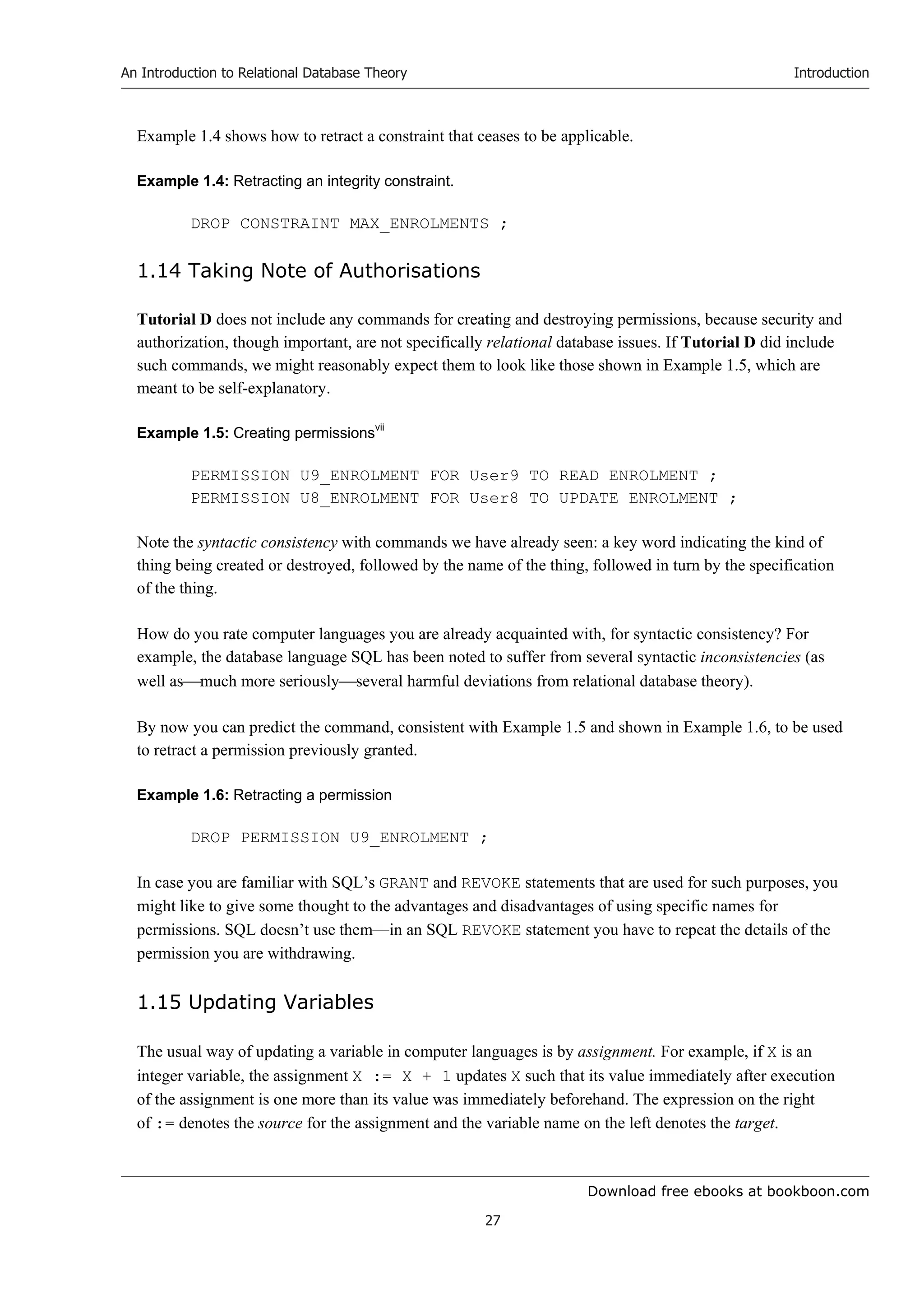
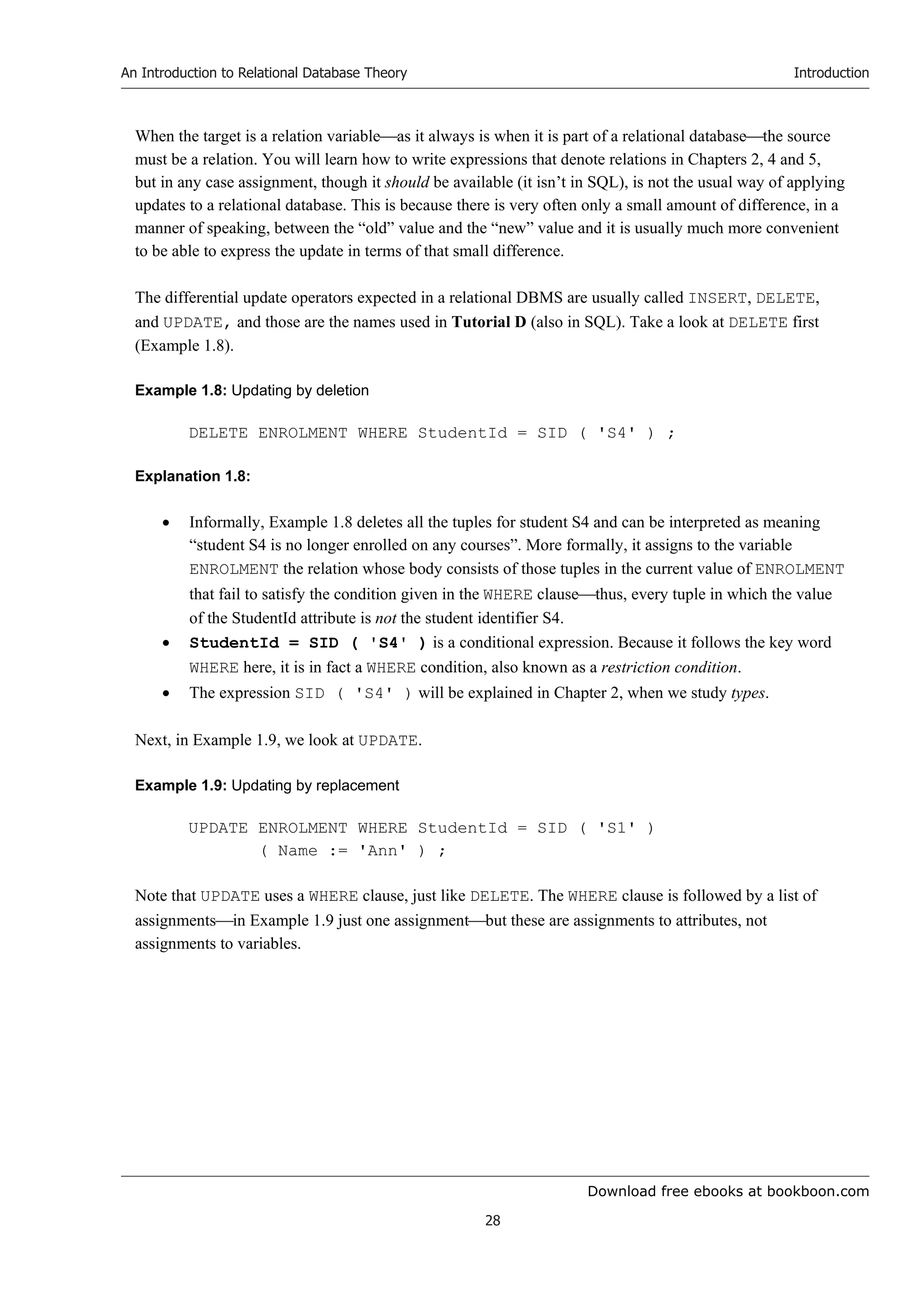
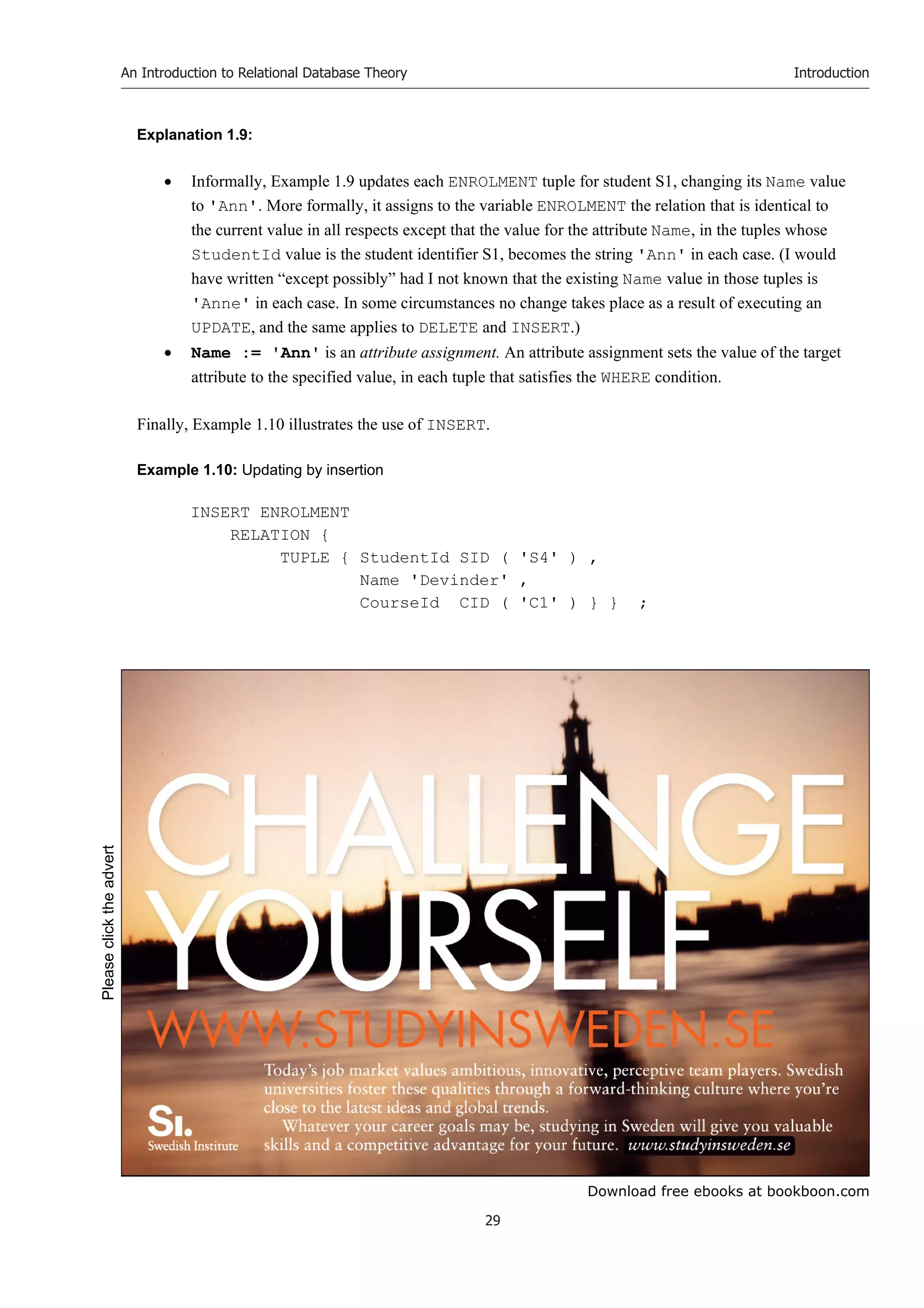
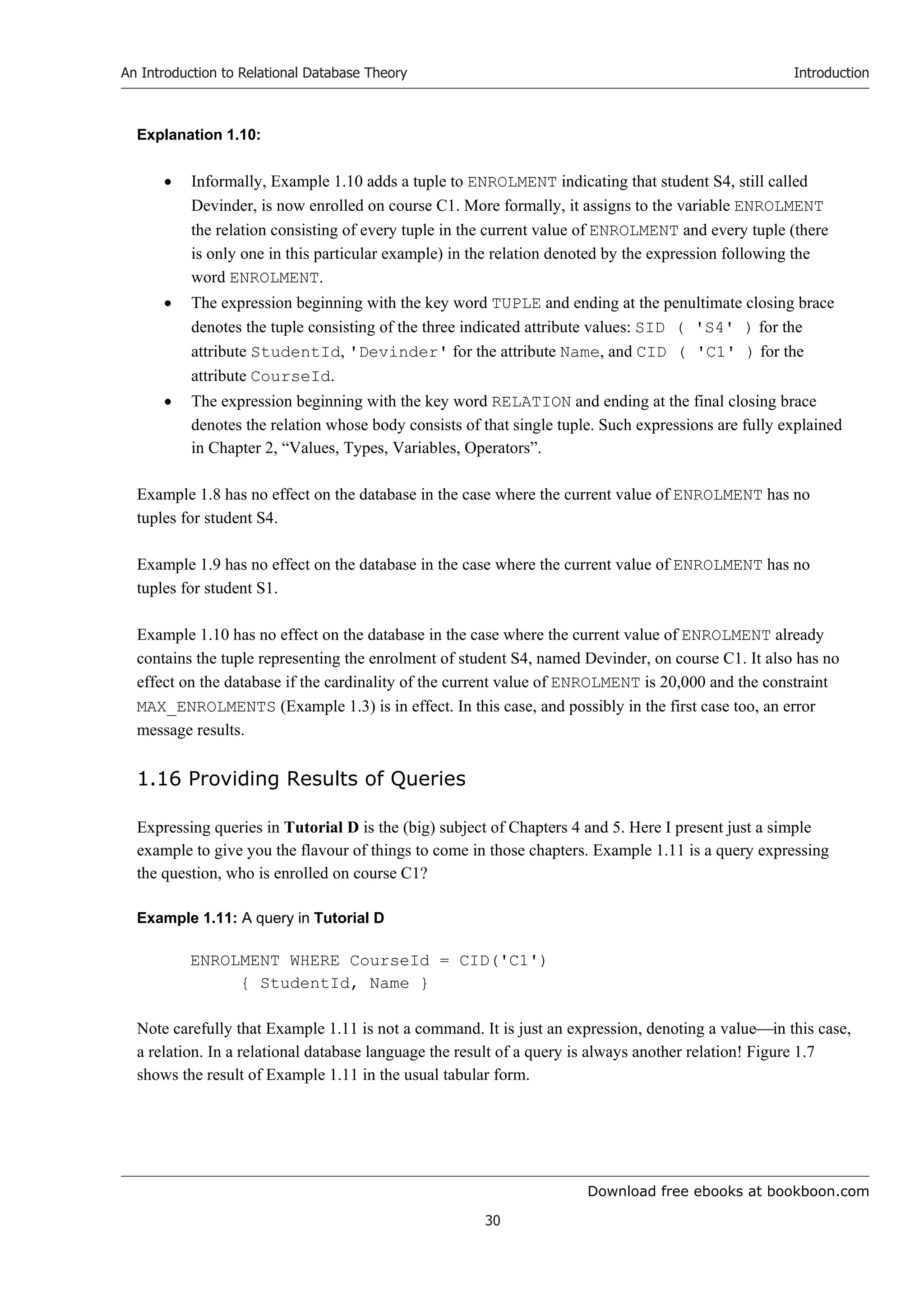
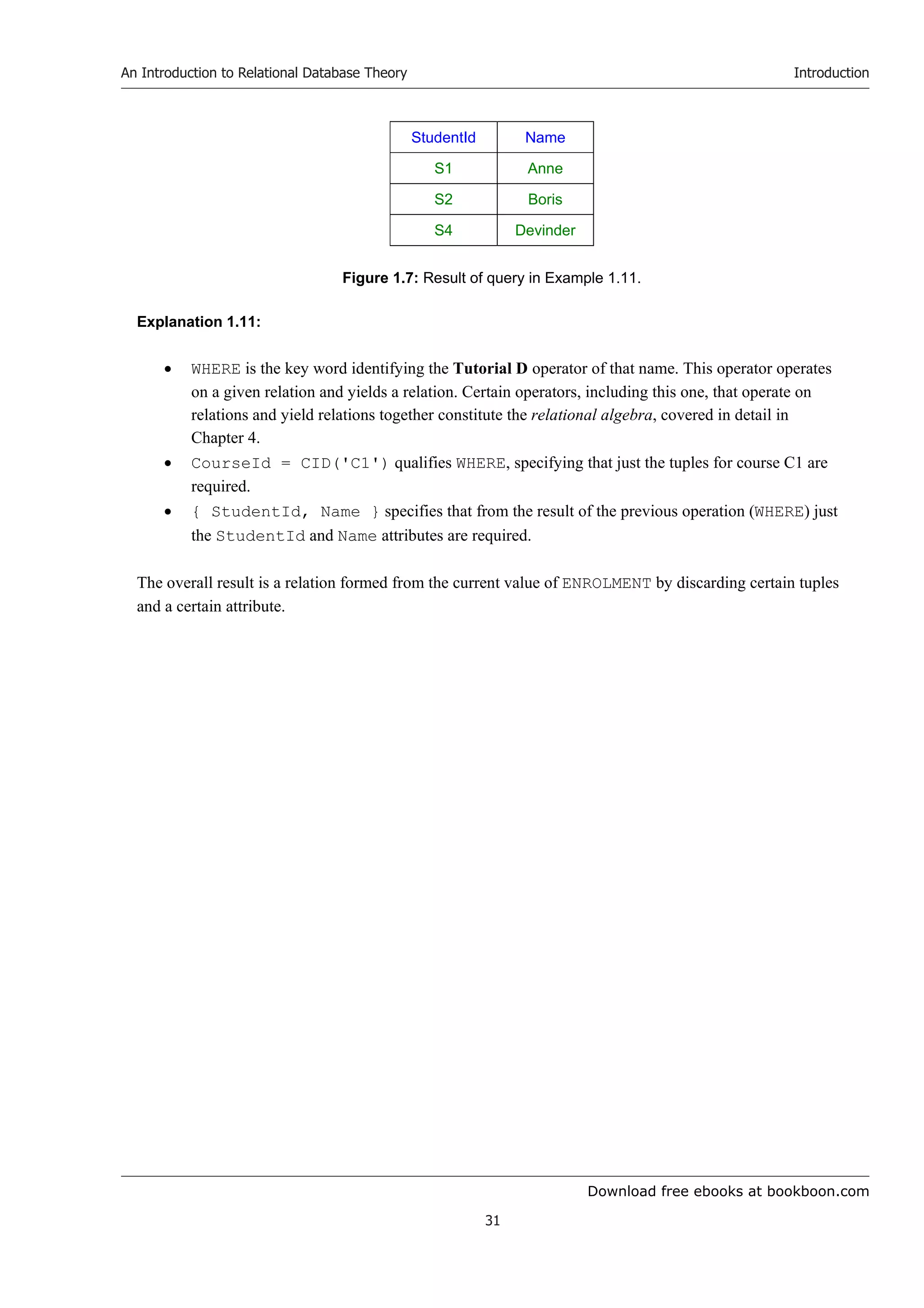
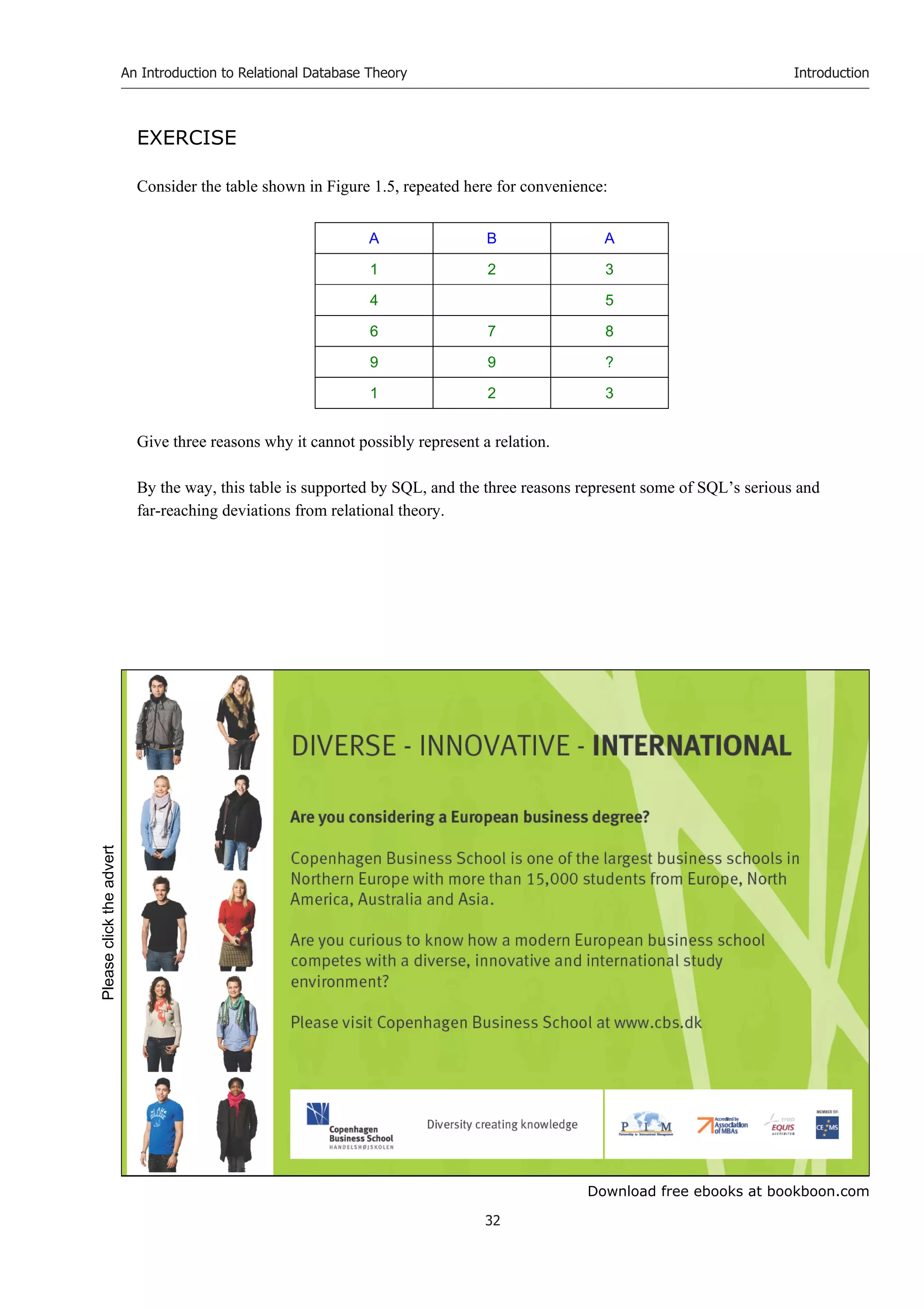

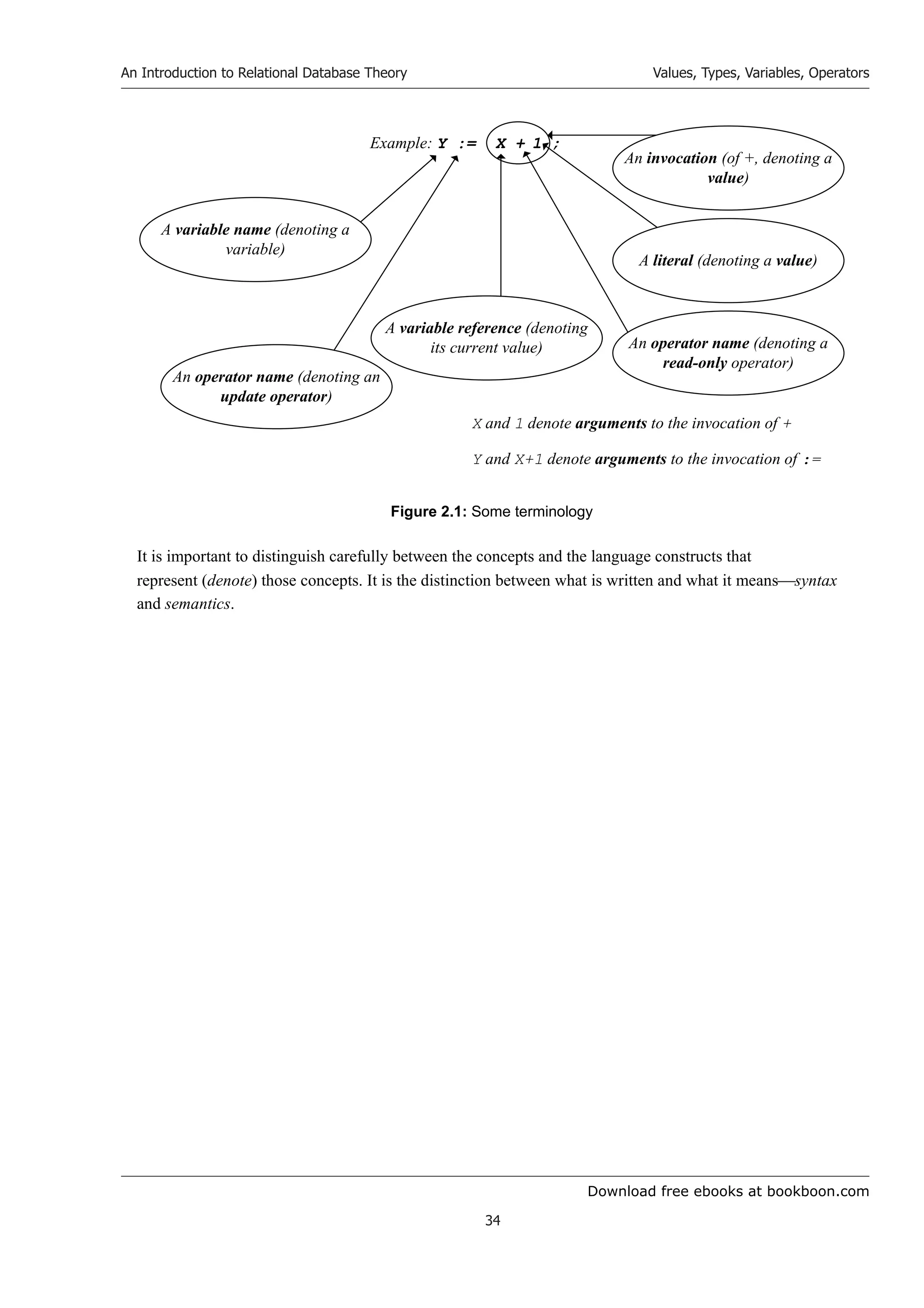
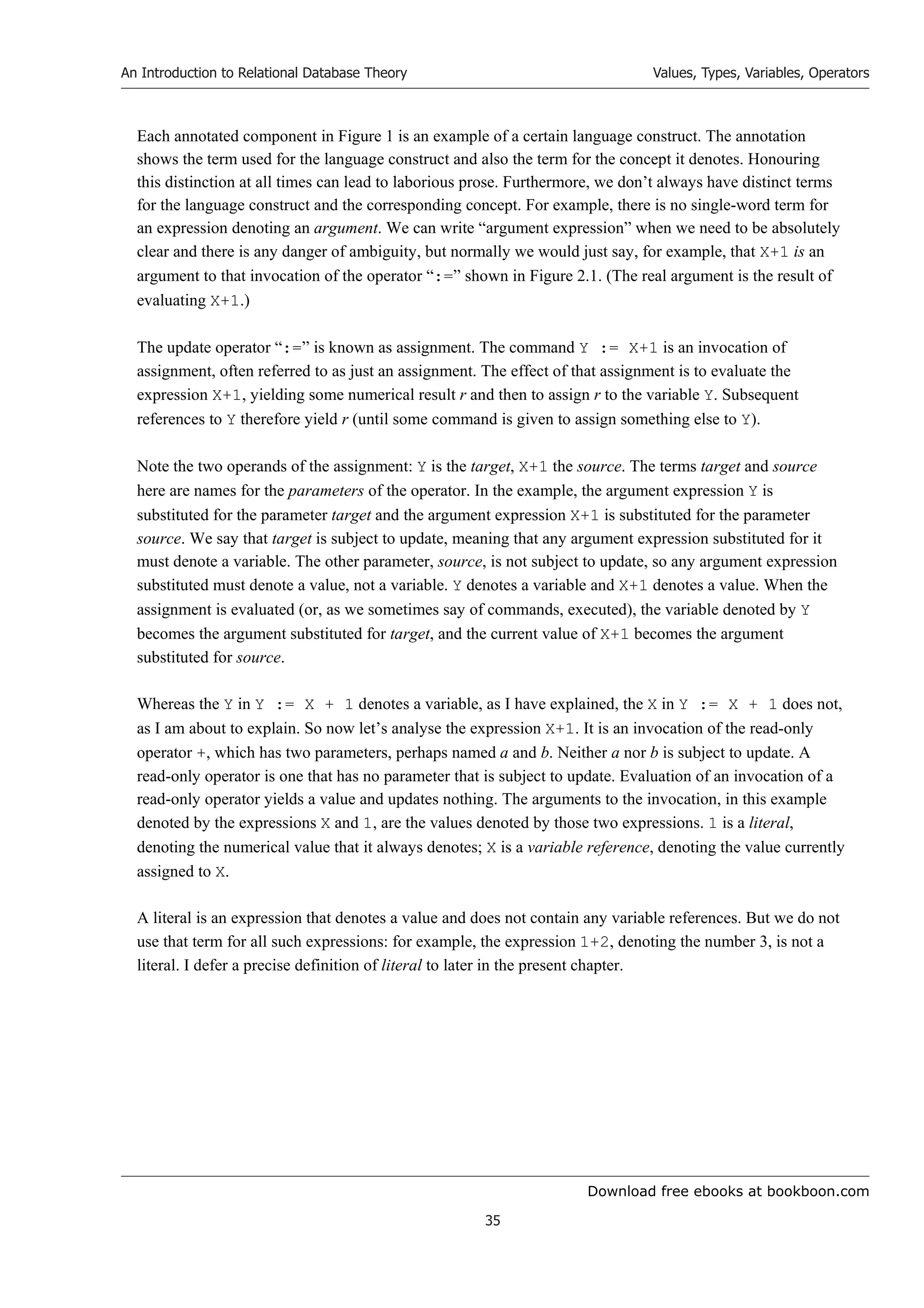
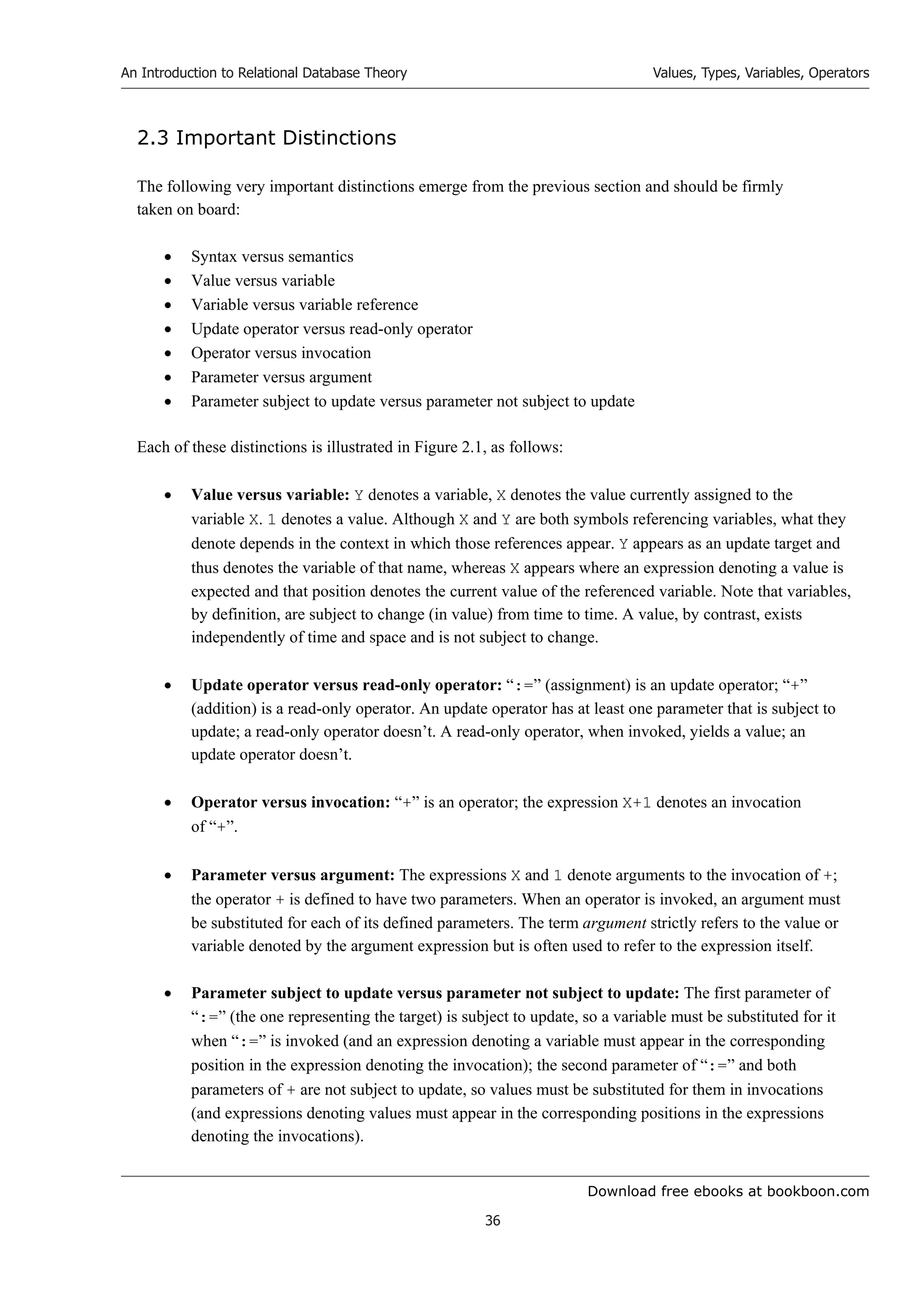
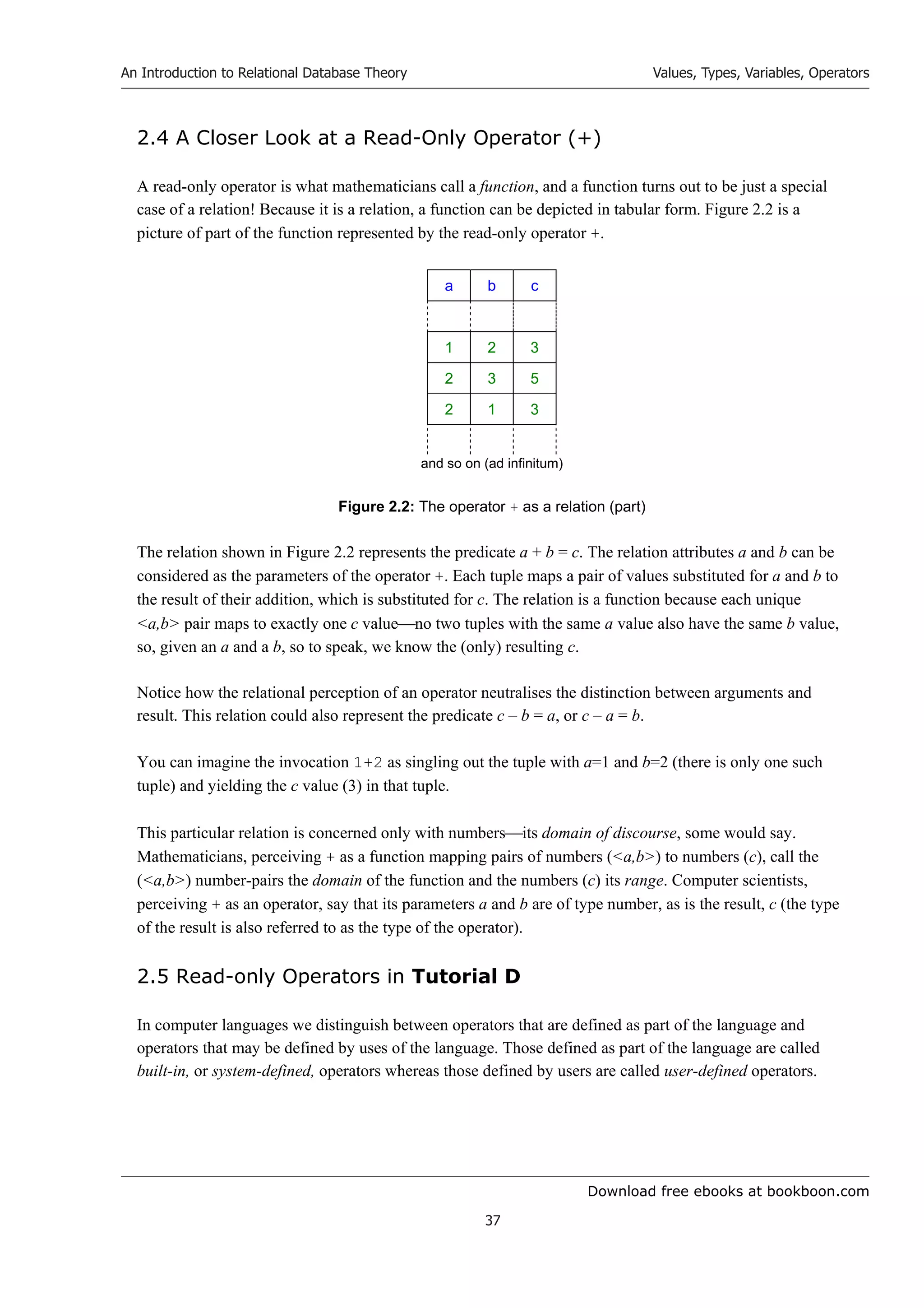
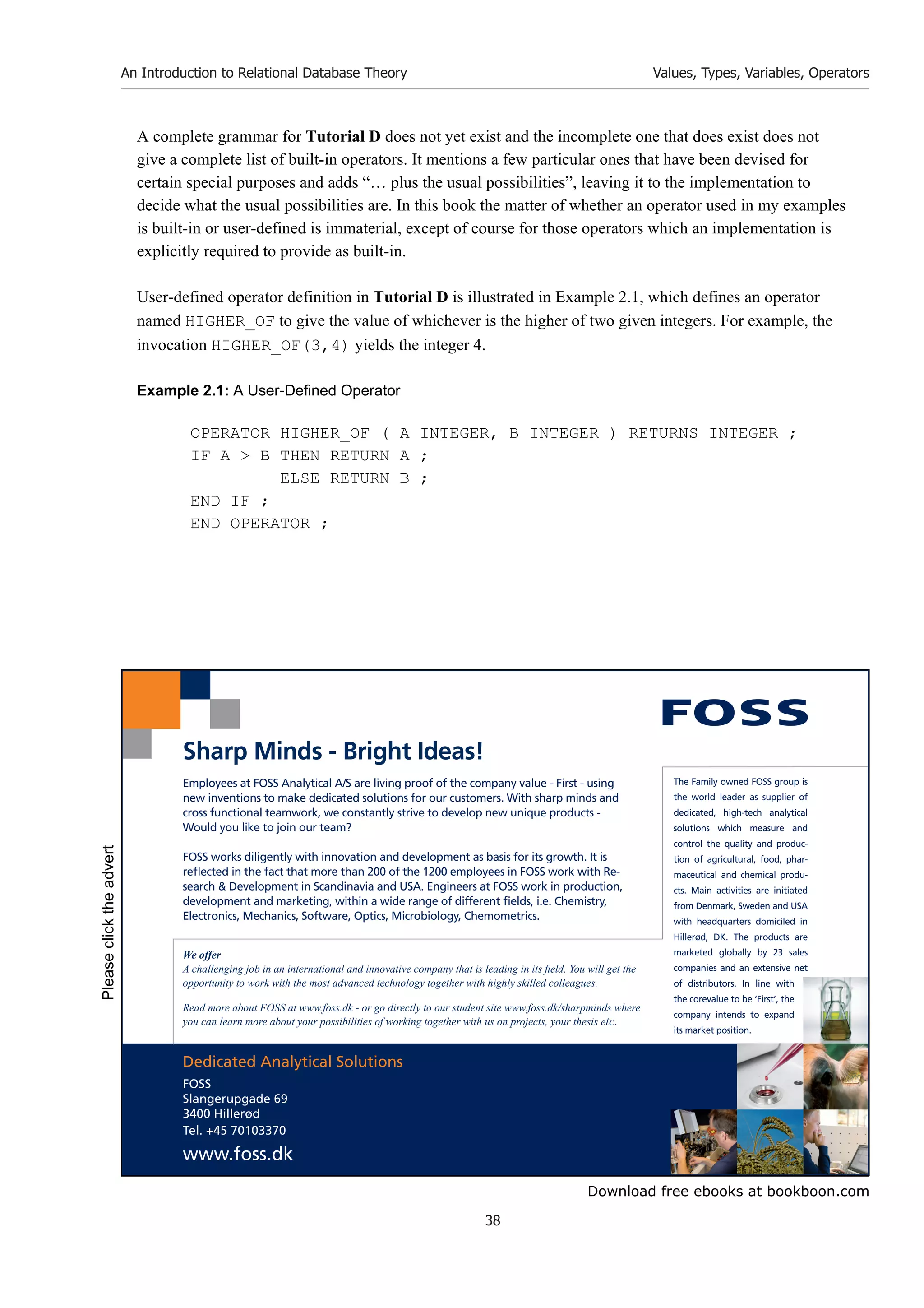
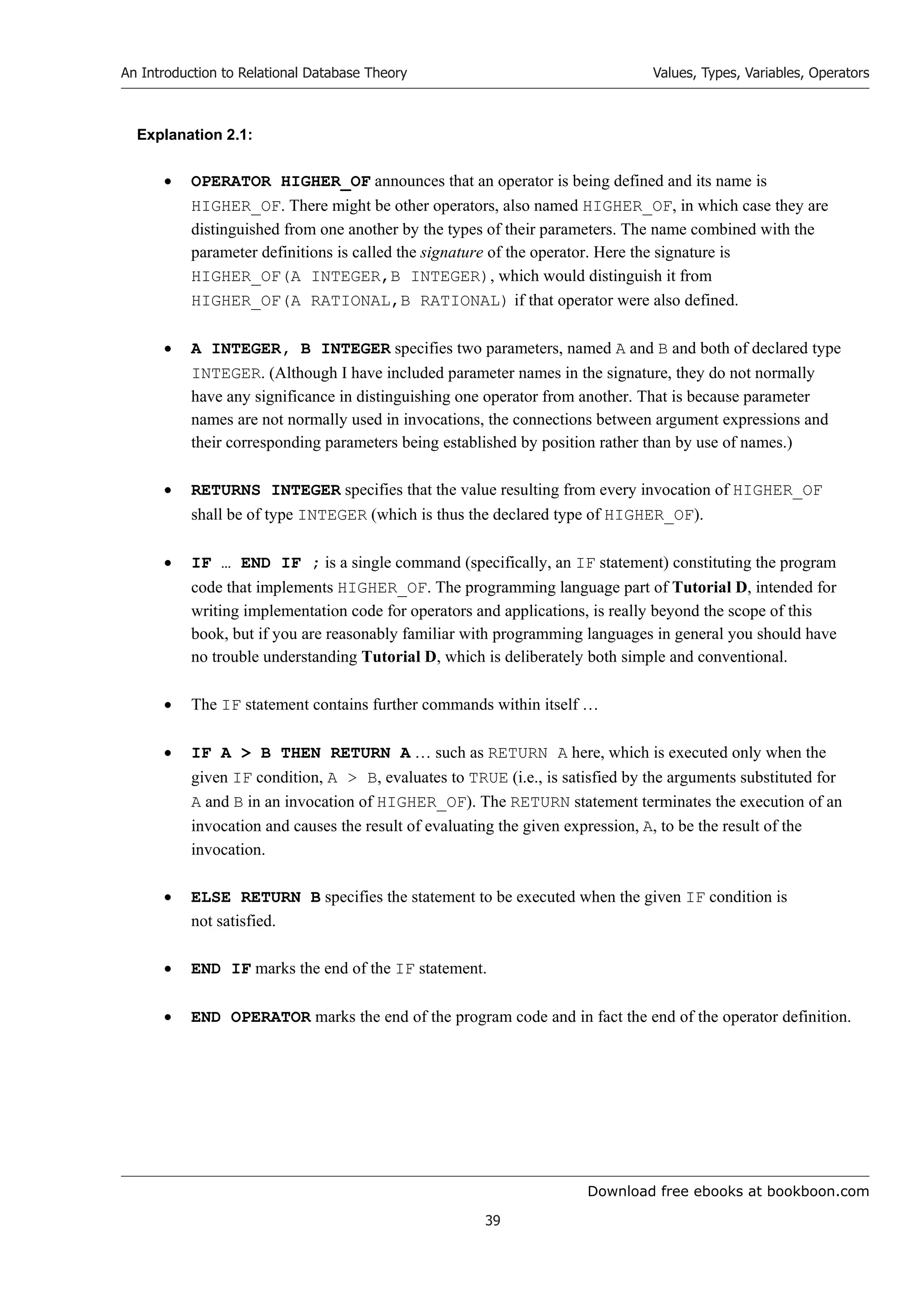
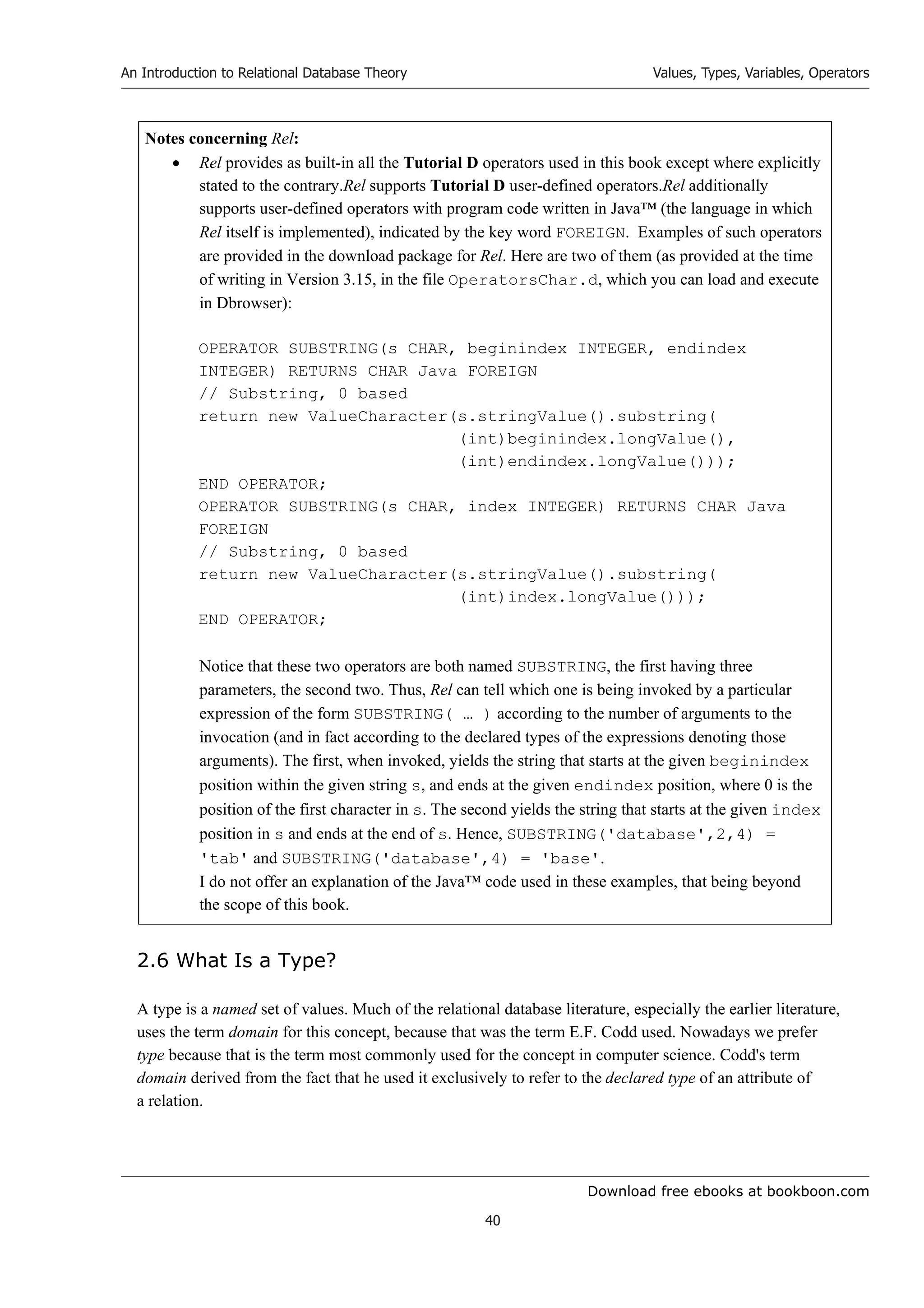
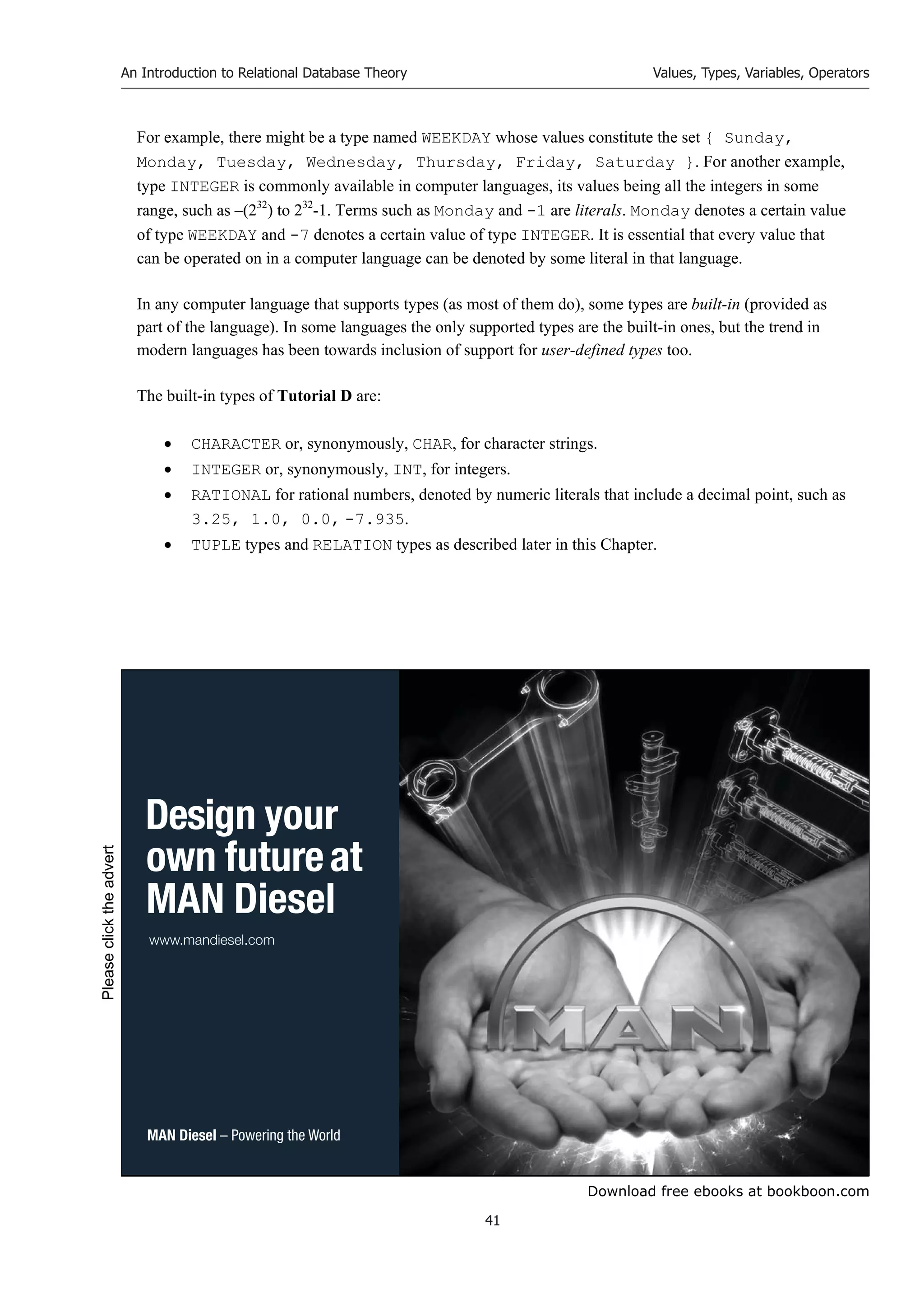
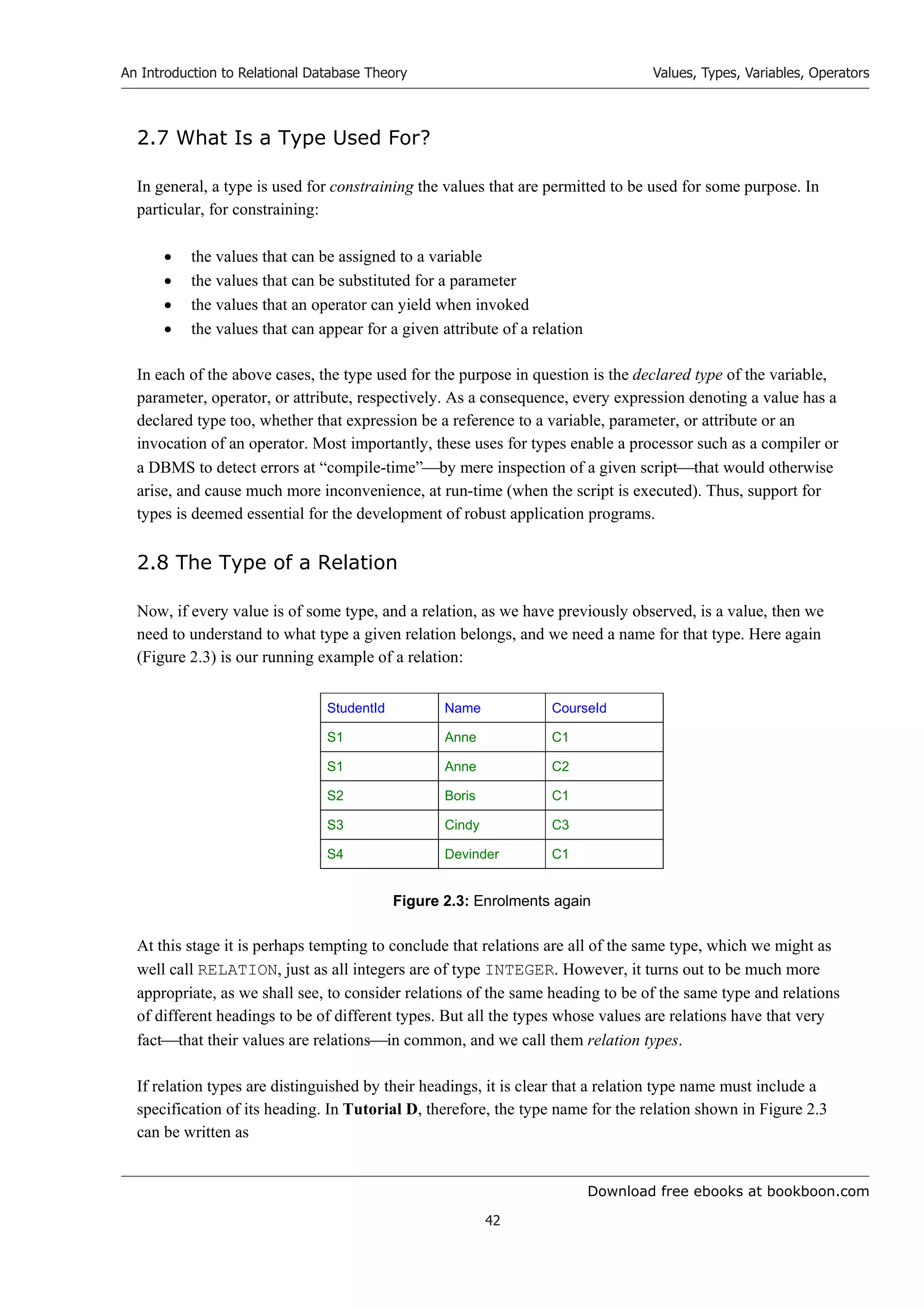

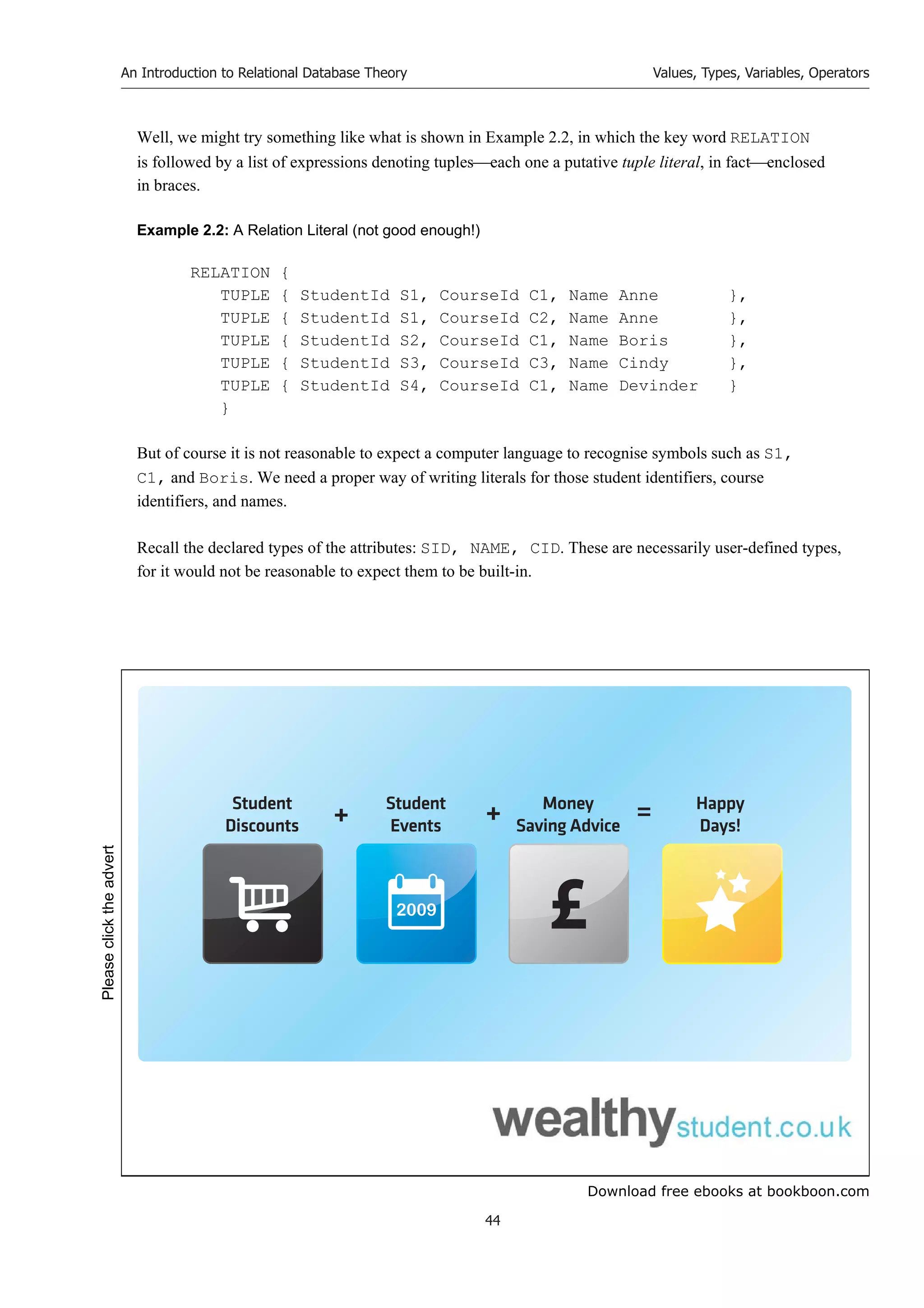
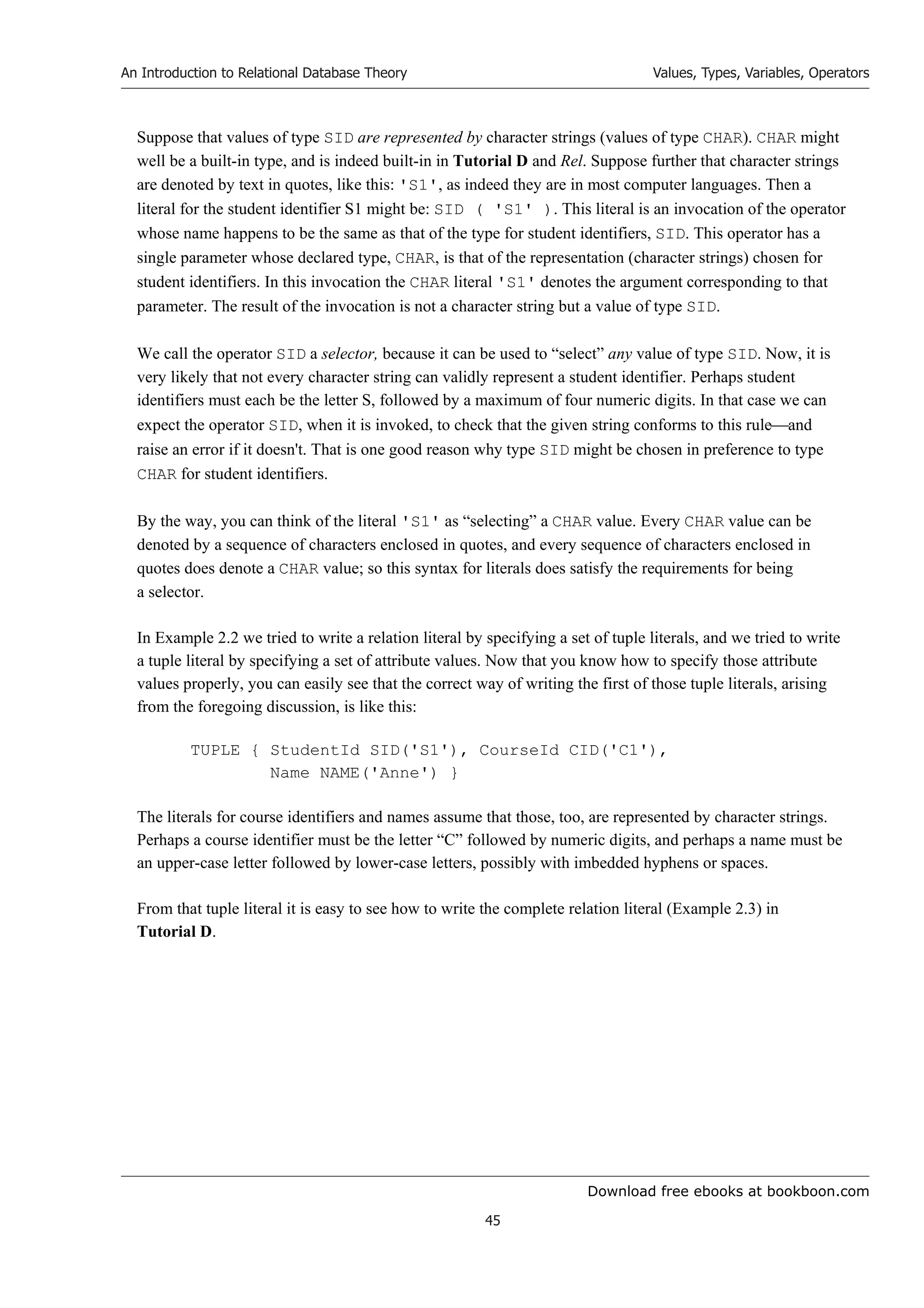
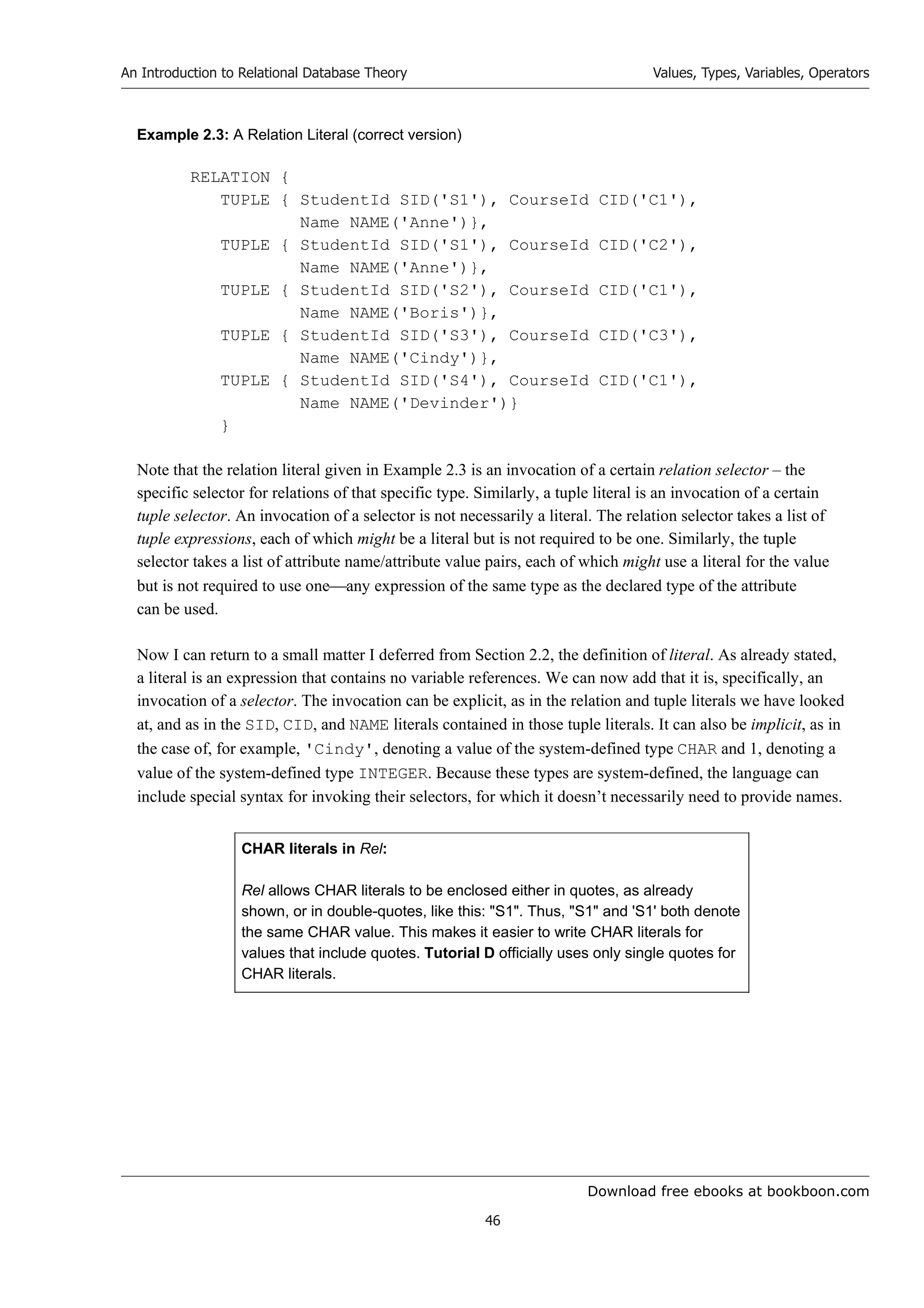
![Download free ebooks at bookboon.com
An Introduction to Relational Database Theory
47
Values, Types, Variables, Operators
2.10 Types and Representations
According to the authors of reference [4]:
“A major purpose of type systems is to avoid embarrassing questions about representations, and to
forbid situations in which these questions might come up.”
Consider again the invocation SID('S1'), a literal of type SID. Recall that SID is an operator that,
when invoked with a suitable character string, returns a value of type SID; also that every value of type
SID can be denoted by some invocation of the operator SID. I have explained that we call such an
operator a selector (for values of the type in question).
The parameters of a selector correspond to components of what we call a possible representation (possrep
for short). I will explain why we use the word “possible” here in just a moment. First, I want to show how
a type is defined in Tutorial D, using a single command. In the case of type SID, whose values are
“possibly represented” by simple character strings, the possrep consists of a single component of type
CHAR. I have also suggested that a character string representing a student identifier might have to be of a
particular format, such as the letter “S” followed by a digit sequence of limited length; and that the format
in question would be enforced by the selector. The Tutorial D type definition shown in Example 2.4
specifies the appropriate possrep and expresses the suggested format as a constraint.
Example 2.4: A Type Definition
TYPE SID POSSREP SID { C CHAR
CONSTRAINT LENGTH(C) = 5
AND
STARTS_WITH(C, 'S')
AND
IS_DIGITS(SUBSTRING(C,1)))
} ;
Explanation 2.4:
TYPE SID announces that a type named SID is being defined to the system.
POSSREP SID announces that what follows, in braces, specifies a possible representation for
values of the type. It means that the operators defined for type SID behave as if values of type
SID were represented that way, regardless of how they are physically represented “under the
covers”. That is why we use the word “possible”the values might possibly be represented
internally that way (but they don’t have to be and we don’t even know if they are). In this case the
name of that possrep is the same as the type name, SID (as it would be if we omitted the name).
(Tutorial D allows more than one possrep to be given for the same type, but such complications
are beyond the scope of this book. I do not deal with types in any depth. It is sufficient for present
purposes just to understand how they exist, what they are for, and how to use them.)](https://image.slidesharecdn.com/an-introduction-to-relational-database-theory-230210032734-035be350/75/an-introduction-to-relational-database-theory-pdf-47-2048.jpg)
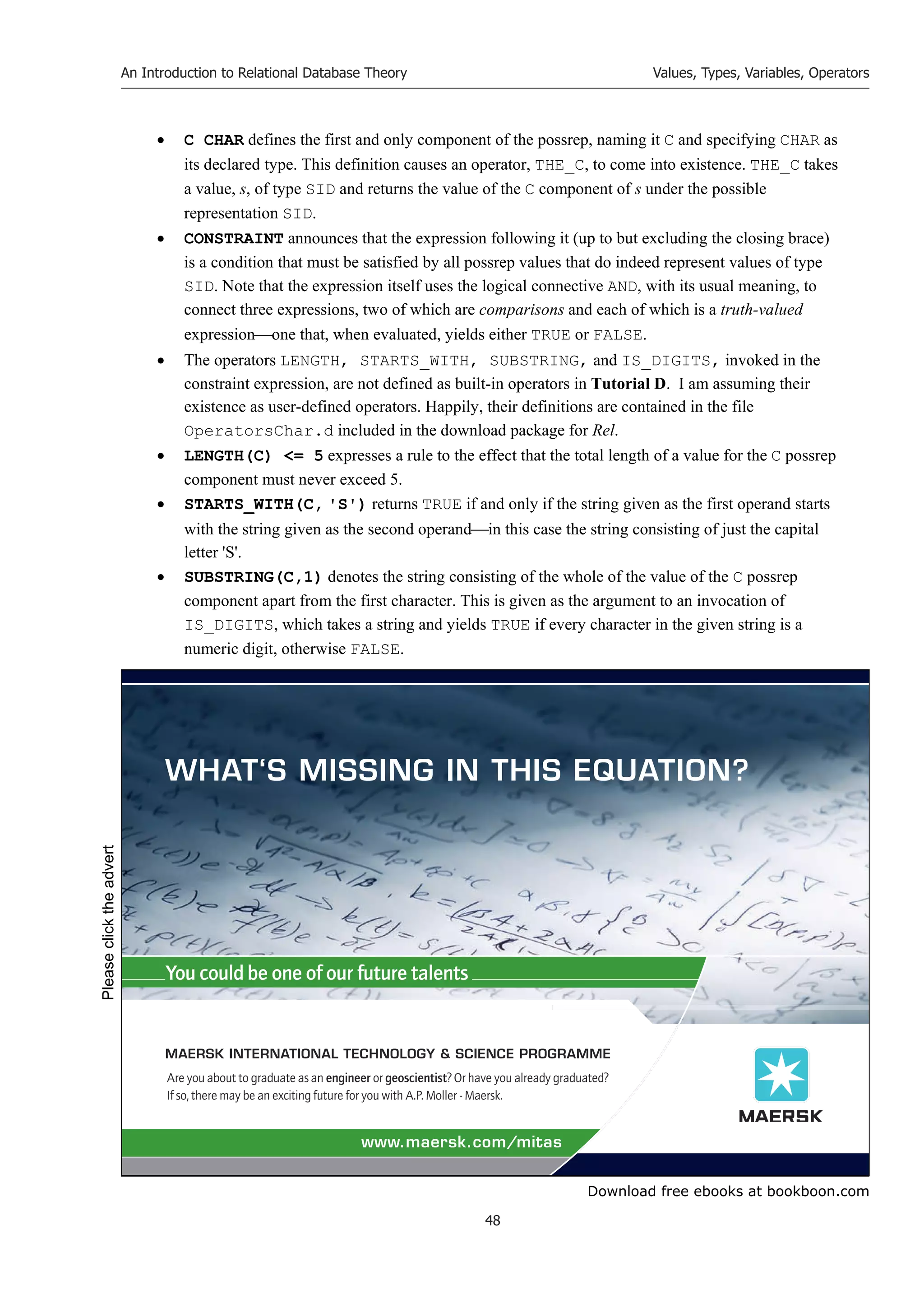
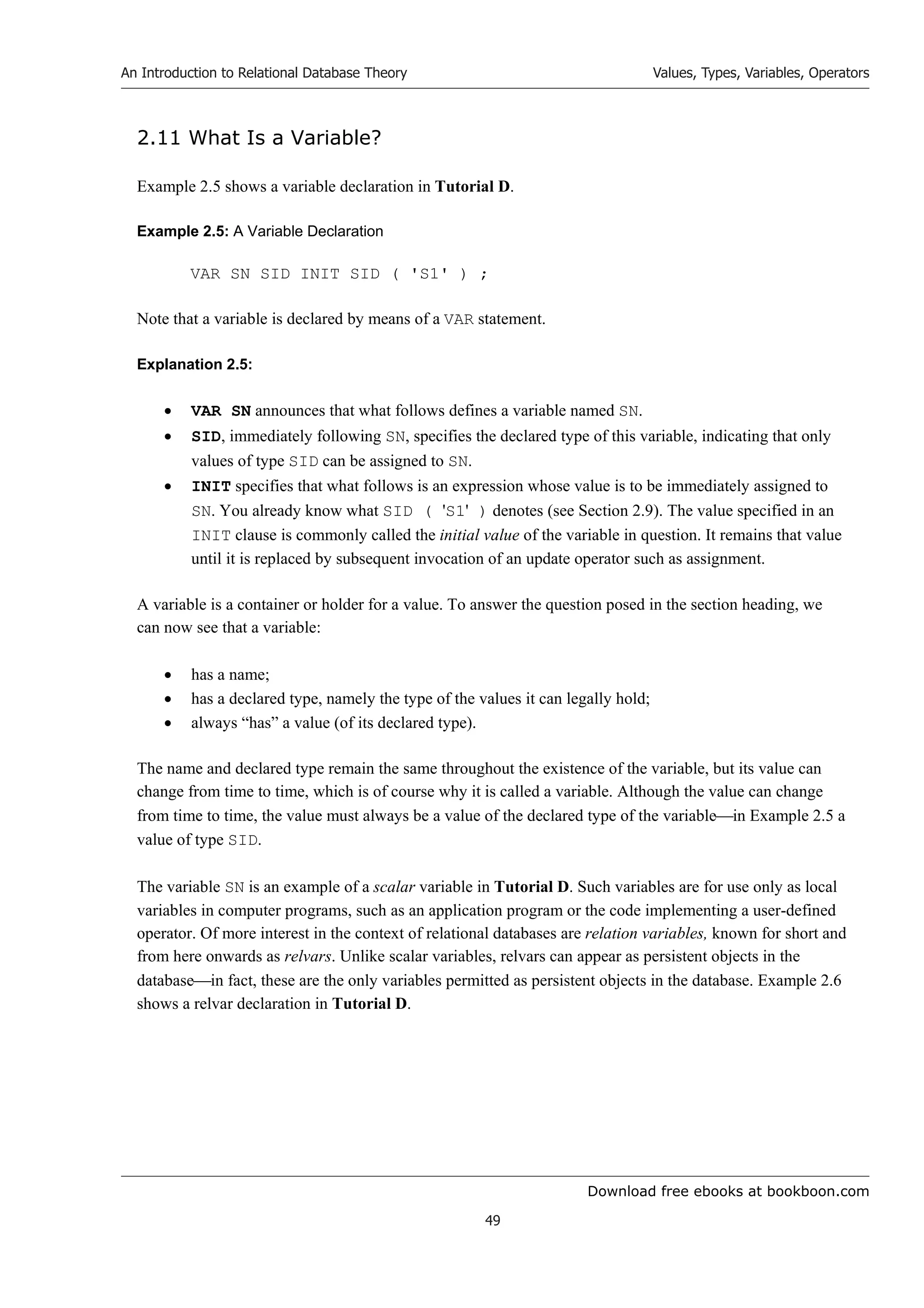
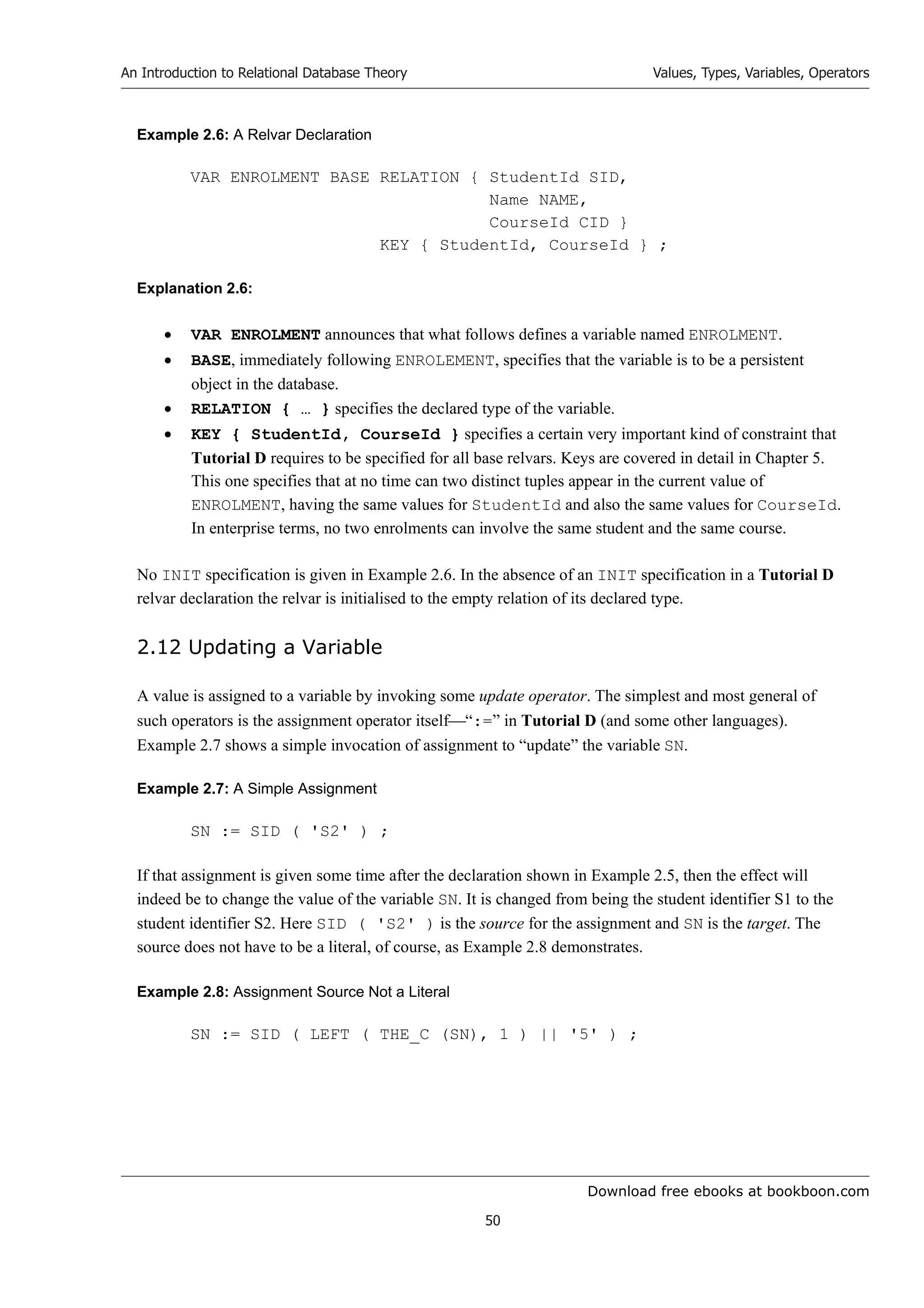

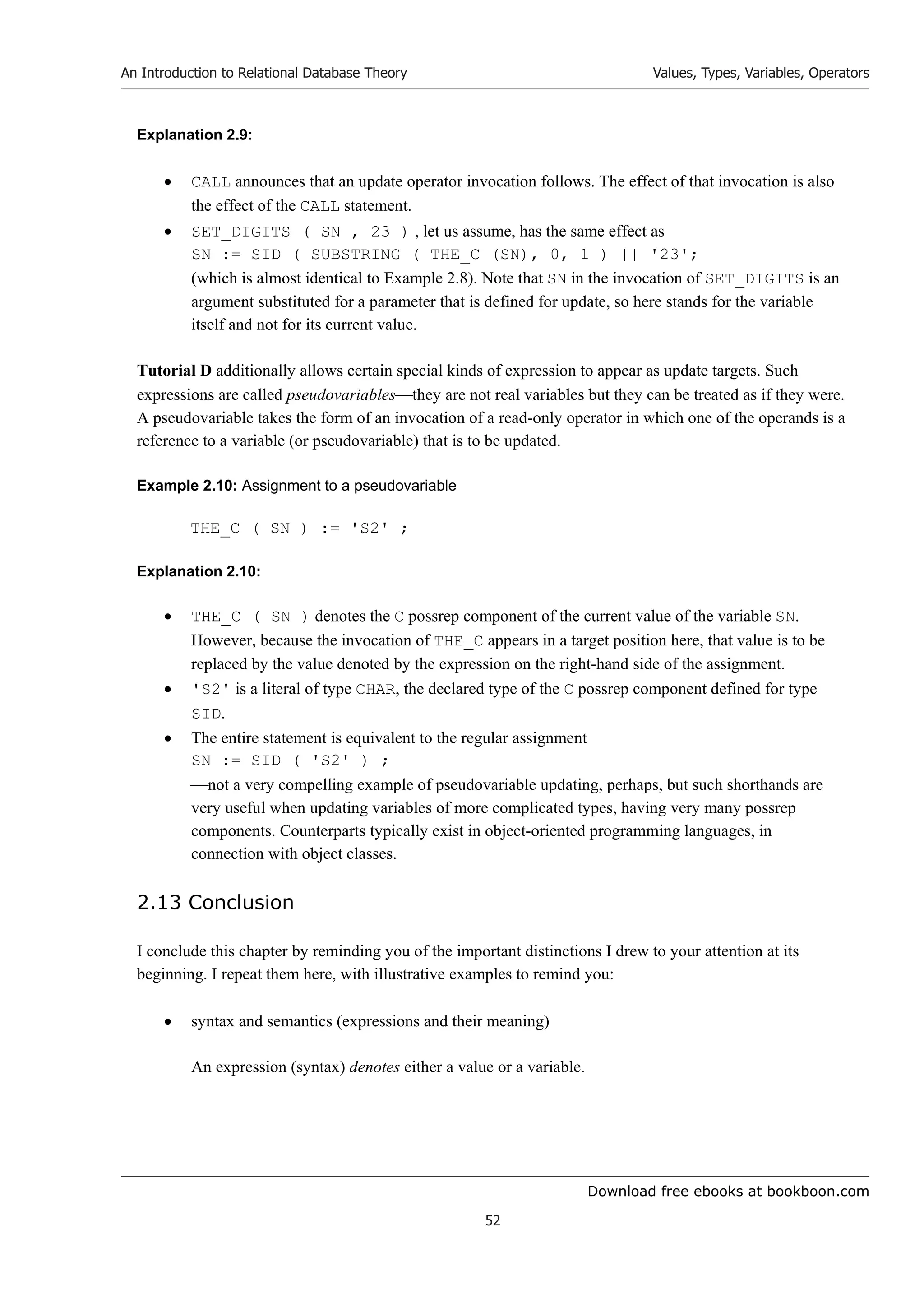
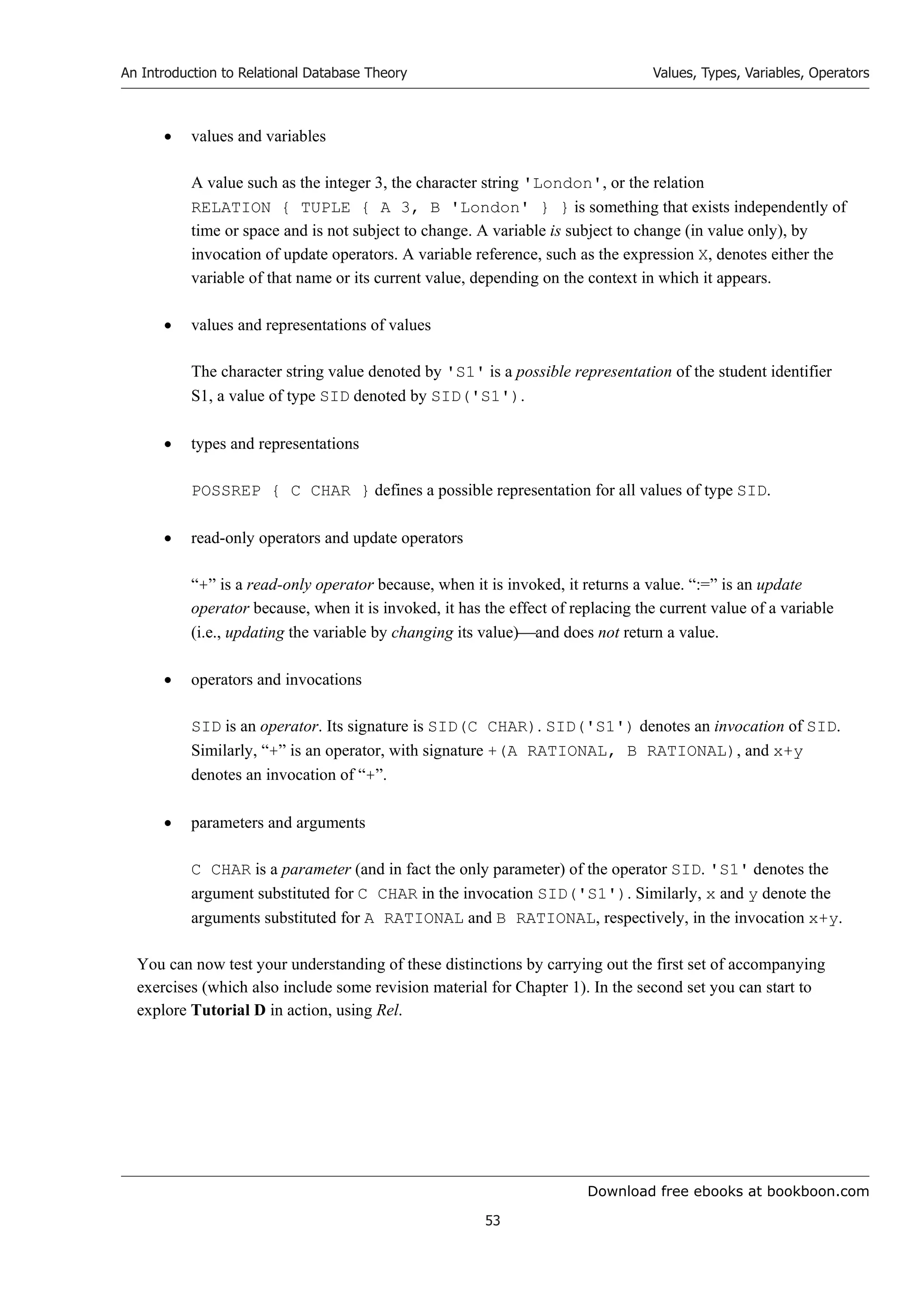
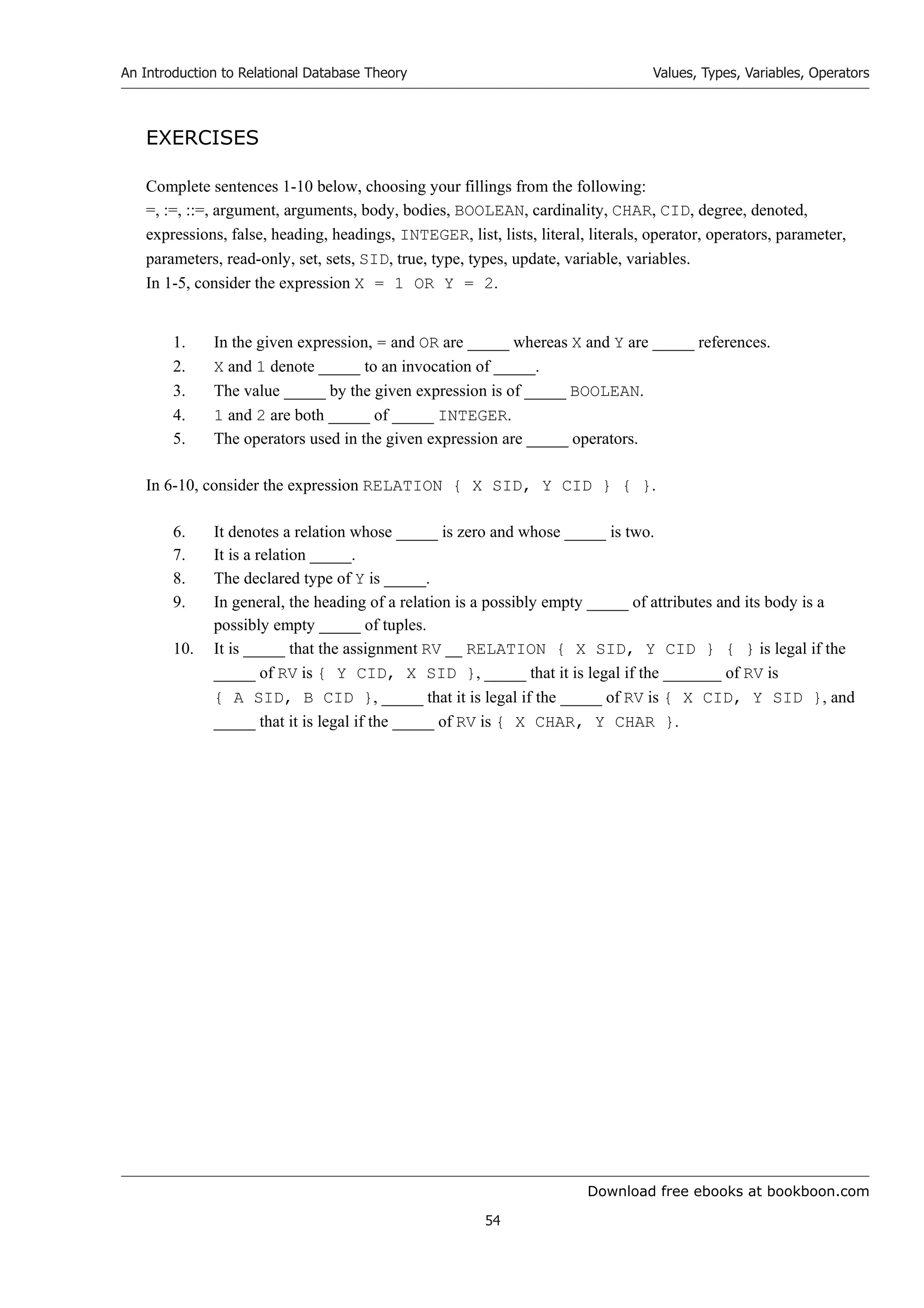
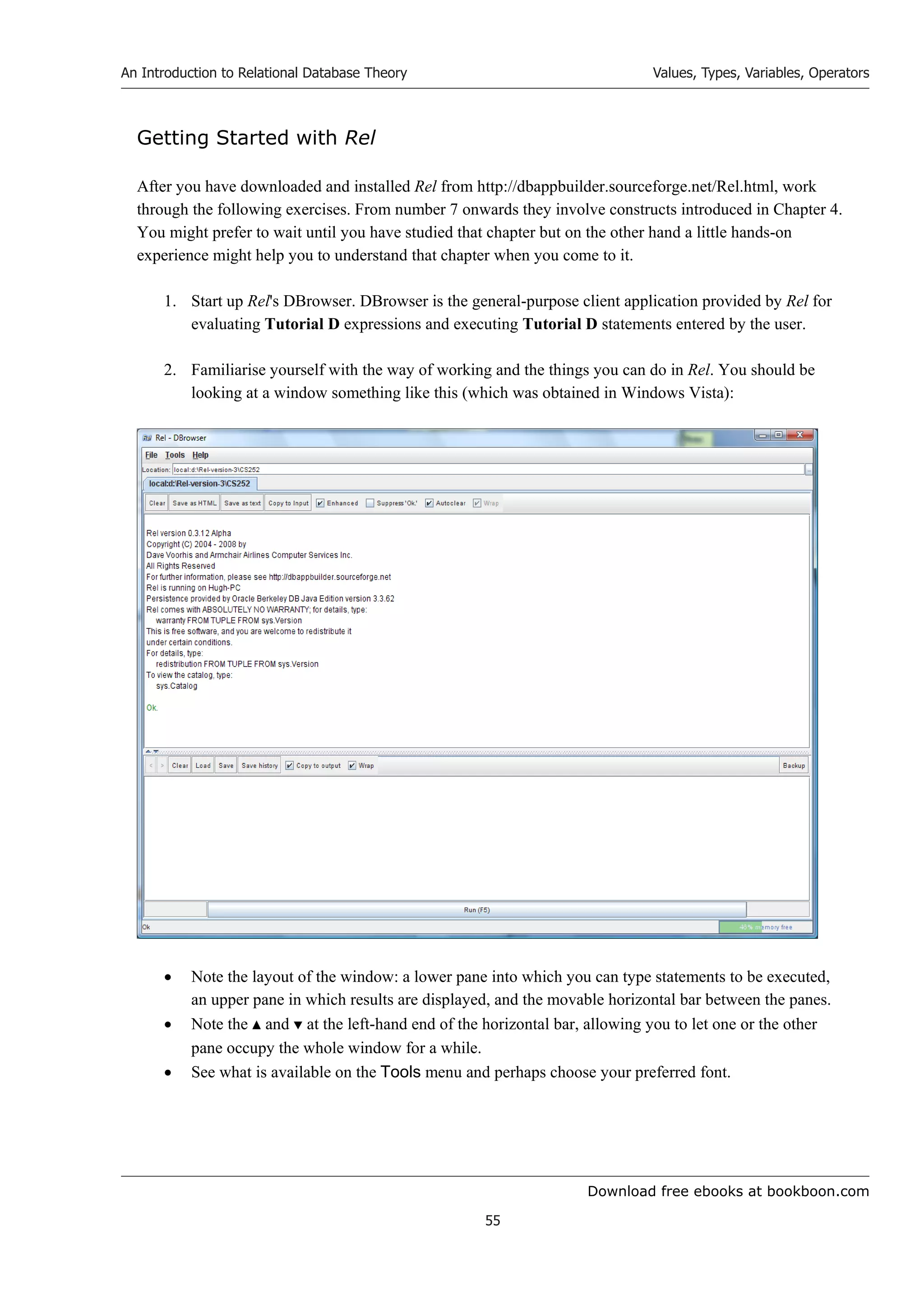

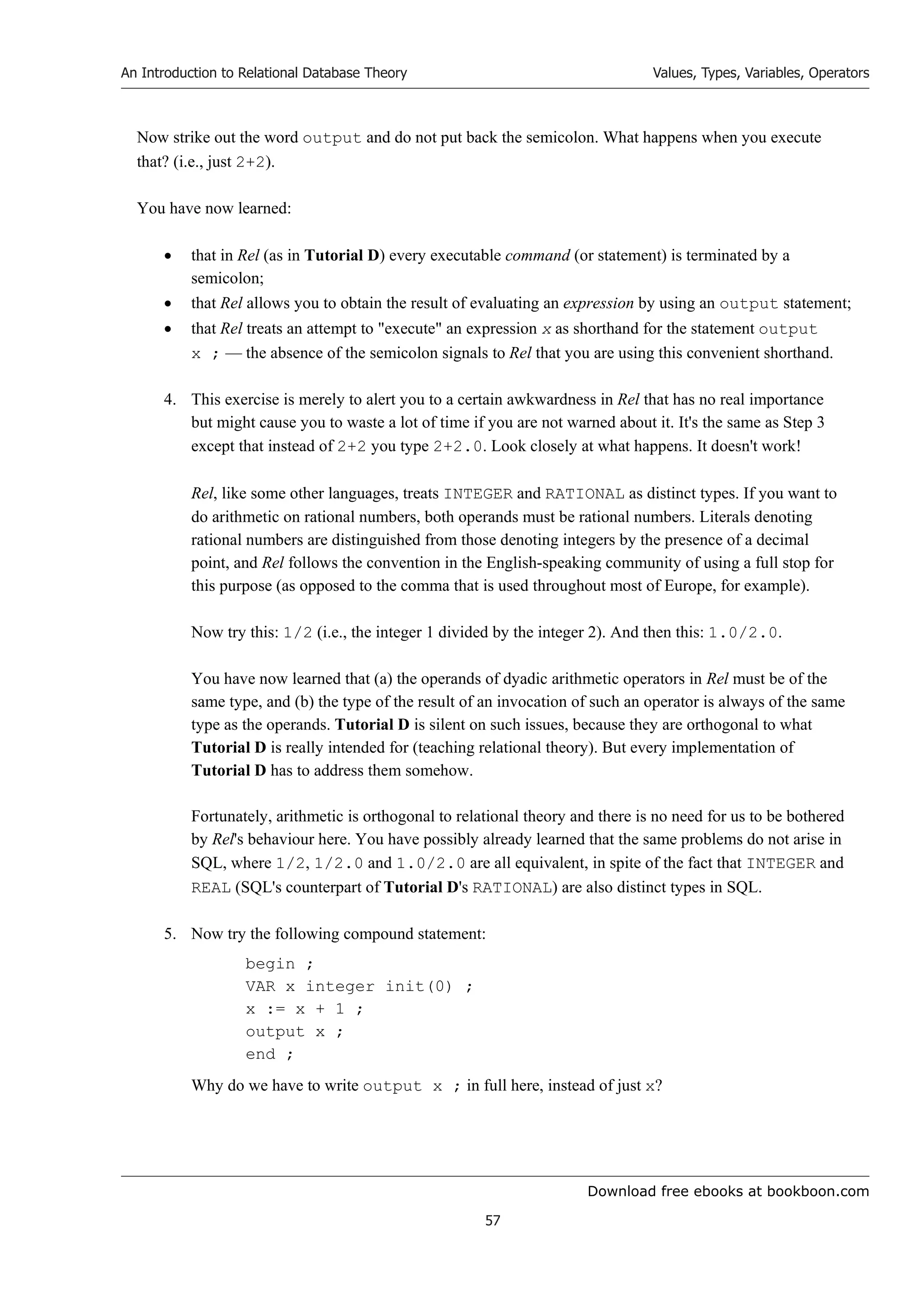
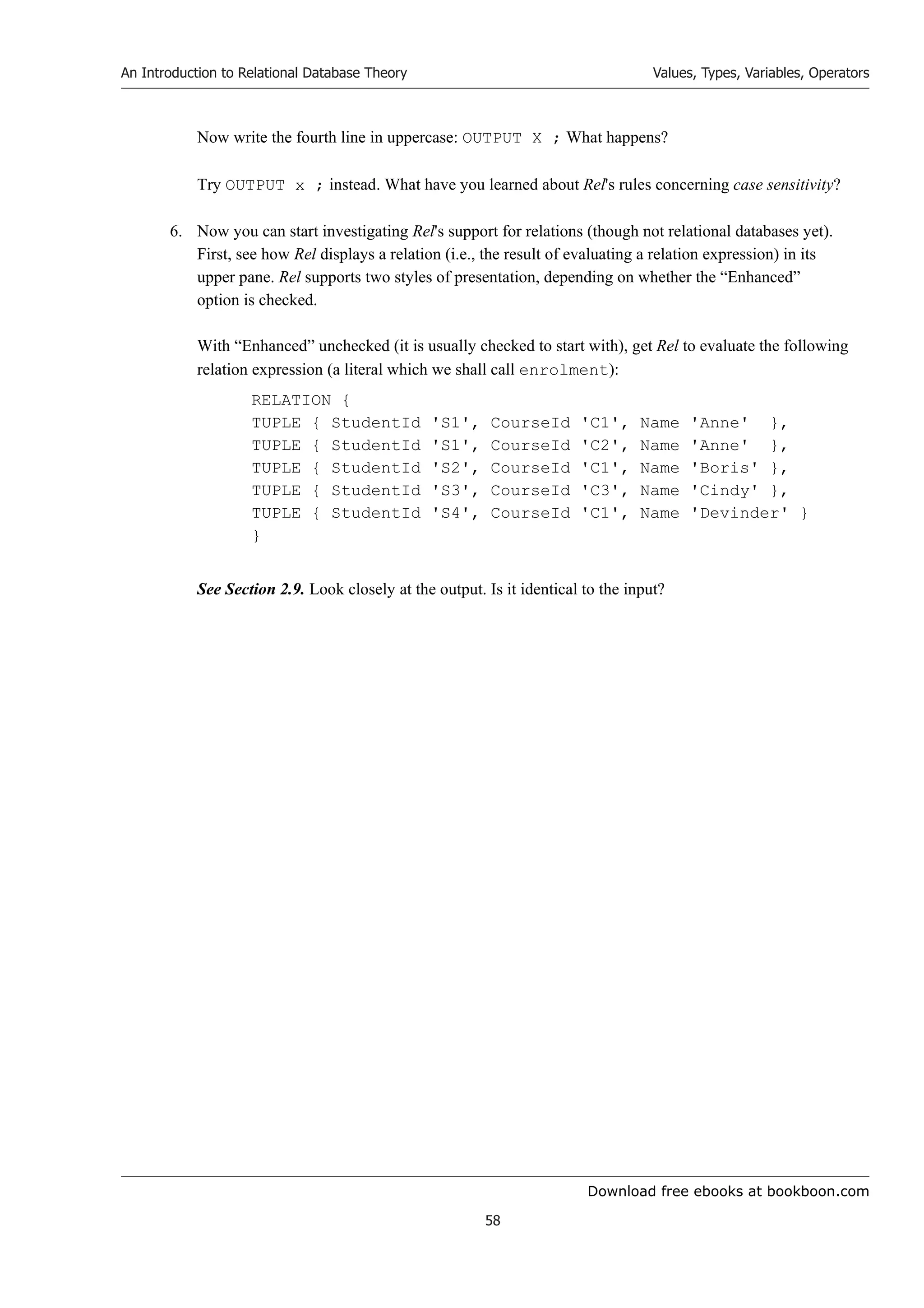
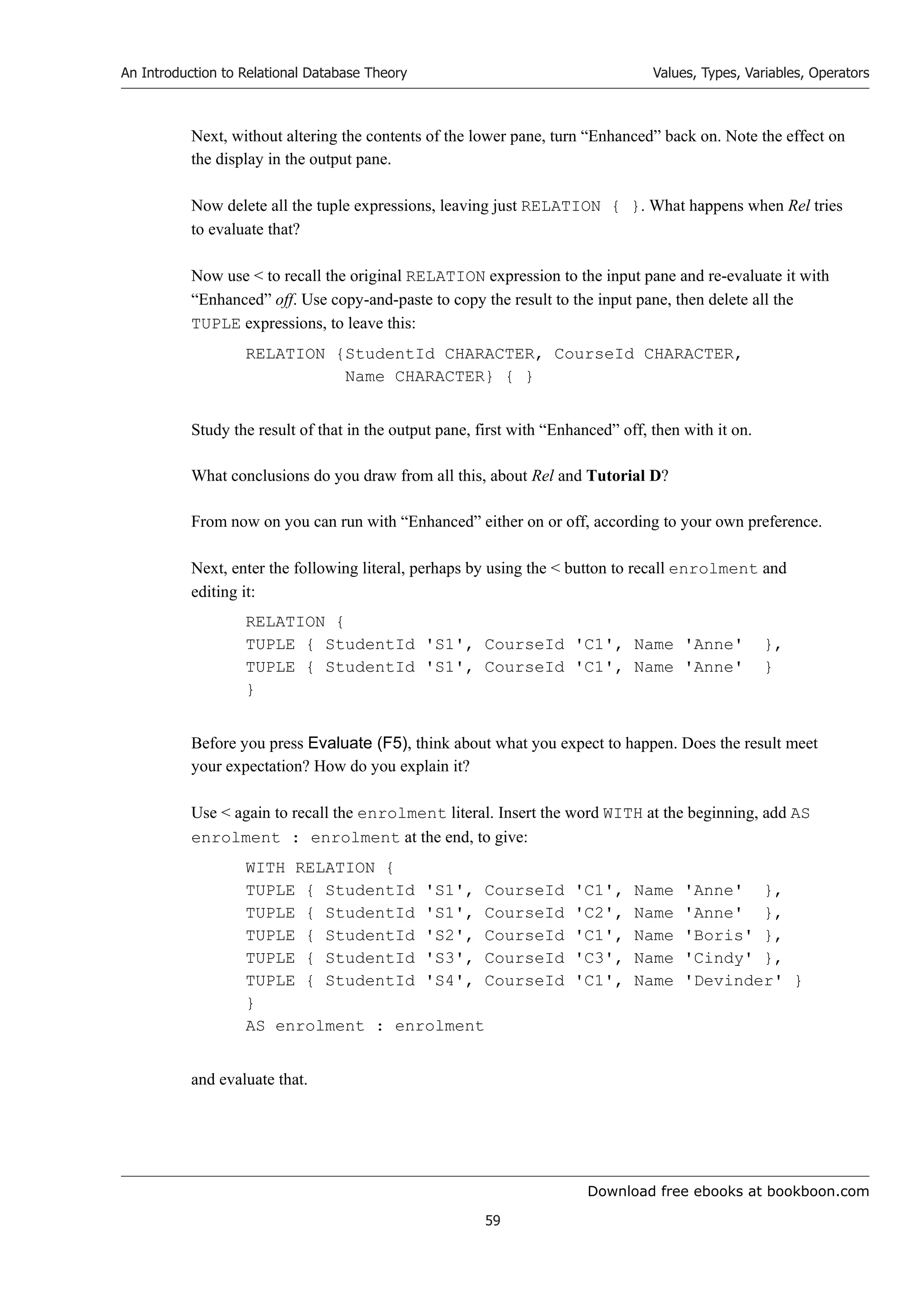
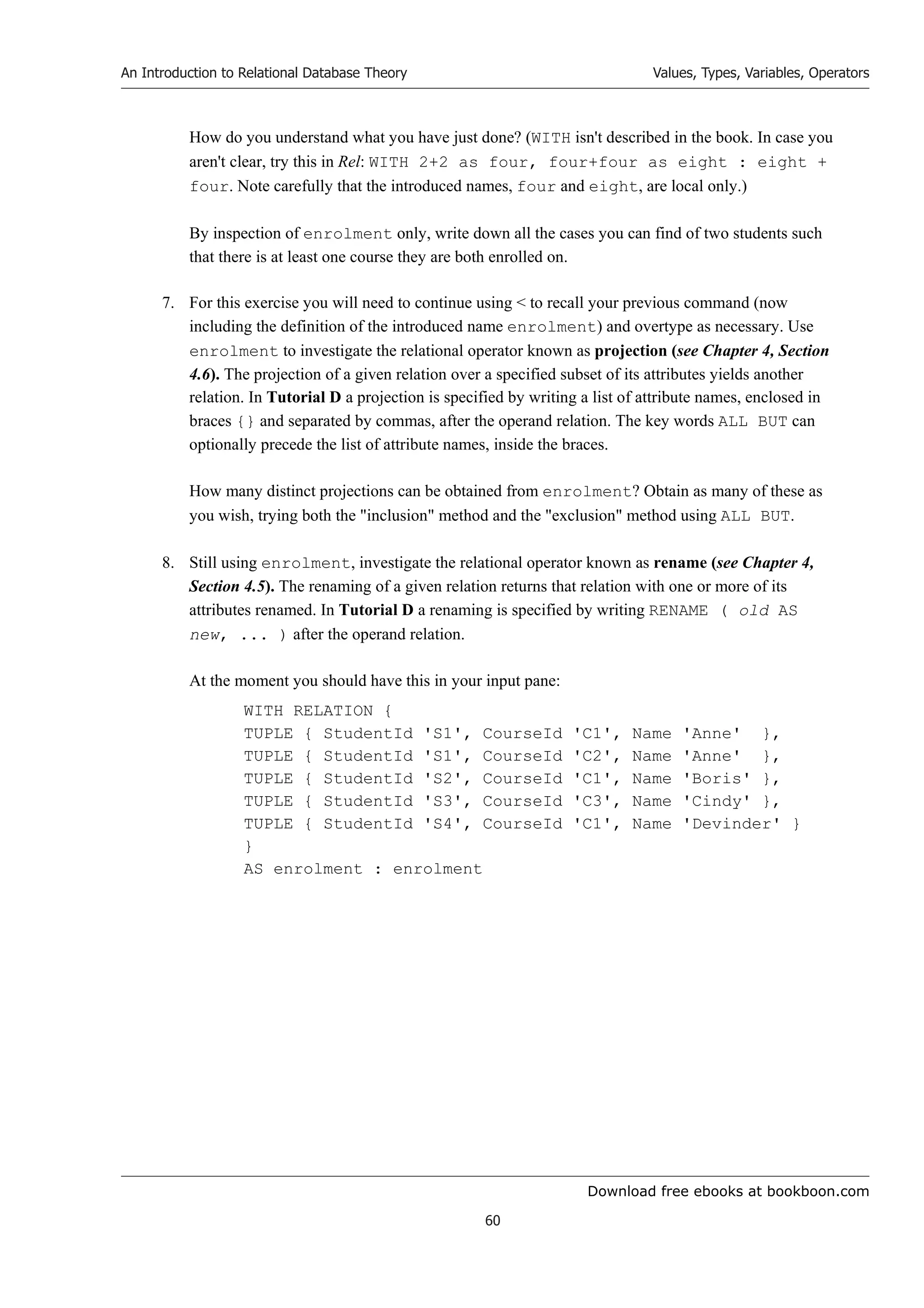
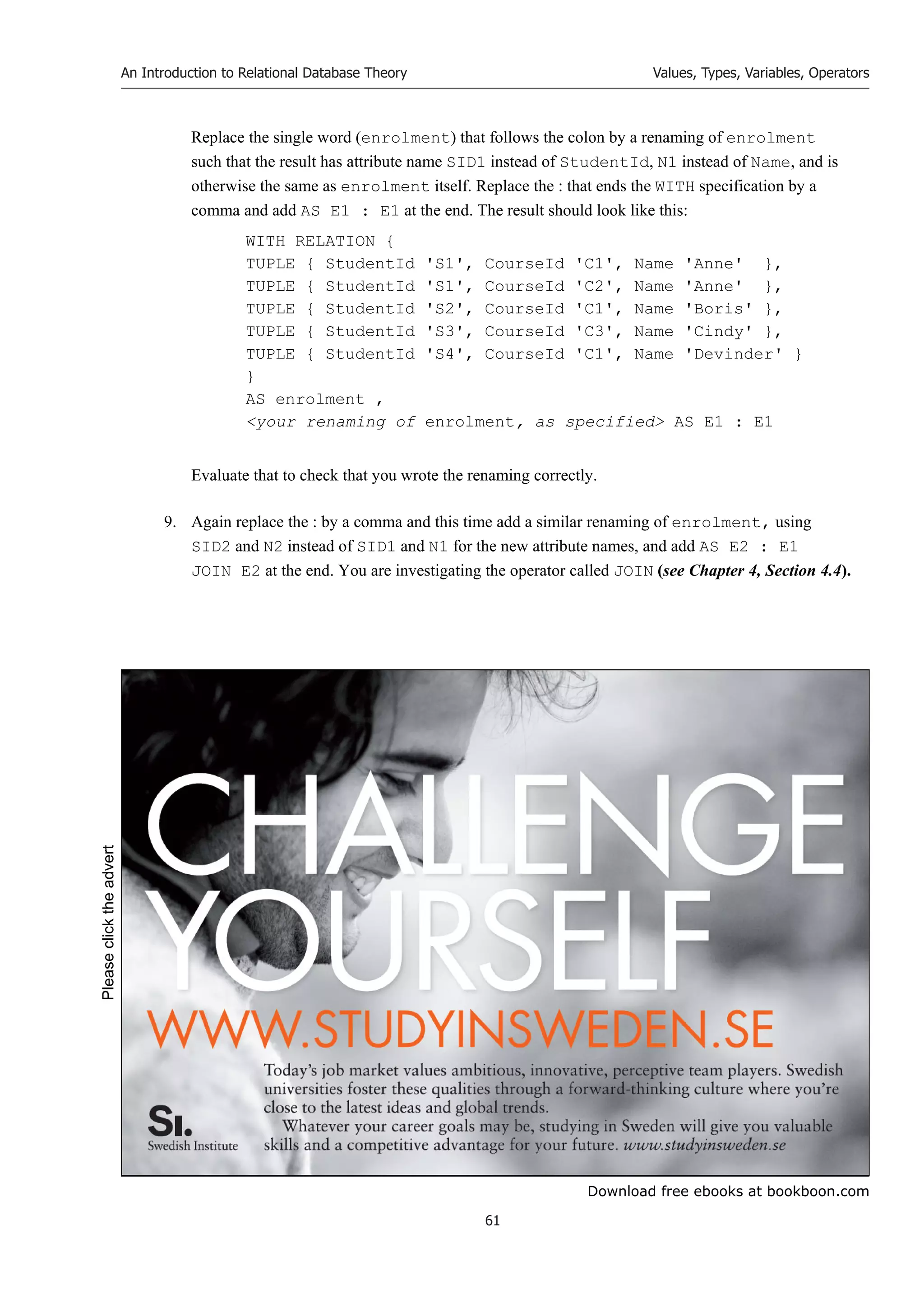
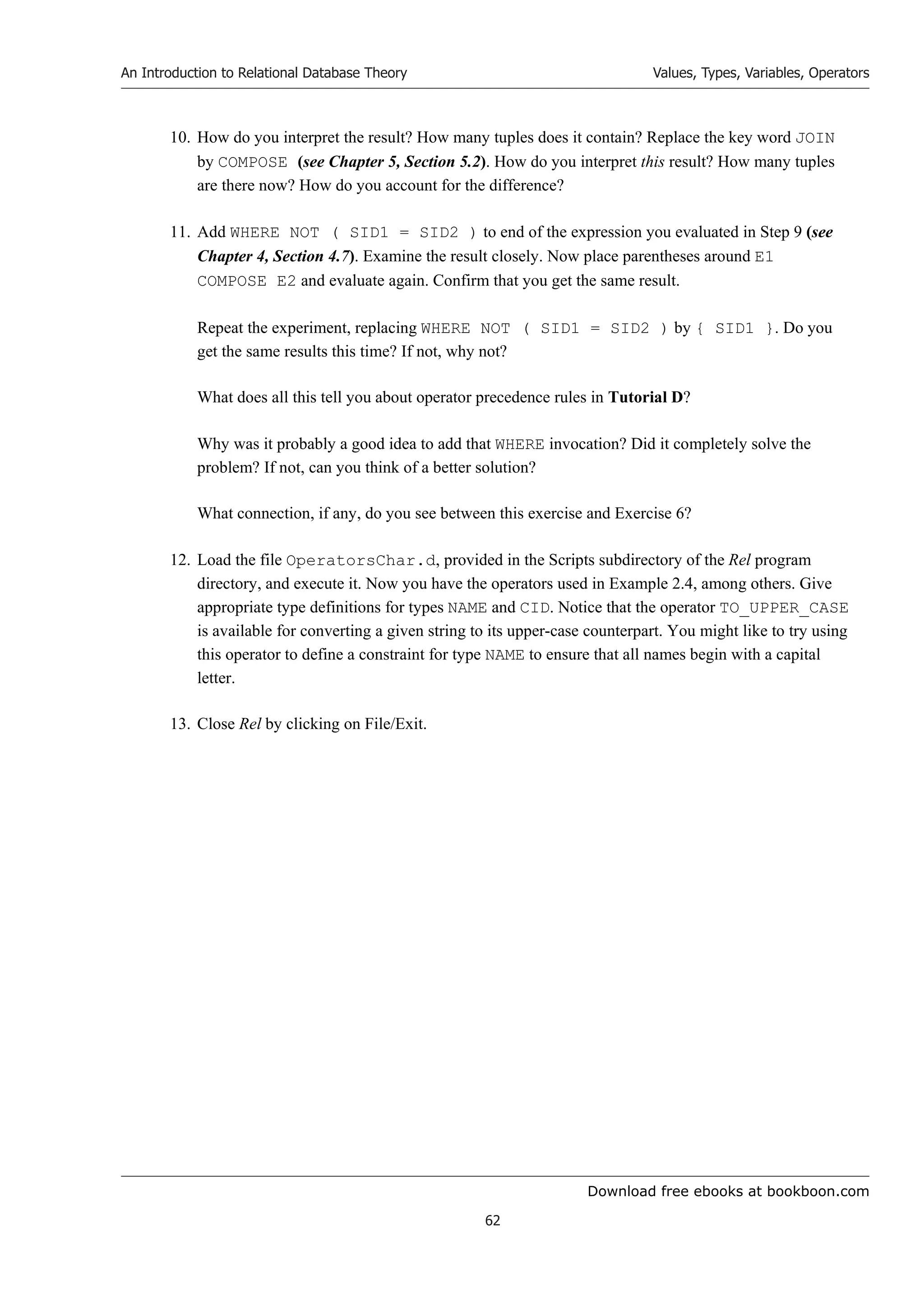

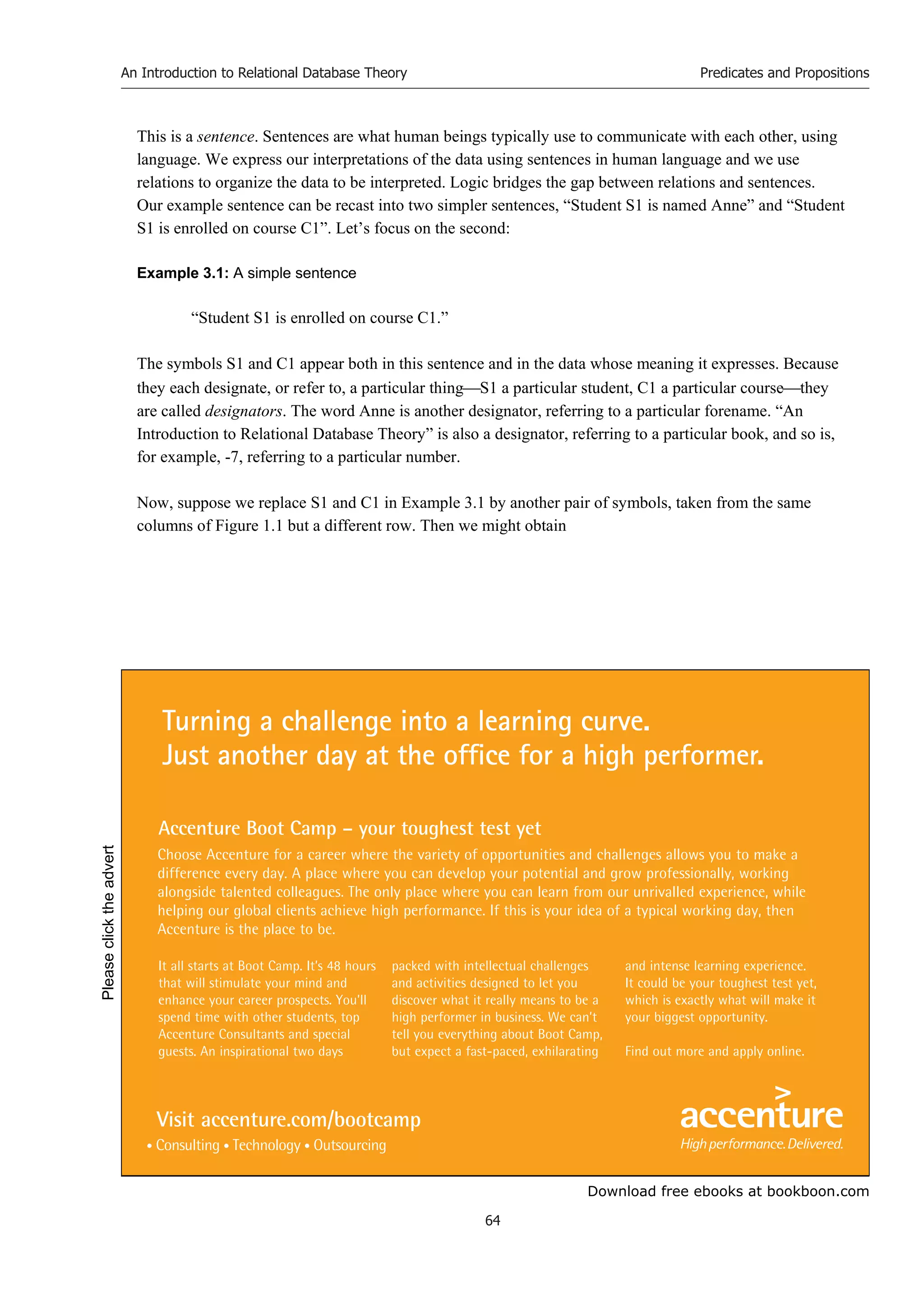
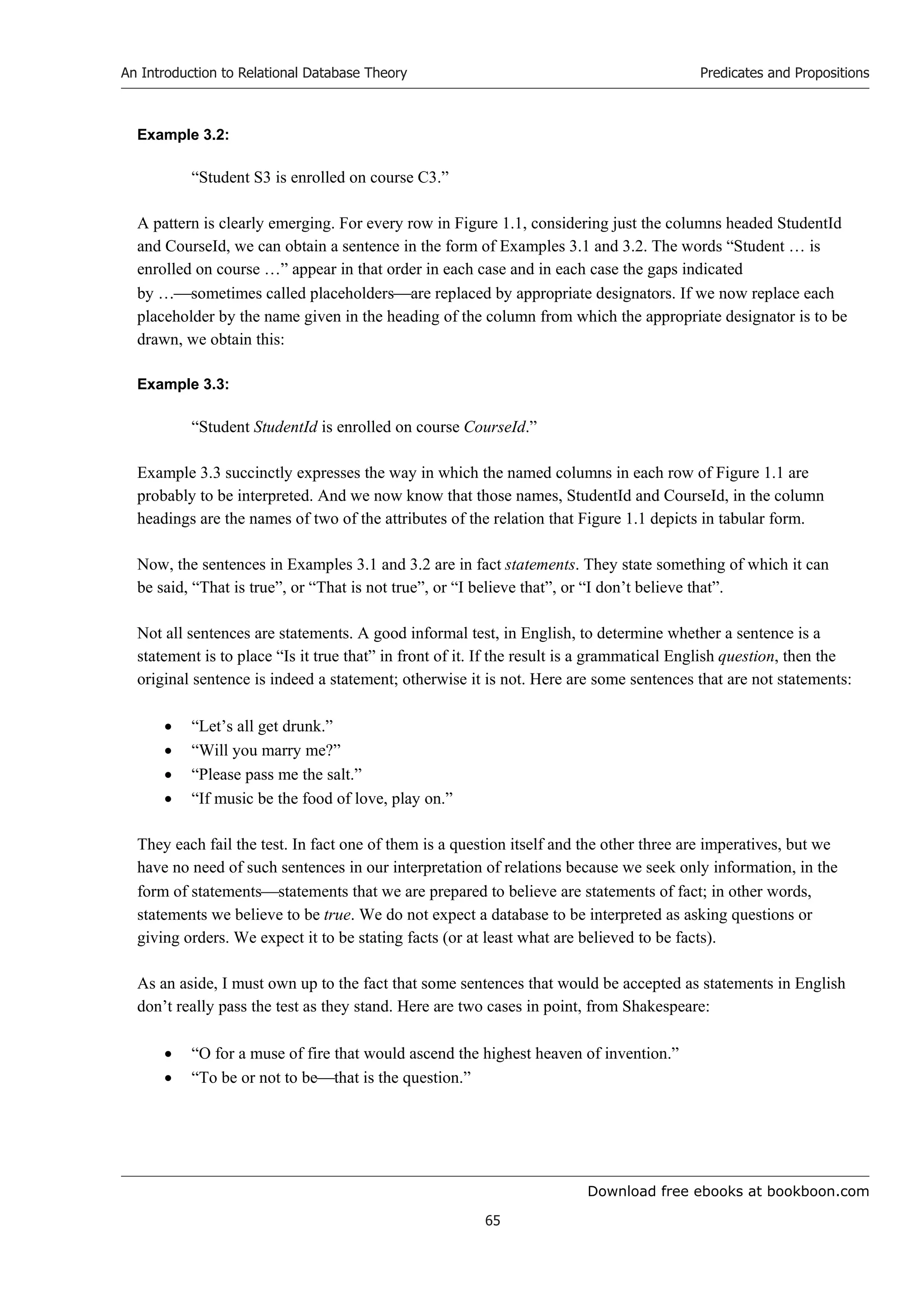
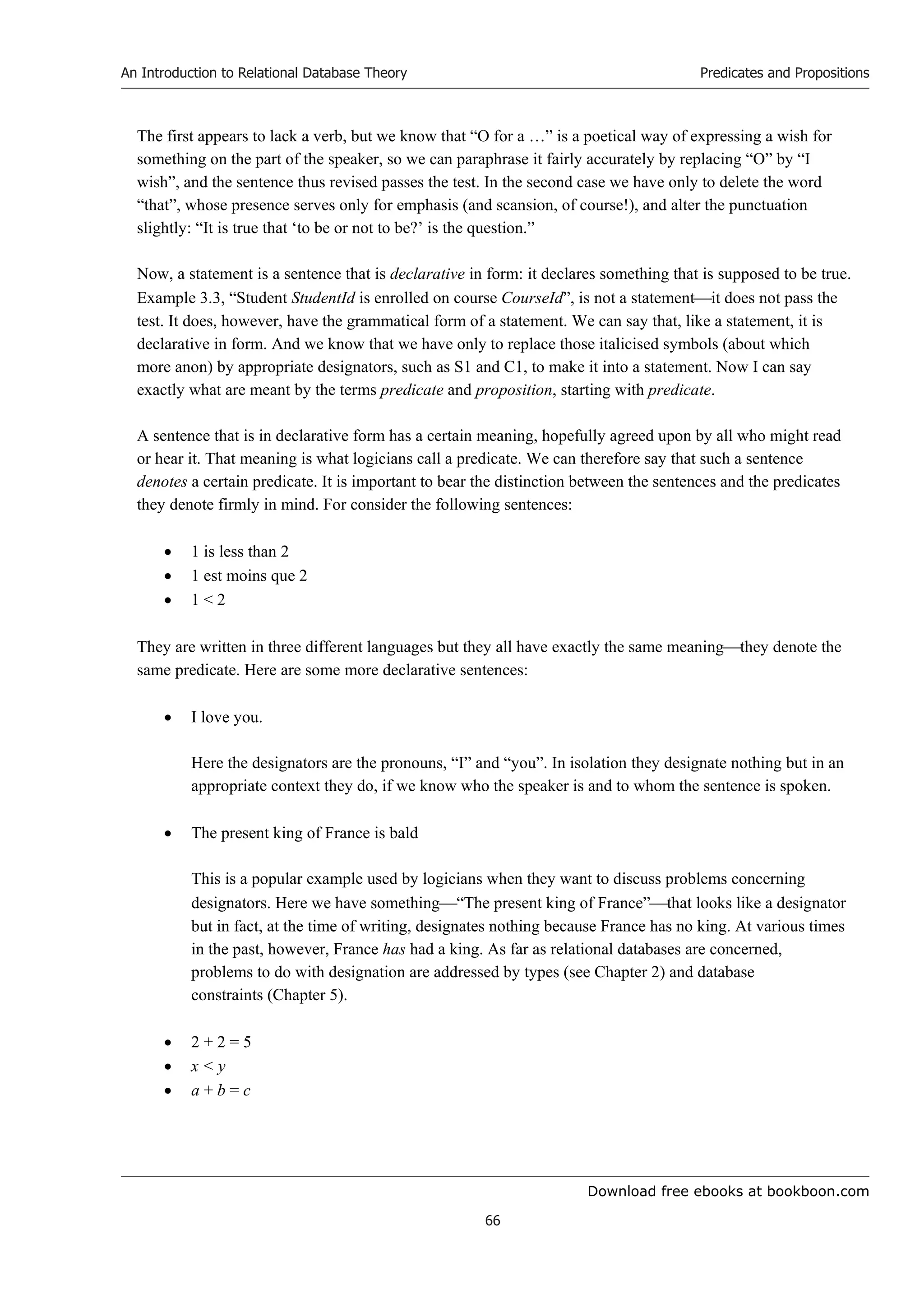

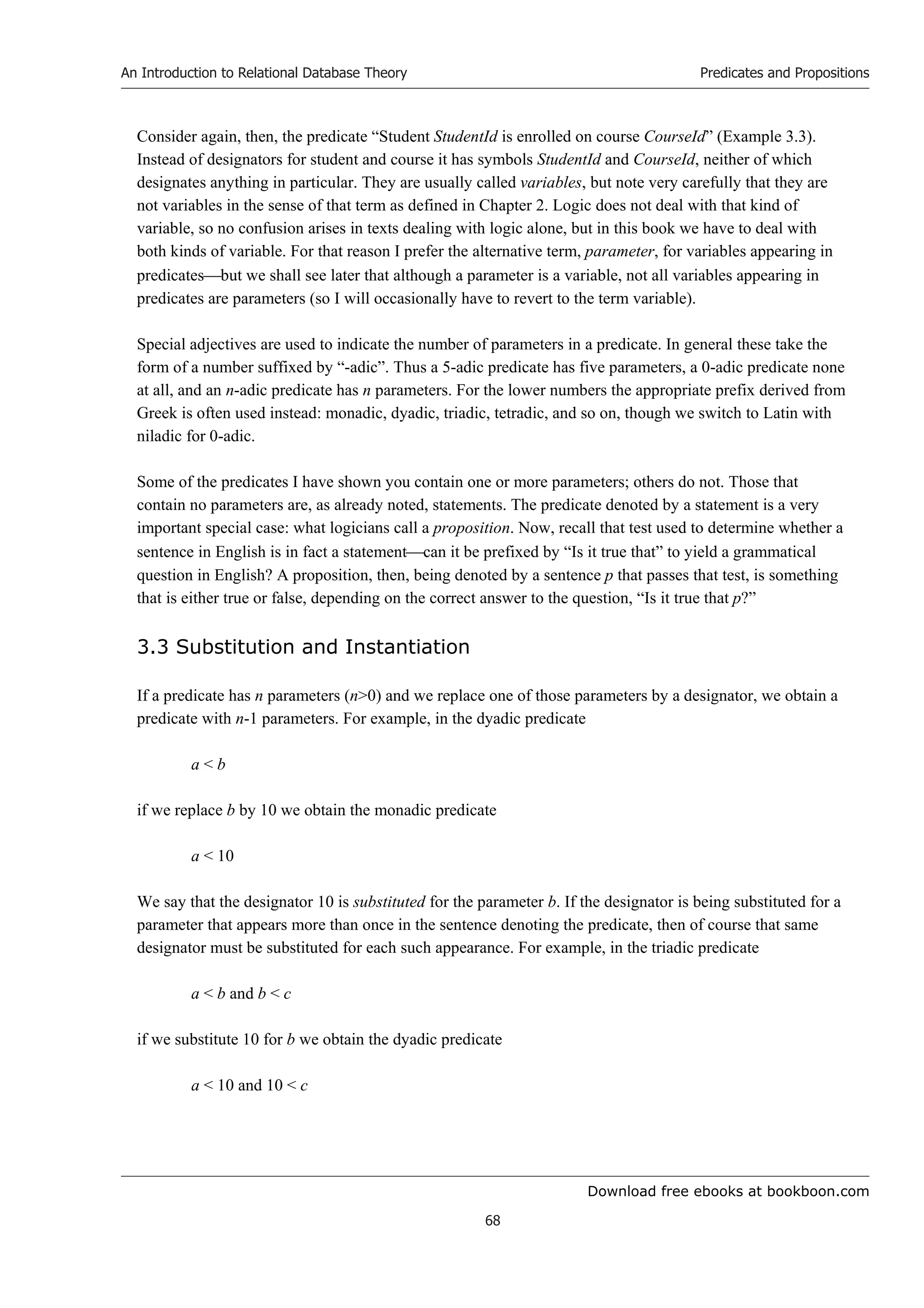
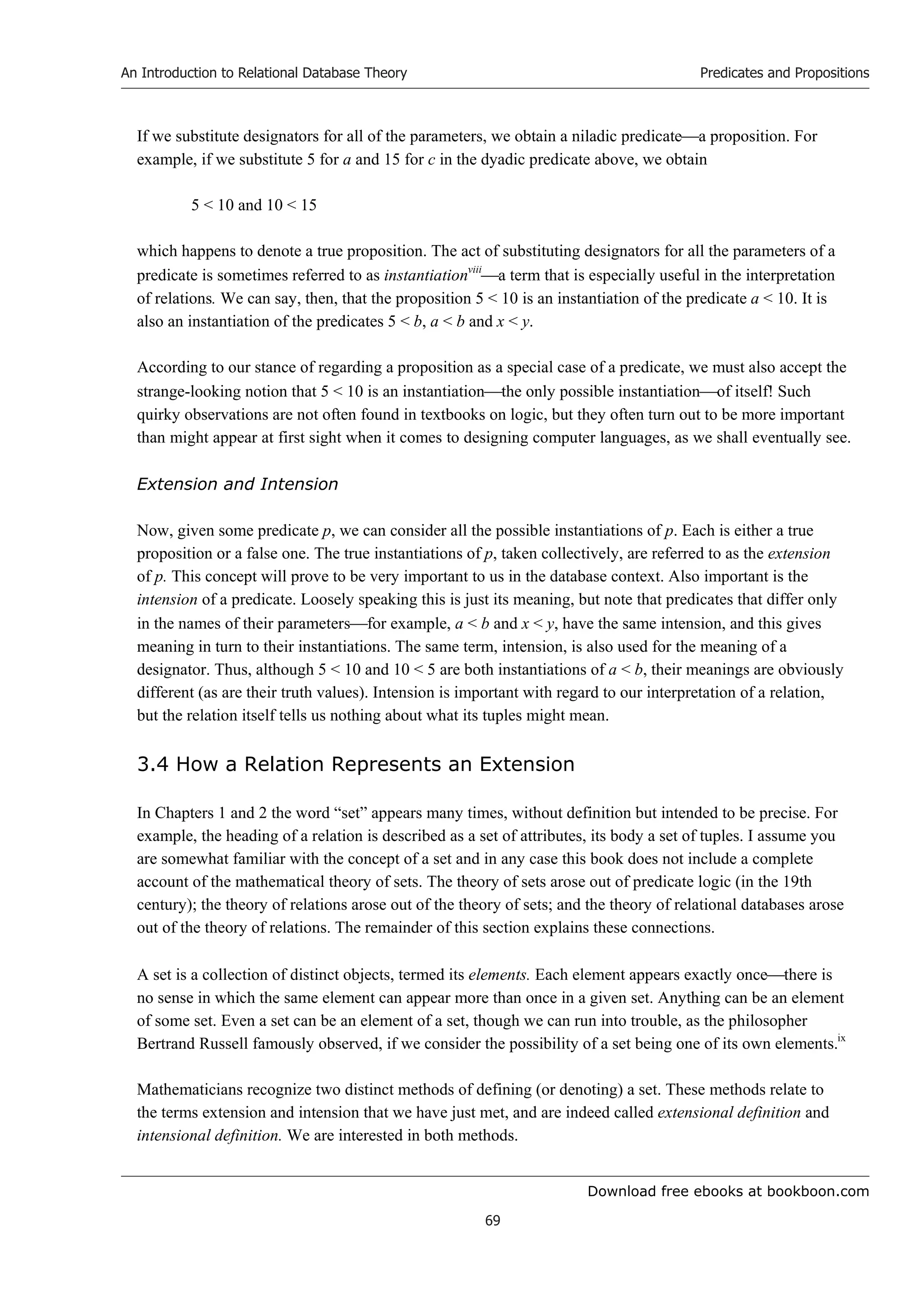



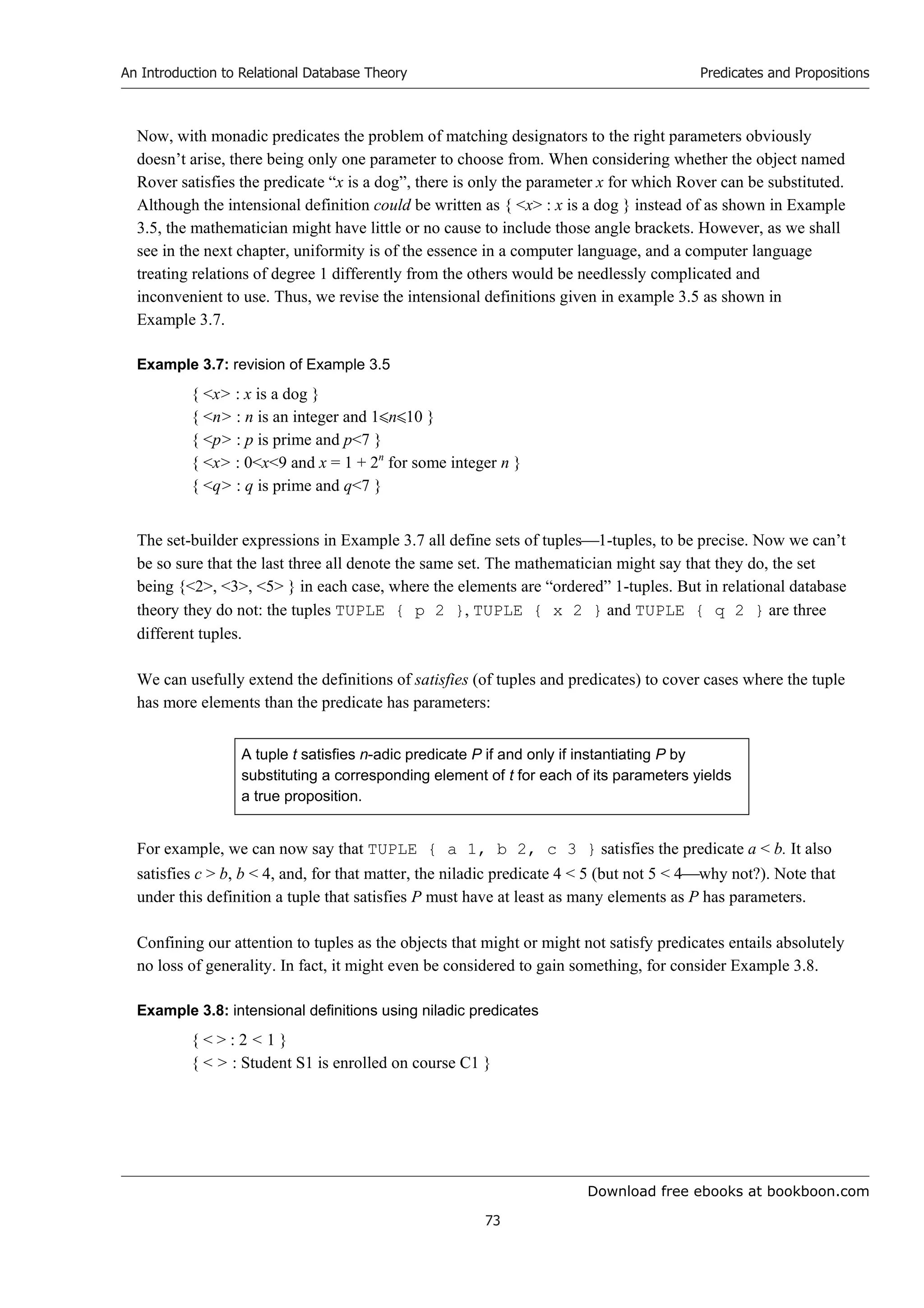
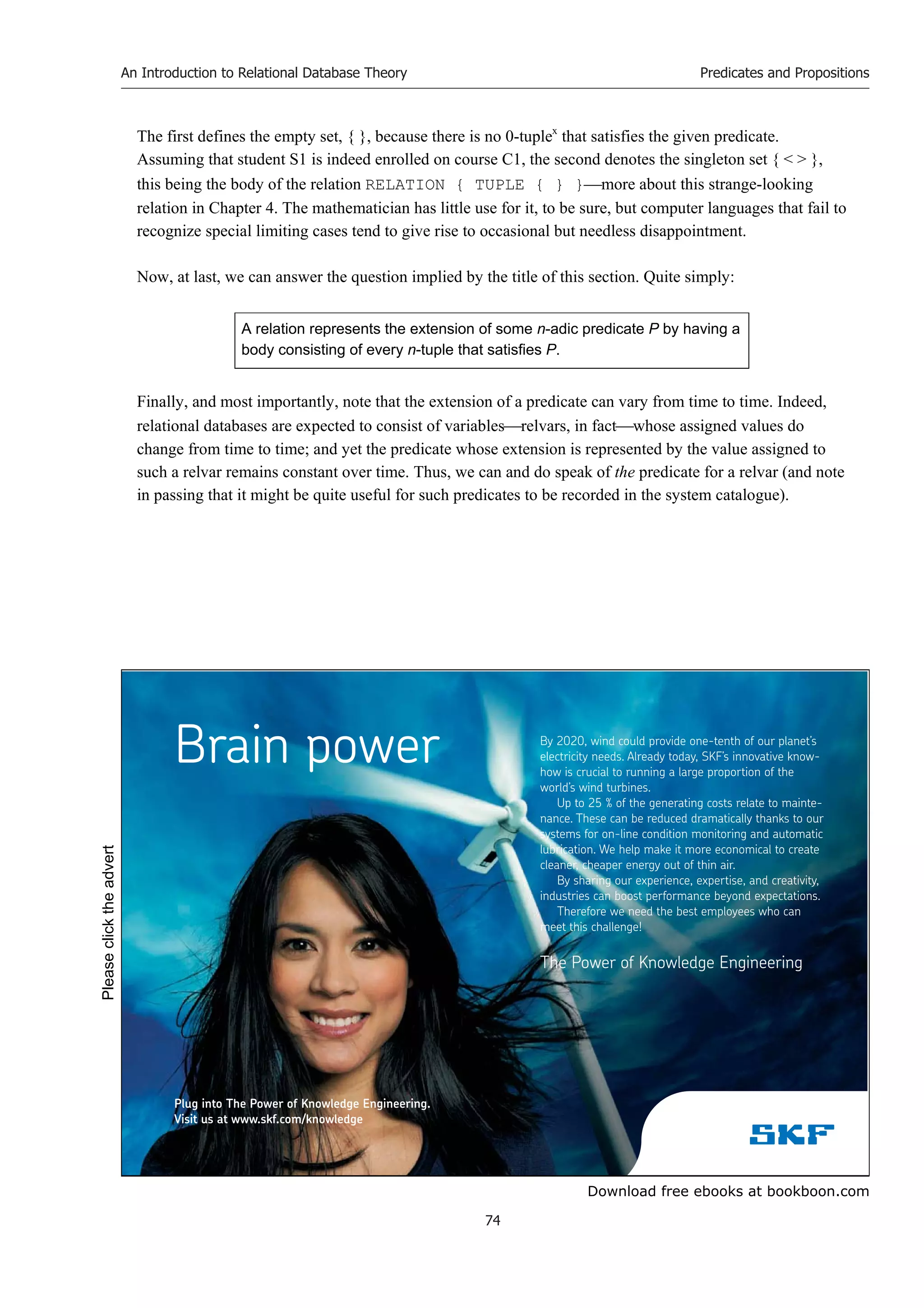
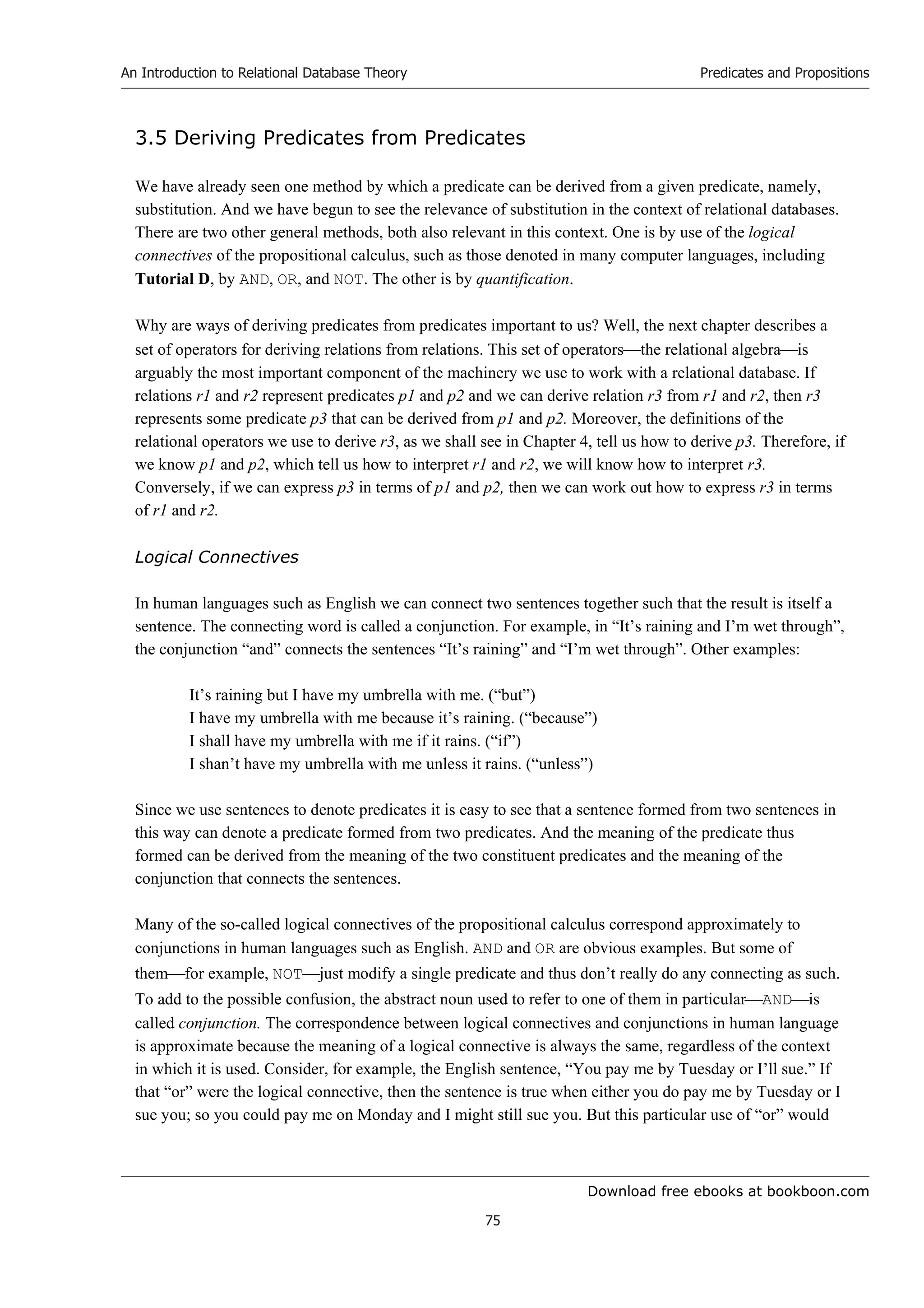
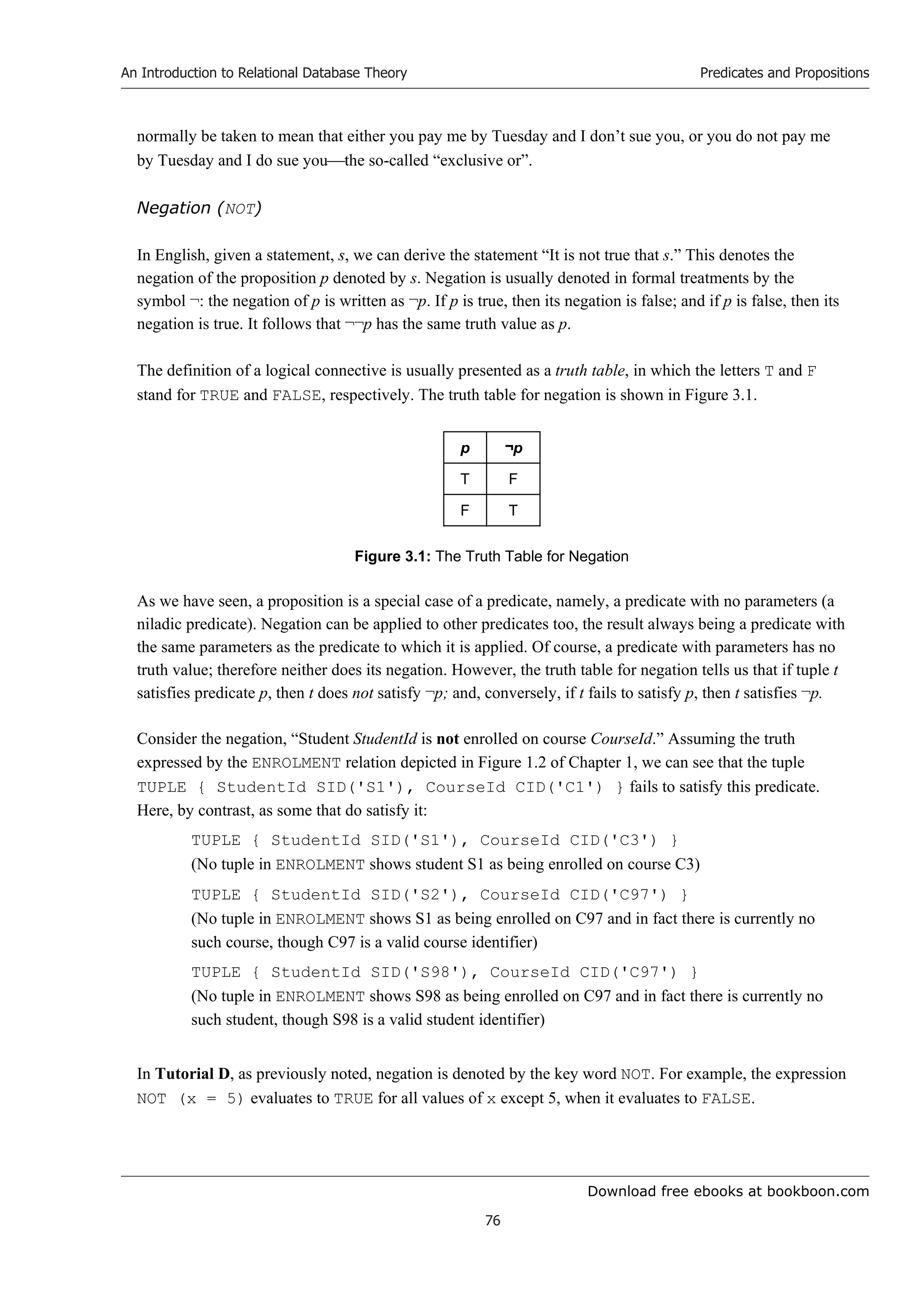
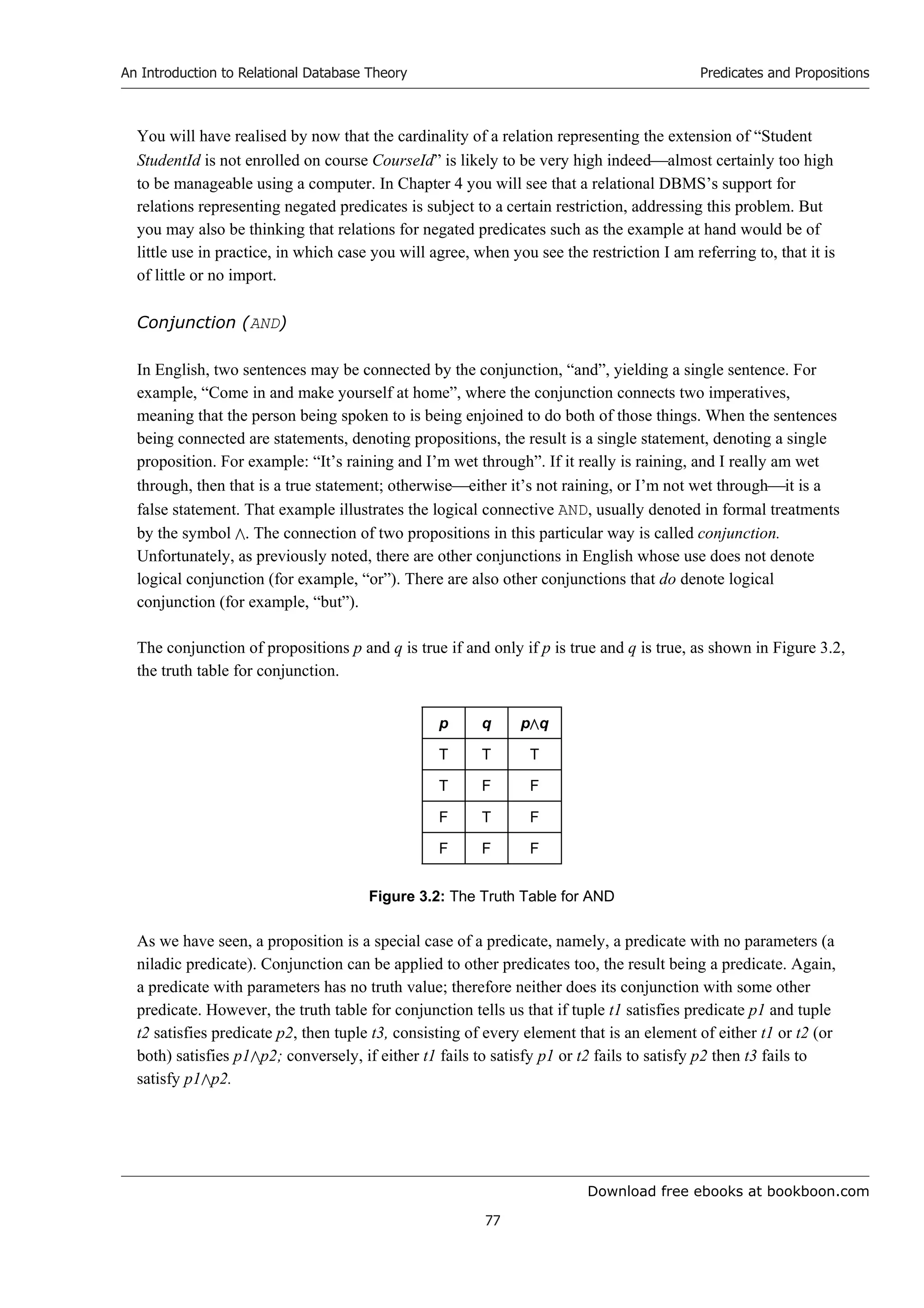
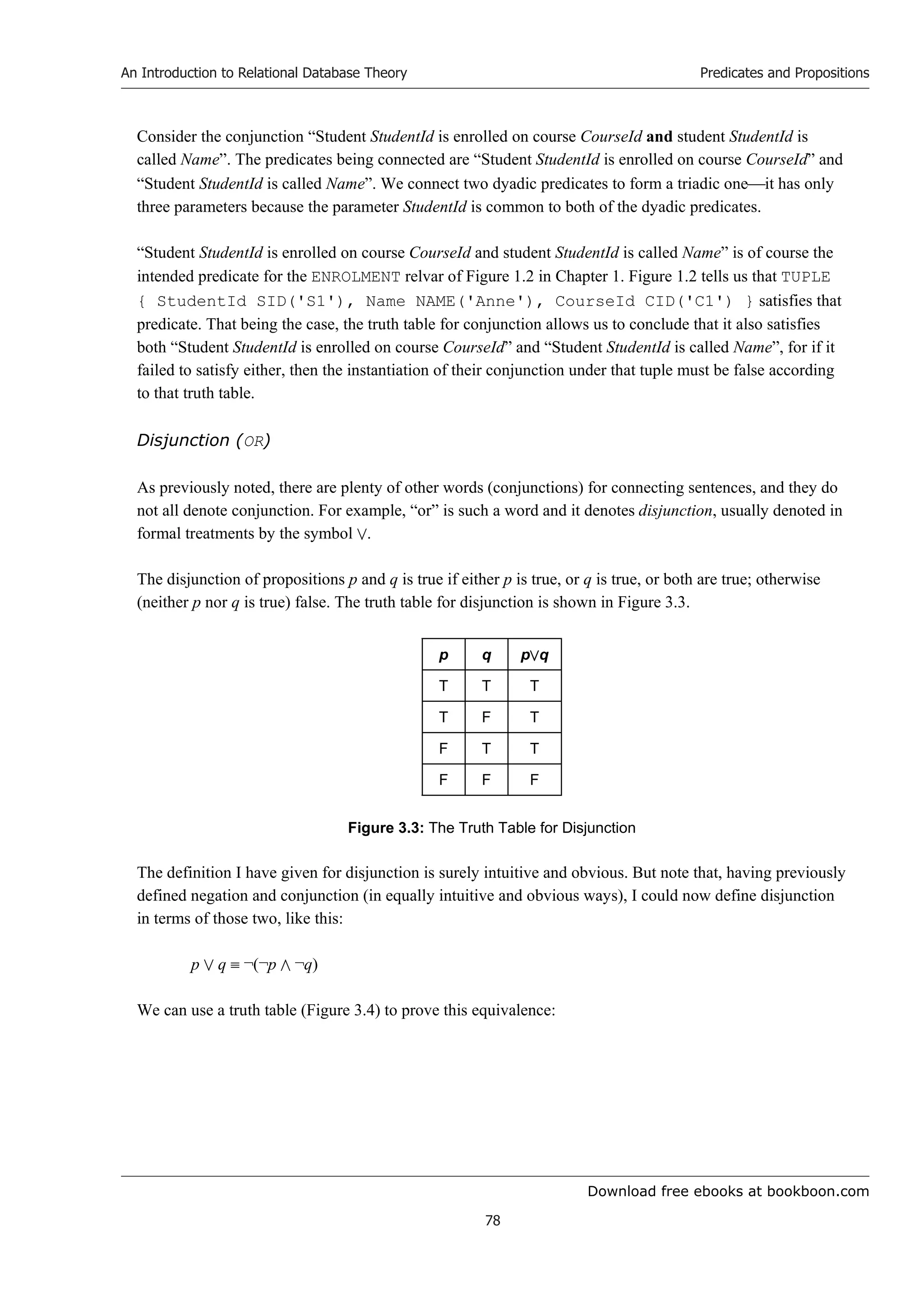
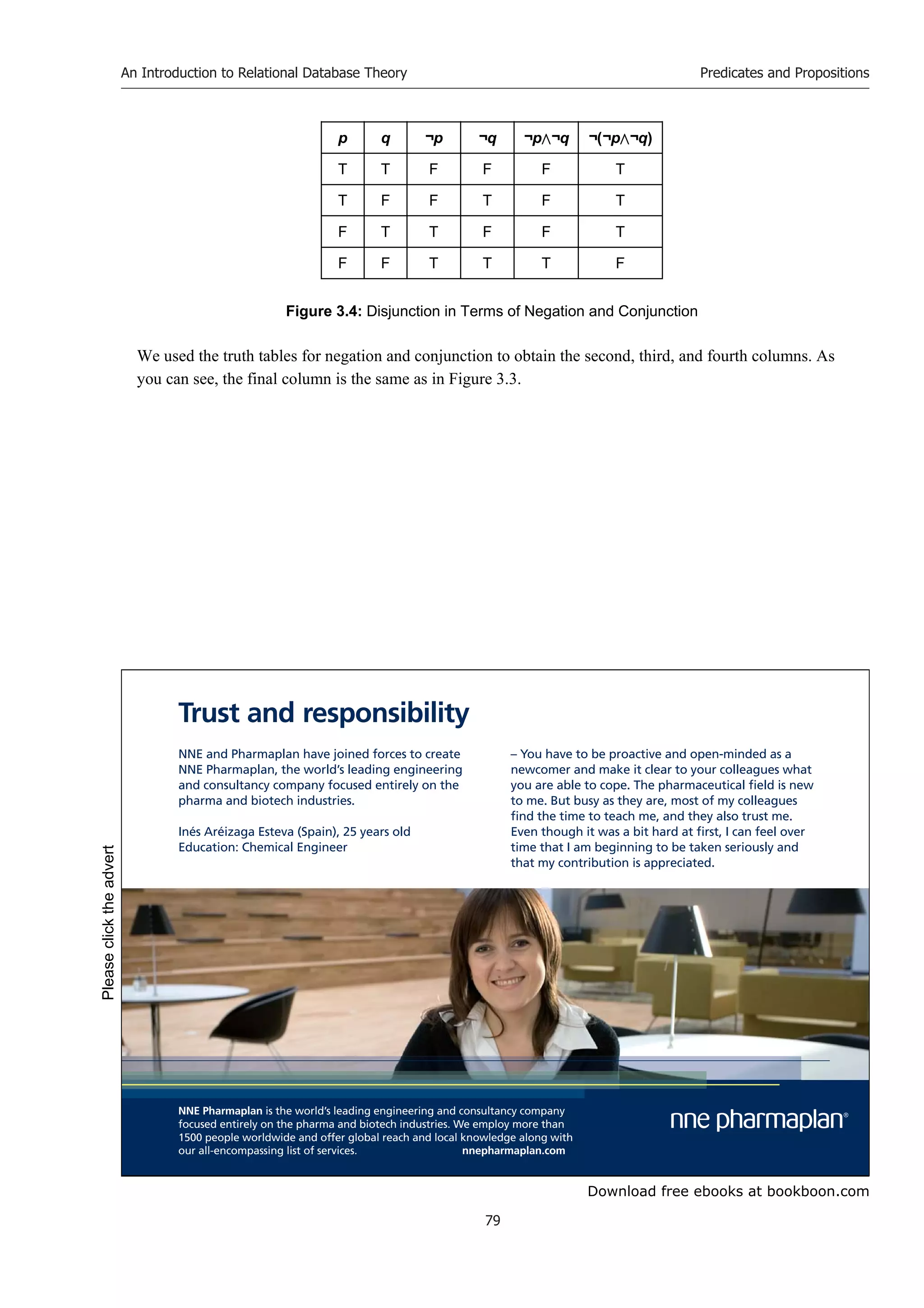
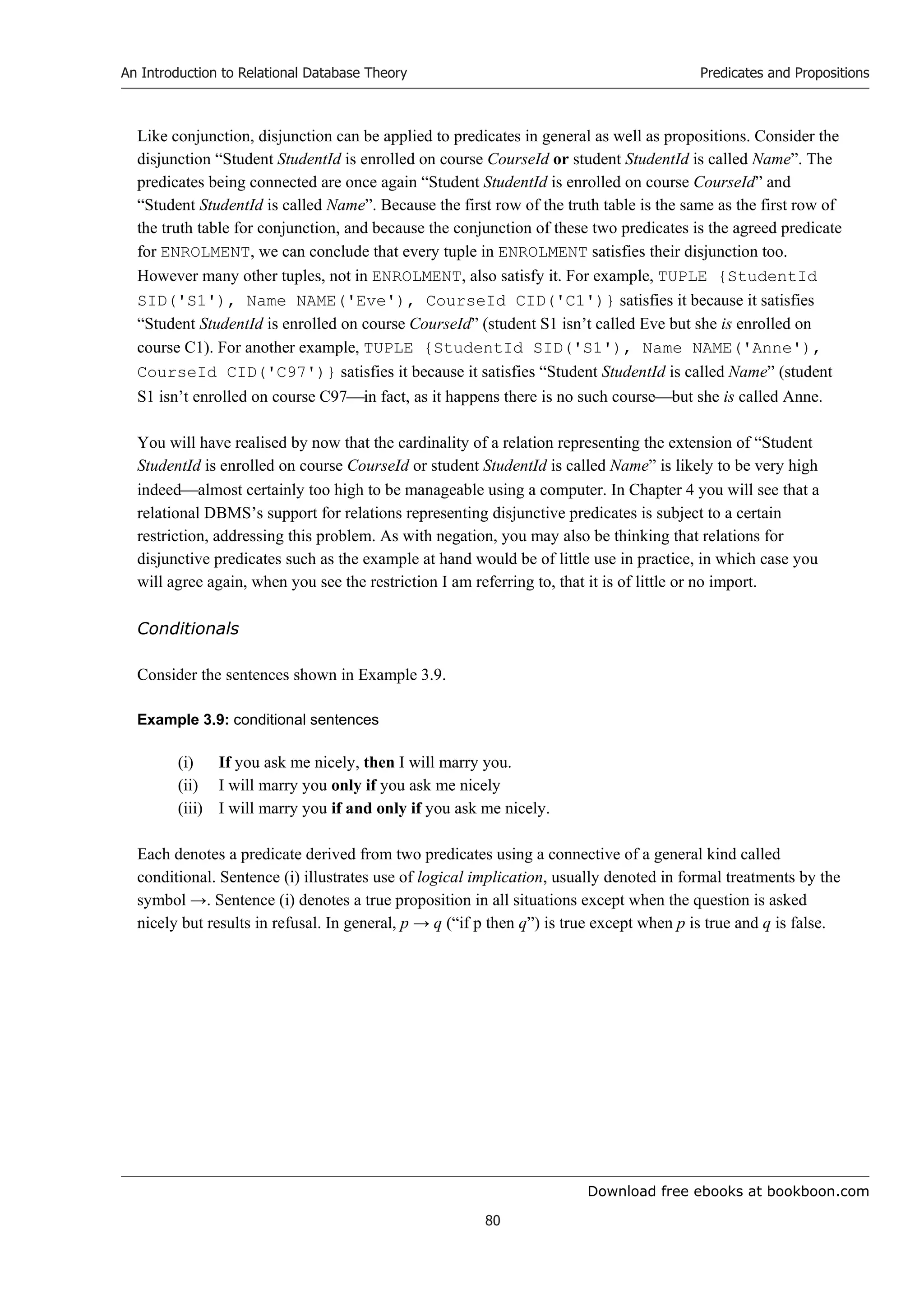
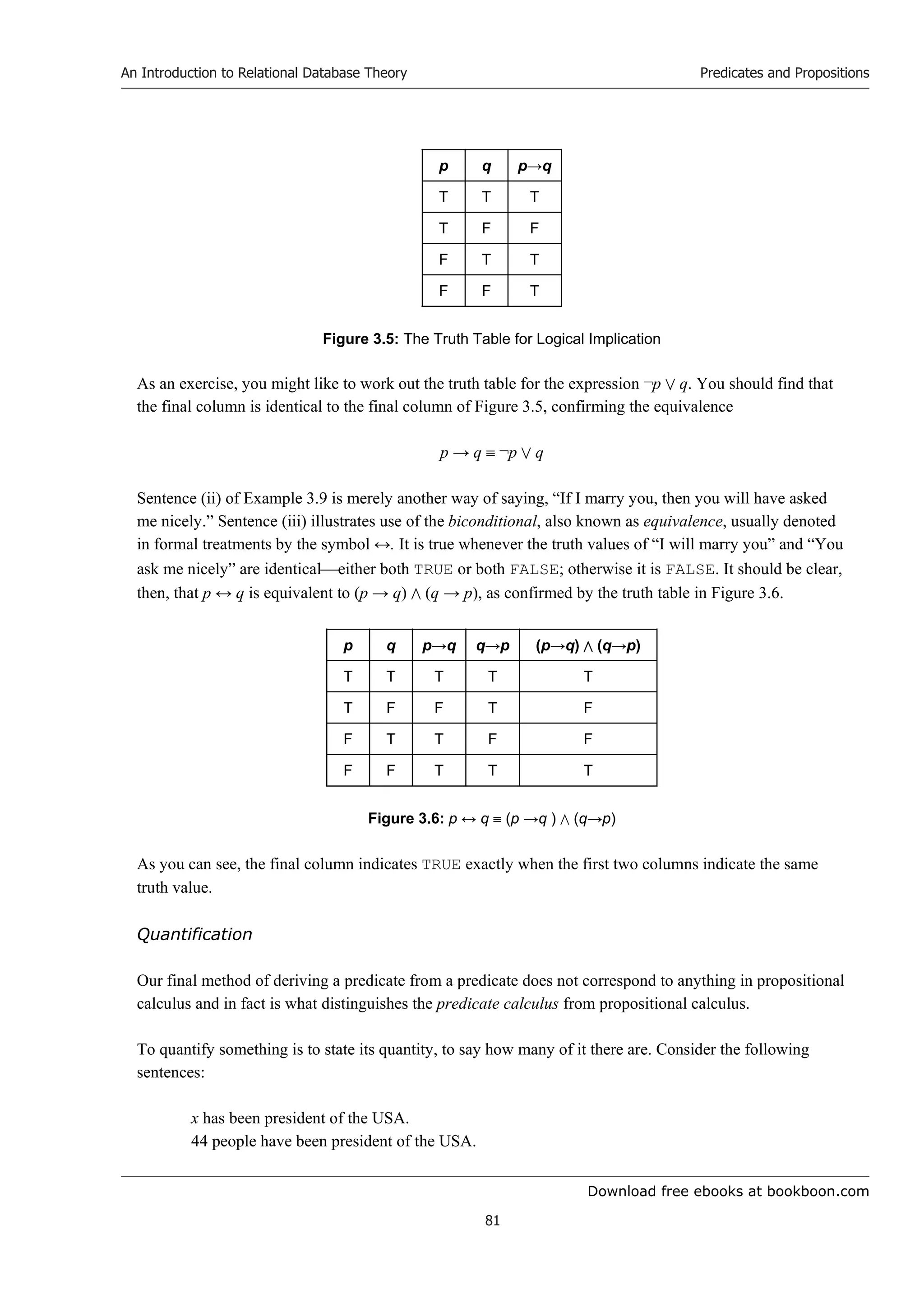
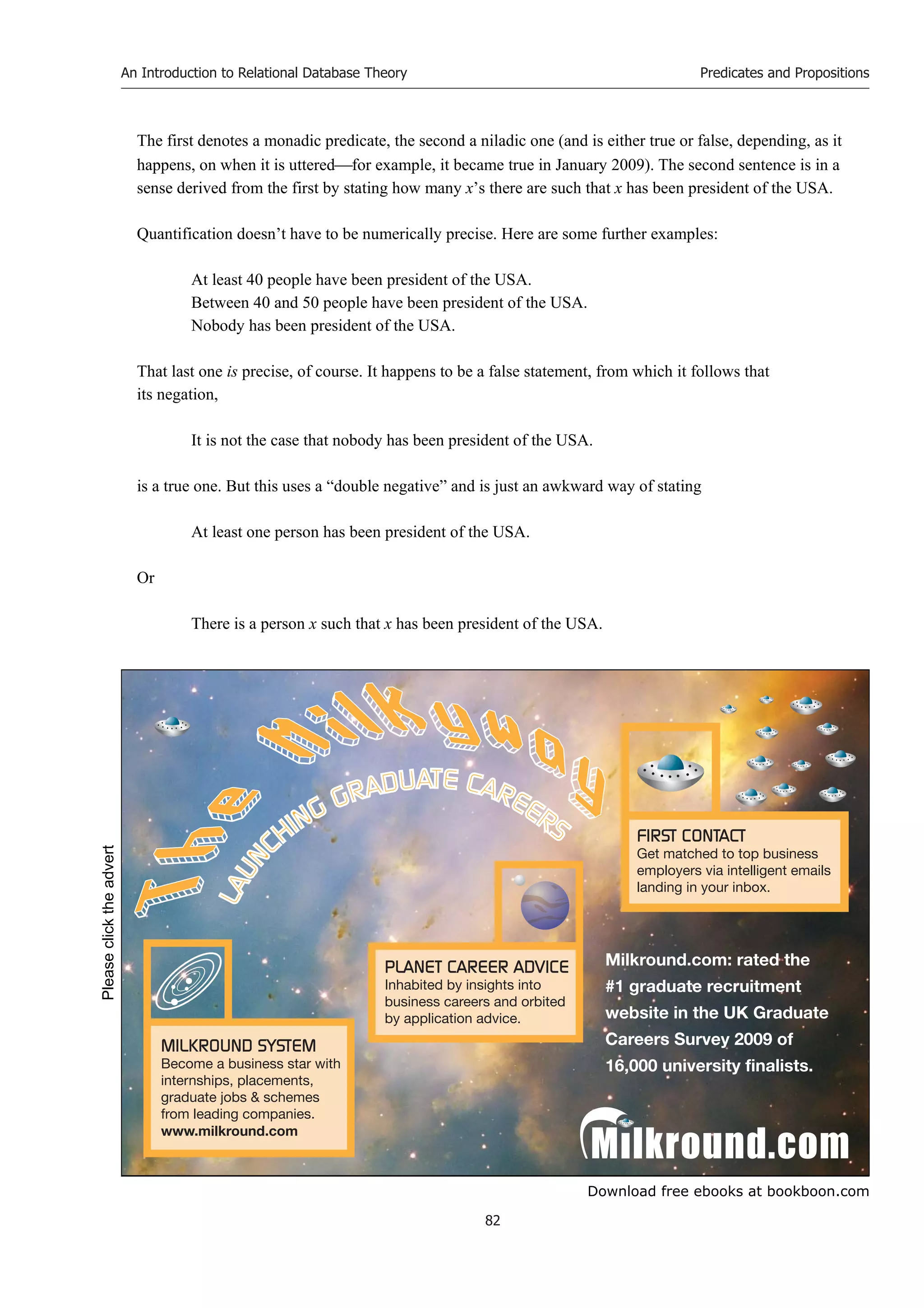
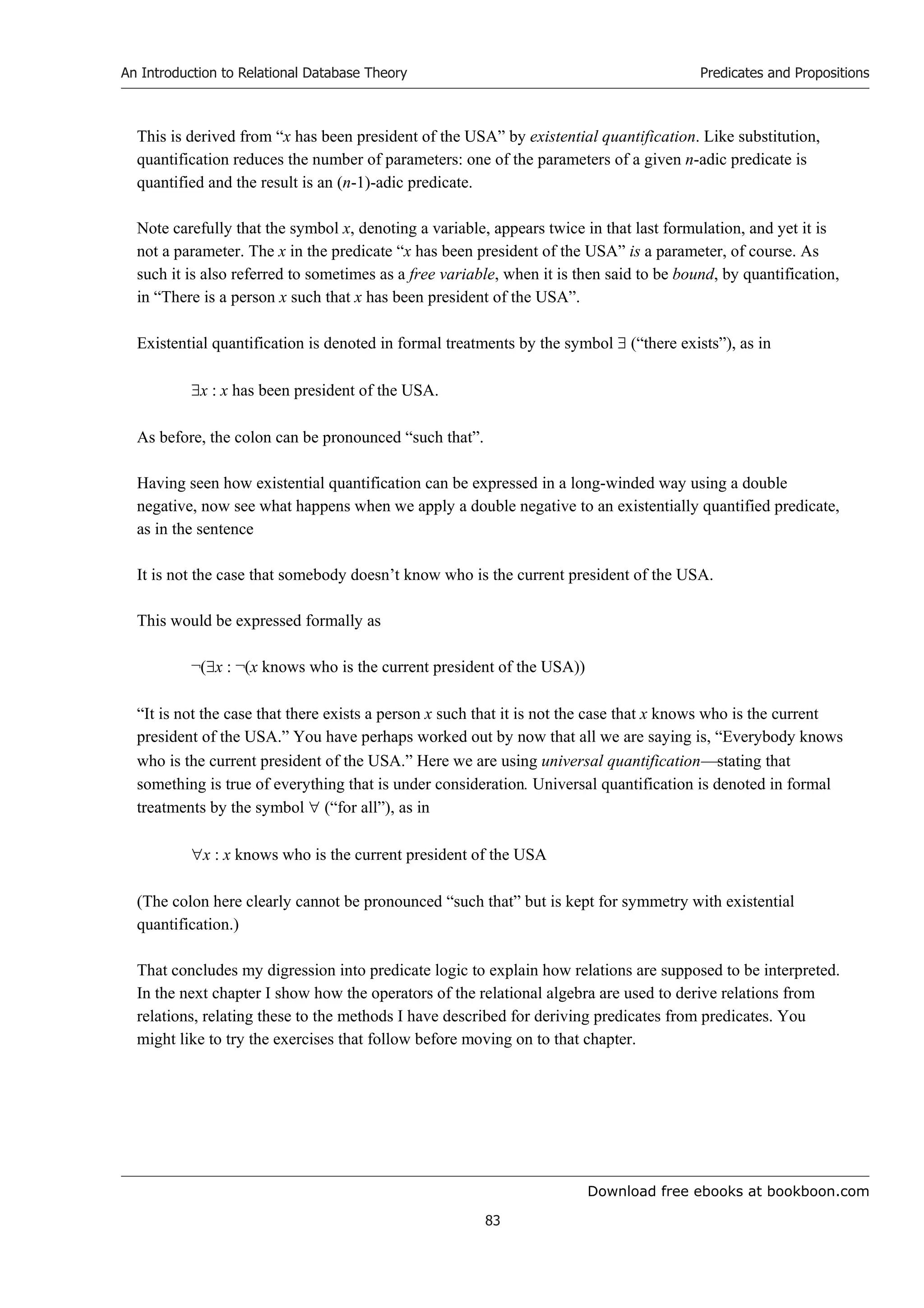
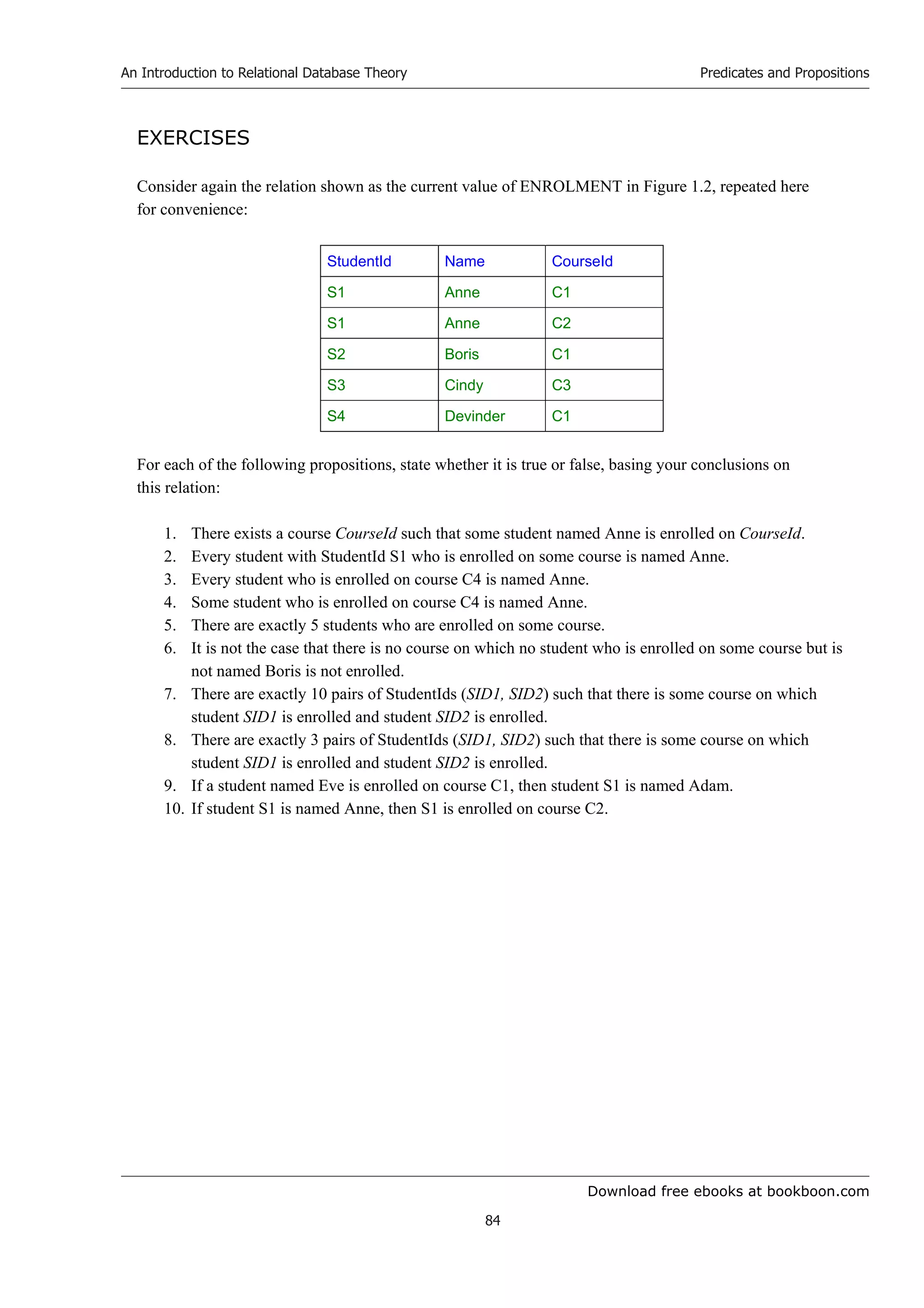
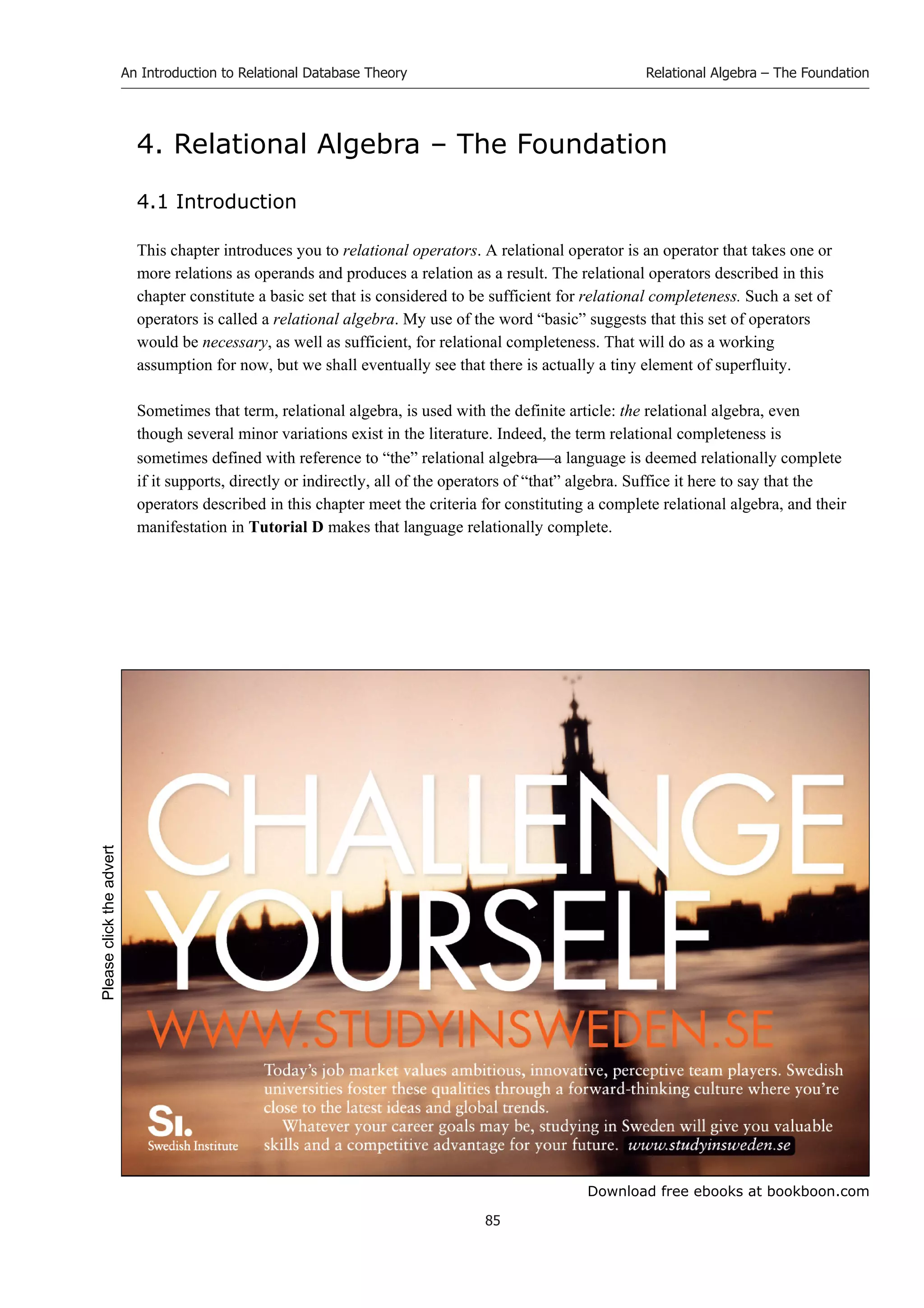

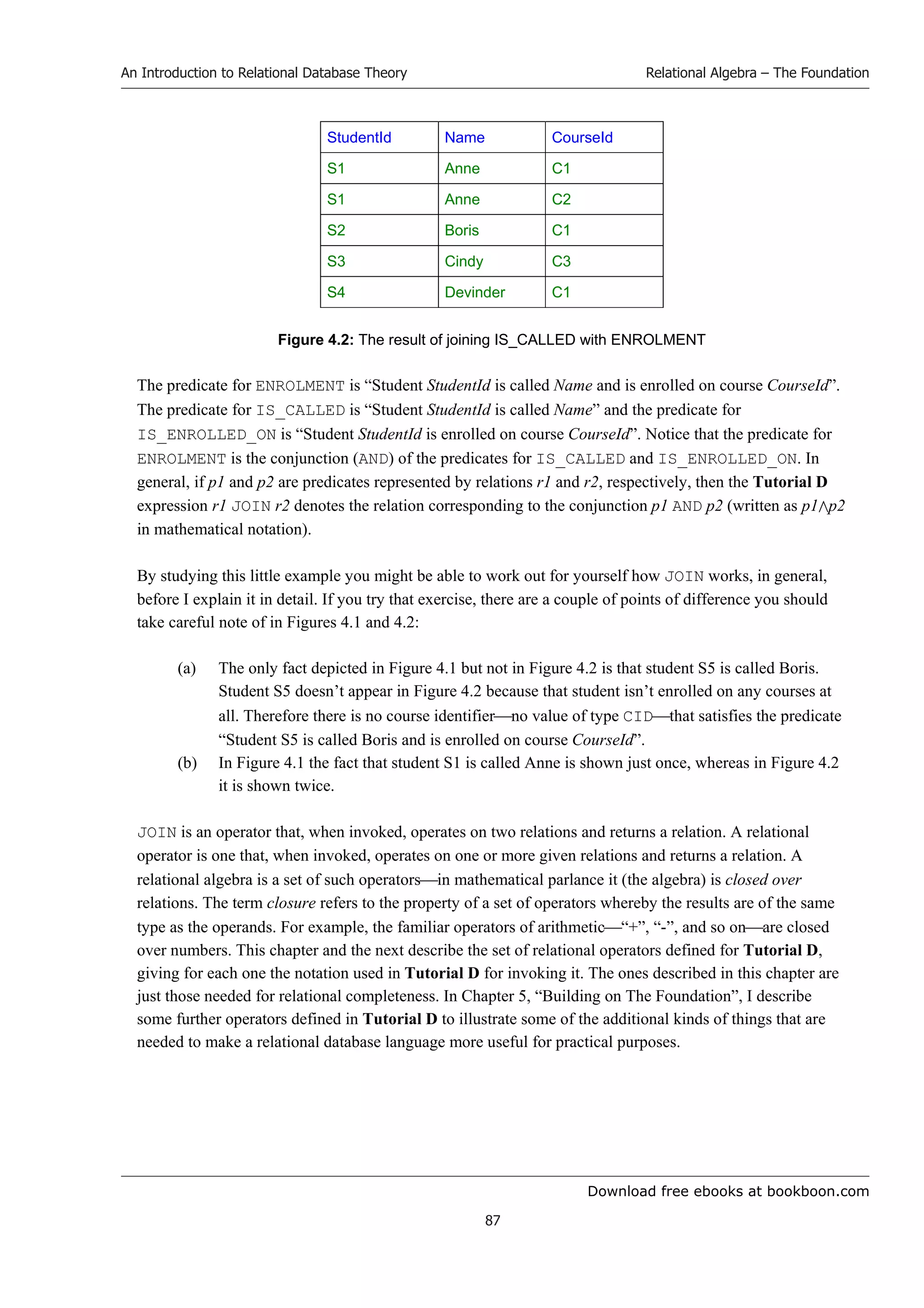
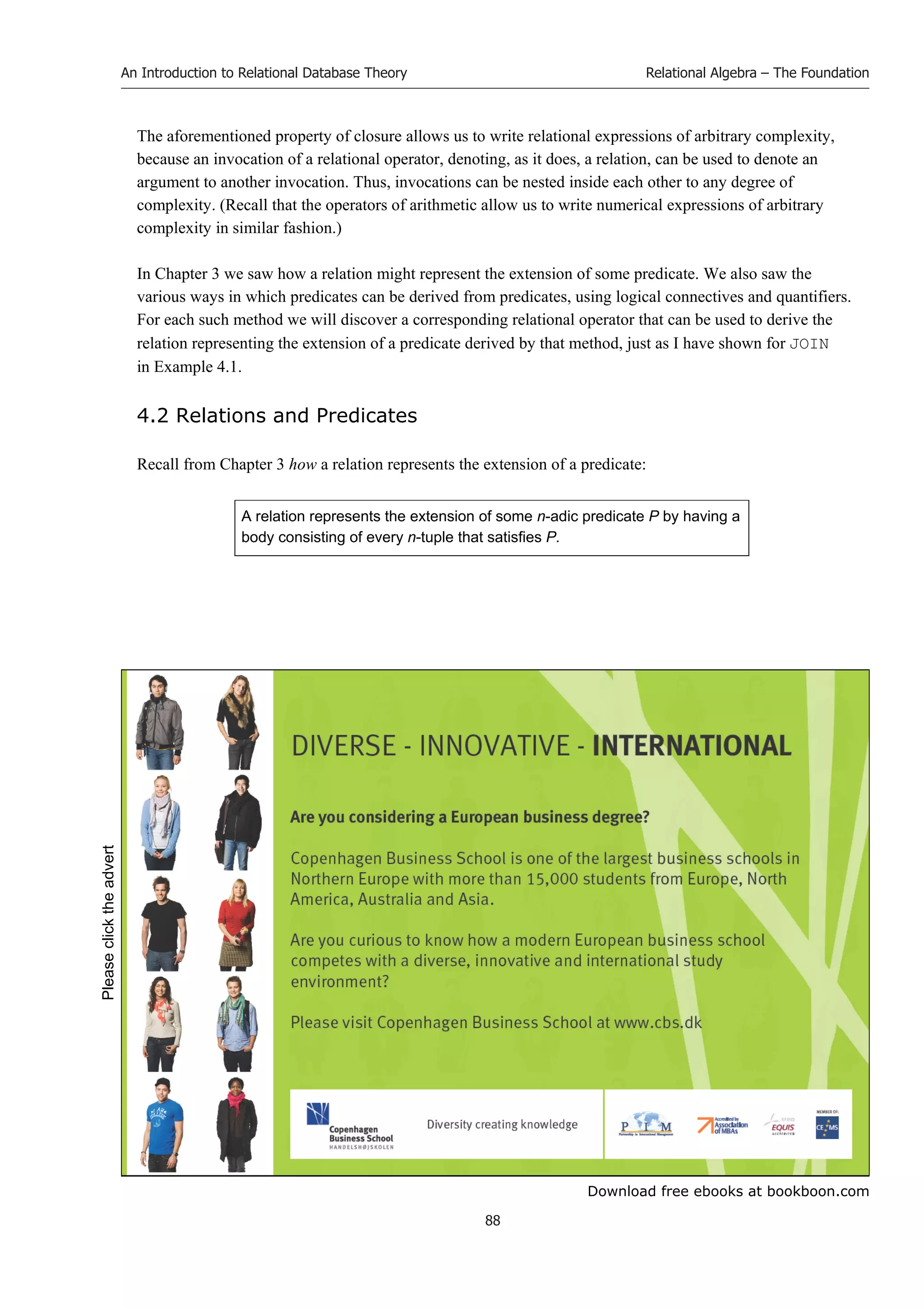
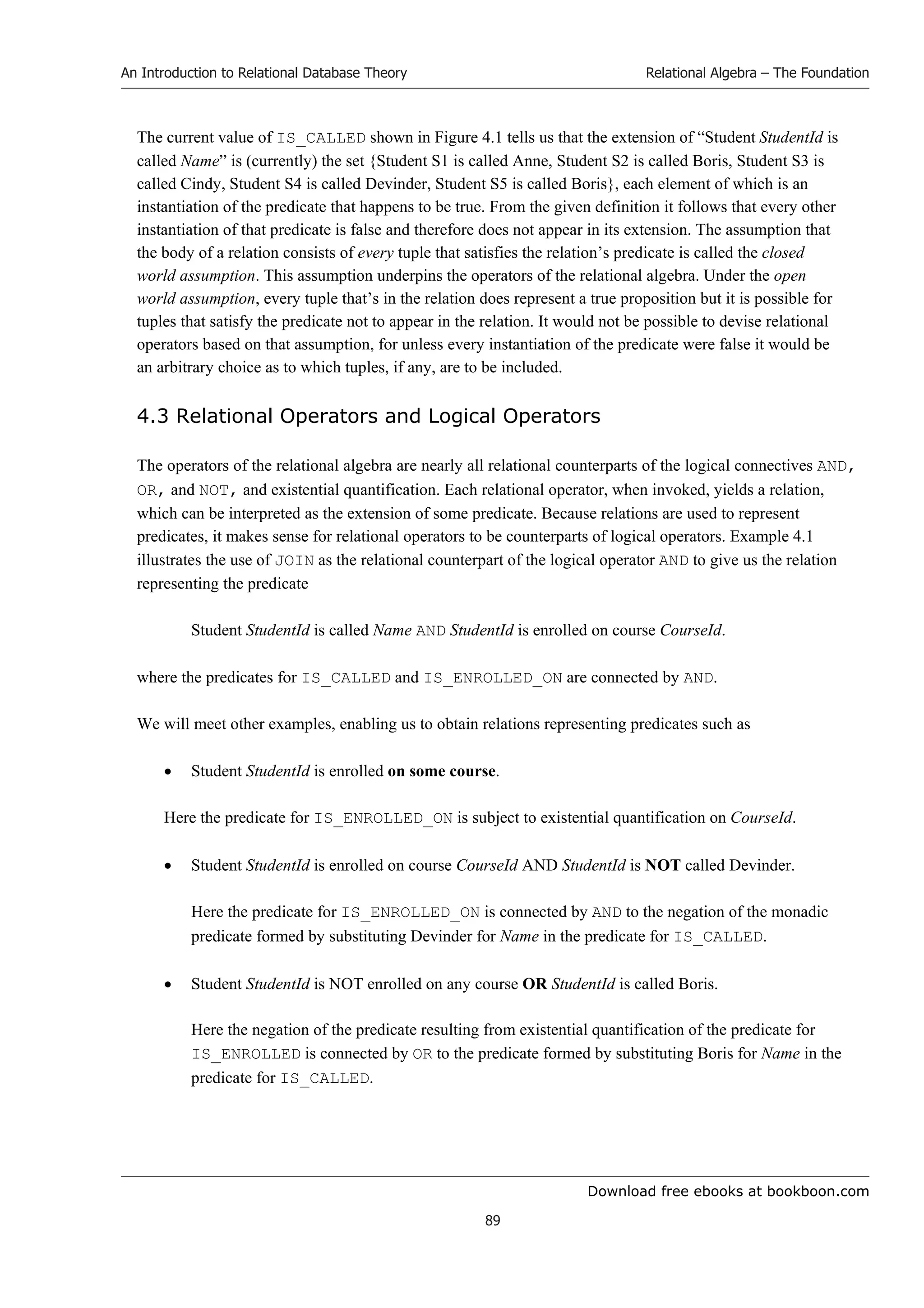
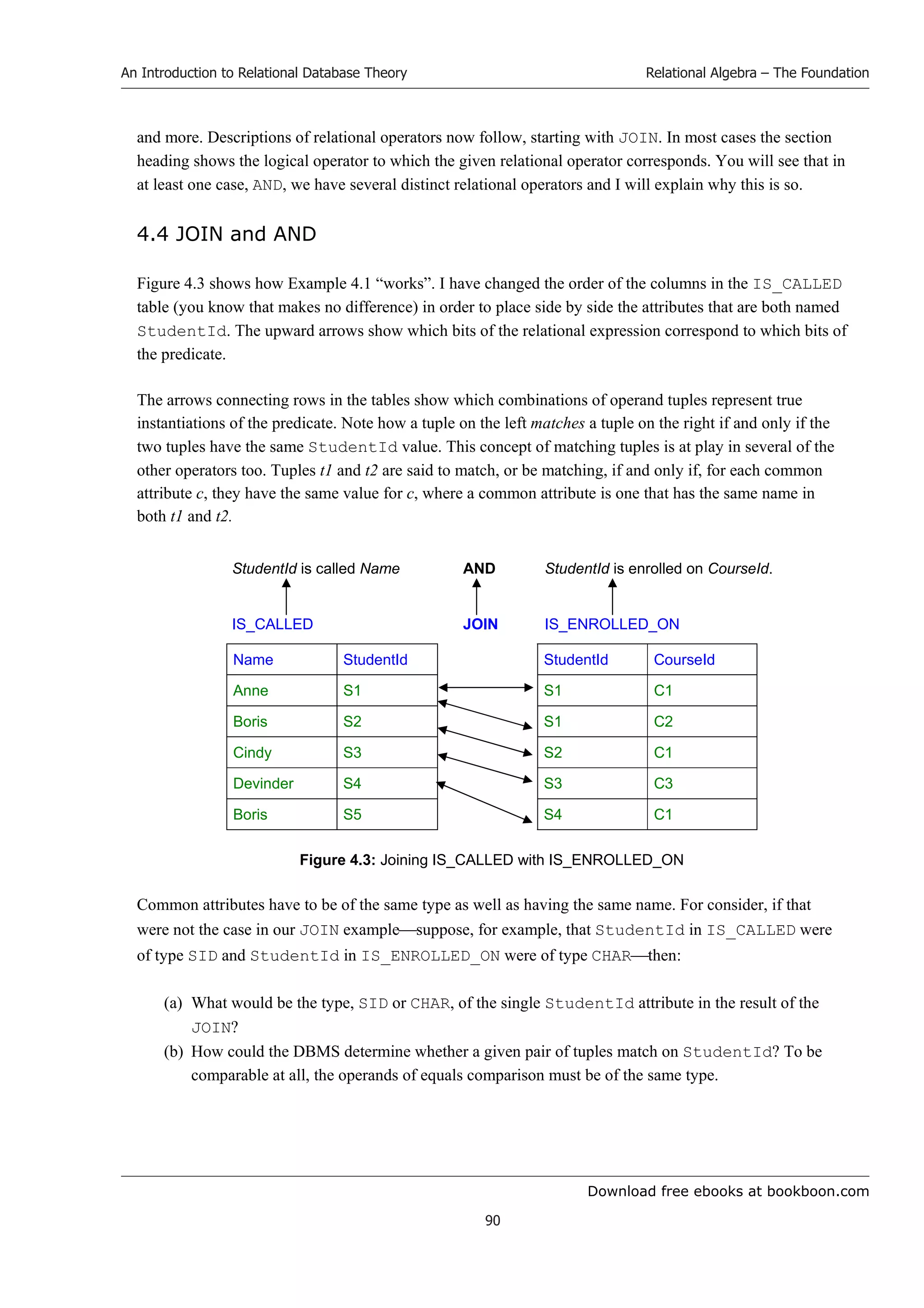
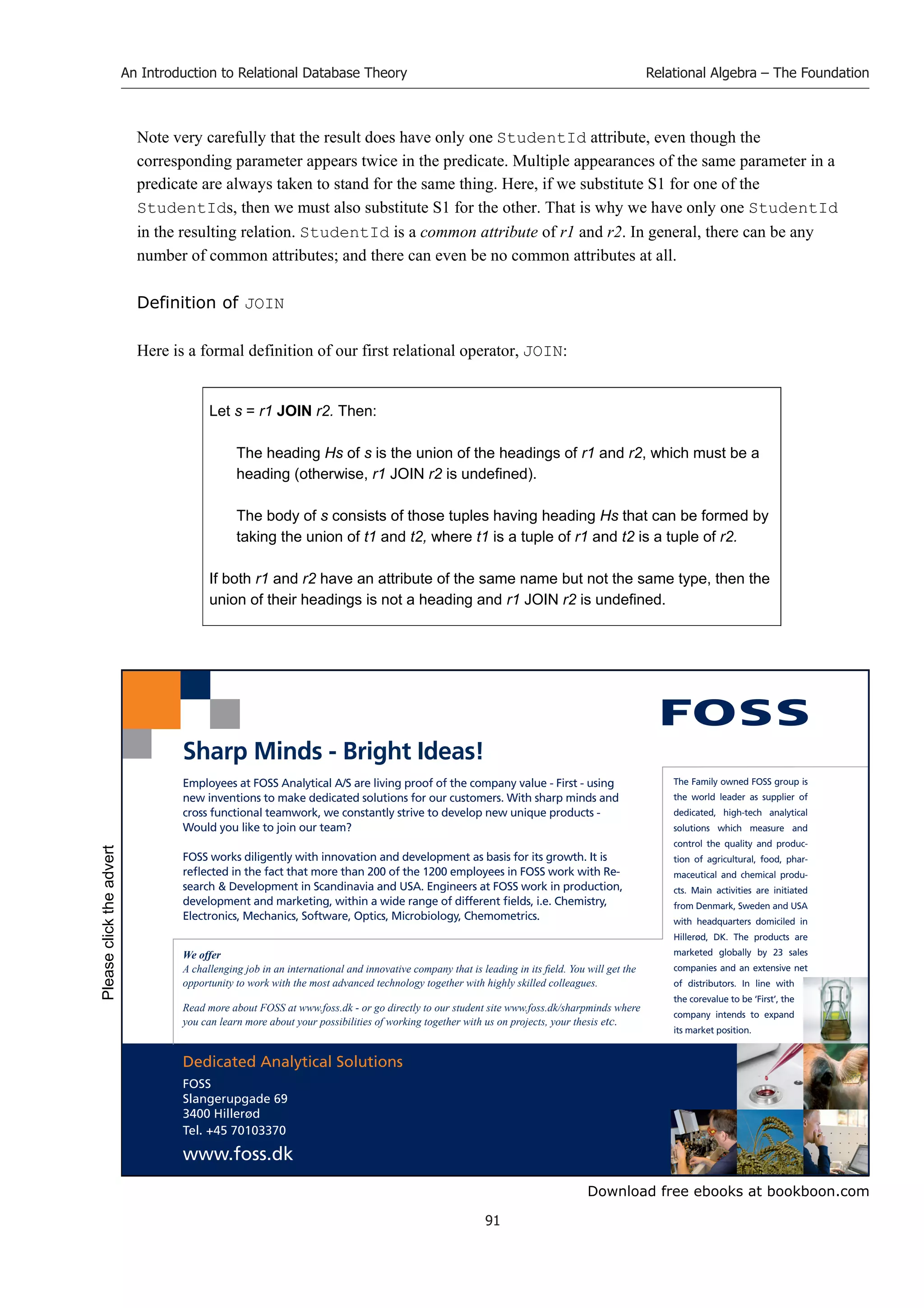
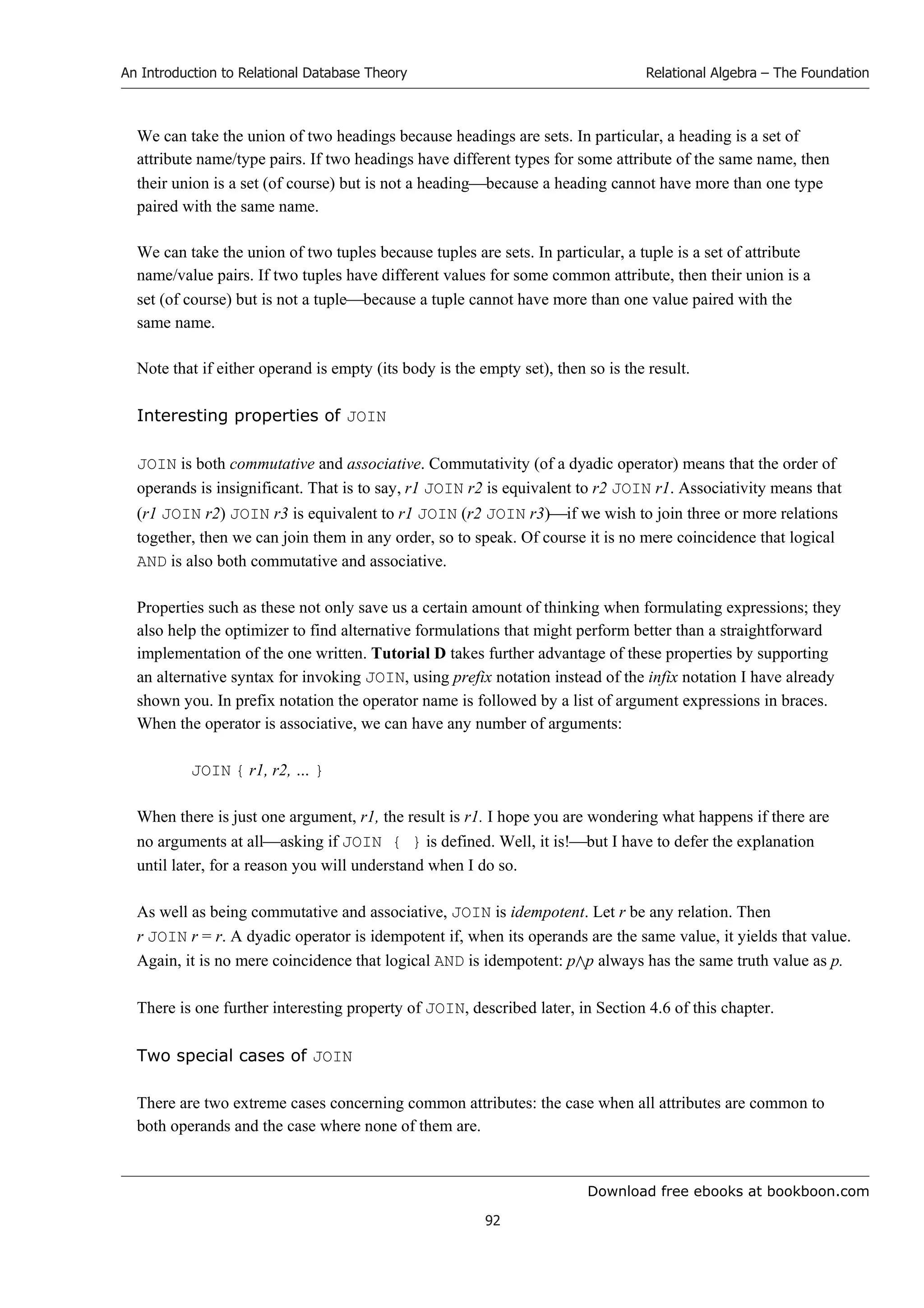
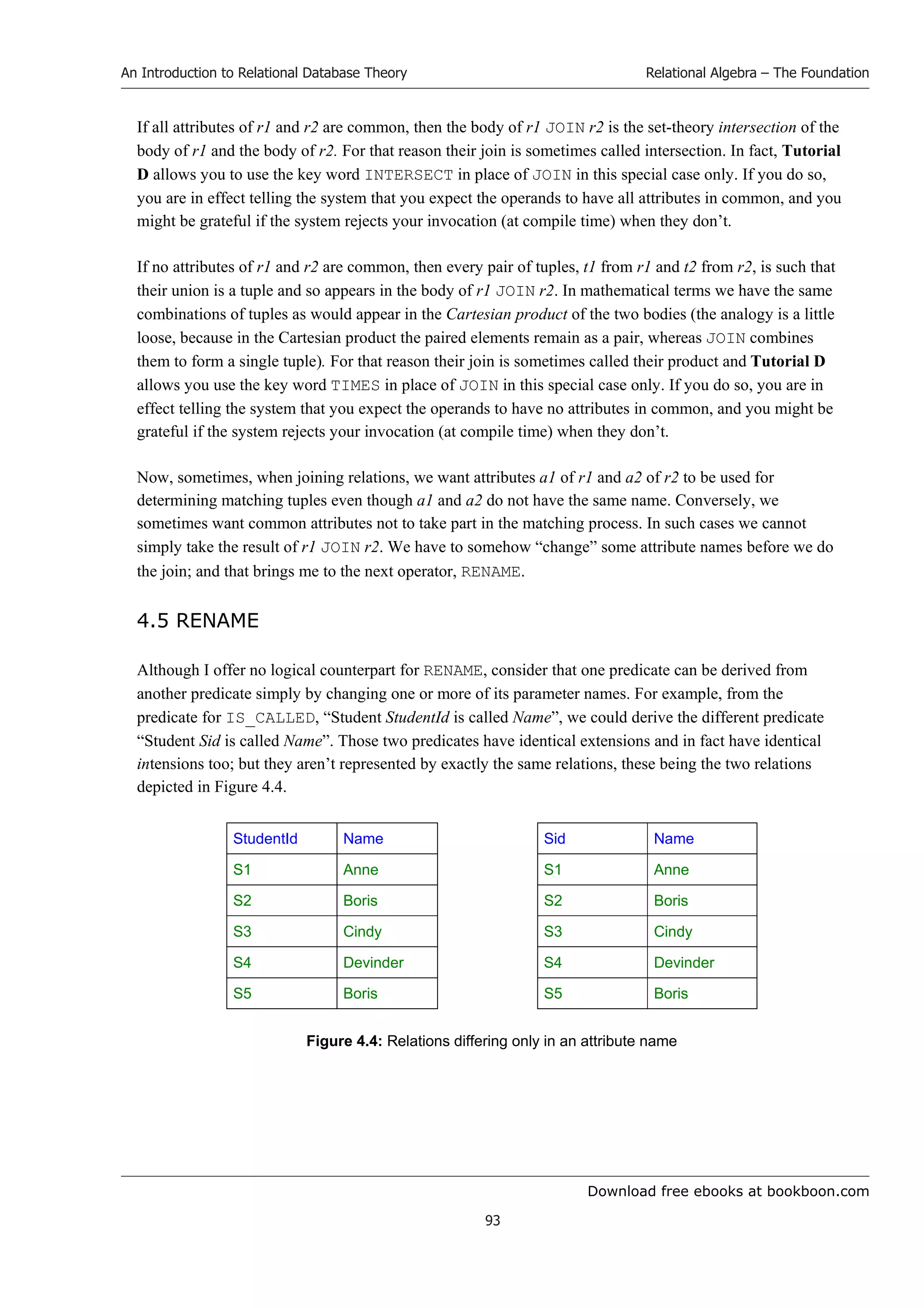

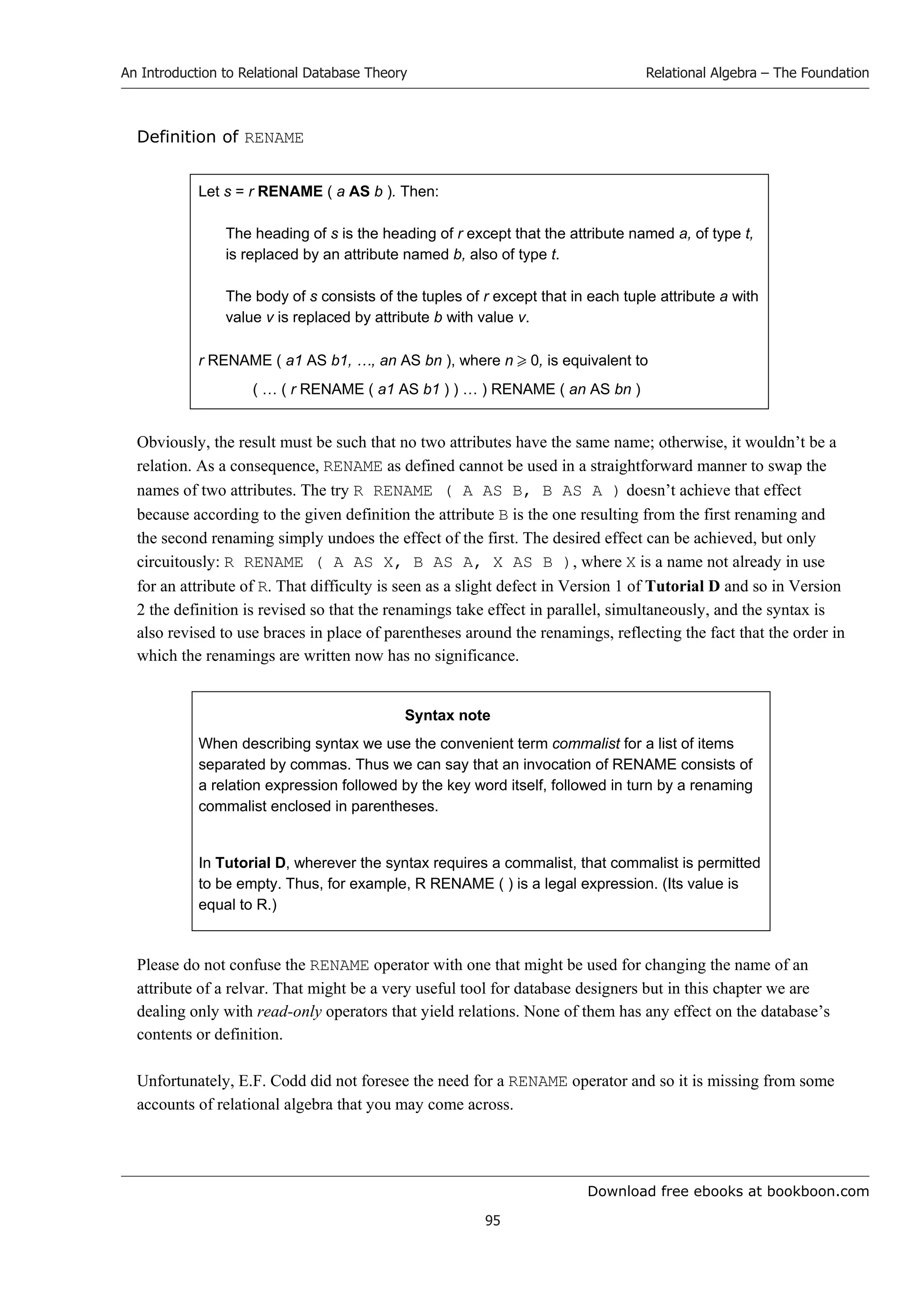
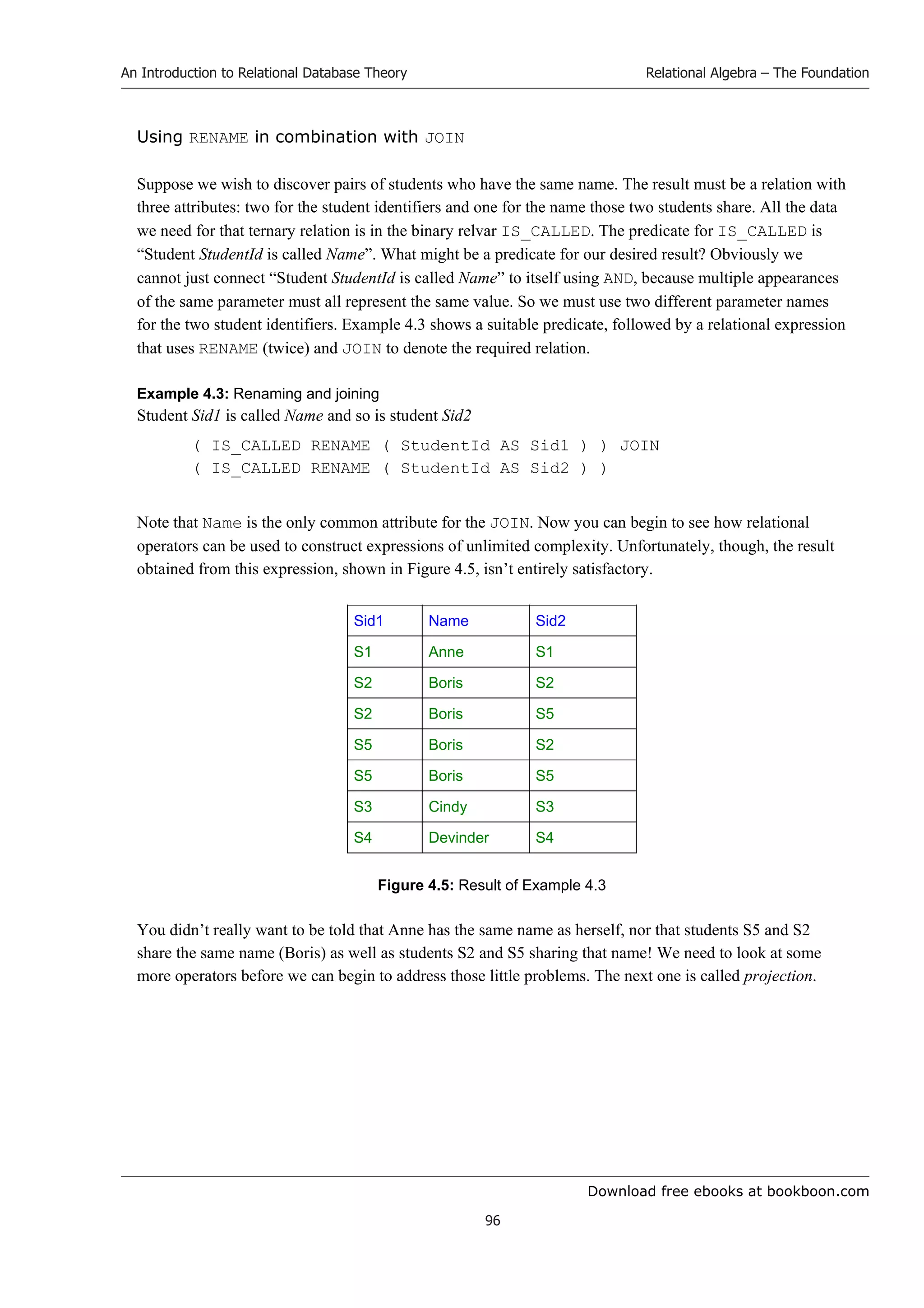
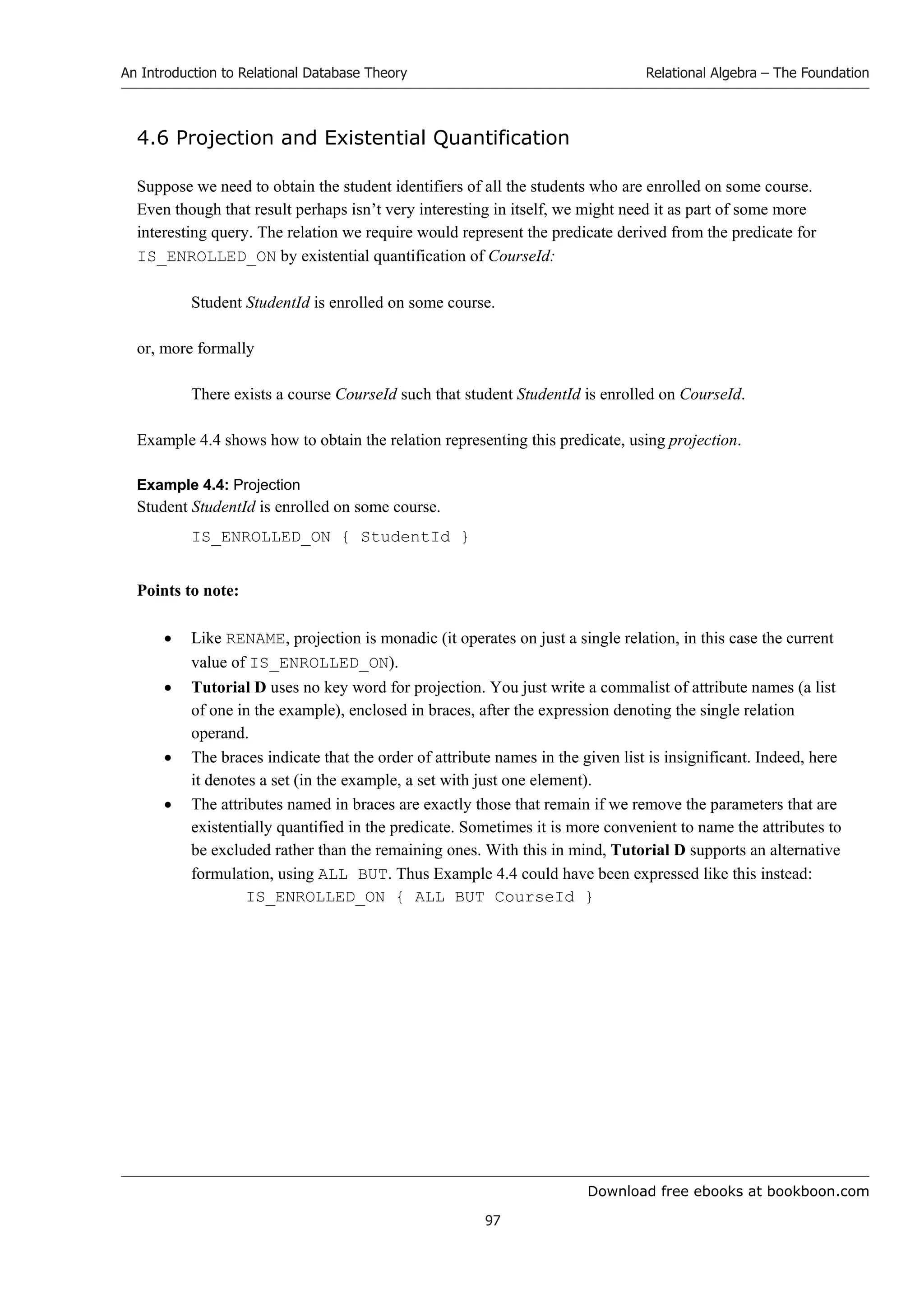
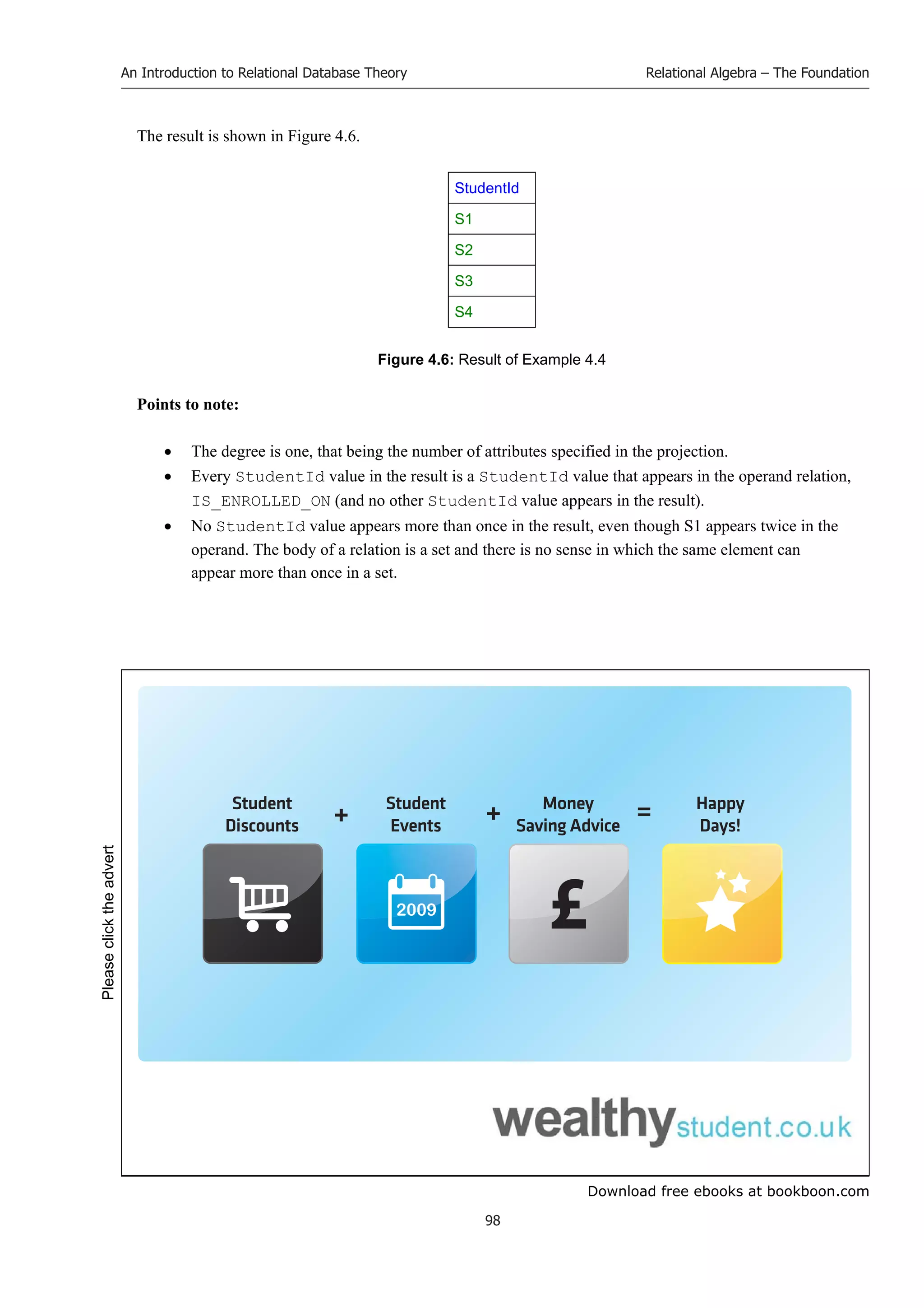
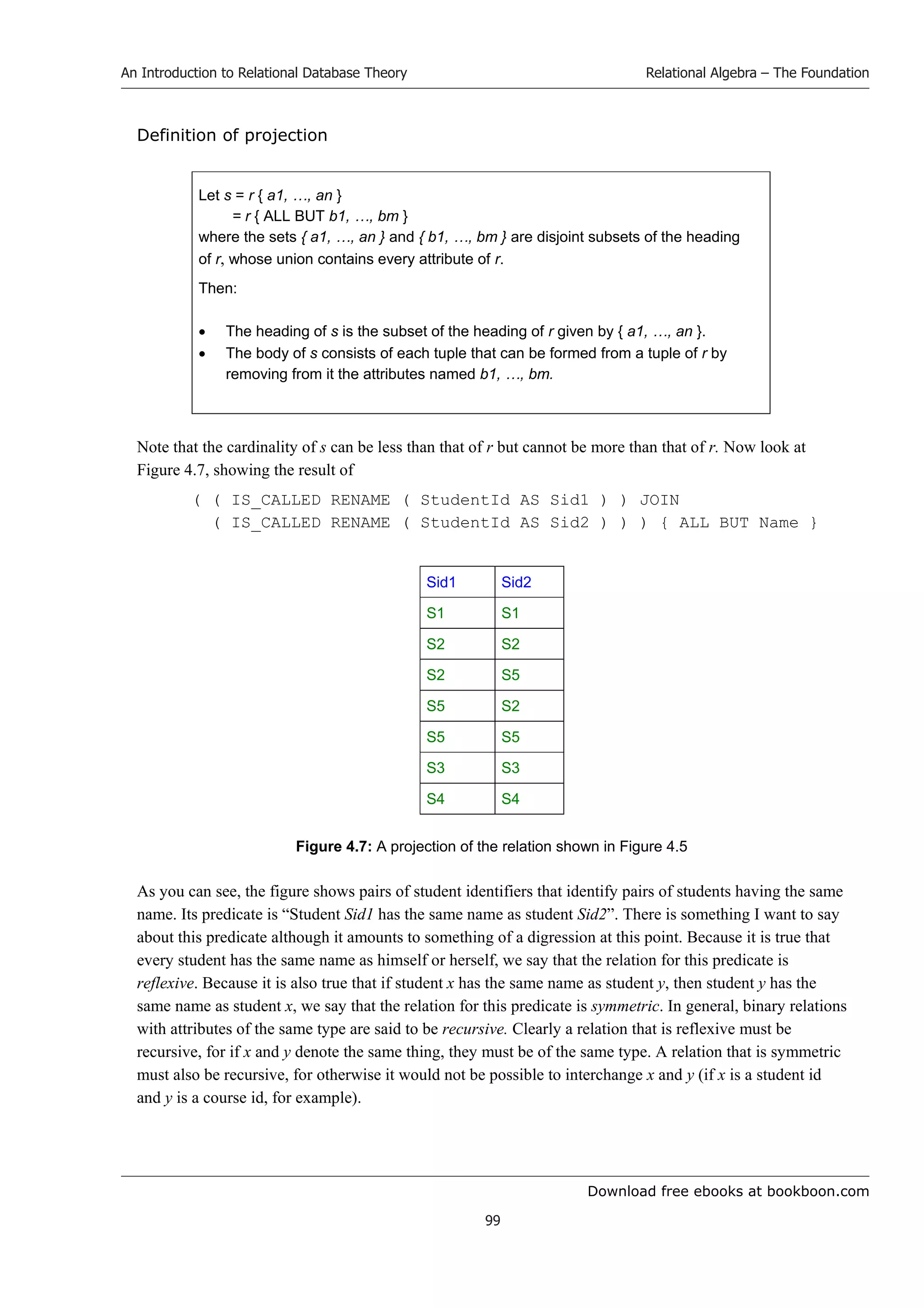


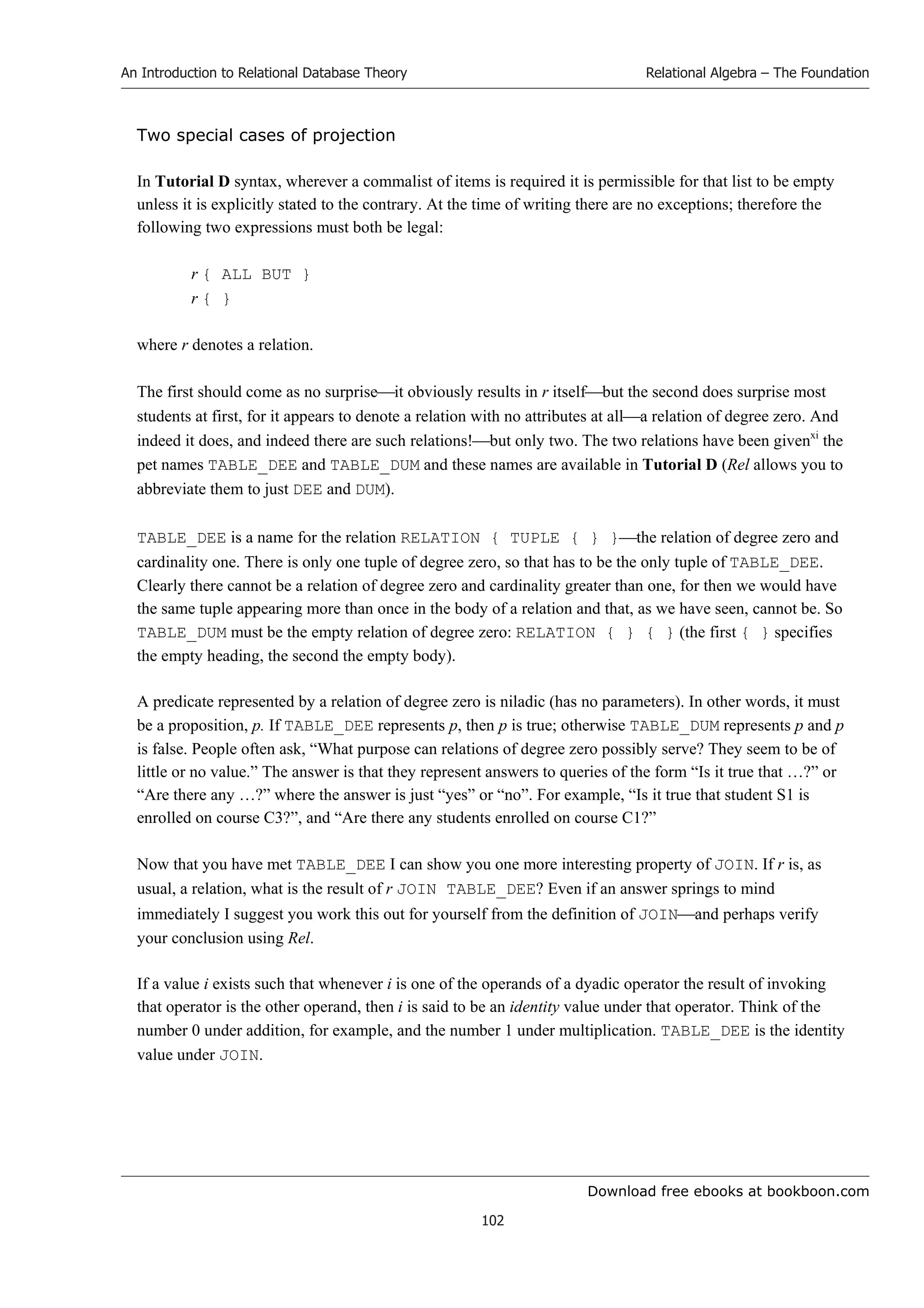


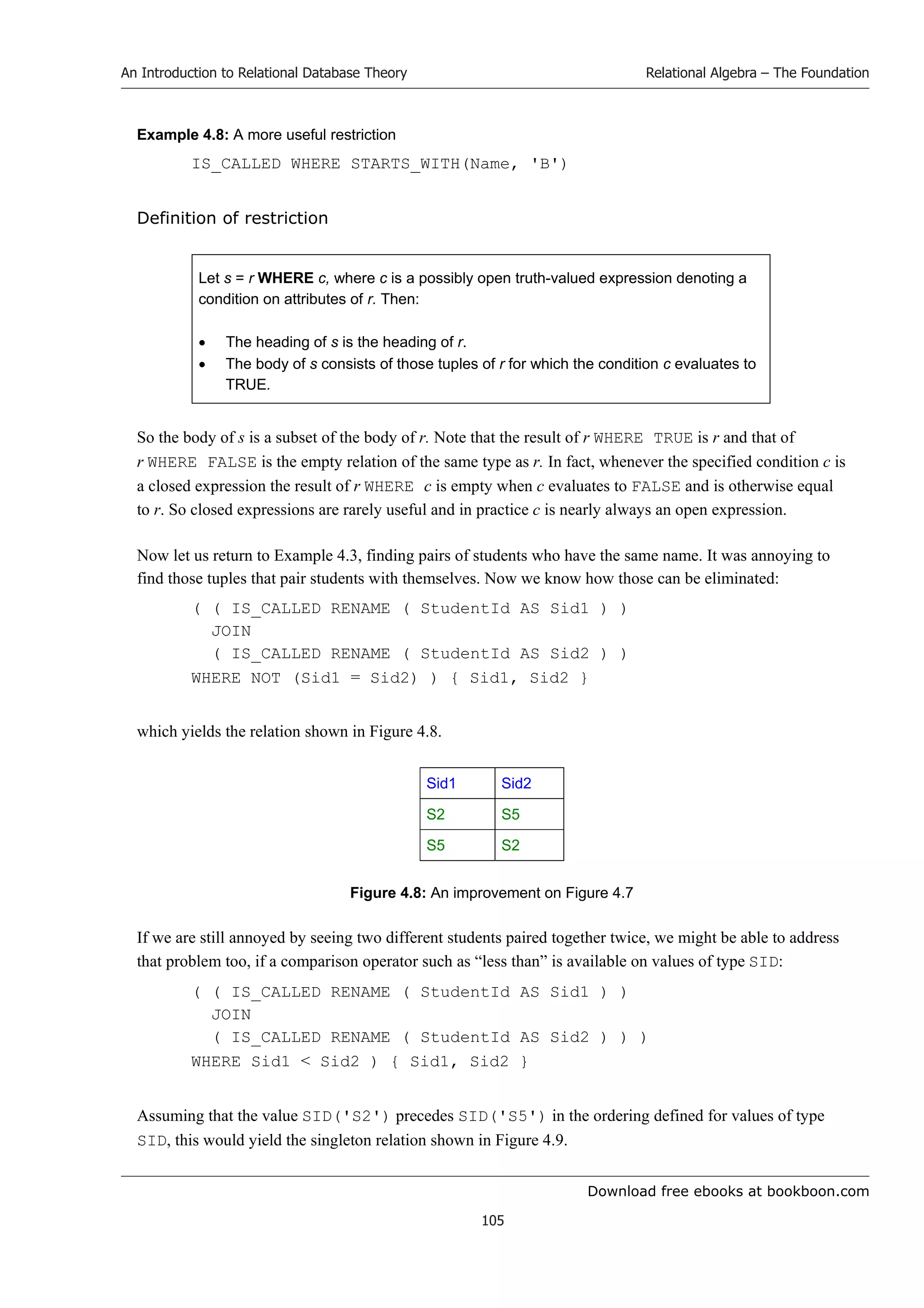
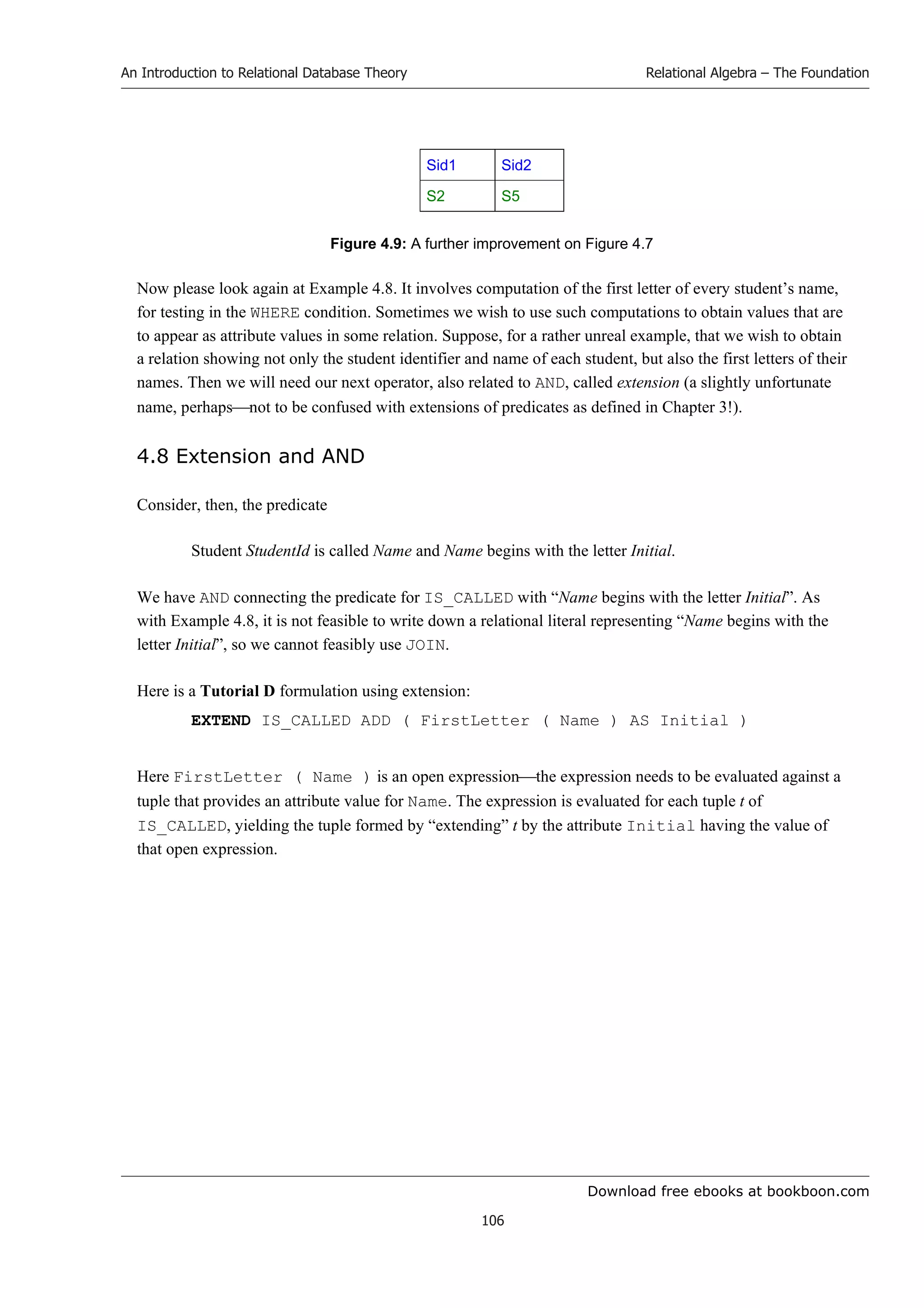
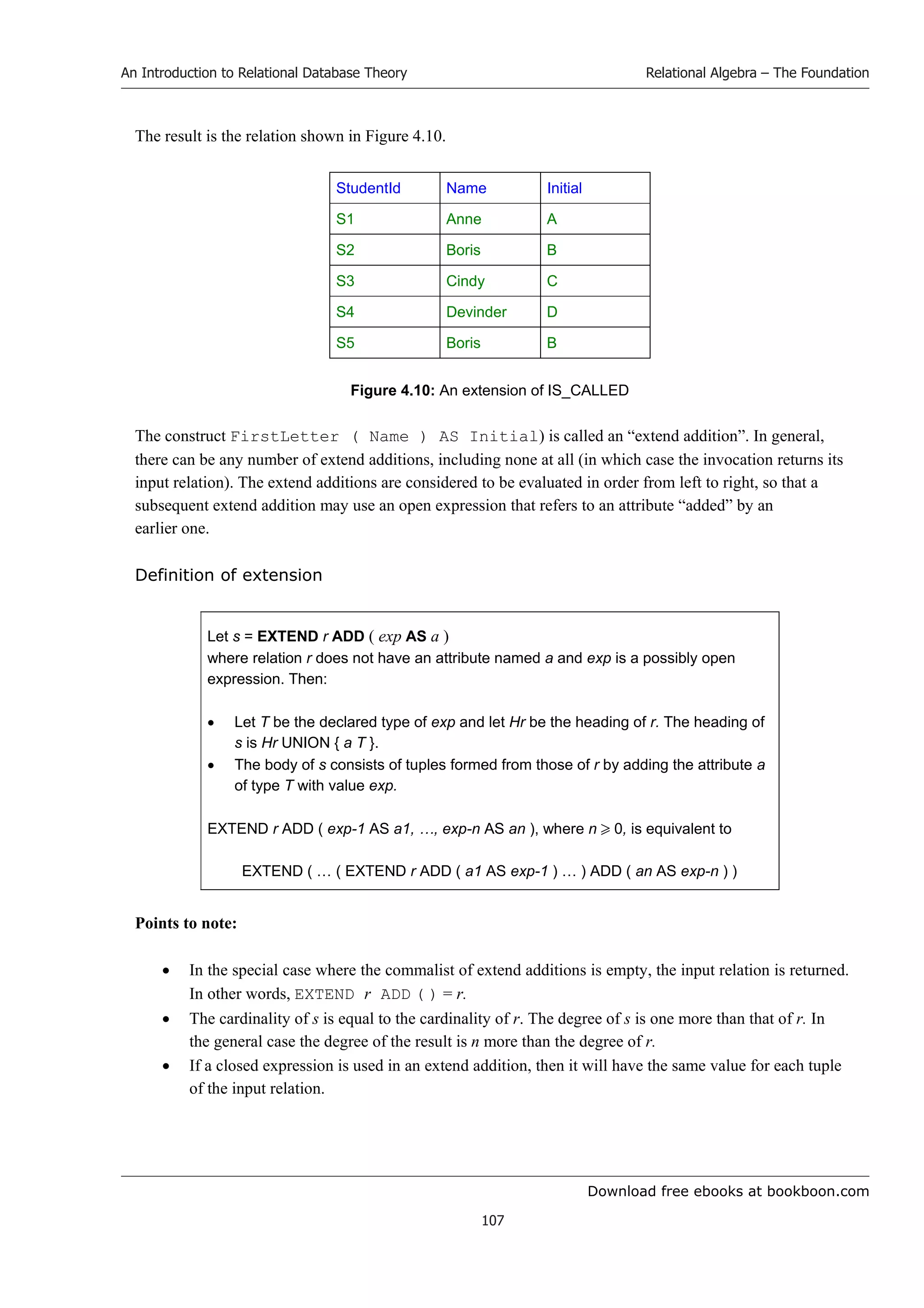

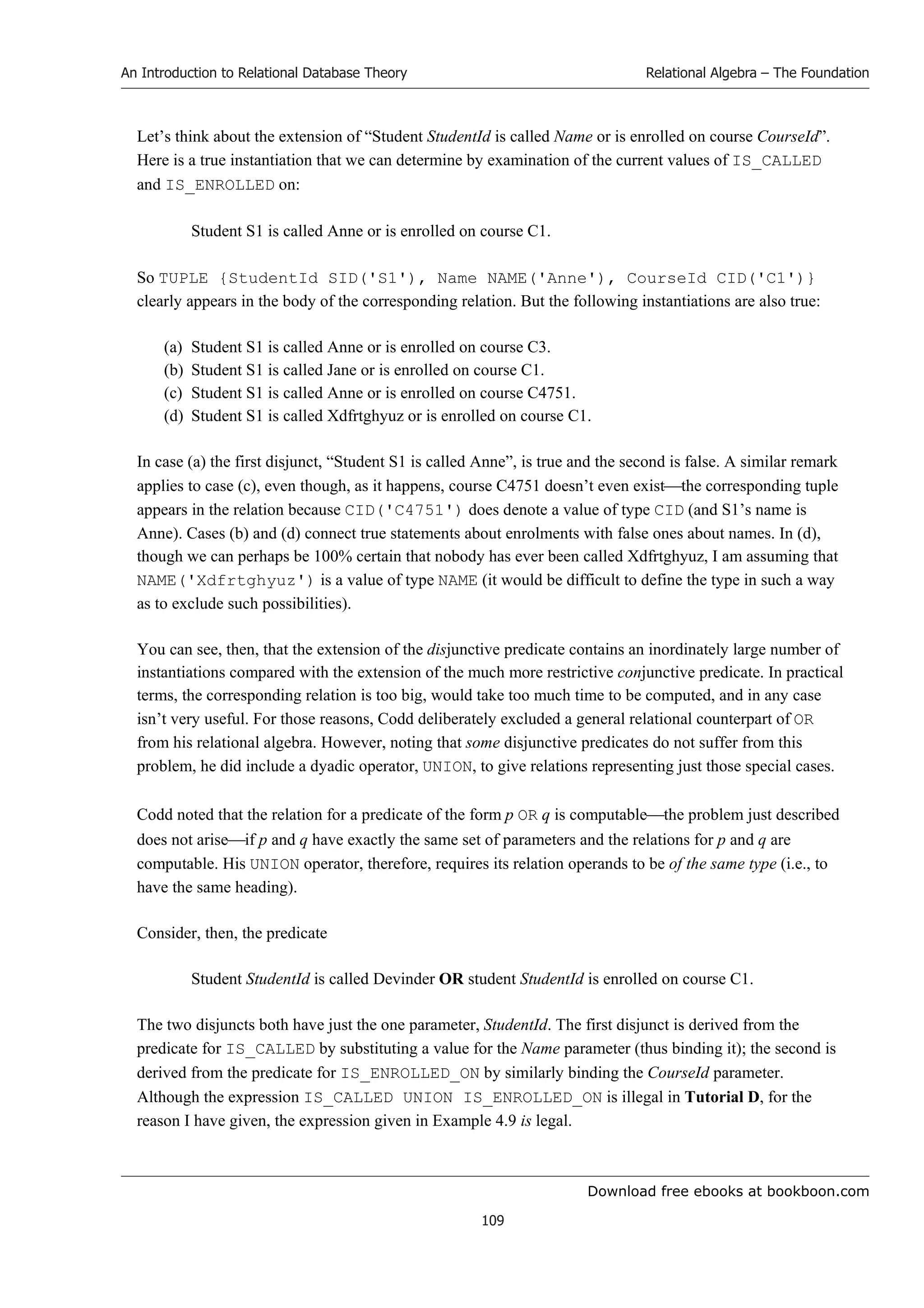
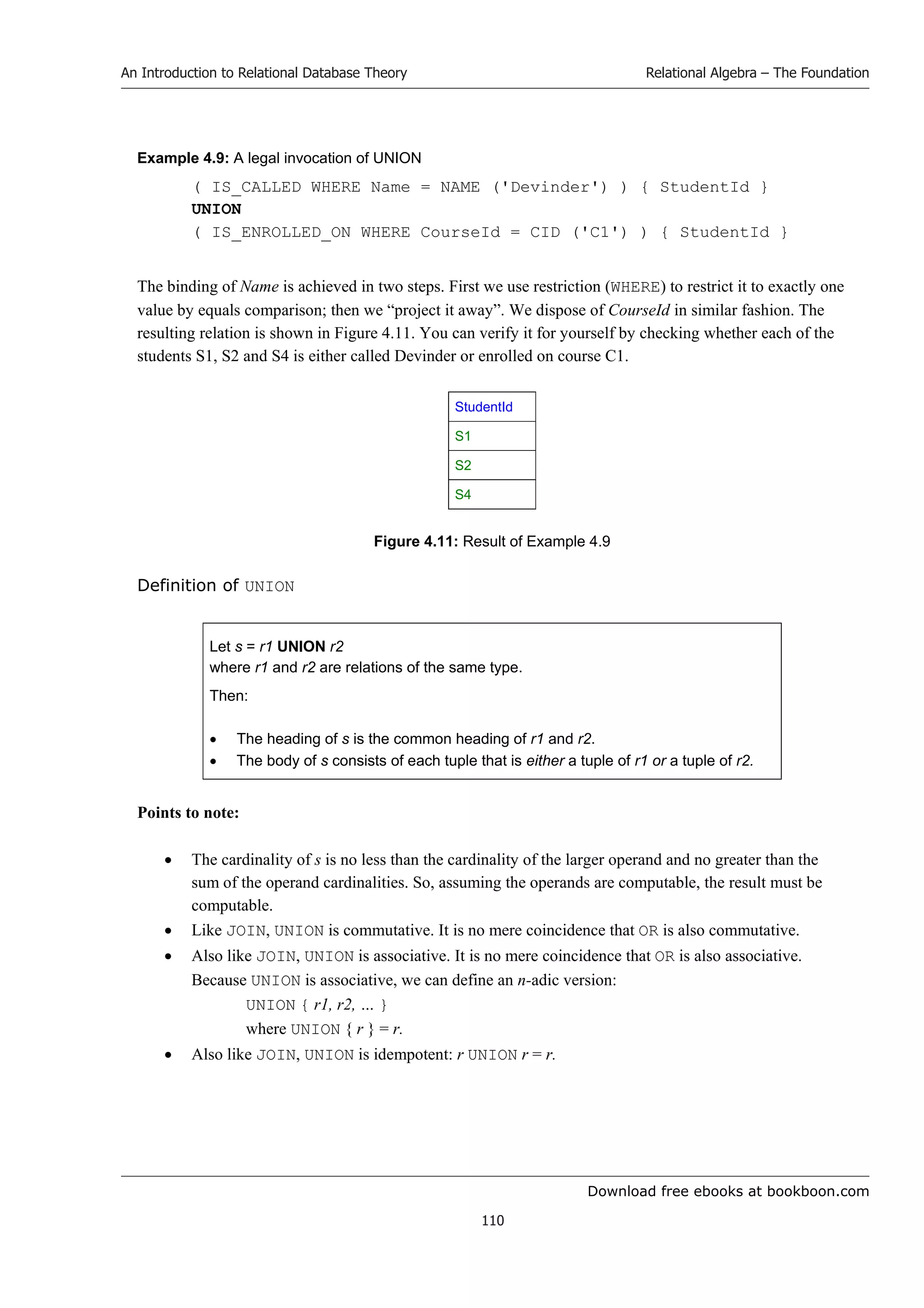
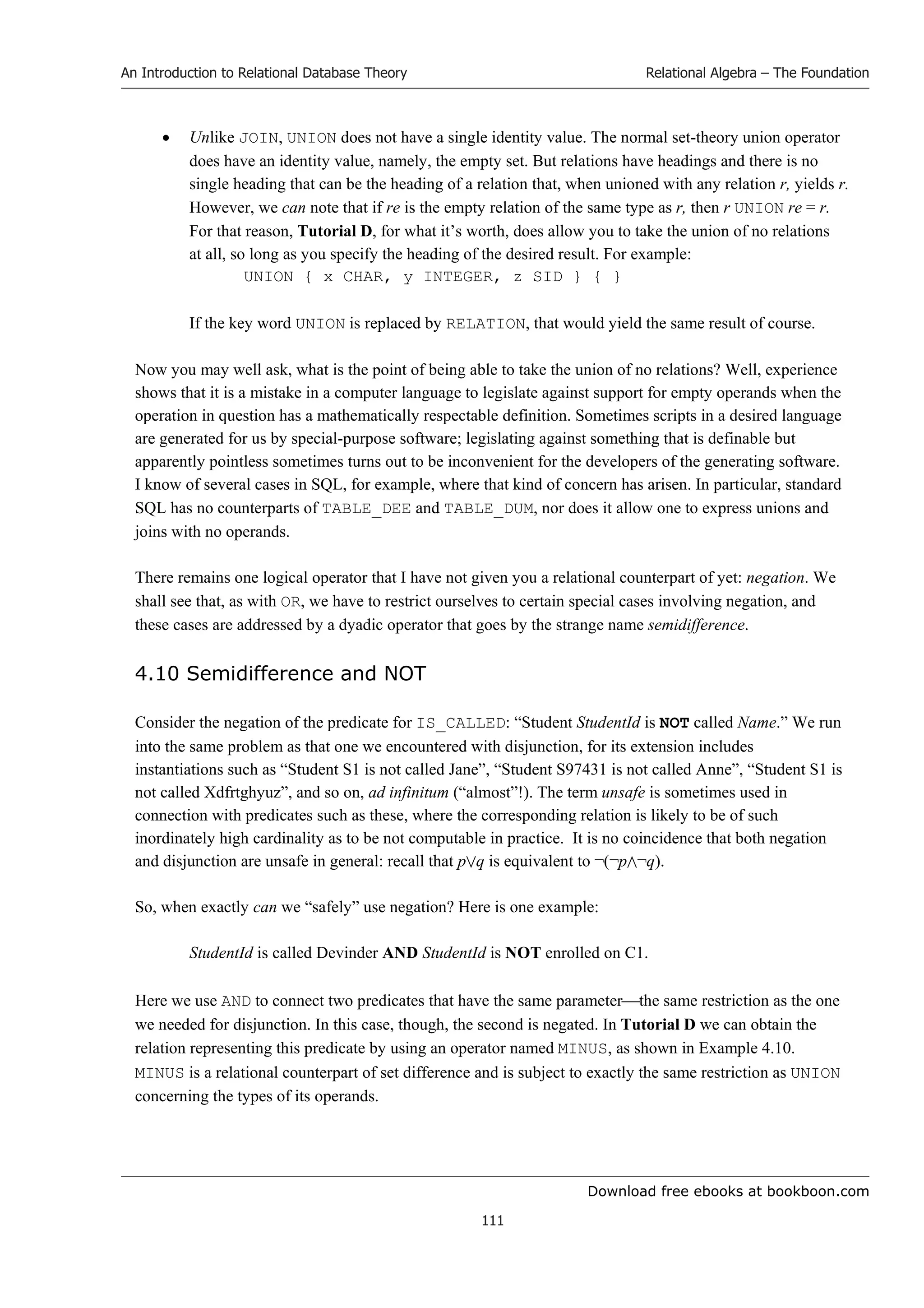
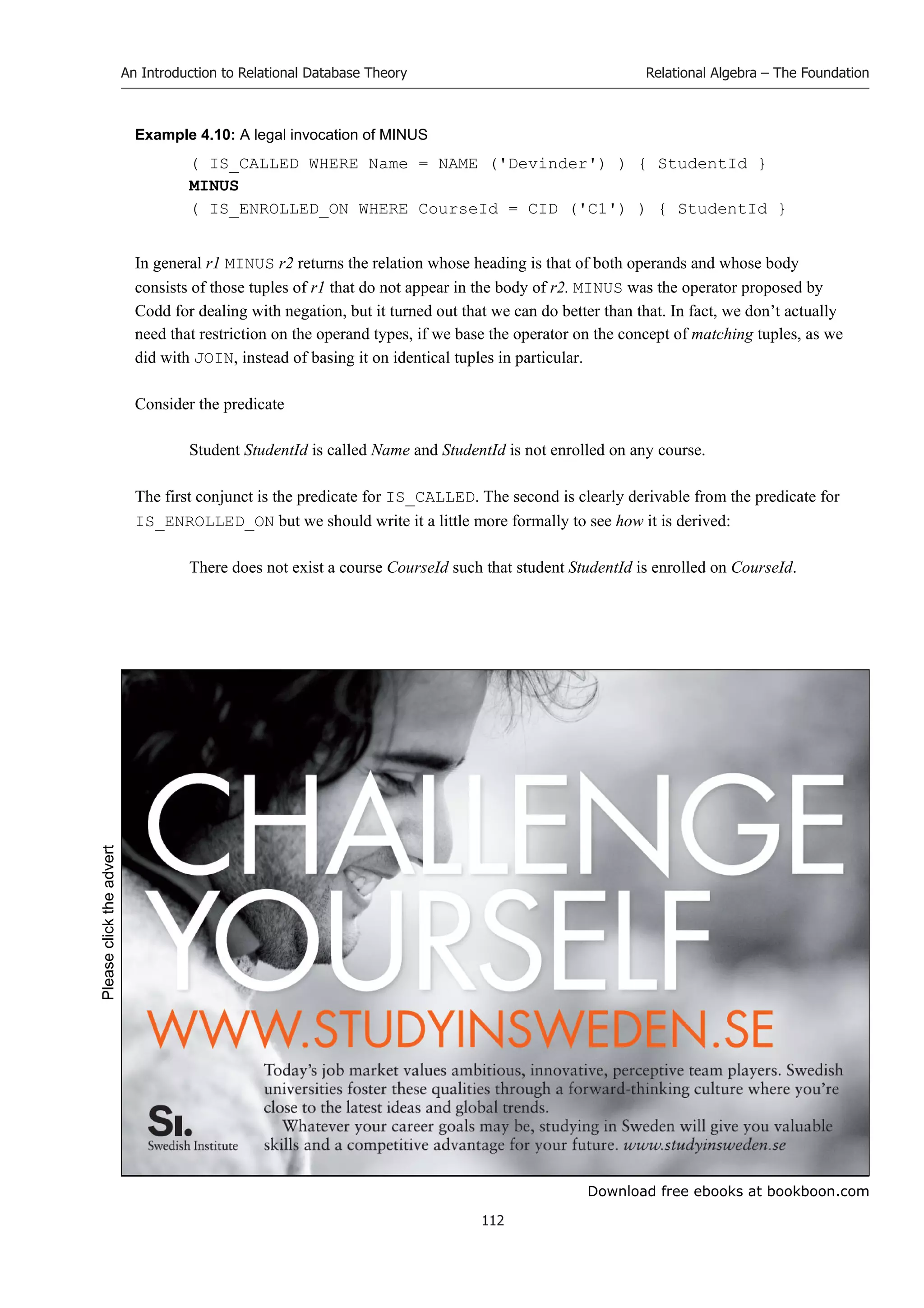
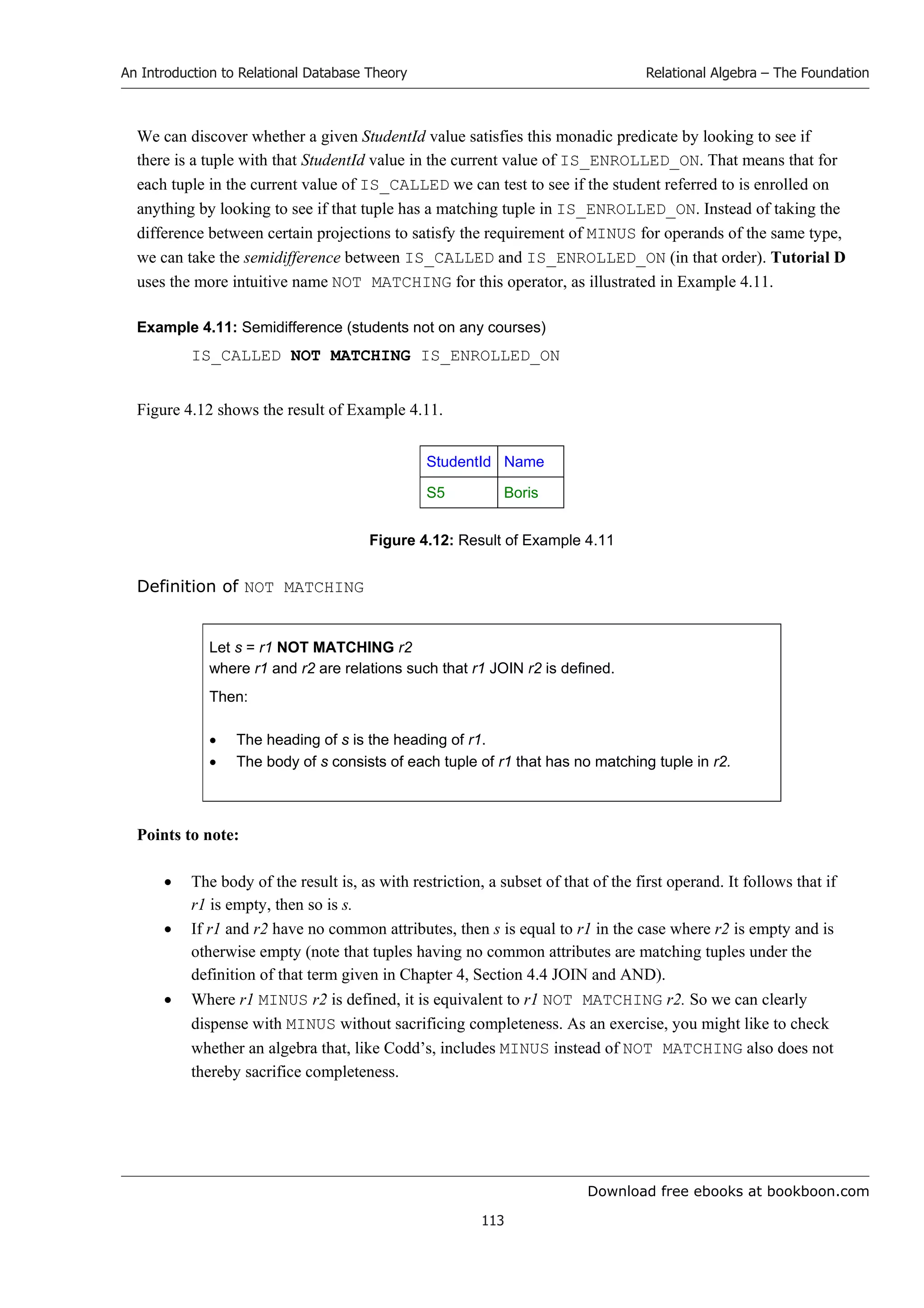
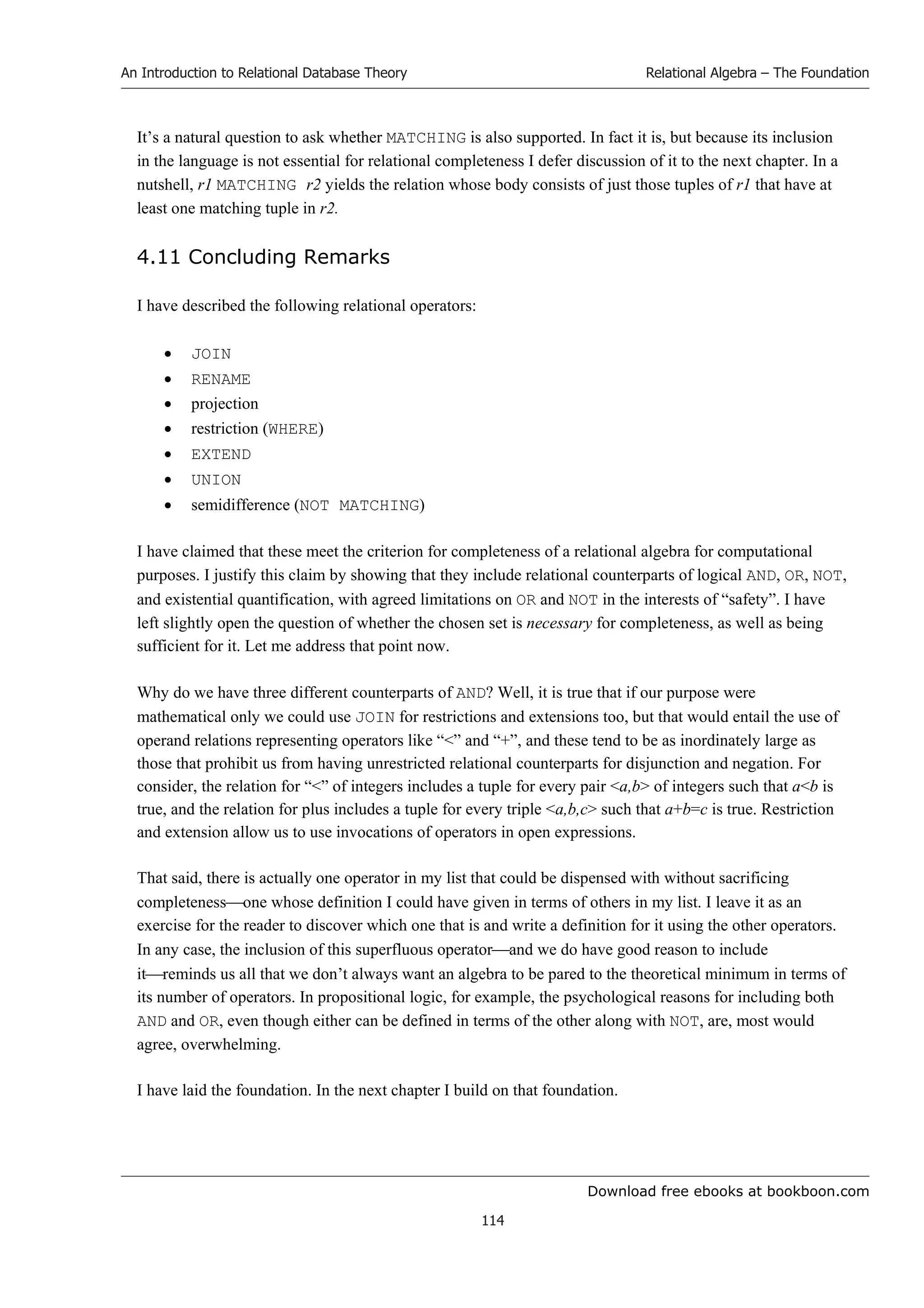


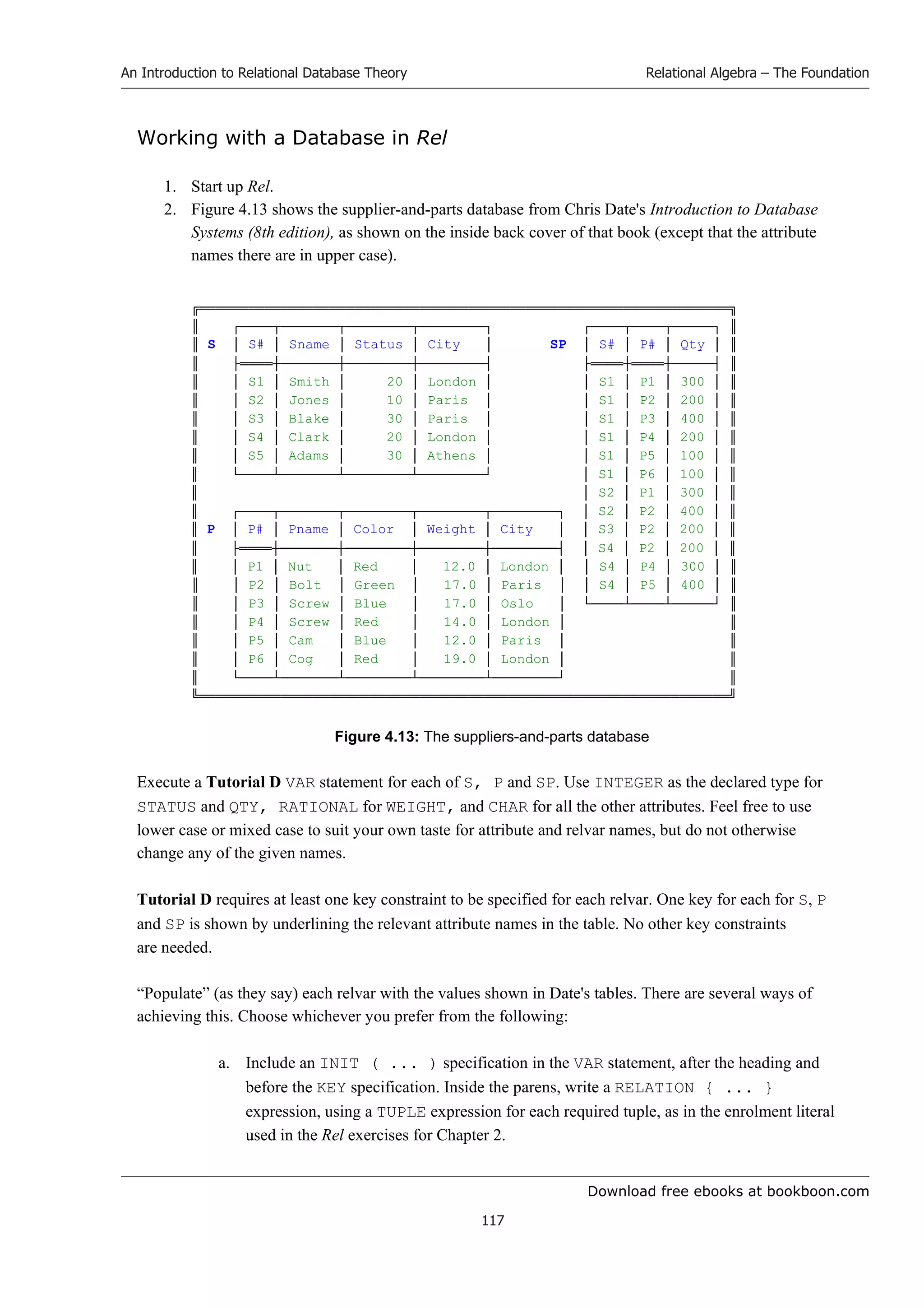



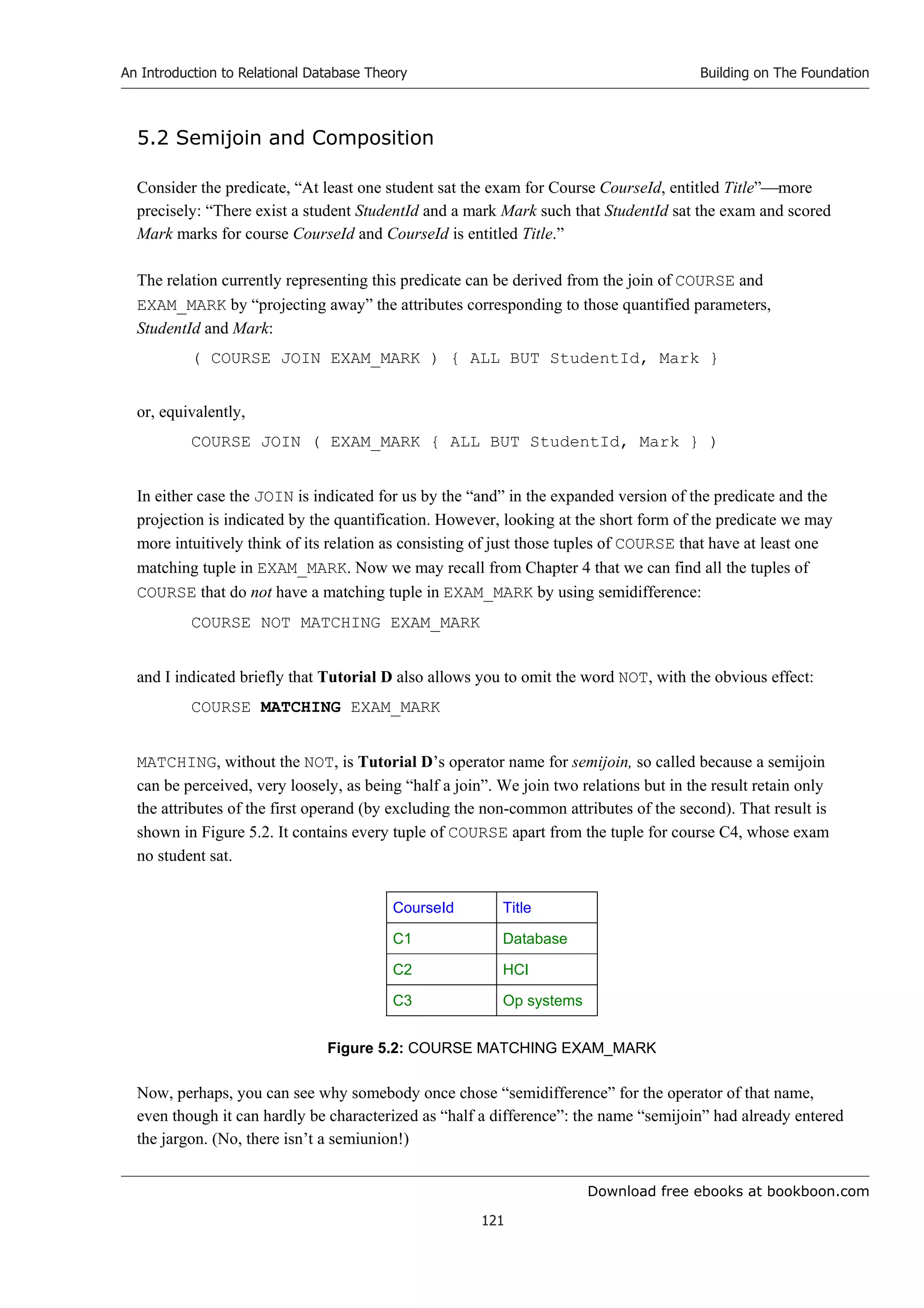

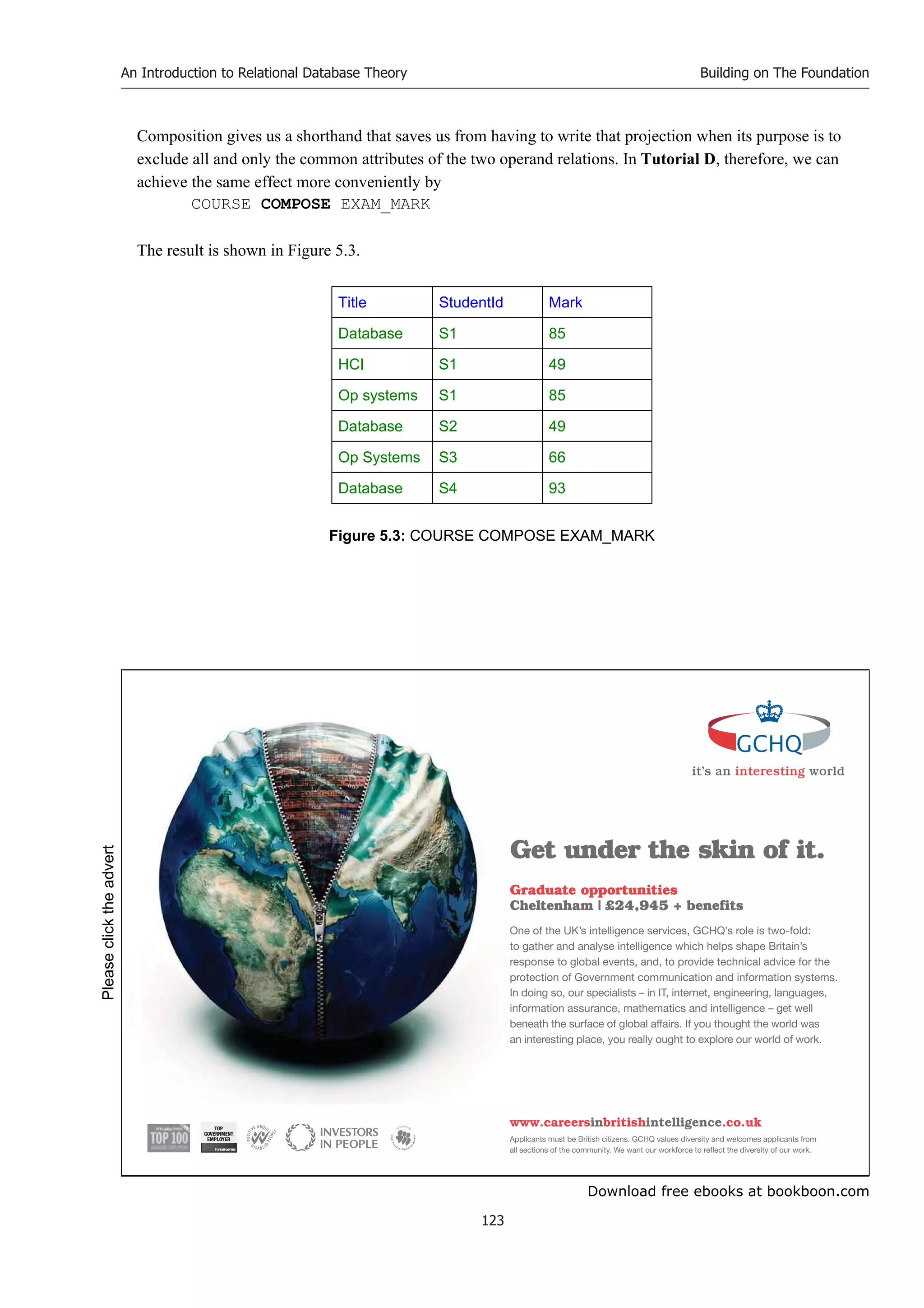
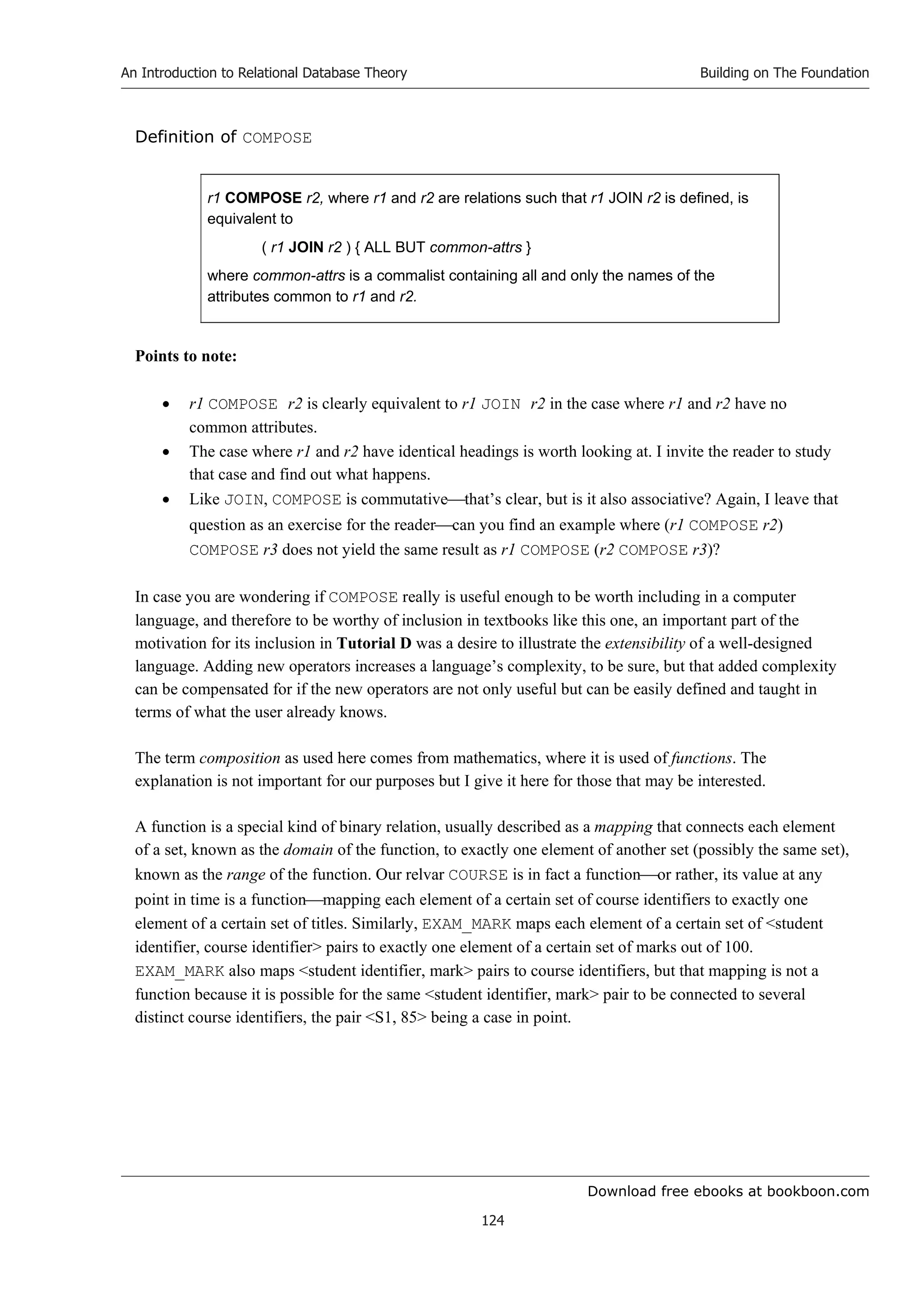
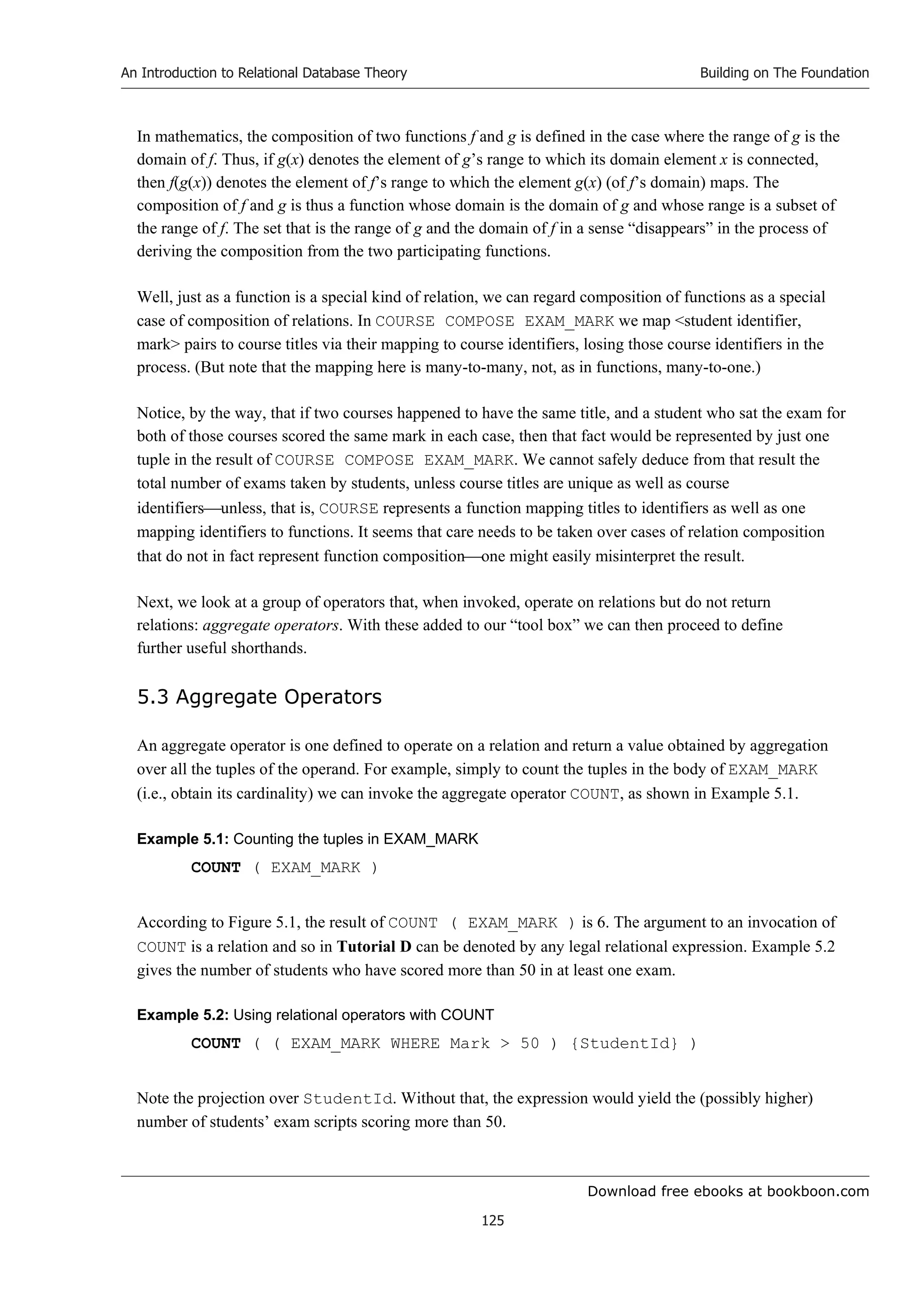
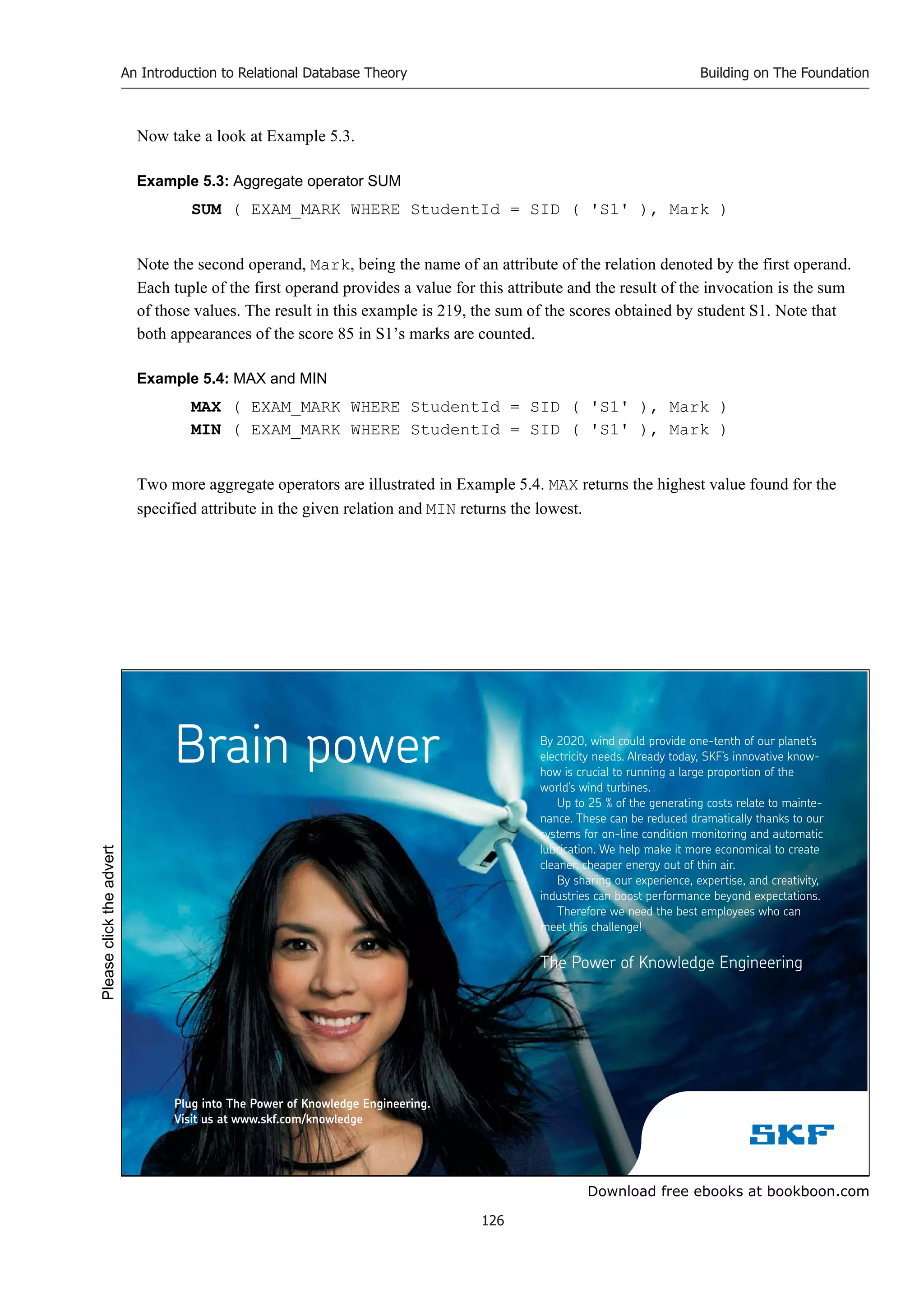

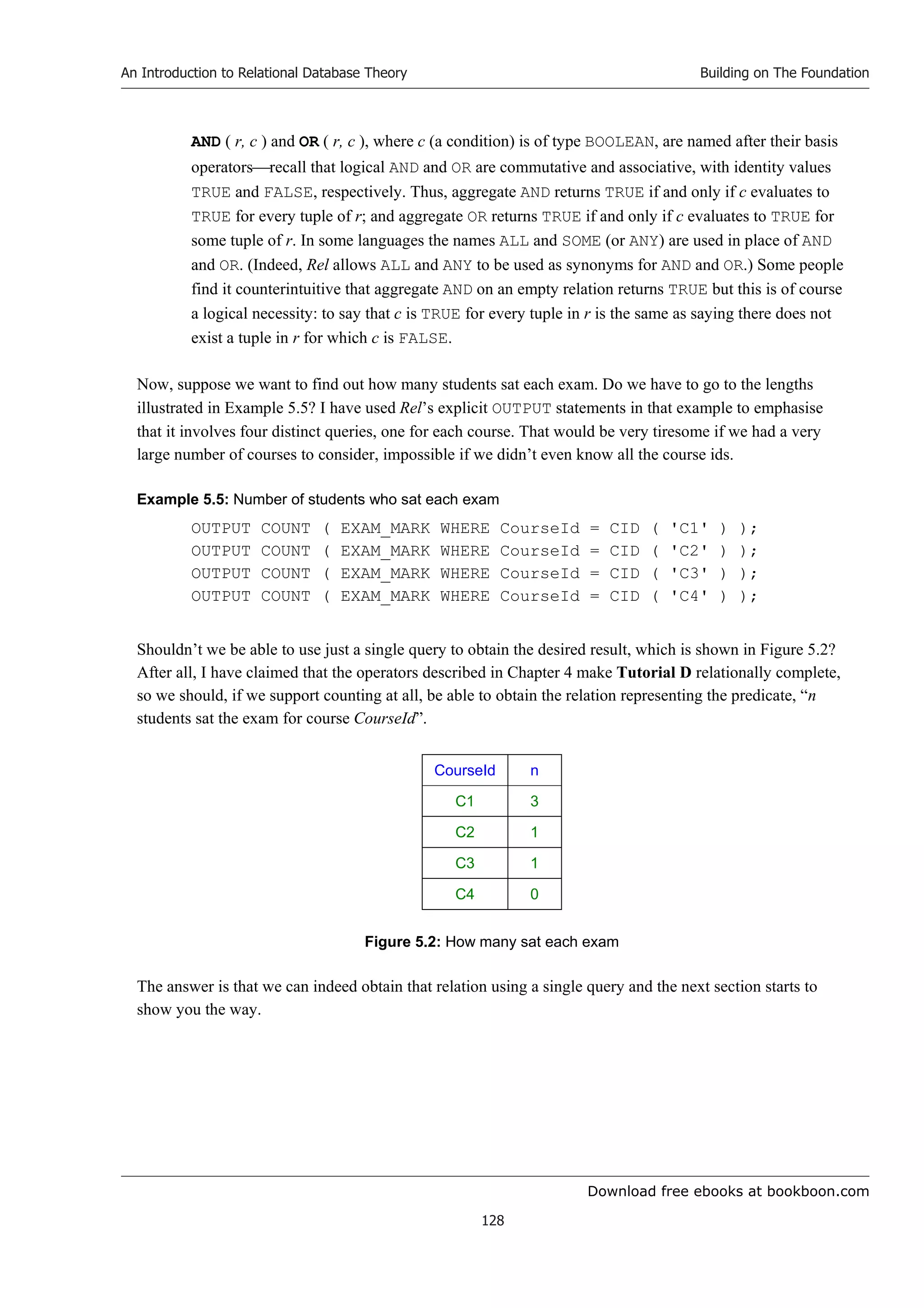
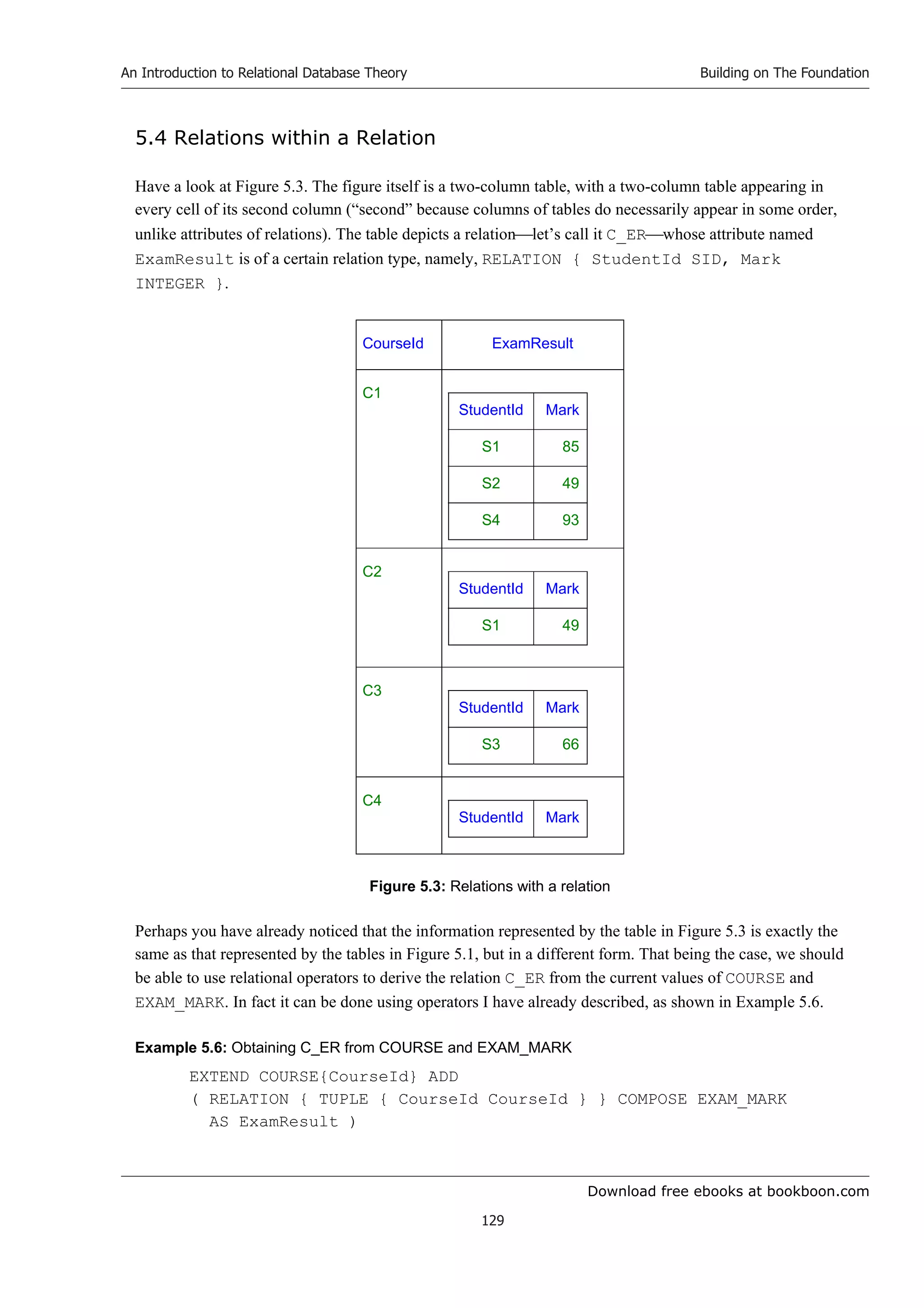
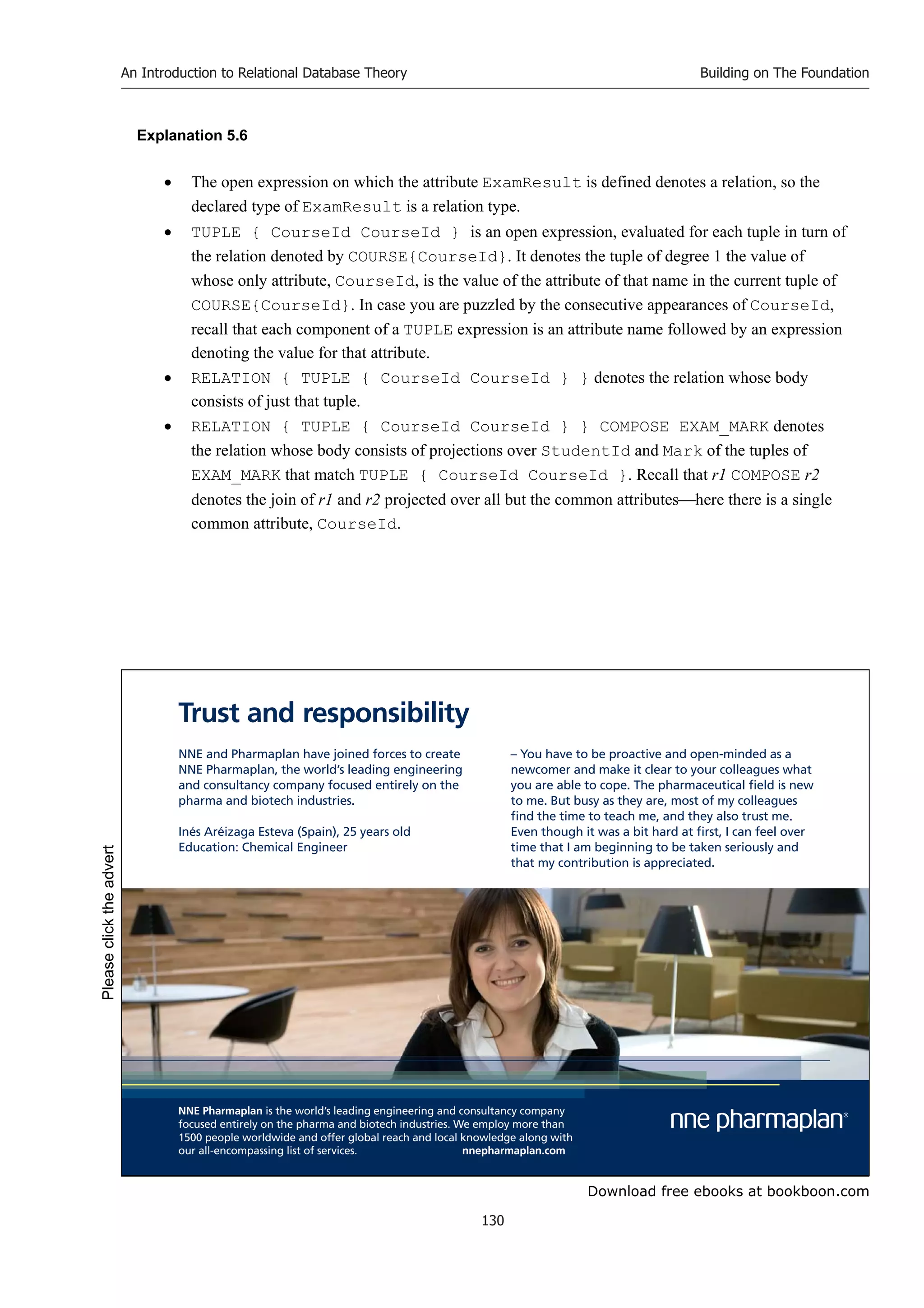
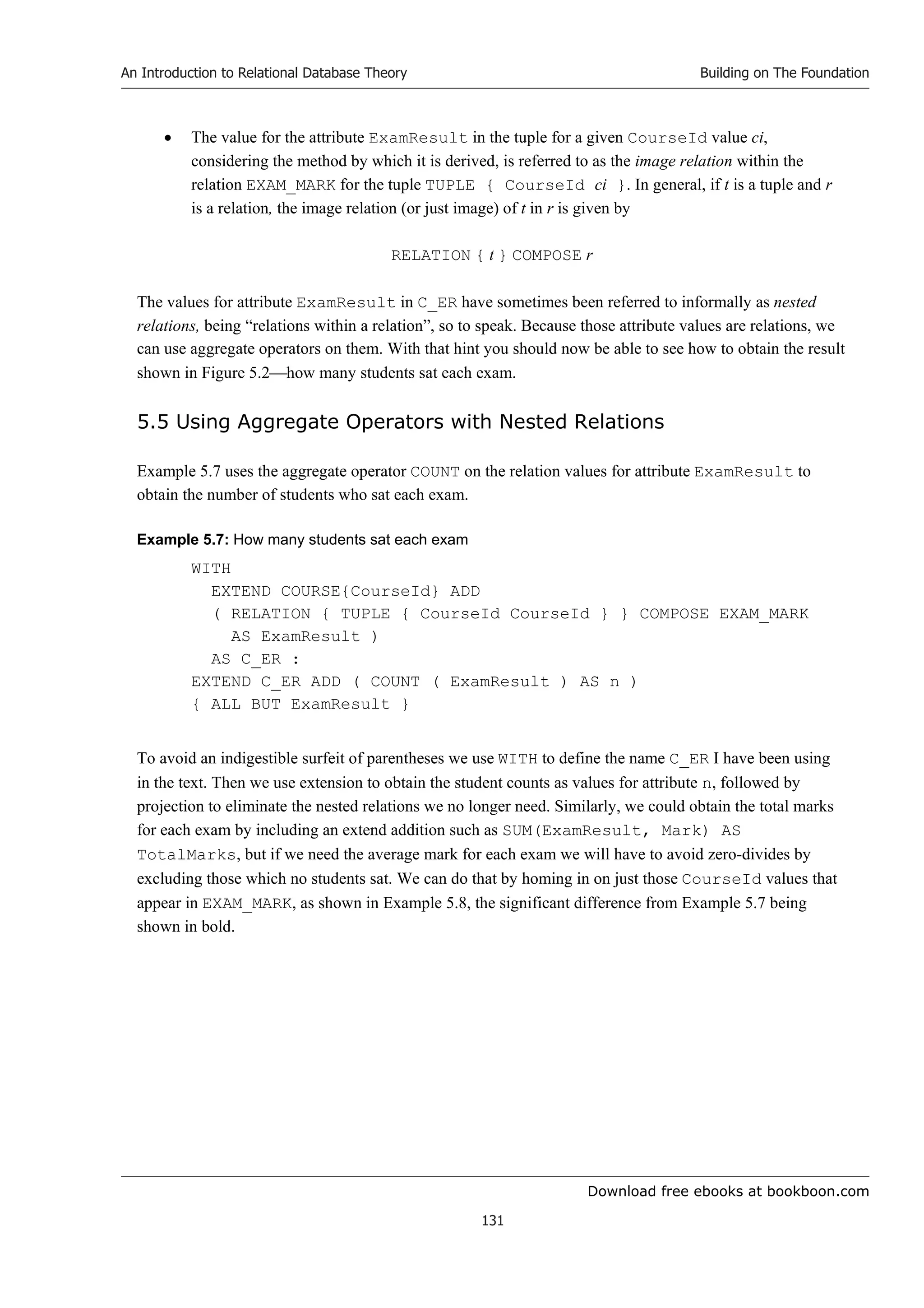
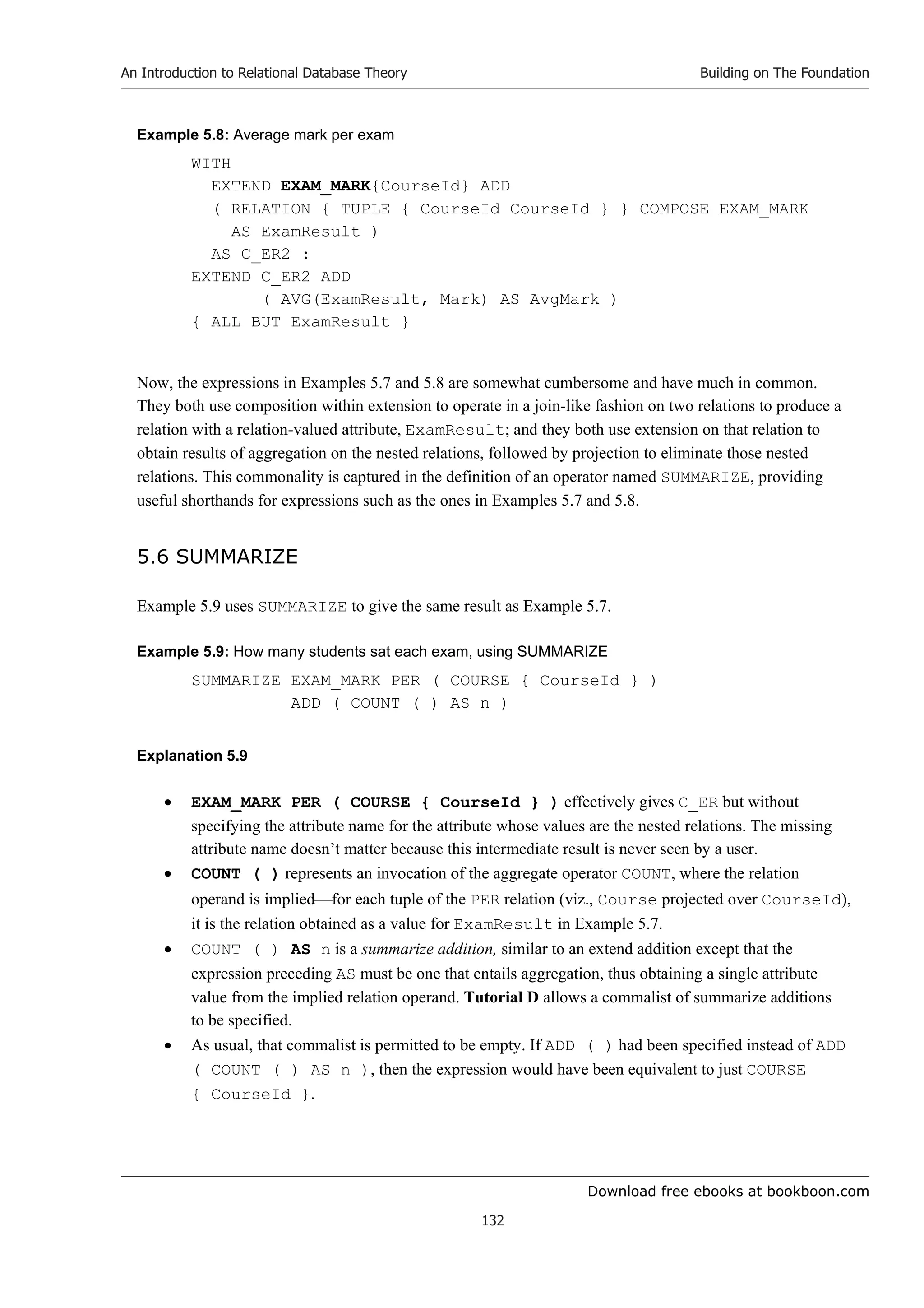
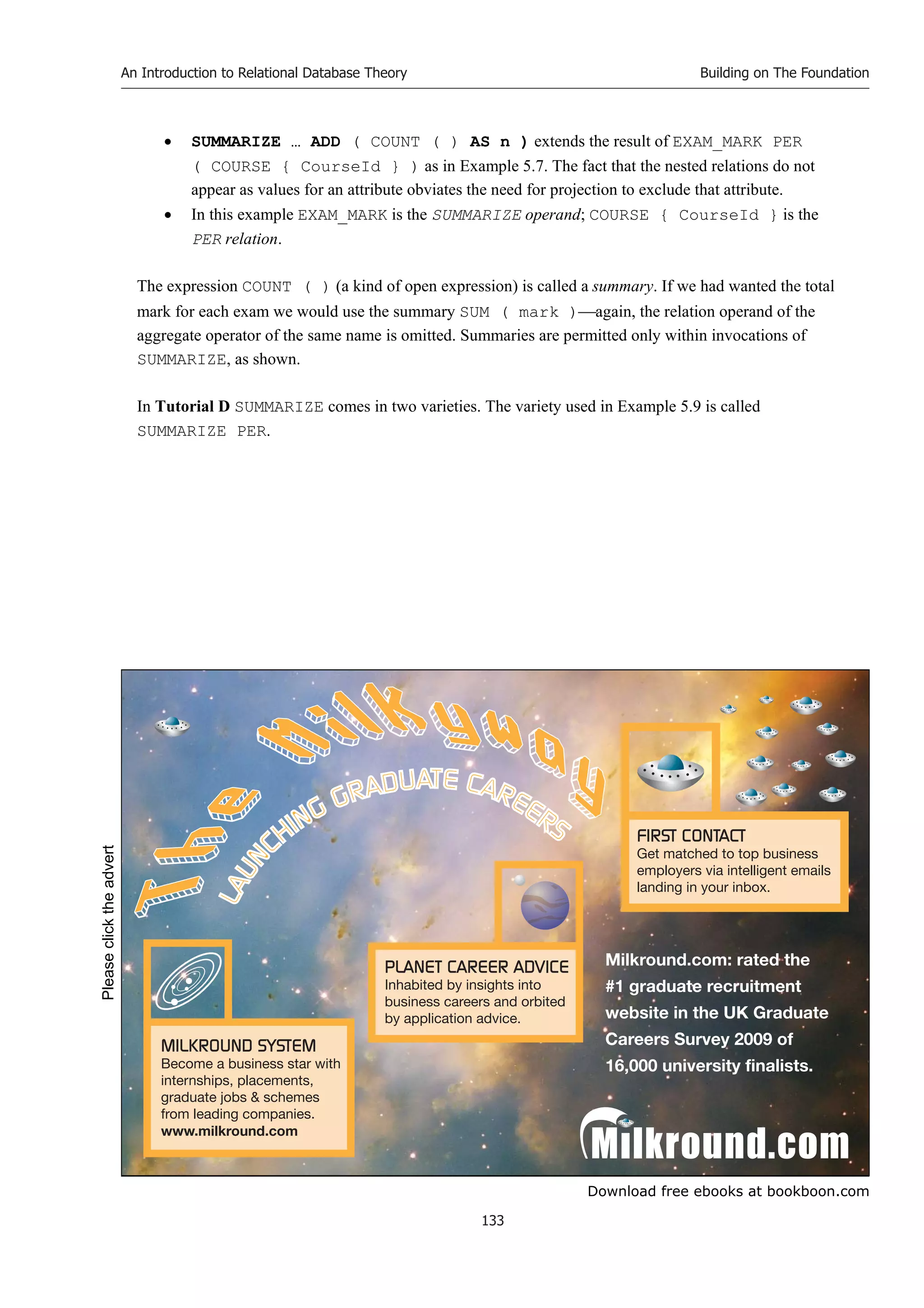
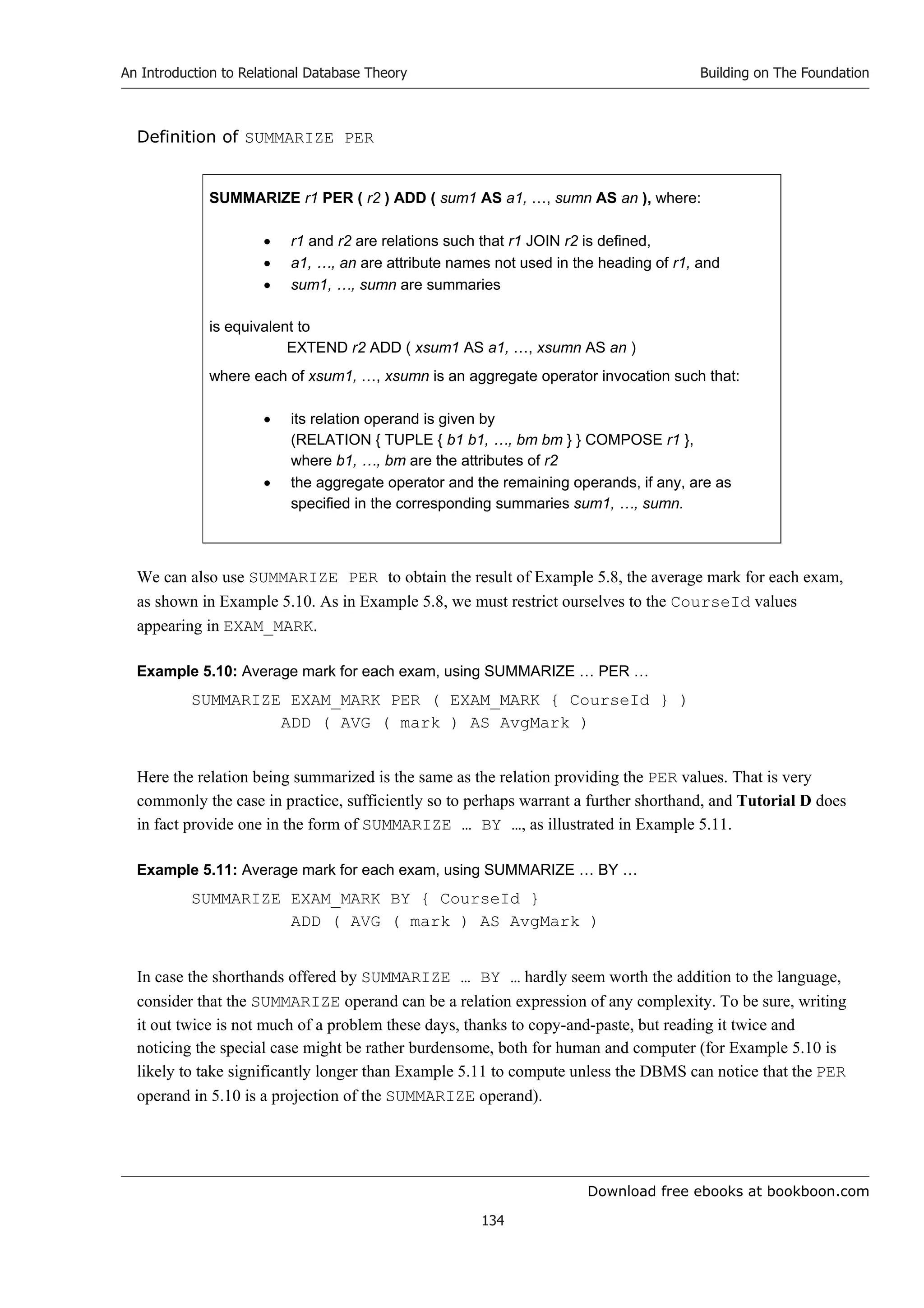
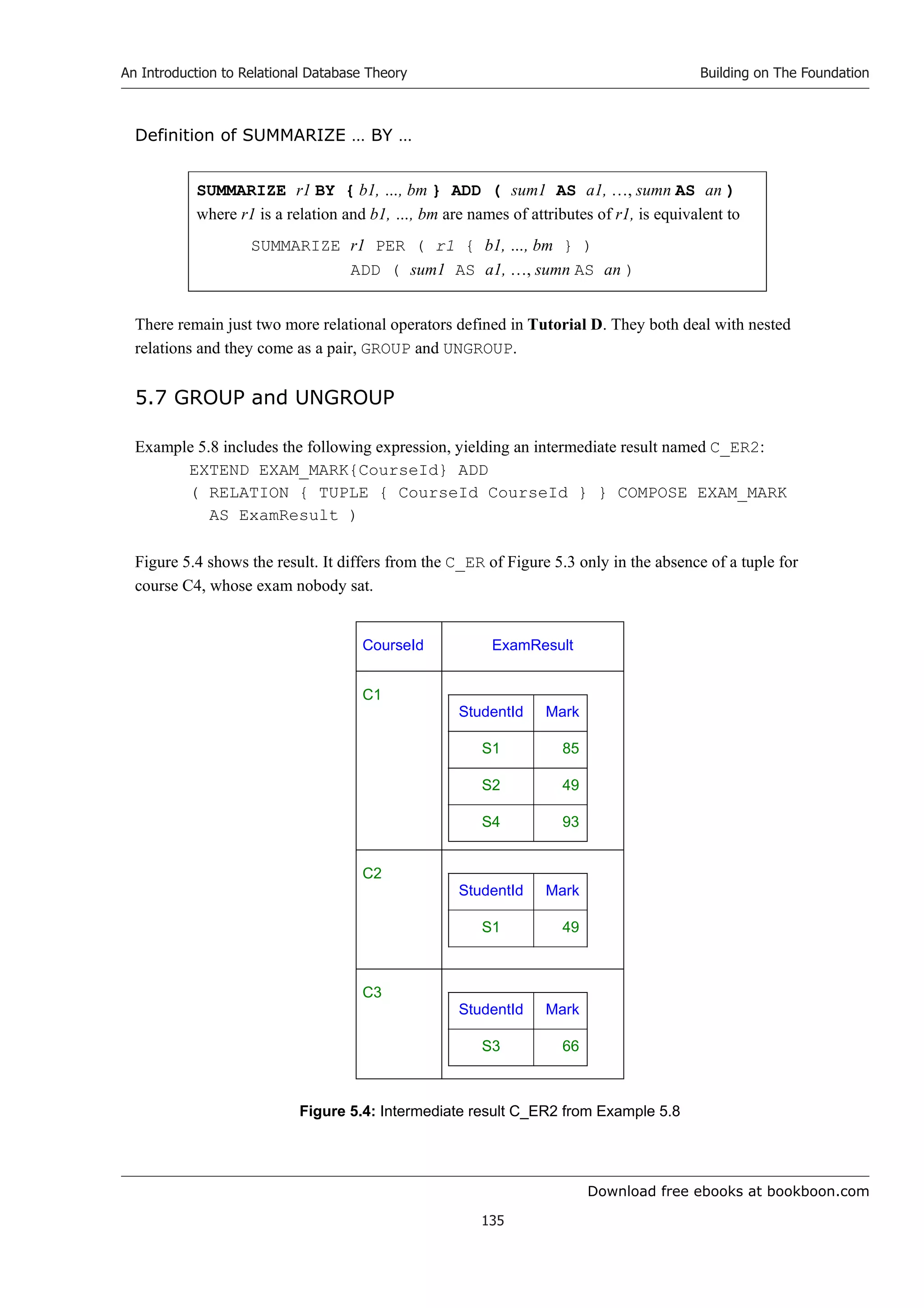

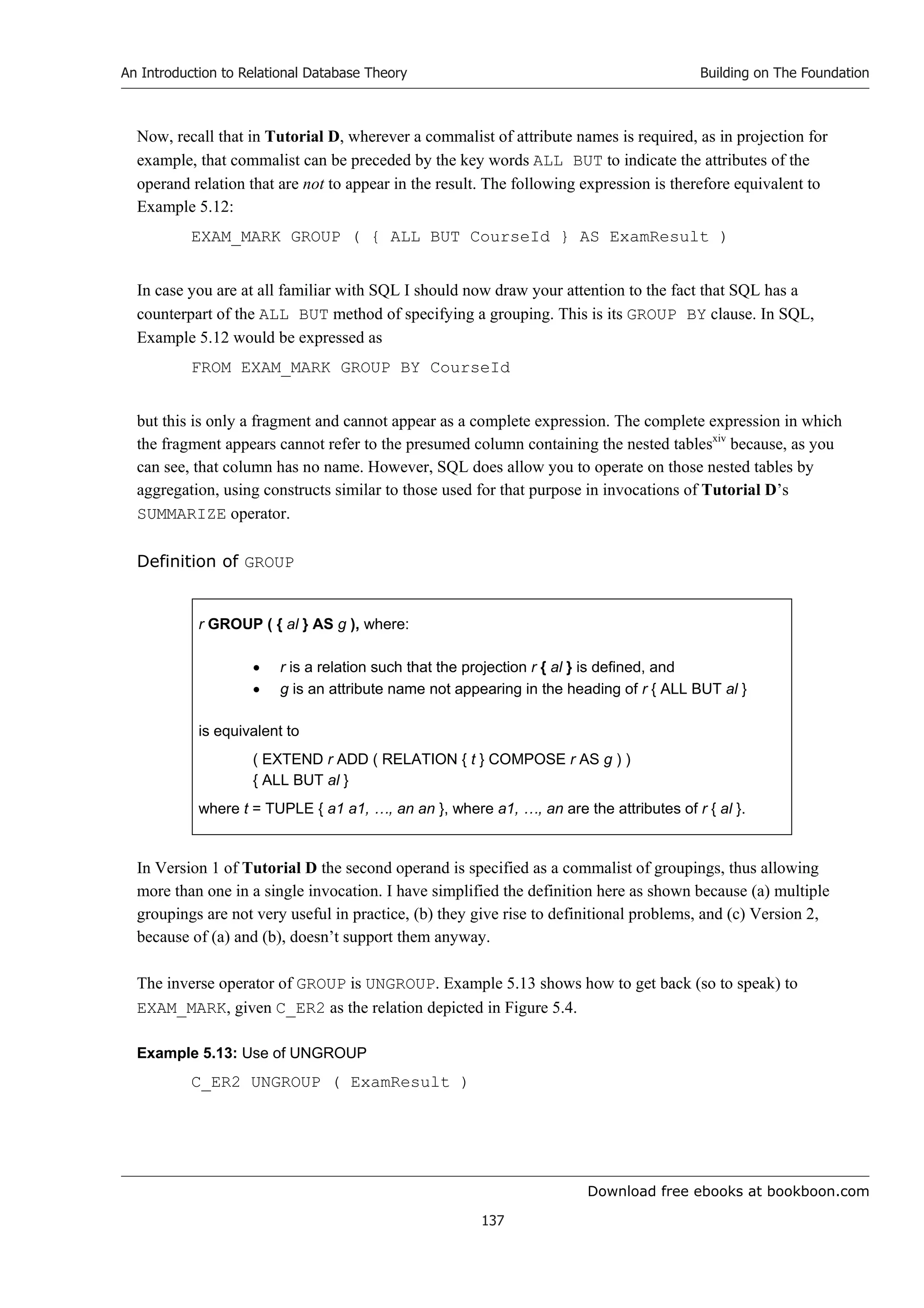

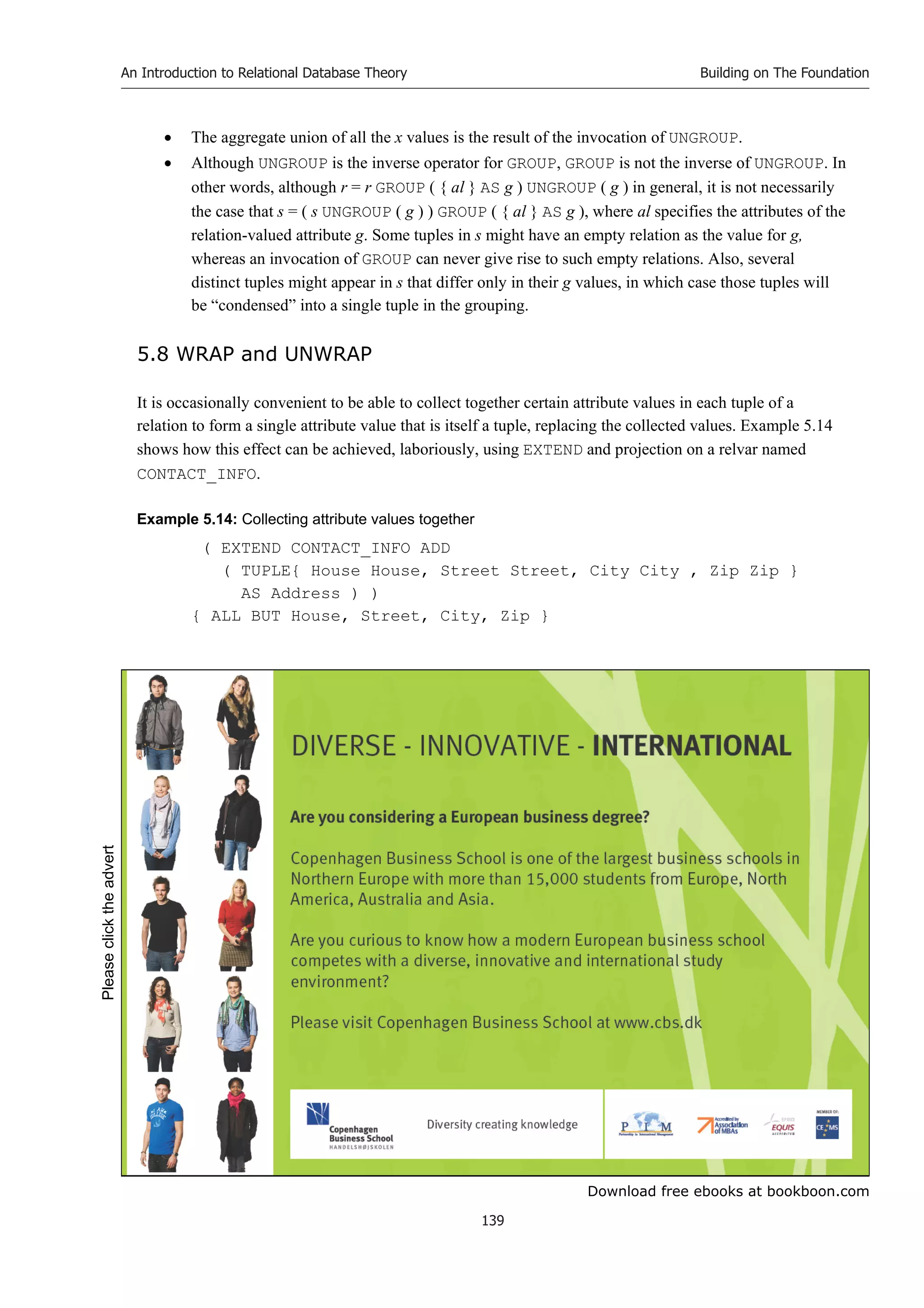
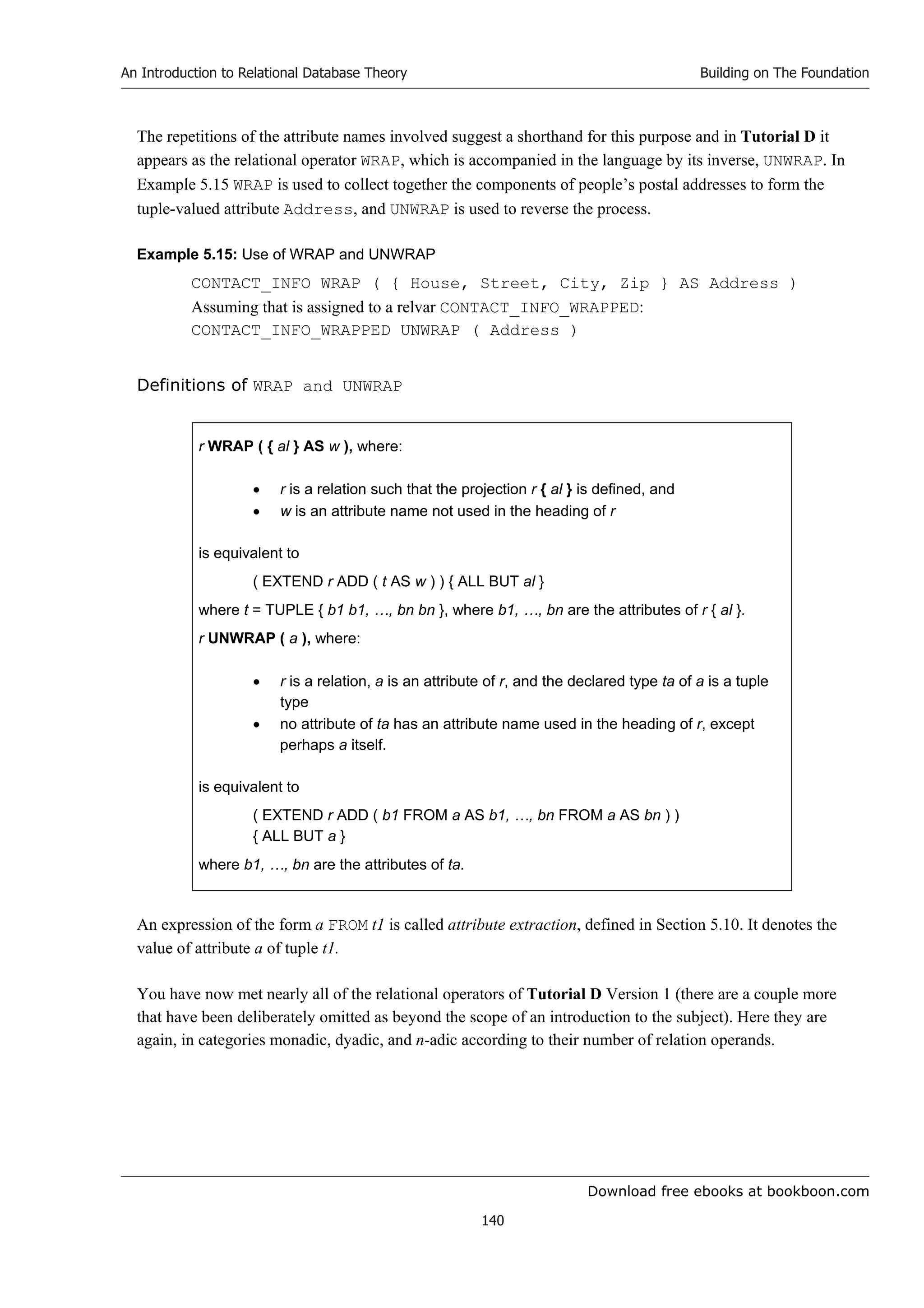
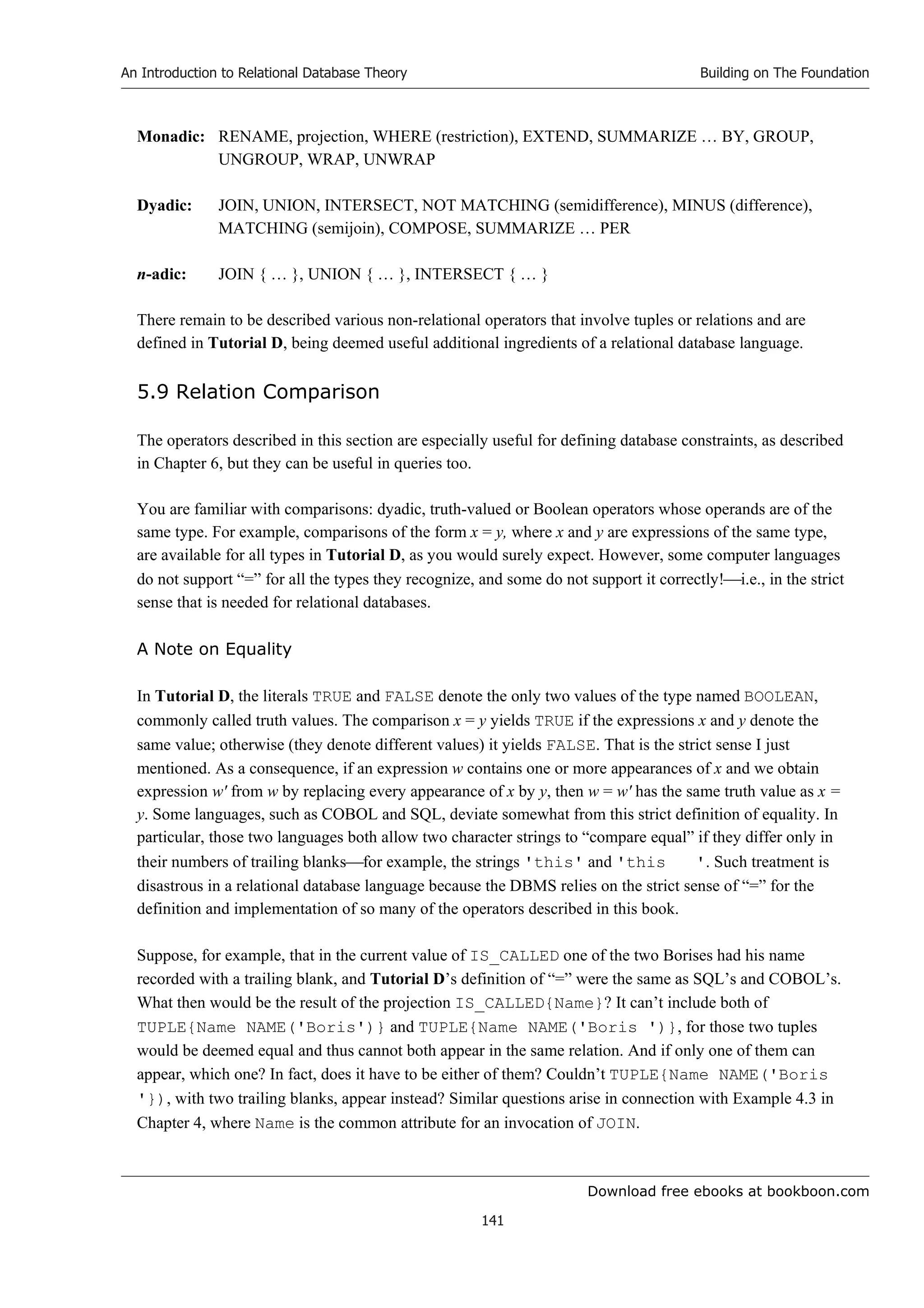
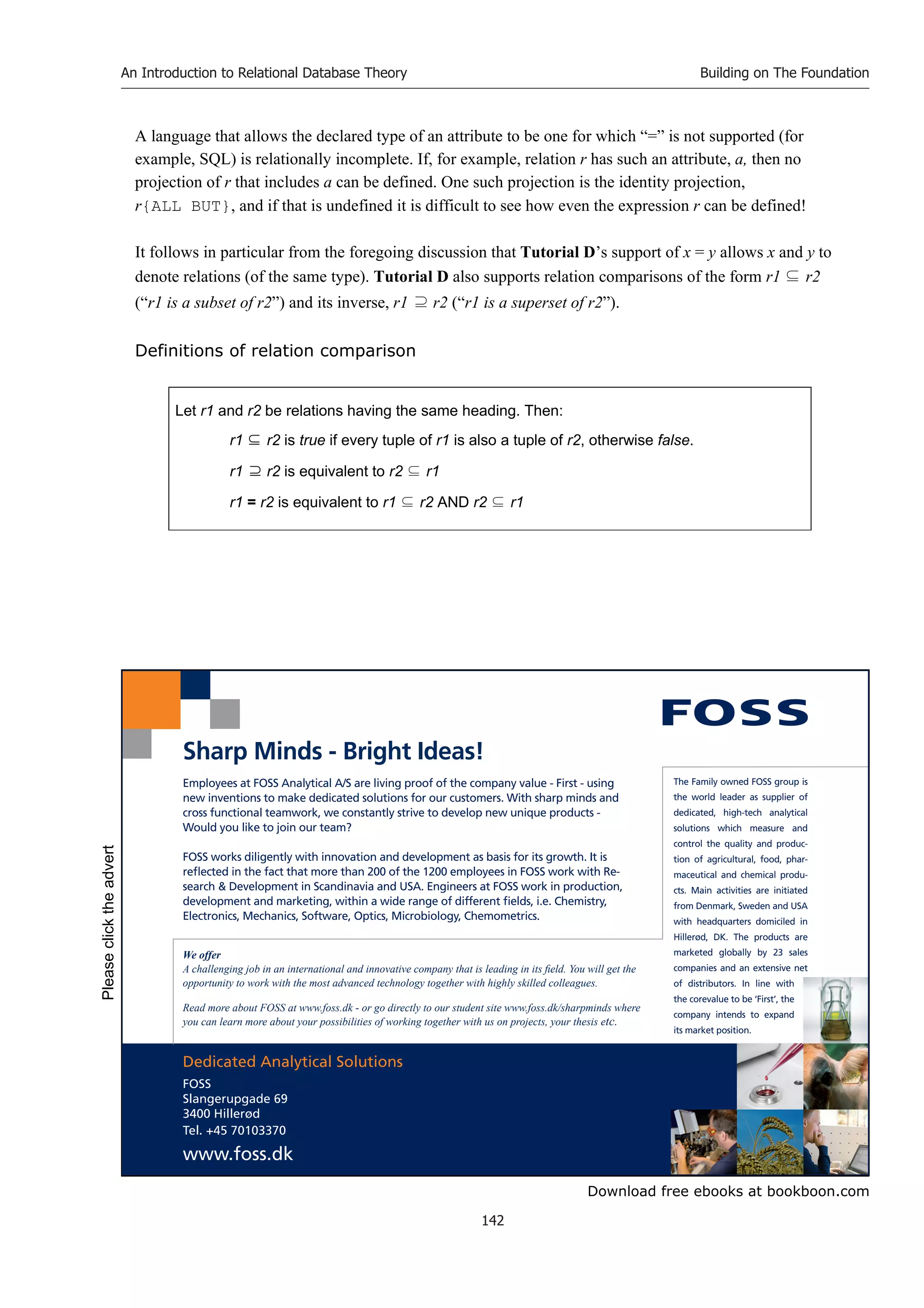
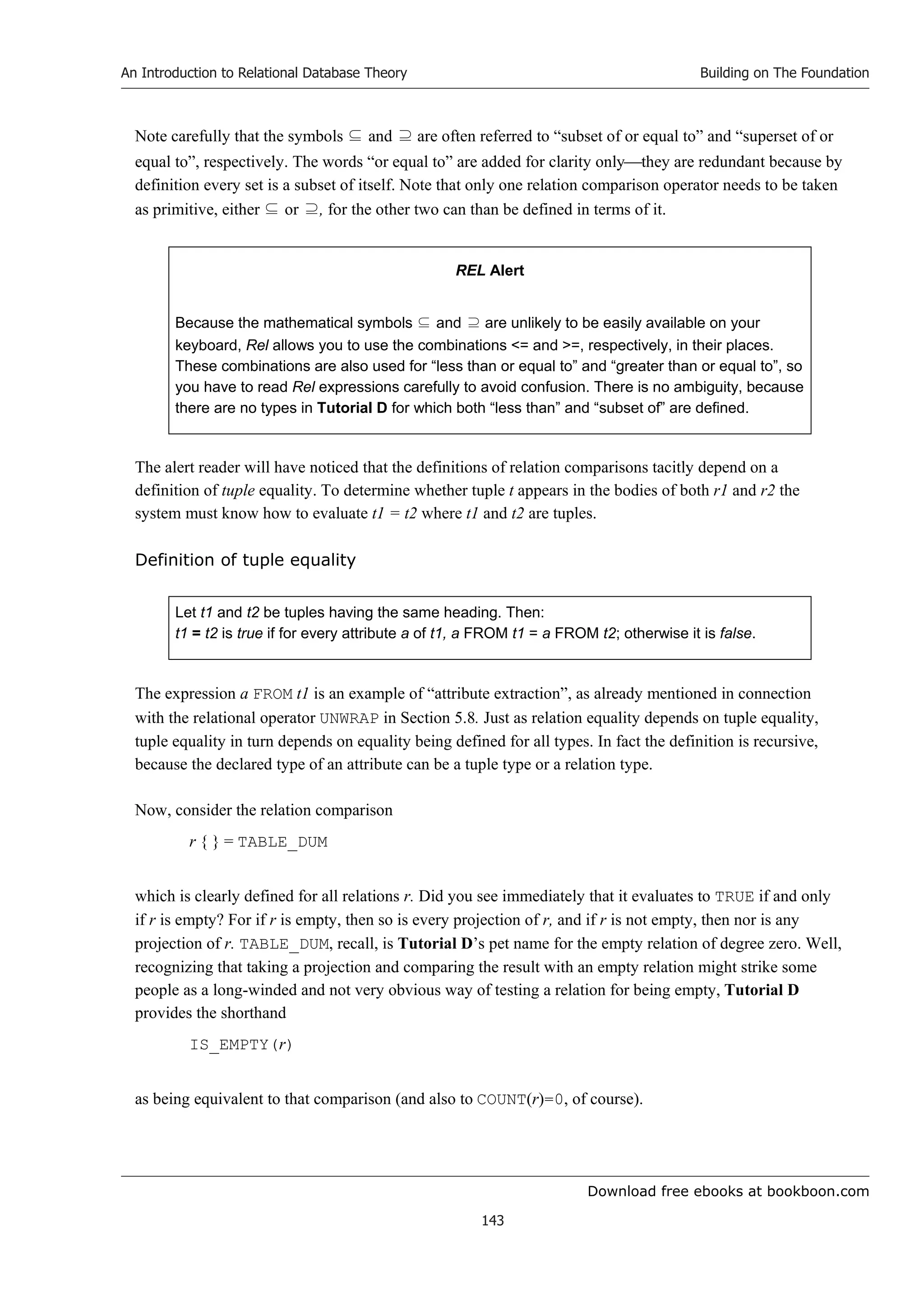
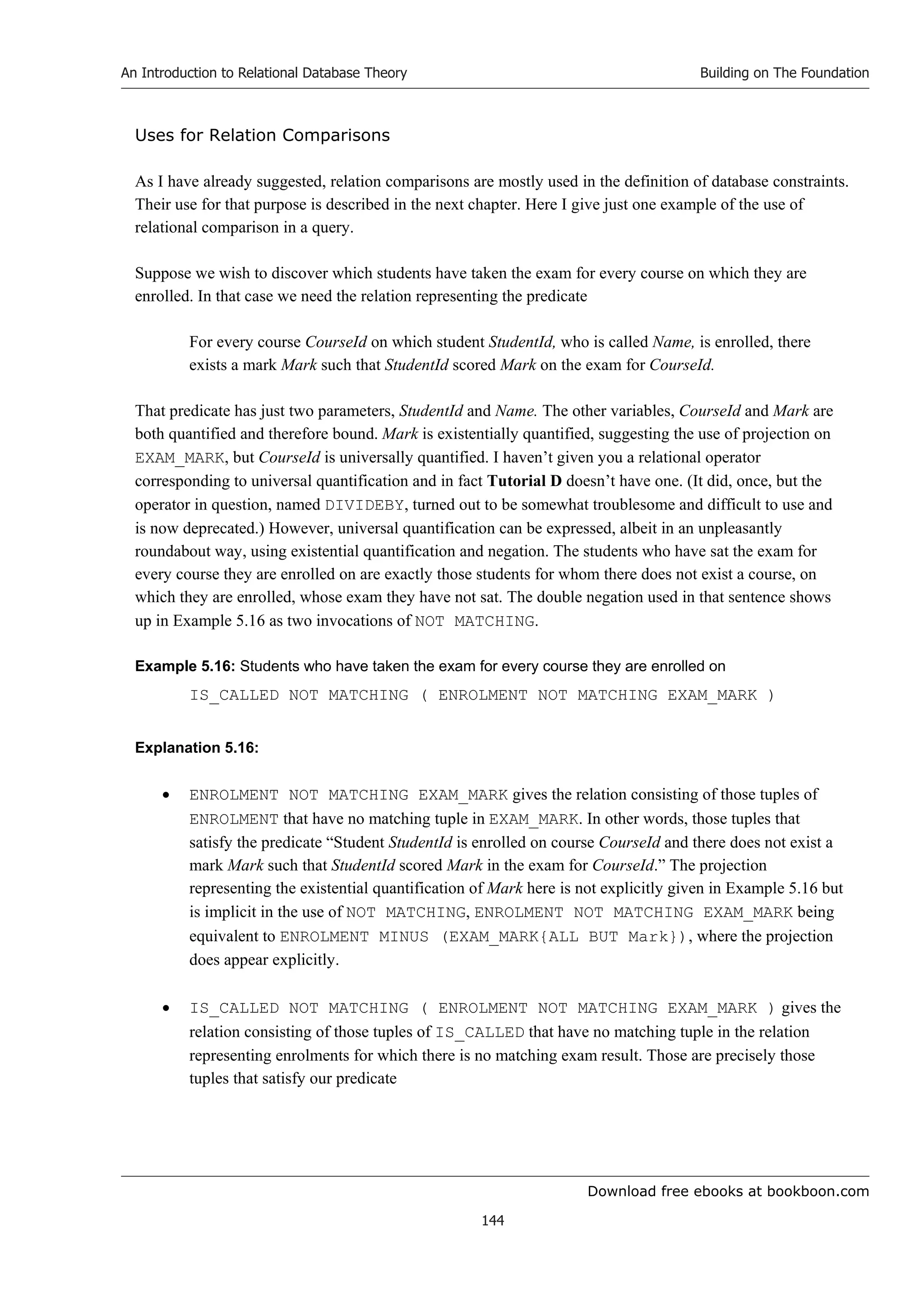
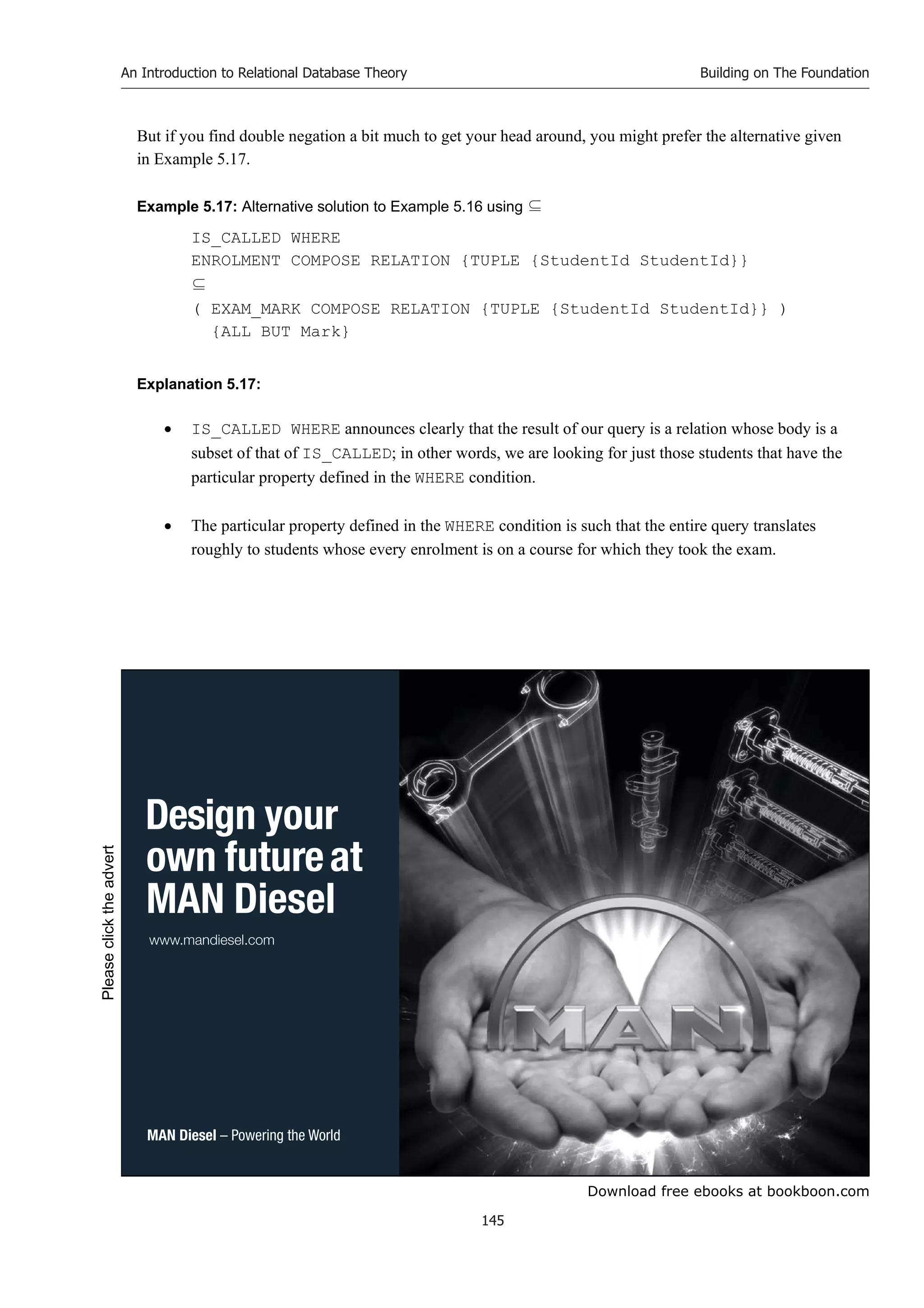
![Download free ebooks at bookboon.com
An Introduction to Relational Database Theory
146
Building on The Foundation
The relations being compared in the WHERE condition are the image relations of IS_CALLED
tuples in ENROLMENT and EXAM_MARK minus the Mark attribute. The commonality between the
somewhat cumbersome expressions denoting those image relations suggests that some shorthand
embracing that commonality would be both feasible and useful. The commonality is the
invocation of COMPOSE with a singleton relation consisting of a tuple derived from the relation
operand of WHERE. Under a suggestion from Chris Date in references [9] and [10] the fragment r
COMPOSE RELATION {TUPLE {StudentId StudentId}} is reduced to just ‼r (where
‼ is the double exclamation mark, sometimes pronounced “bang bang”), like this:
IS_CALLED WHERE ‼ENROLMENT ⊆ ‼(EXAM_MARK{ALL BUT Mark})
5.10 Other Operators on Relations and Tuples
We close this chapter with brief descriptions of other operators defined in Tutorial D that operate on
relations or tuples.
Tuple Membership Test
Let r be a relation and let t be a tuple of the same heading as r. Then
t ∈ r
is defined to yield TRUE if the body of r contains tuple t, otherwise FALSE.
REL Alert
Because the mathematical symbol ∈ is unlikely to be easily available on your keyboard, Rel
allows you to use the key word IN in its place.
Tuple Extraction
Let r be a relation of cardinality one (a “singleton relation”). Then
TUPLE FROM r
is defined to yield the single tuple contained in the body of r. For example,
TUPLE FROM COURSE WHERE CourseId = CID('C1')
yielding TUPLE { CourseId CID('C1'), Title 'Database' }.
Attribute Value Extraction (previously mentioned in Section 5.8)
Let t be a tuple with an attribute named a. Then
a FROM t](https://image.slidesharecdn.com/an-introduction-to-relational-database-theory-230210032734-035be350/75/an-introduction-to-relational-database-theory-pdf-146-2048.jpg)
![Download free ebooks at bookboon.com
An Introduction to Relational Database Theory
147
Building on The Foundation
is defined to yield the value of the attribute a in tuple t. For example,
Title FROM TUPLE FROM COURSE WHERE CourseId = CID('C1')
yielding the CHAR value 'Database'.
Tuple Counterparts of Relational Operators
Let t1 and t2 be tuples. Then the following are defined, with obvious semantics in each case and in each
case yielding a tuple:
tuple rename:
t1 RENAME ( a1 AS b1, …, an AS bn )
tuple projection:
t1 { [ALL BUT] a1, … an }
tuple extension:
EXTEND t1 ADD (exp1 AS a1, …, expn AS an )
tuple join (dyadic and n-adic):
t1 JOIN t2
JOIN { t1, t2, … }
tuple compose:
t1 COMPOSE t2](https://image.slidesharecdn.com/an-introduction-to-relational-database-theory-230210032734-035be350/75/an-introduction-to-relational-database-theory-pdf-147-2048.jpg)
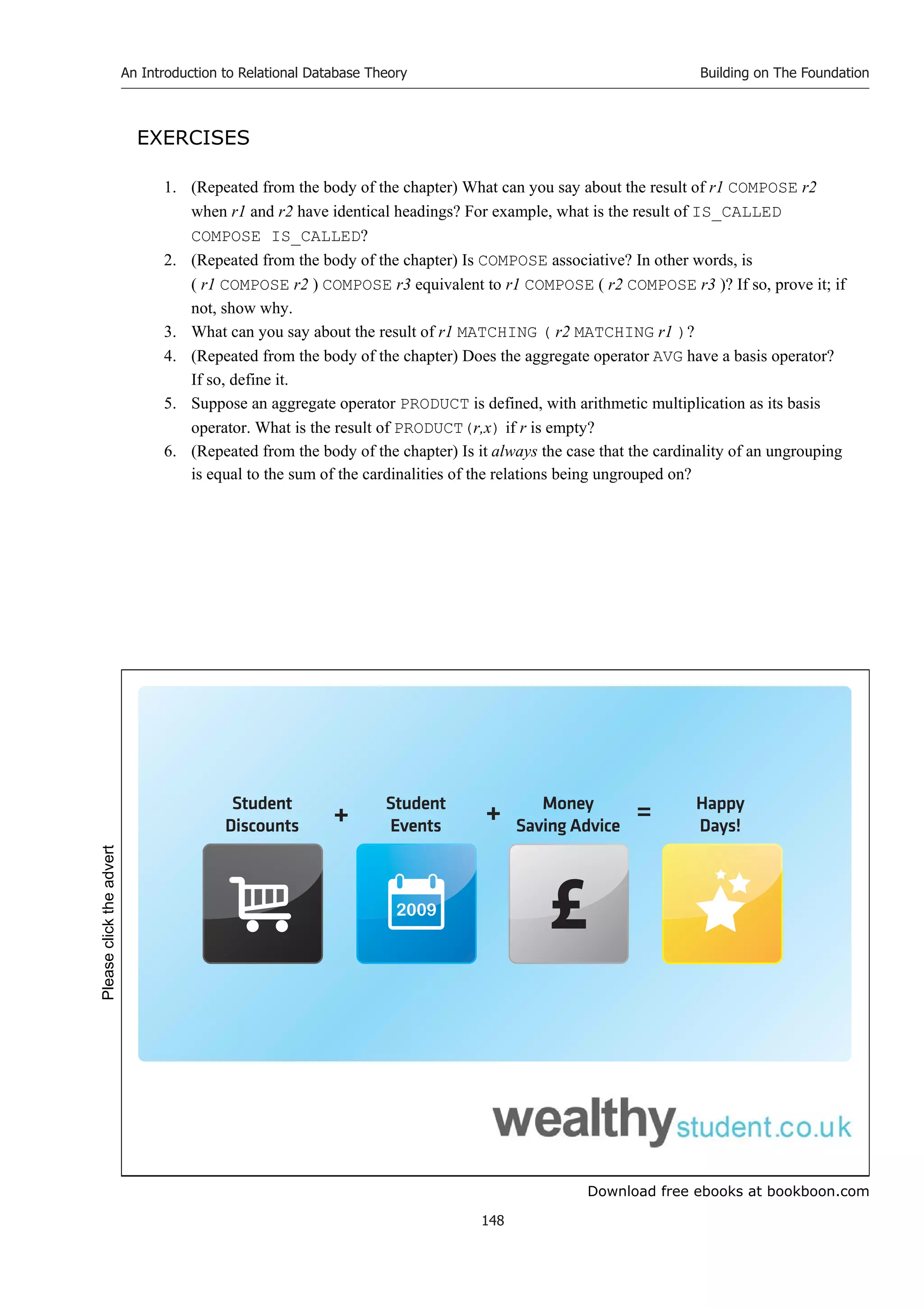
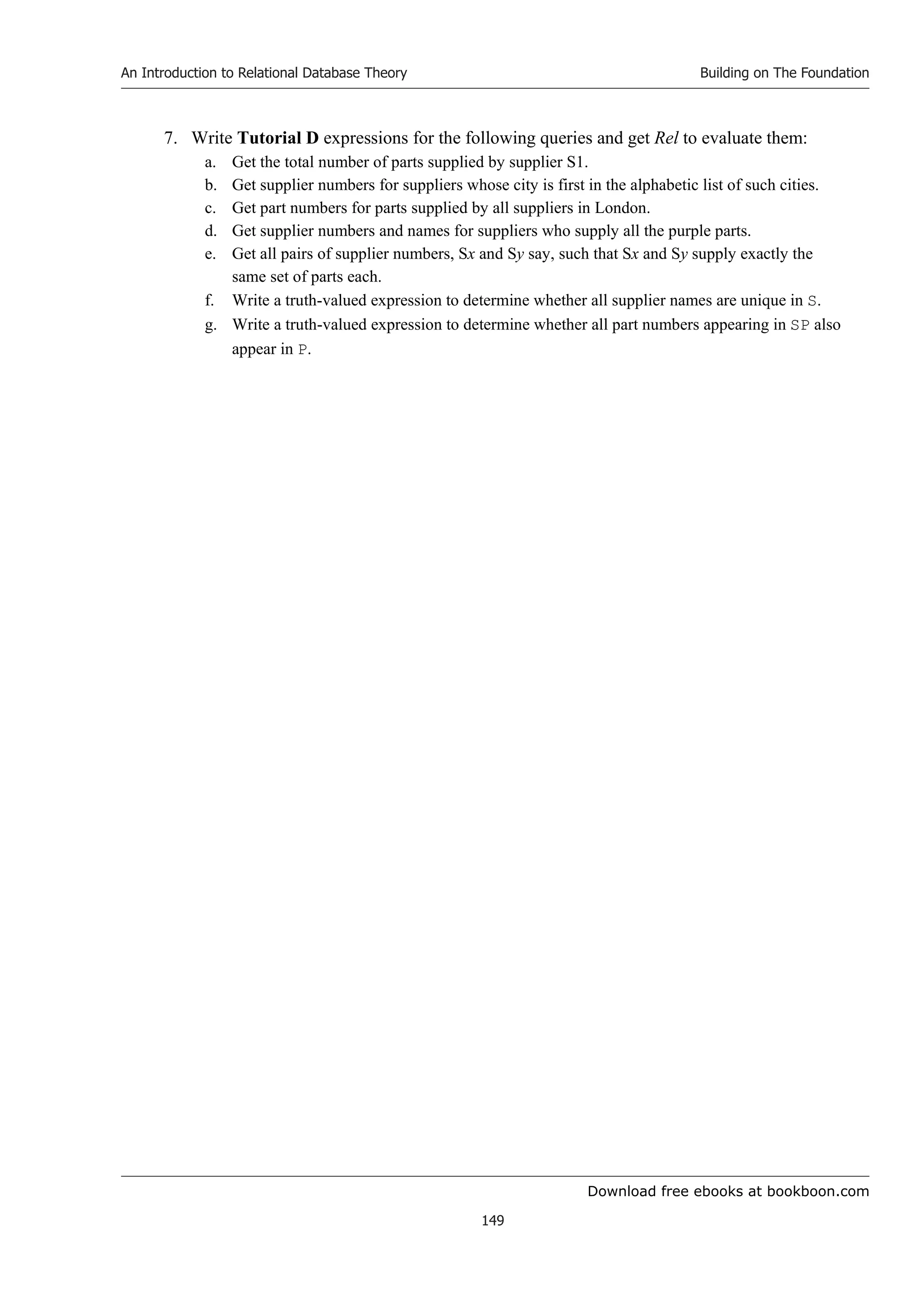
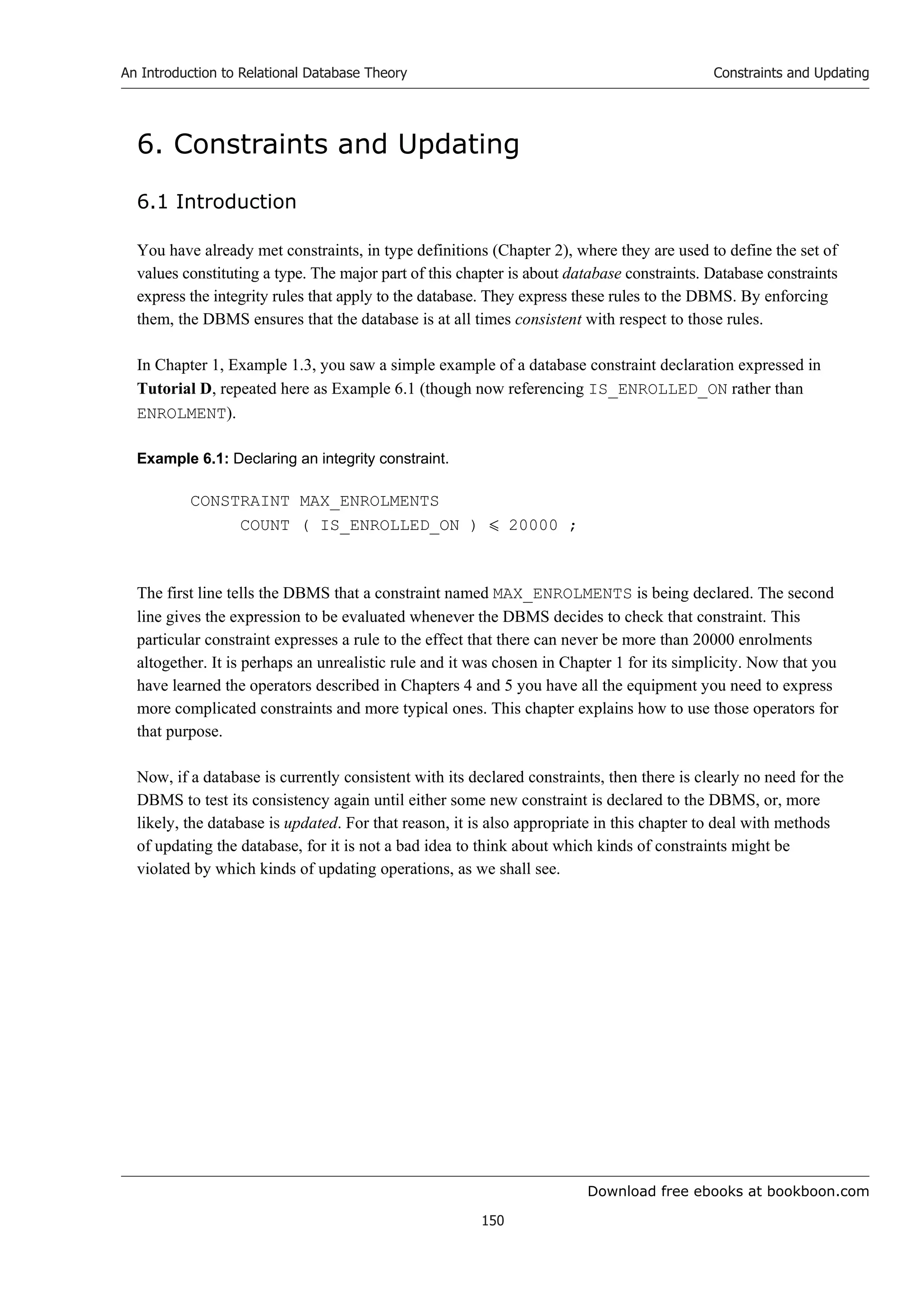
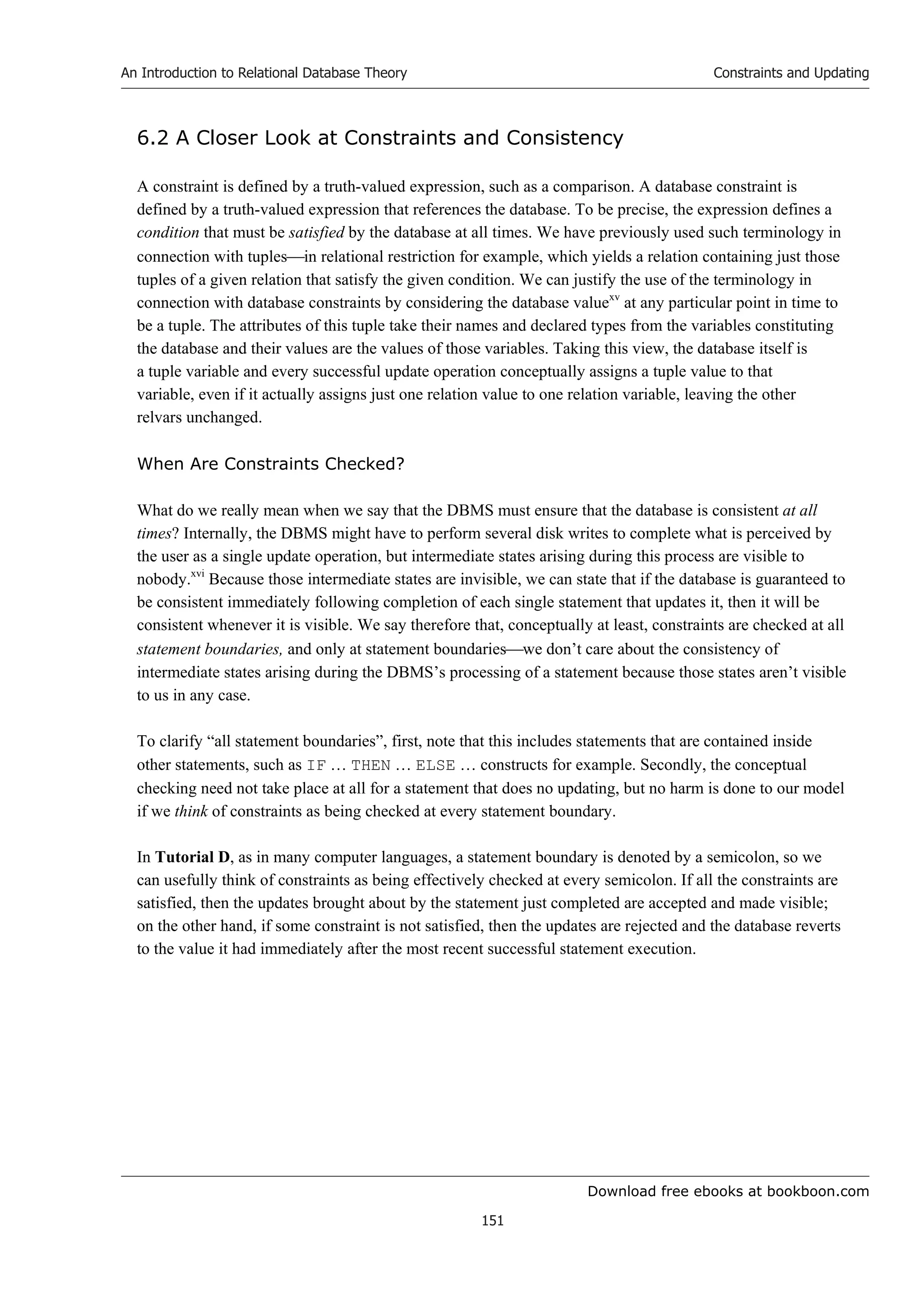
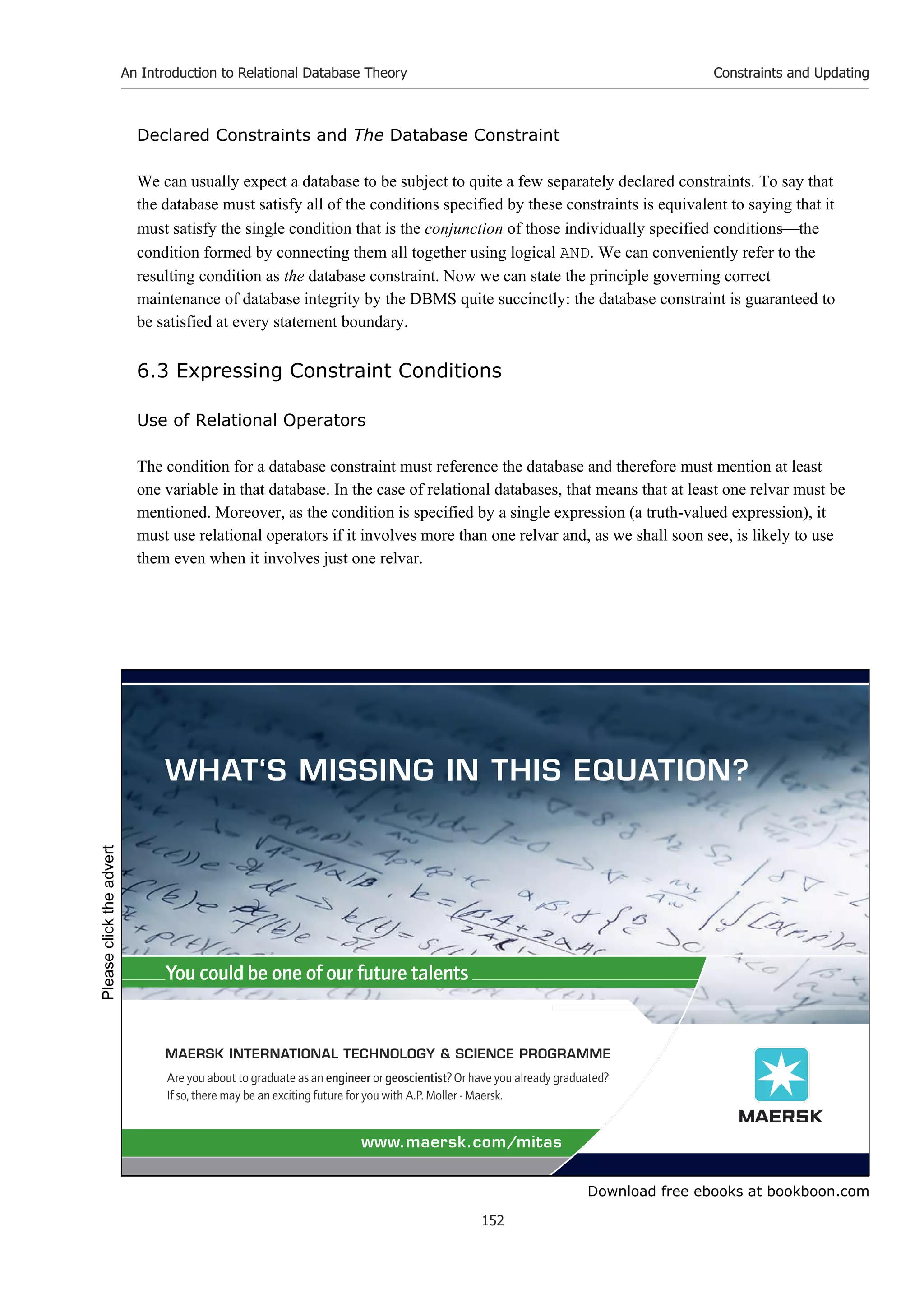
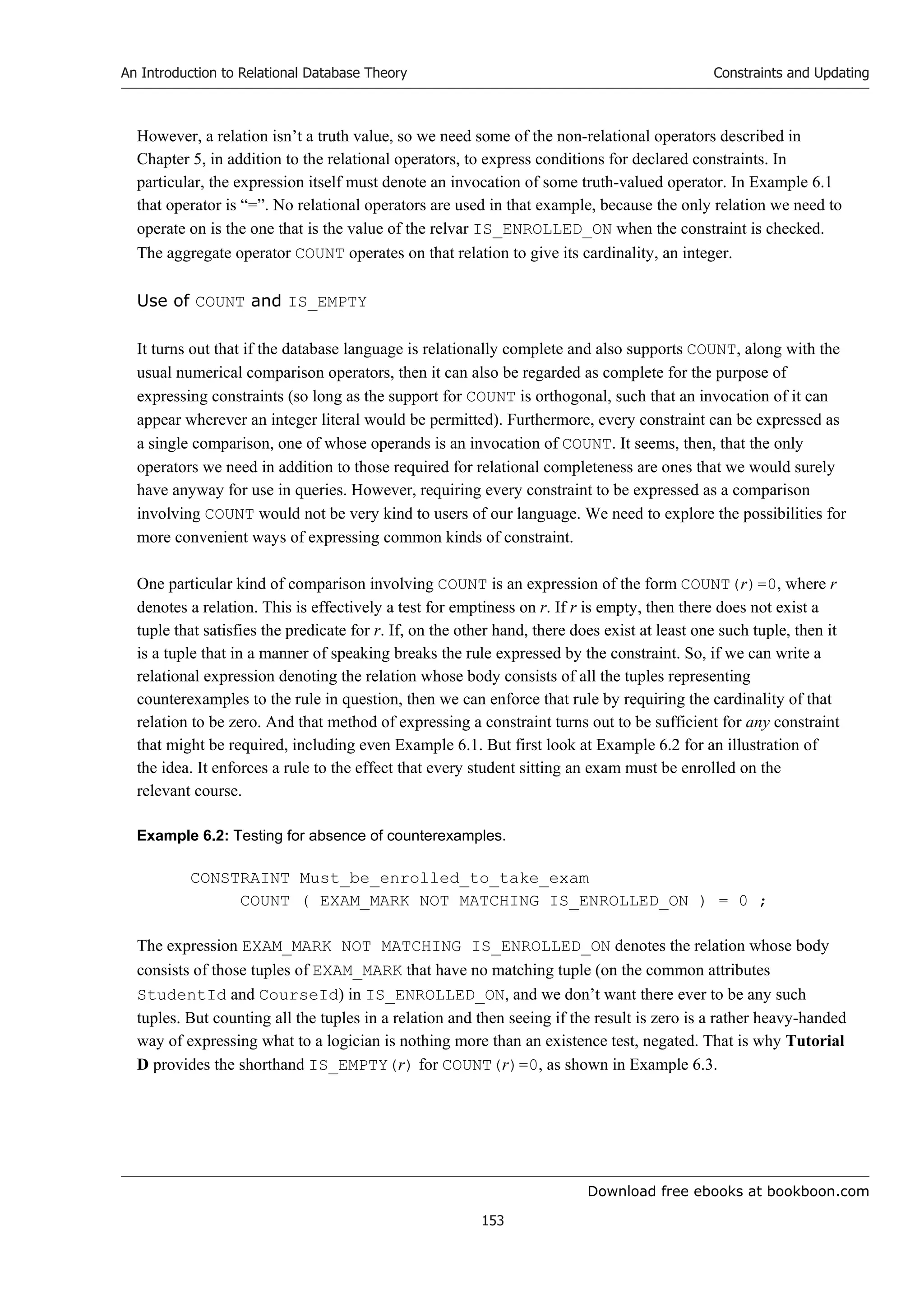
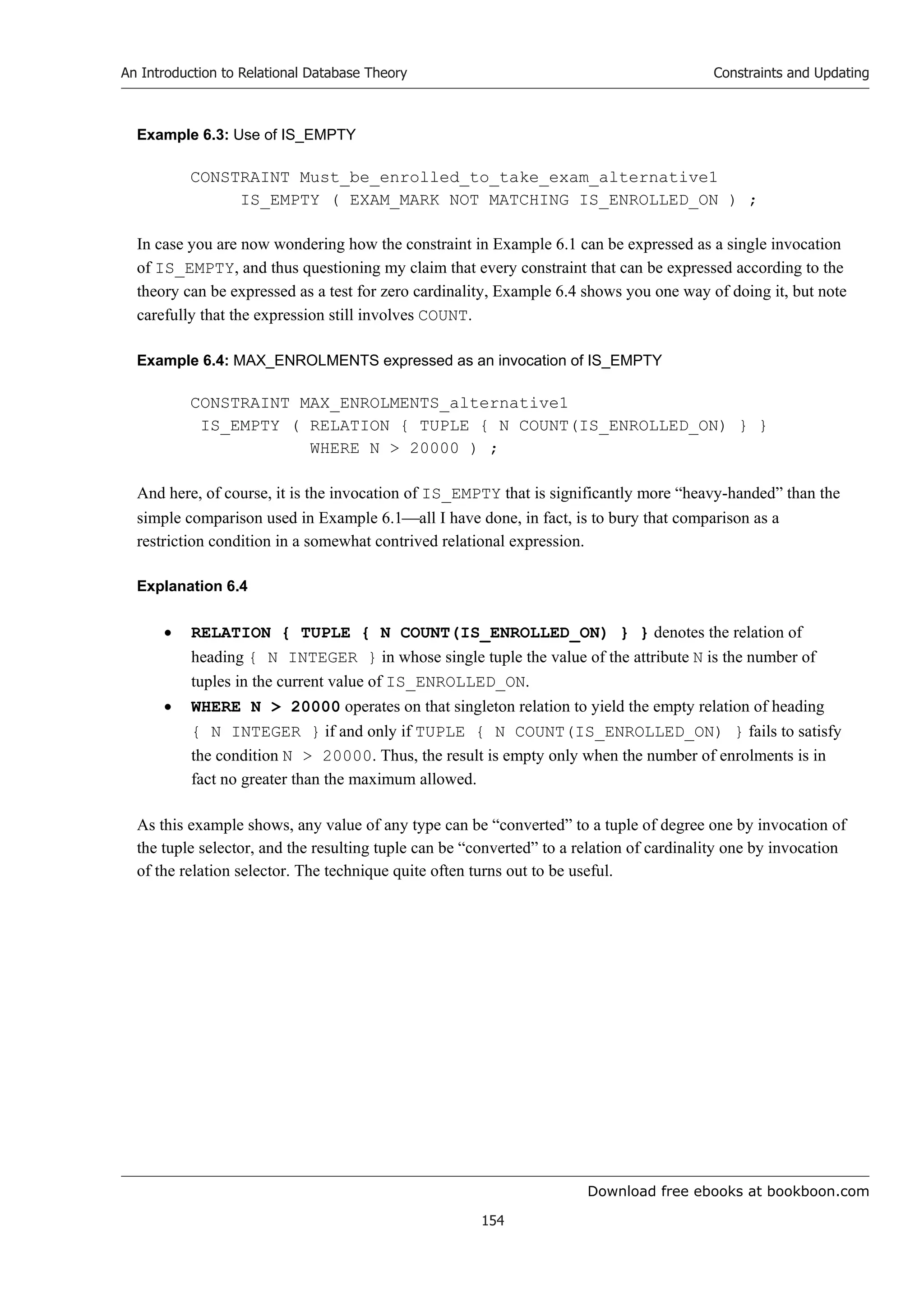
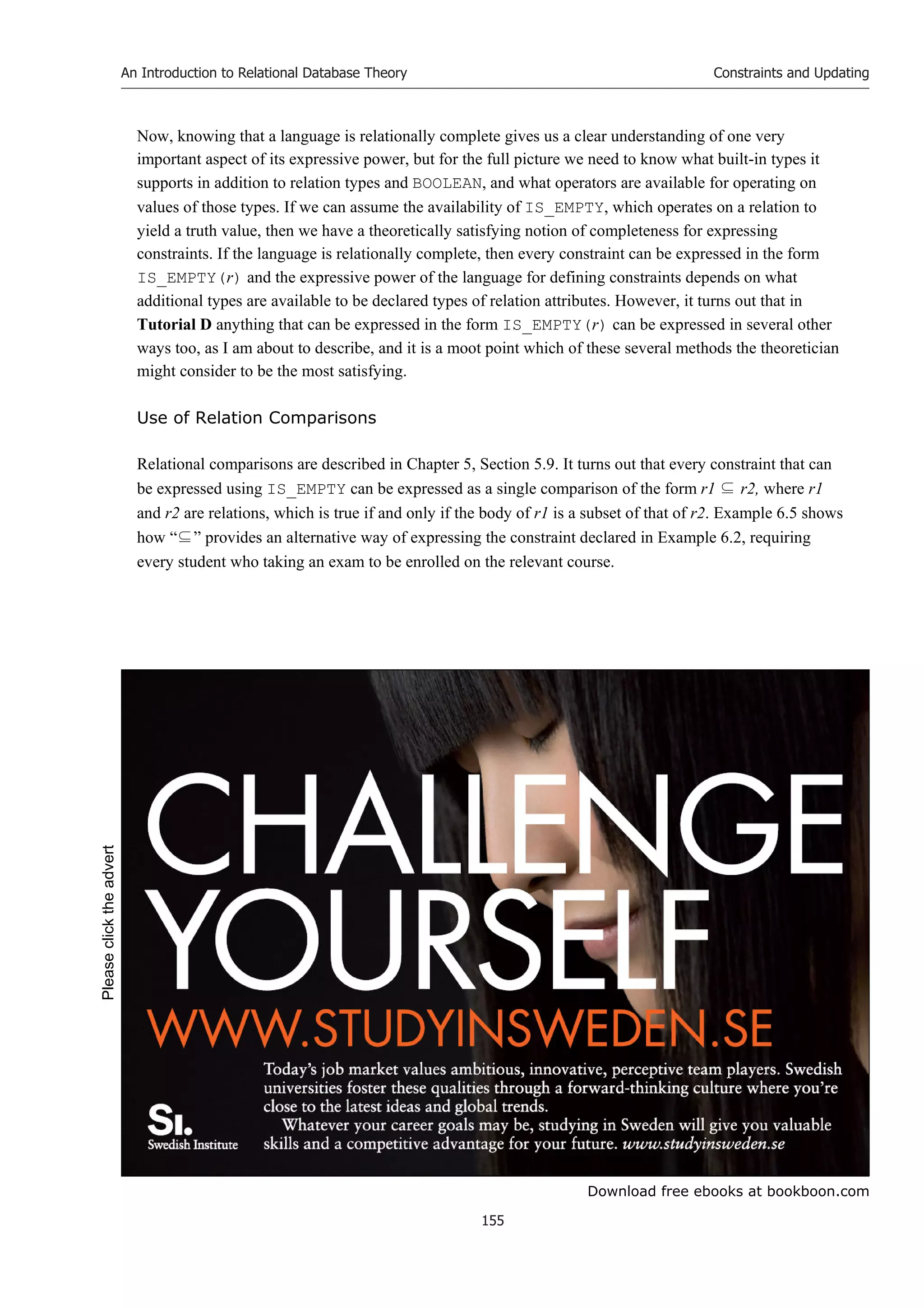
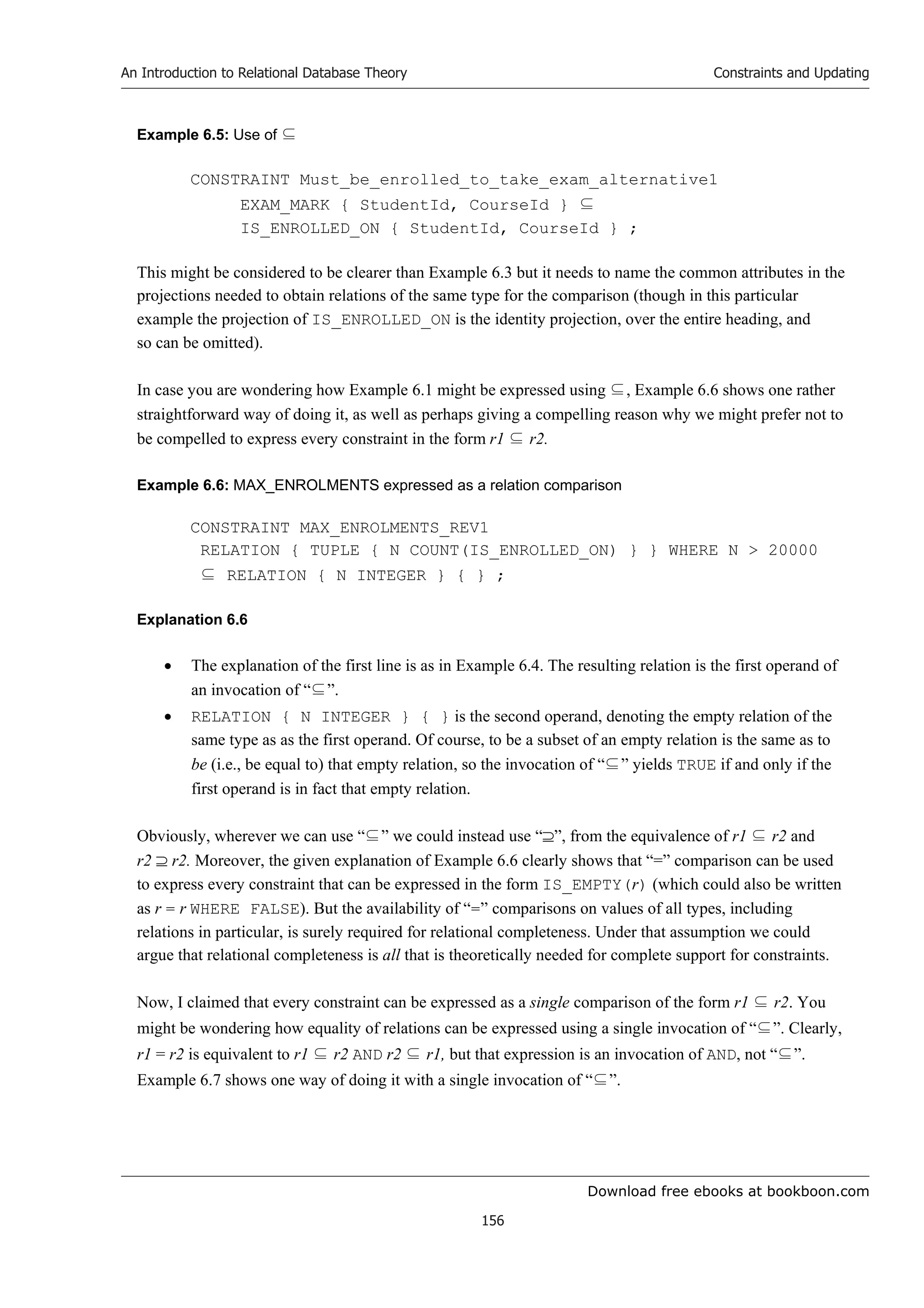
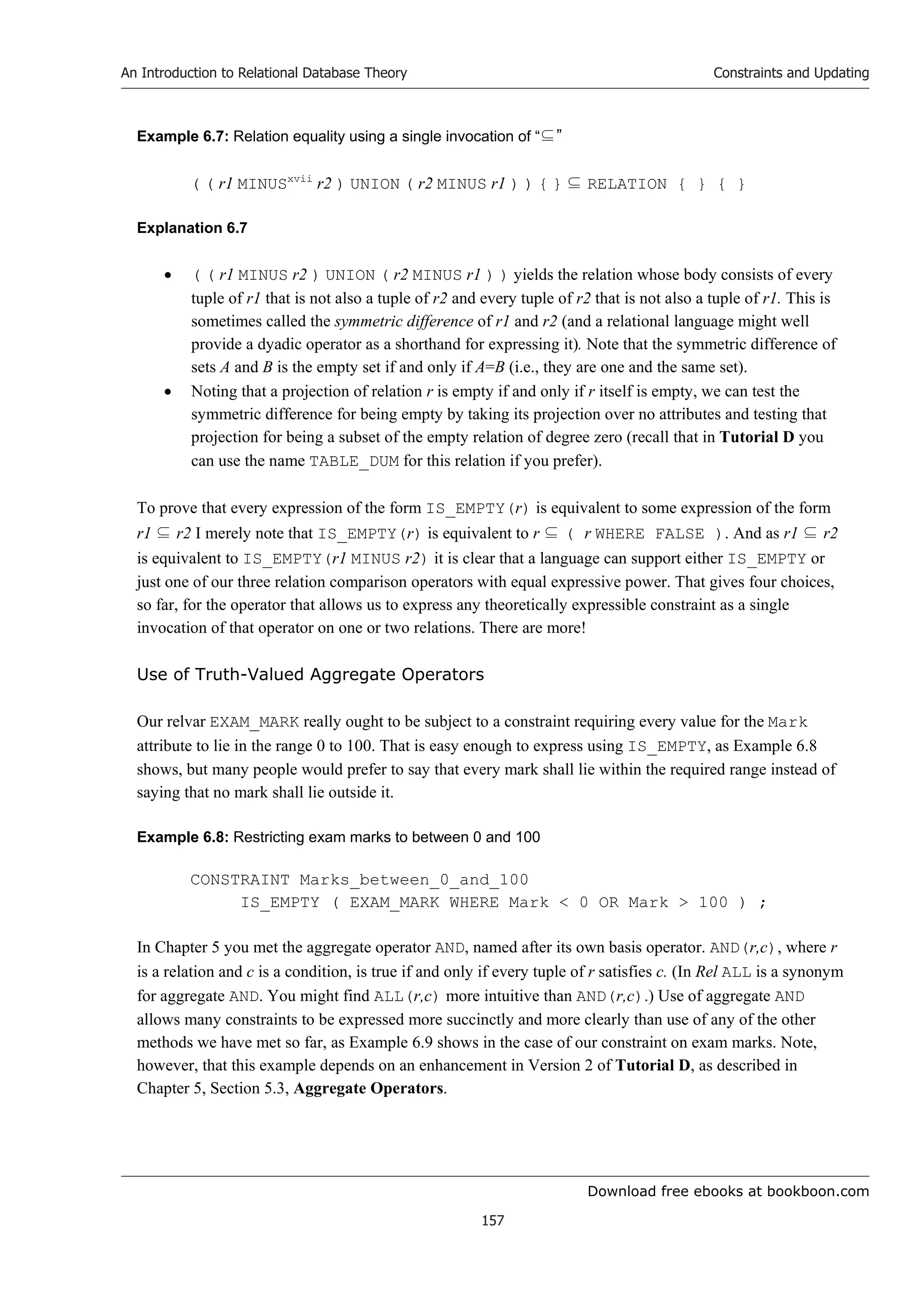


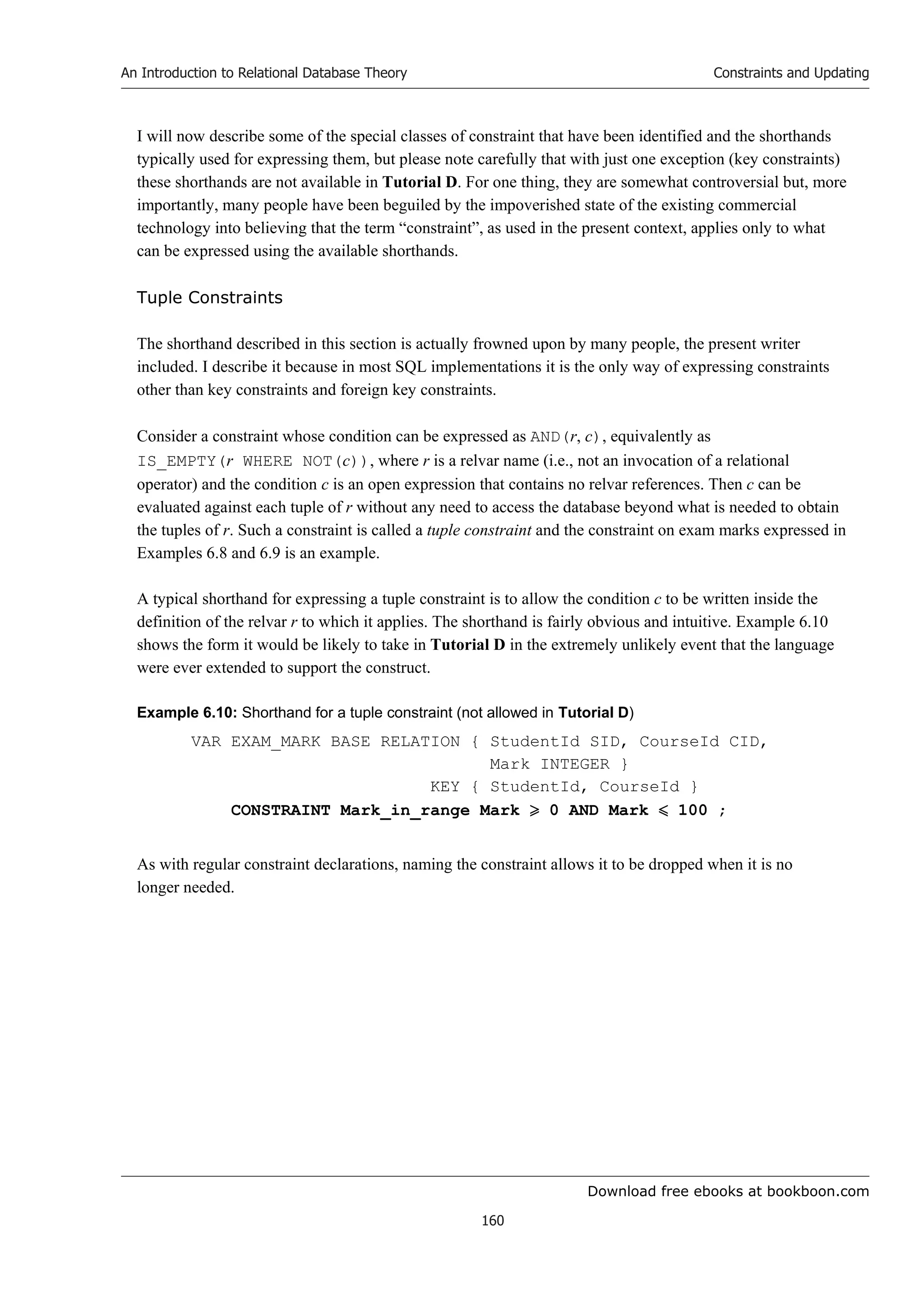

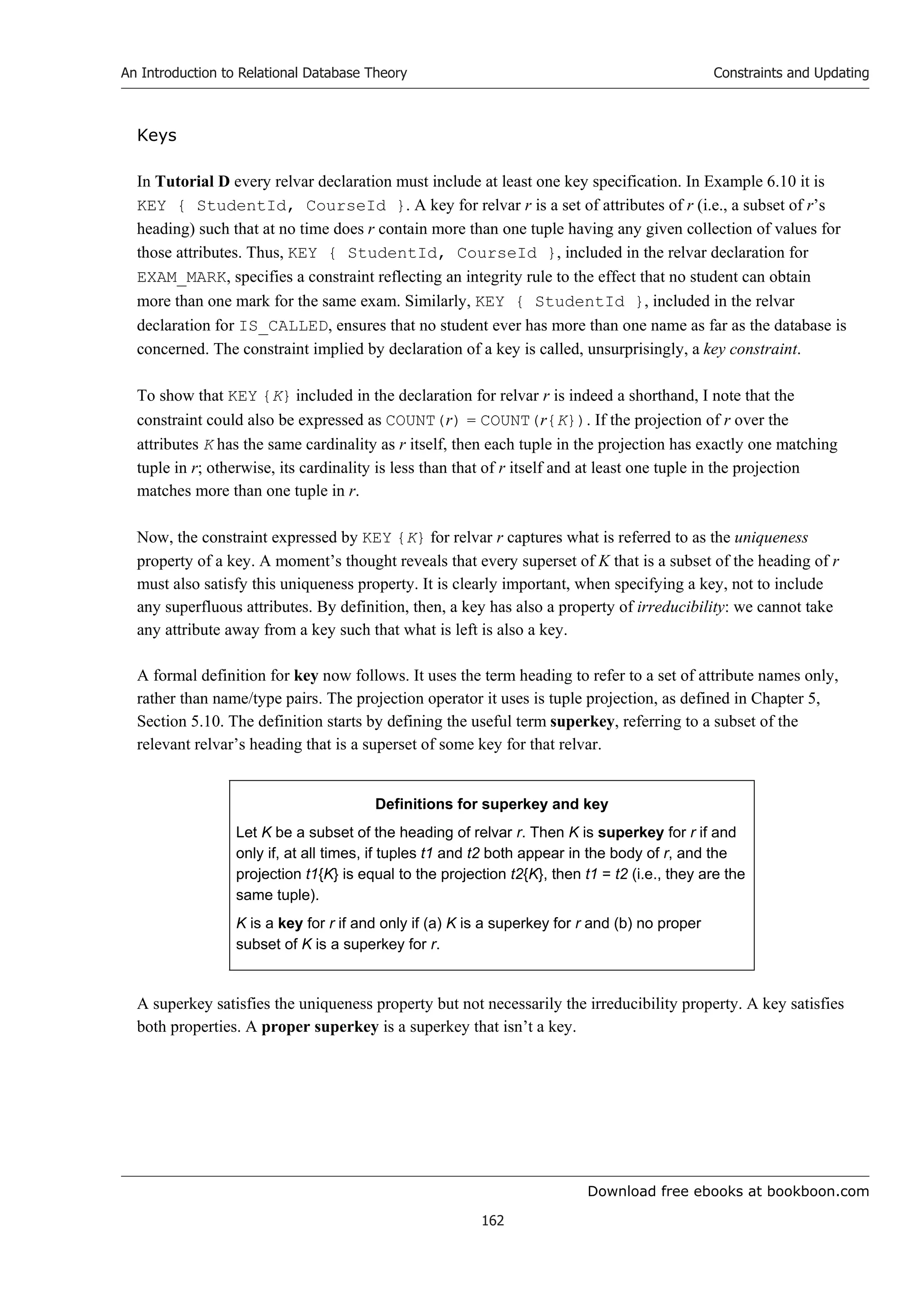
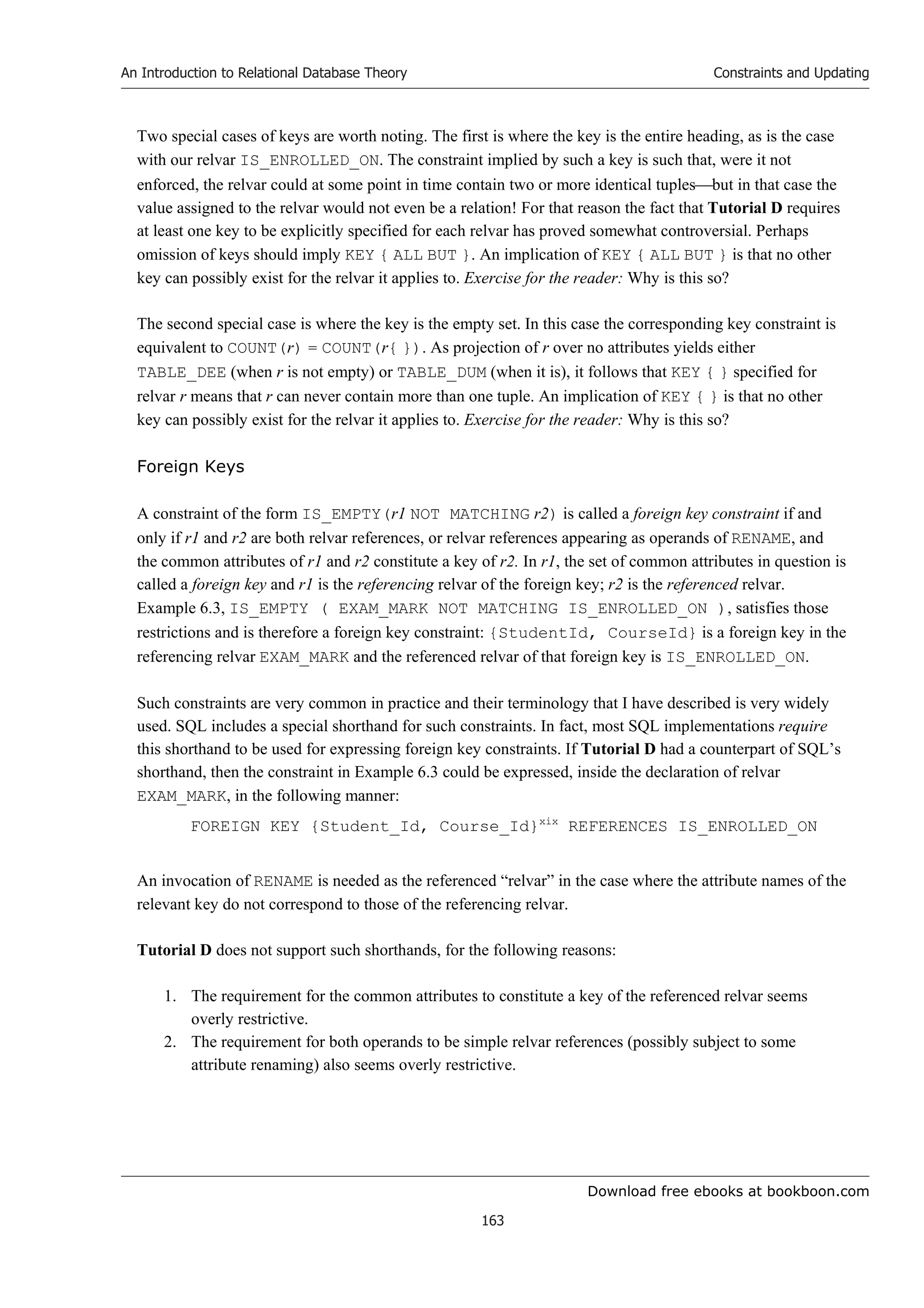
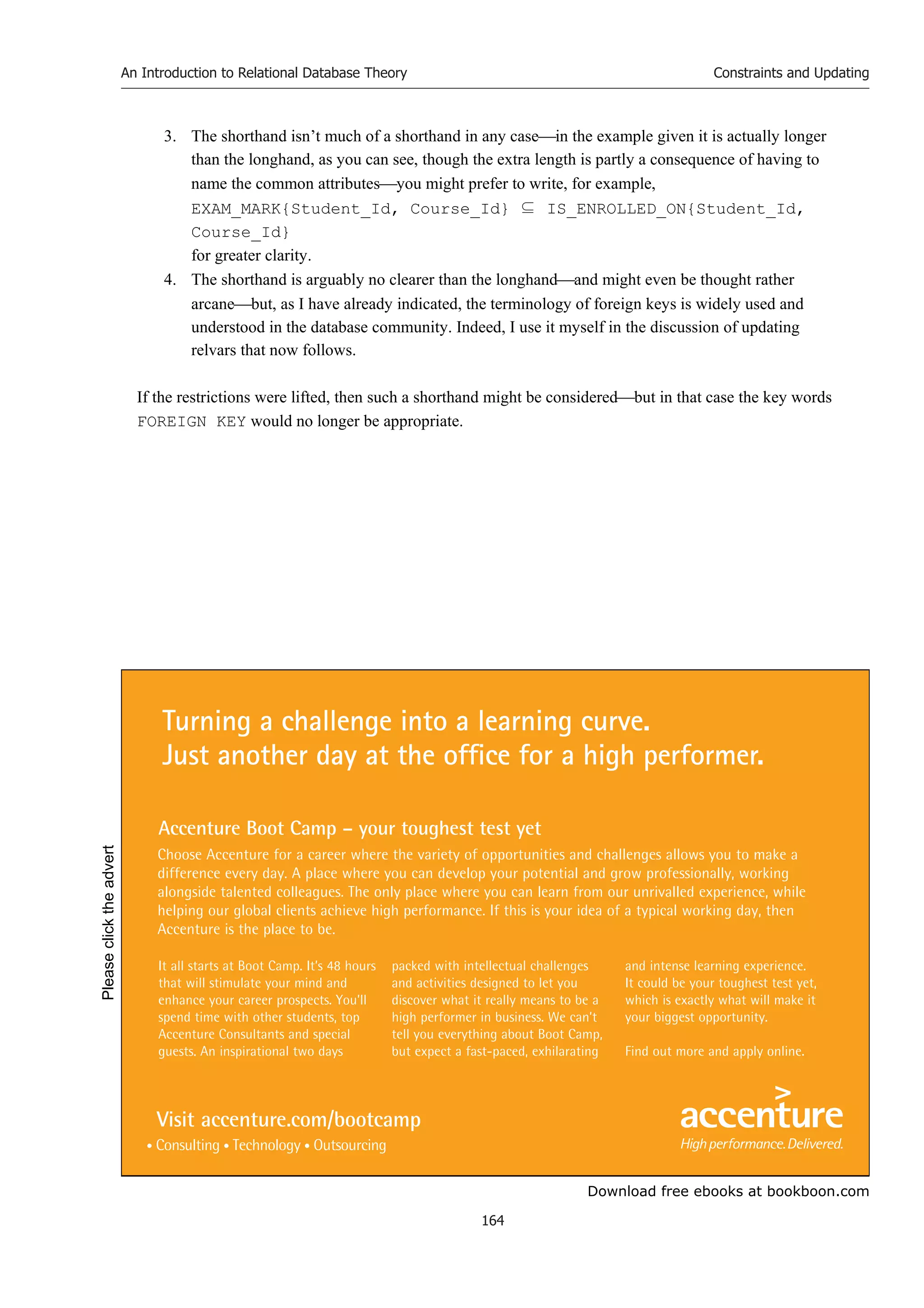
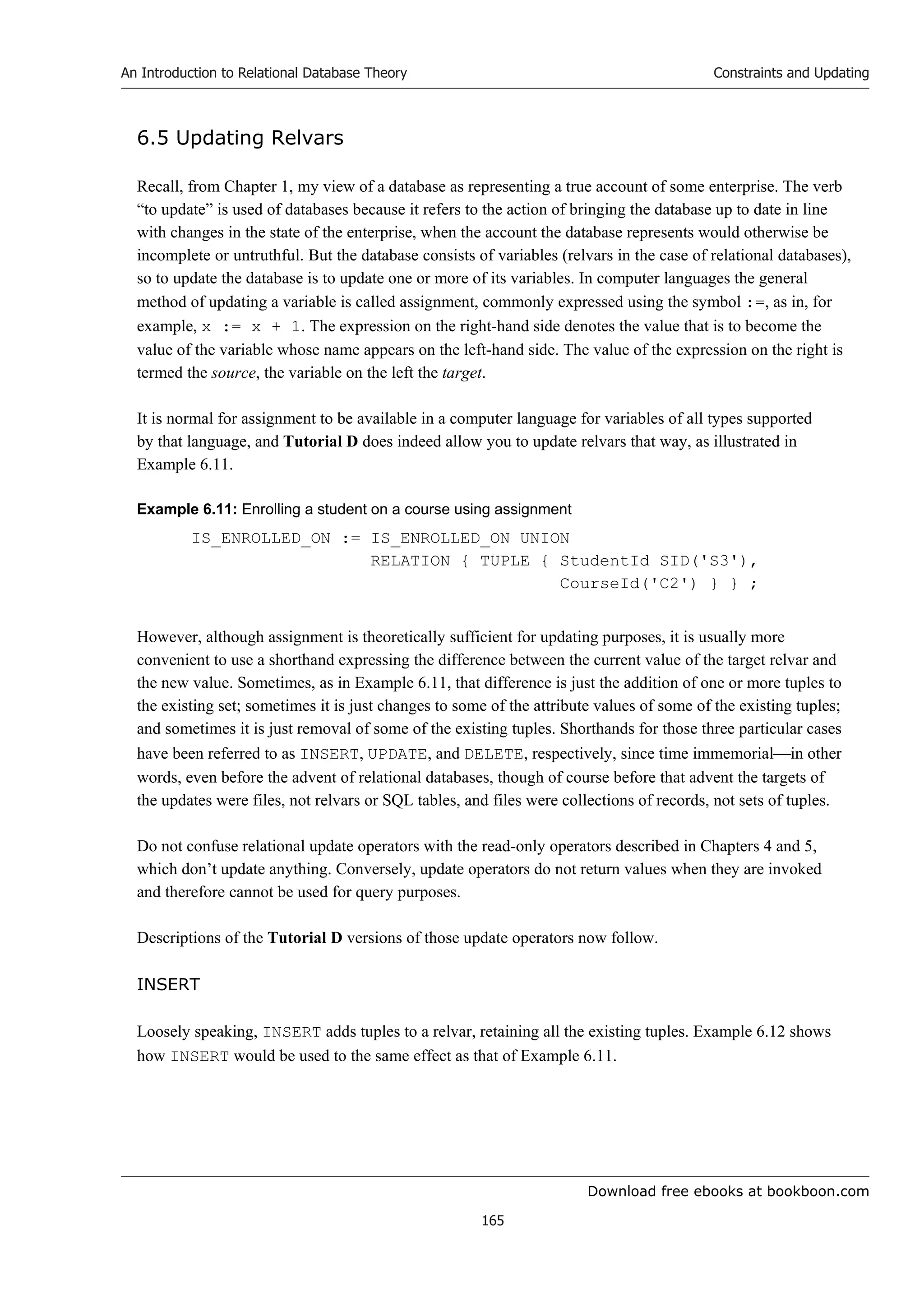
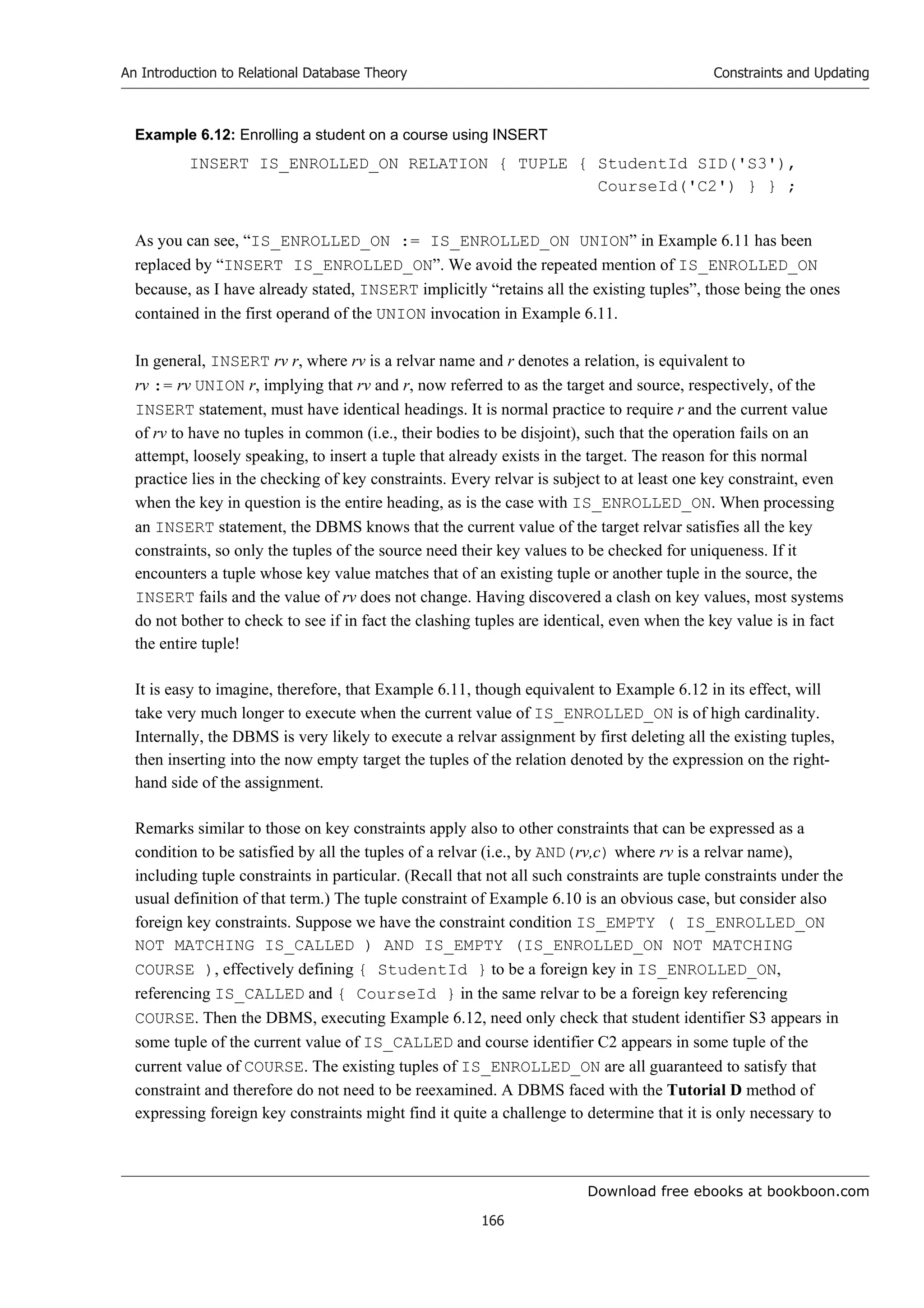

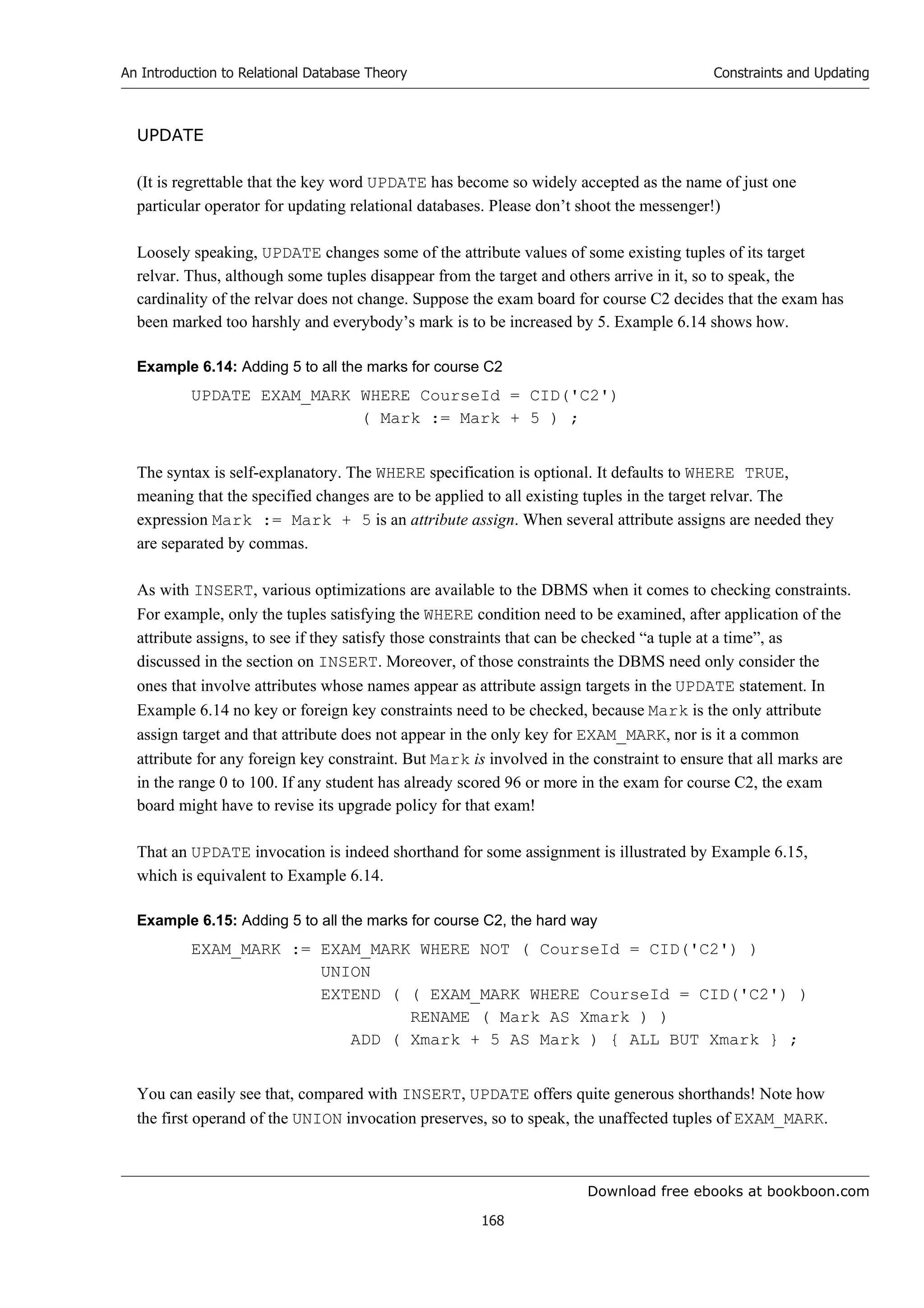

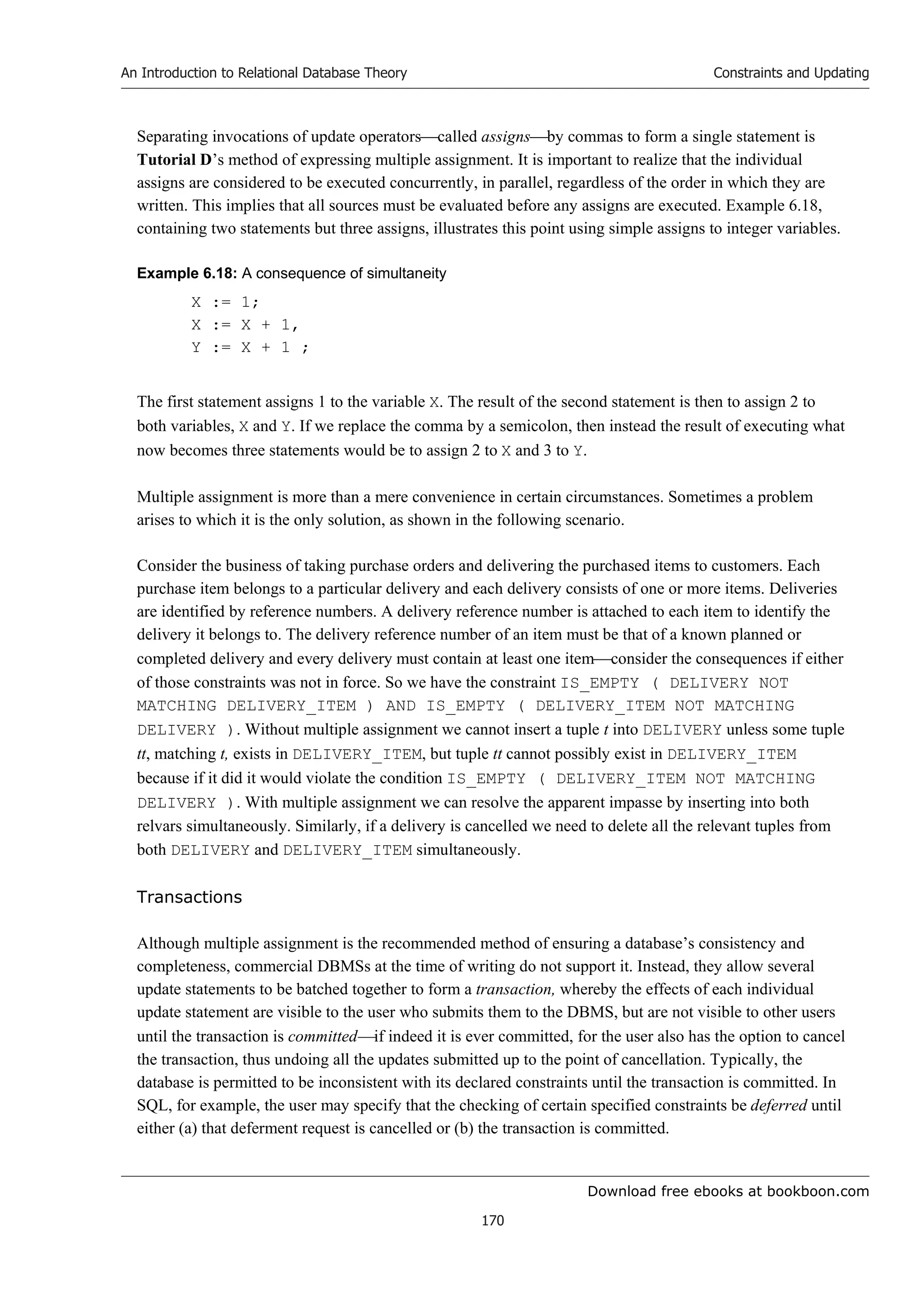
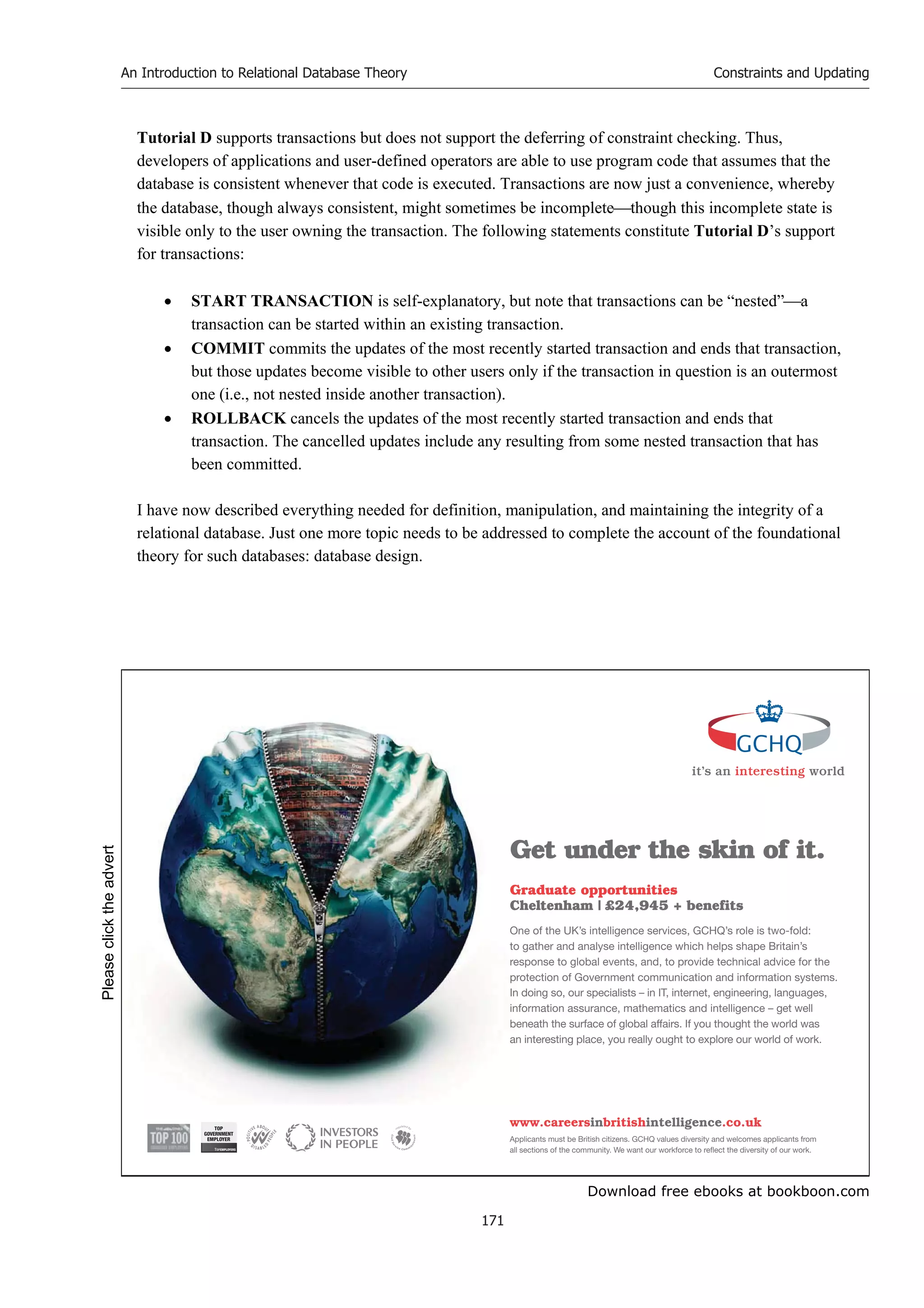
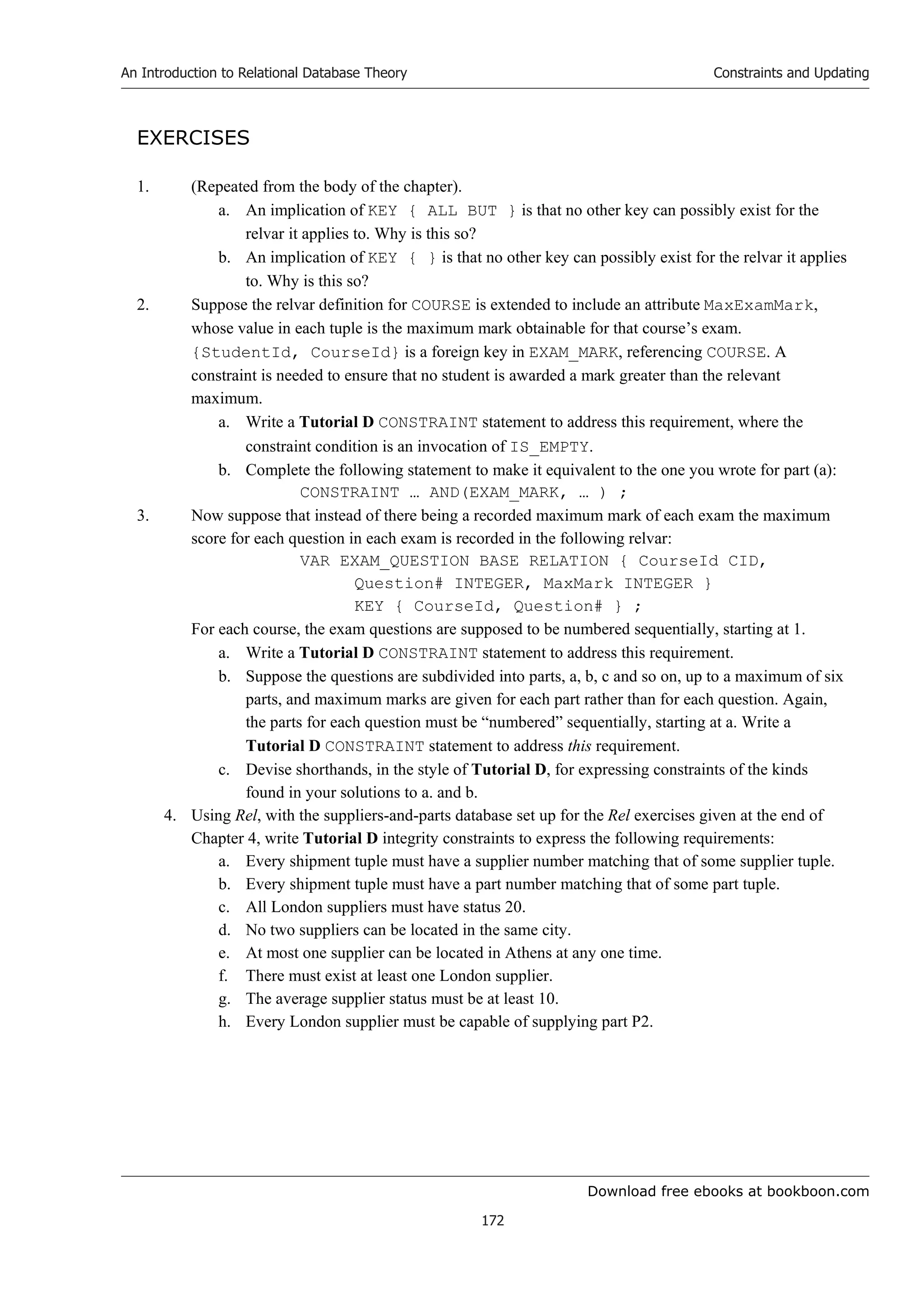
![Download free ebooks at bookboon.com
An Introduction to Relational Database Theory
173
Database Design I: Projection-Join Normalization
7. Database Design I: Projection-Join Normalization
7.1 Introduction
Relational database design takes a statement of requirements and produces a database definition to address
those requirements. The definition consists of a collection of relvar and constraint definitions. As Chris
Date puts it in [9] under the heading logical database design:
Ideally, the goal is to produce a design that’s independent of all considerations having to do with either physical
implementation or specific applicationsthe latter objective being desirable for the good reason that it’s generally not
the case that all uses to which the database will be put are known at design time.
The production and format of a precise and complete requirements statement are beyond the scope of this
book. Suffice it here just to say that the statement usually takes the form of a collection of “business rules”
and/or some kind of “entity/relationship model” presented in some agreed notation. Business rules are
expressed in this chapter for some examples, in an intuitive and somewhat informal style thought to be
good enough for the purpose at hand. The fact is, though, that even when the requirements are 100% clear
there are usually some design choices to be made: in other words, there can be several significantly
different designs to implement any given requirement statement.
What common kinds of alternative might the designer encounter and in each case what considerations
should guide the designer in arriving at the preferred choice? In this book I describe and discuss several
common alternatives under the headings Projection-join Normalization (this chapter), Group-Ungroup
and Wrap-Unwrap Normalization, Restriction-Union Normalization, Surrogate Keys, and
Representing “Entity Subtypes”. The reader should be warned, though, that relational database theory
has very little science to offer regarding database design, and what little science it does offer is almost
entirely within the first of these topics, projection-join normalization, to which the rest of this chapter is
devoted. For the others, described in Chapter 8, we can do no more than make note of the choices and
suggest some guidelines.
7.2 Avoiding Redundancy
A common issue in database design concerns redundancyrecording the same information more than
once. For example, redundancy is exhibited in this book’s very first example of a relation: Figure 1.2 in
Chapter 1, where the information that student S1’s name is Anne is recorded twice. The explanation
accompanying this figure indicates that the relation is the current value of a relvar named ENROLMENT, so
we can safely conclude that the possibility of redundancy is a consequence of the database designa
student’s name is recorded as many times as that student has concurrent enrolments.](https://image.slidesharecdn.com/an-introduction-to-relational-database-theory-230210032734-035be350/75/an-introduction-to-relational-database-theory-pdf-173-2048.jpg)
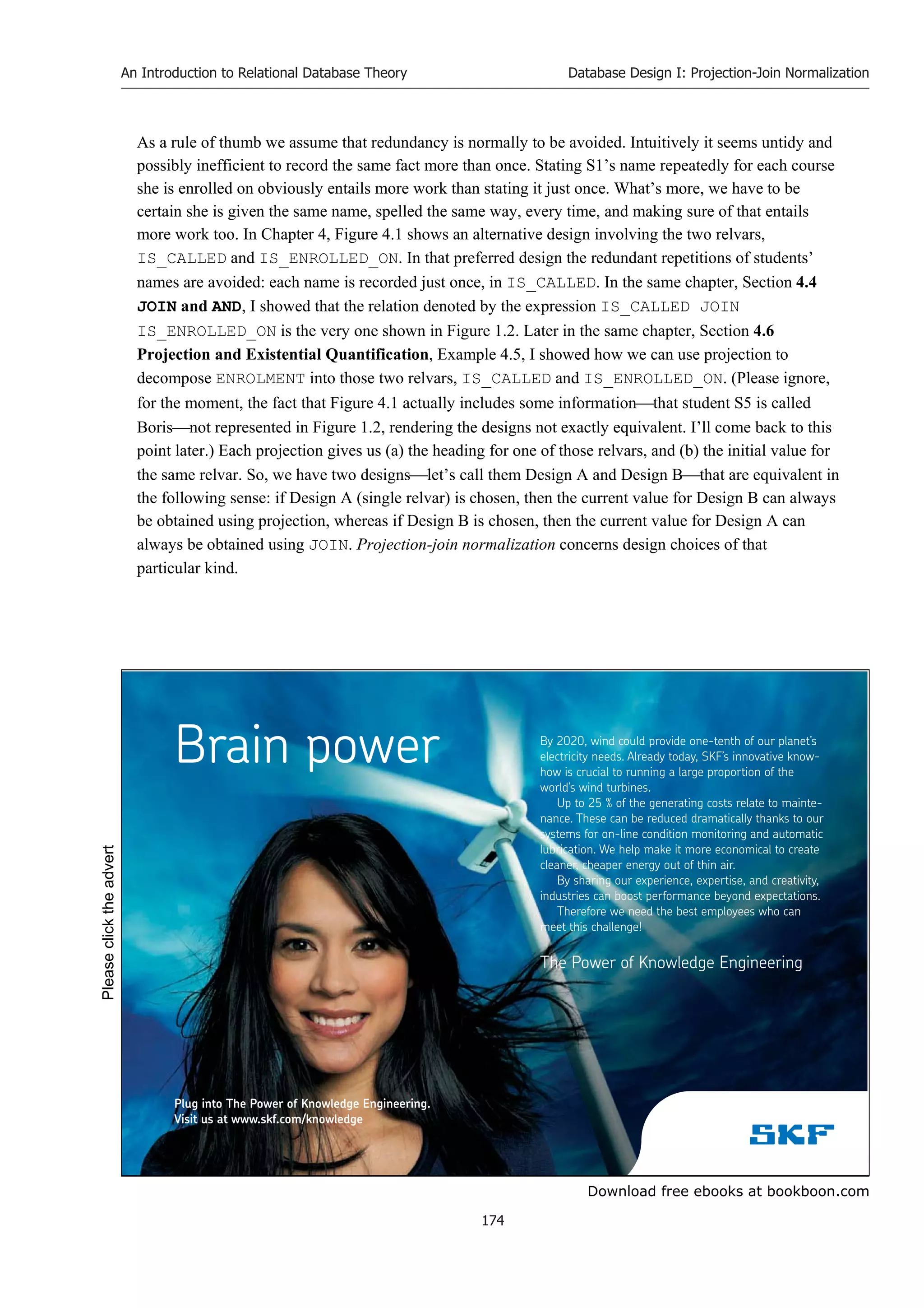
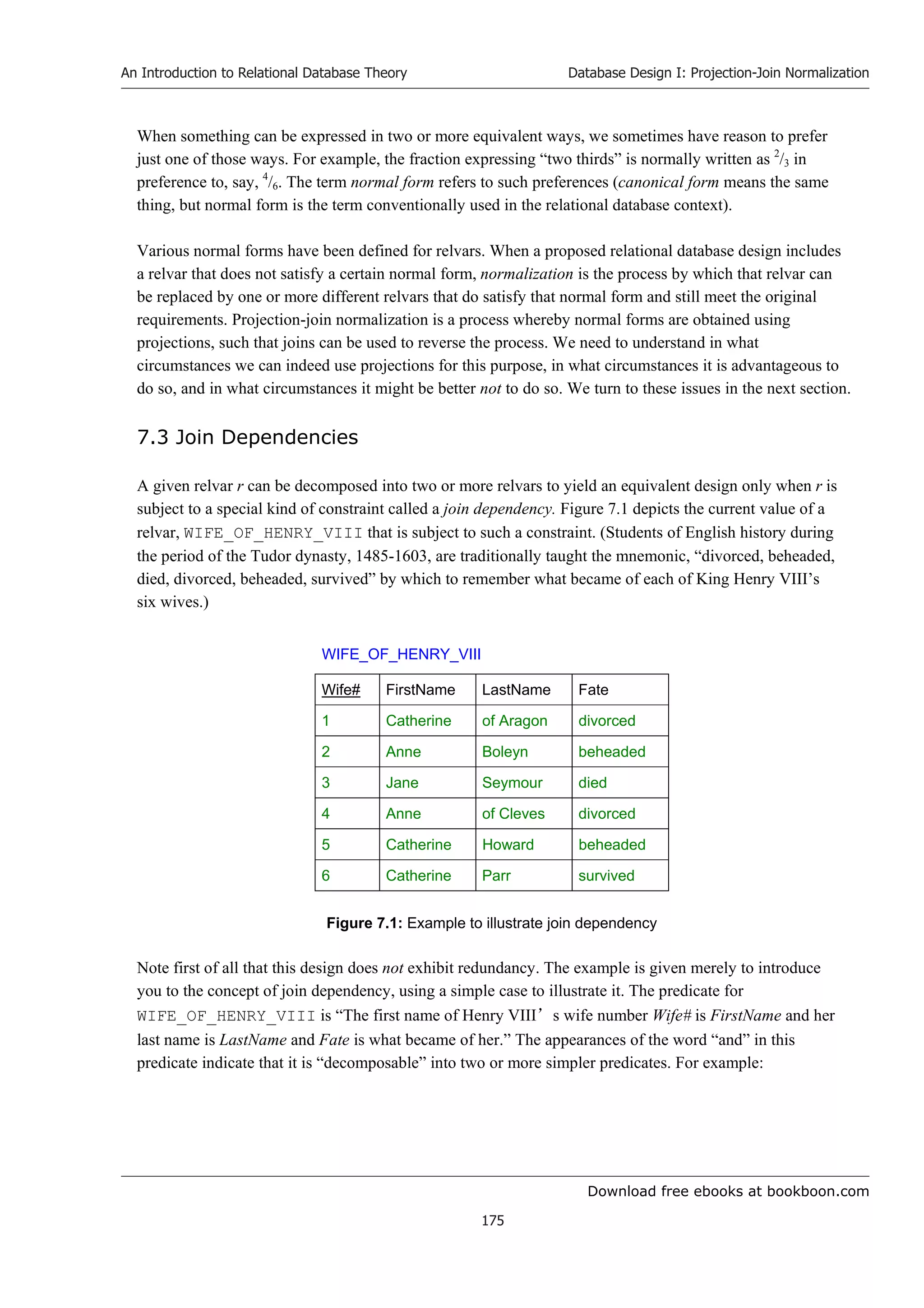

![Download free ebooks at bookboon.com
An Introduction to Relational Database Theory
177
Database Design I: Projection-Join Normalization
For convenience, I shall refer to the components of a JD{ Wife#, FirstName } and { Wife#,
LastName, Fate } in this exampleas projections, and the number of projections as the degree of the
JD. This one is of degree 2 and is therefore called a binary JD. The symbol * is often used in textbooks for
the join operator. Because the operands of a JD are projections they are indicated by lists of attribute
names enclosed in braces; those operands are in turn enclosed in braces because in general a join
dependency can involve any number of projections and, thanks to the commutativity and associativity of
the join operator, the order in which those projections are written is insignificant.
Note that the formulation shown for one of the JDs to which WIFE_OF_HENRY_VIII is subject makes
no mention of that relvar. Whenever we mention a JD it must be clear from the context to which relvar it
applies. We normally do that by stating whether the given JD holds in that relvar. The JD in our example
does indeed hold in WIFE_OF_HENRY_VIII. By contrast, the JD
* { { Wife#, FirstName }, { LastName, Fate } }
for example, does not hold in that relvar, because the following tuple, among several others, appears in the
join of those two projections but does not appear in the current value of WIFE_OF_HENRY_VIII:
TUPLE { Wife# 2, FirstName 'Anne',
LastName 'Parr', Fate 'survived' }
Note that in the projection over { LastName, Fate } we lose the information that Seymour is the last
name of wife number 3, for example. Conversely, in the join we “gain” the misinformation represented by
those tuples that do not appear in WIFE_OF_HENRY_VIII. To put it more accurately, the predicate for
WIFE_OF_HENRY_VIII does not apply to the result of this join, so the information represented is
different too. (Exercise for the reader: what predicate does apply to it?)
Note that a JD cannot possibly hold in its applicable relvar, r, unless each attribute of r appears in at least
one of the projections. If that is not the case, then the join of those projections does not have the same
heading as r and therefore cannot be equal to r.
You have probably noticed that W_LN_F, in whose predicate the word “and” still appears, can be
further decomposed. I’ll come back to this point in a moment. W_FN, however, cannot be further
decomposed. We say that relvar W_FN is an irreducible relvar. We also say that relvar W_FN is in sixth
normal form (6NF), whereas W_LN_F is not in 6NF and nor is WIFE_OF_HENRY_VIII. You are right
in guessing from the name, sixth normal form, that other normal forms have been identified, at least five
of which are identified by numbers. In fact several others have been defined around the idea of eliminating
certain JDs, varying according to exactly which particular kinds of JD they eliminate. Fortunately, some
of them can now safely be regarded as preliminary ideas by researchers, later subsumed by more general
and more useful definitions. Nowadays it is sufficient to study just three “JD-eliminating” normal forms.
In this book I refer to them as projection-join normal forms, but please note that the term projection-join
normal form (PJ/NF) is used by some writersincluding its originator, Fagin [12]to refer specifically to
just one of these three (namely, 5NF).](https://image.slidesharecdn.com/an-introduction-to-relational-database-theory-230210032734-035be350/75/an-introduction-to-relational-database-theory-pdf-177-2048.jpg)

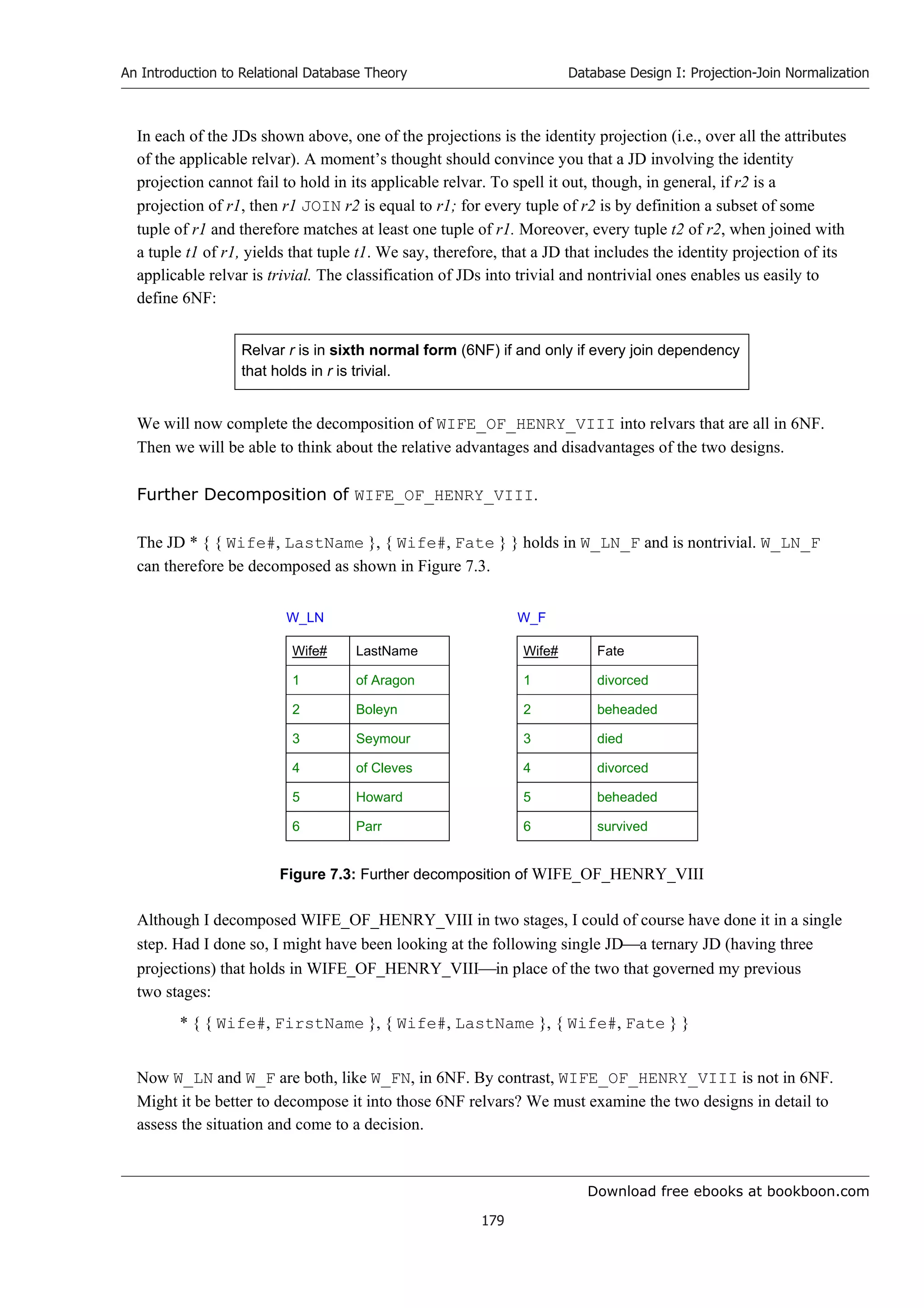
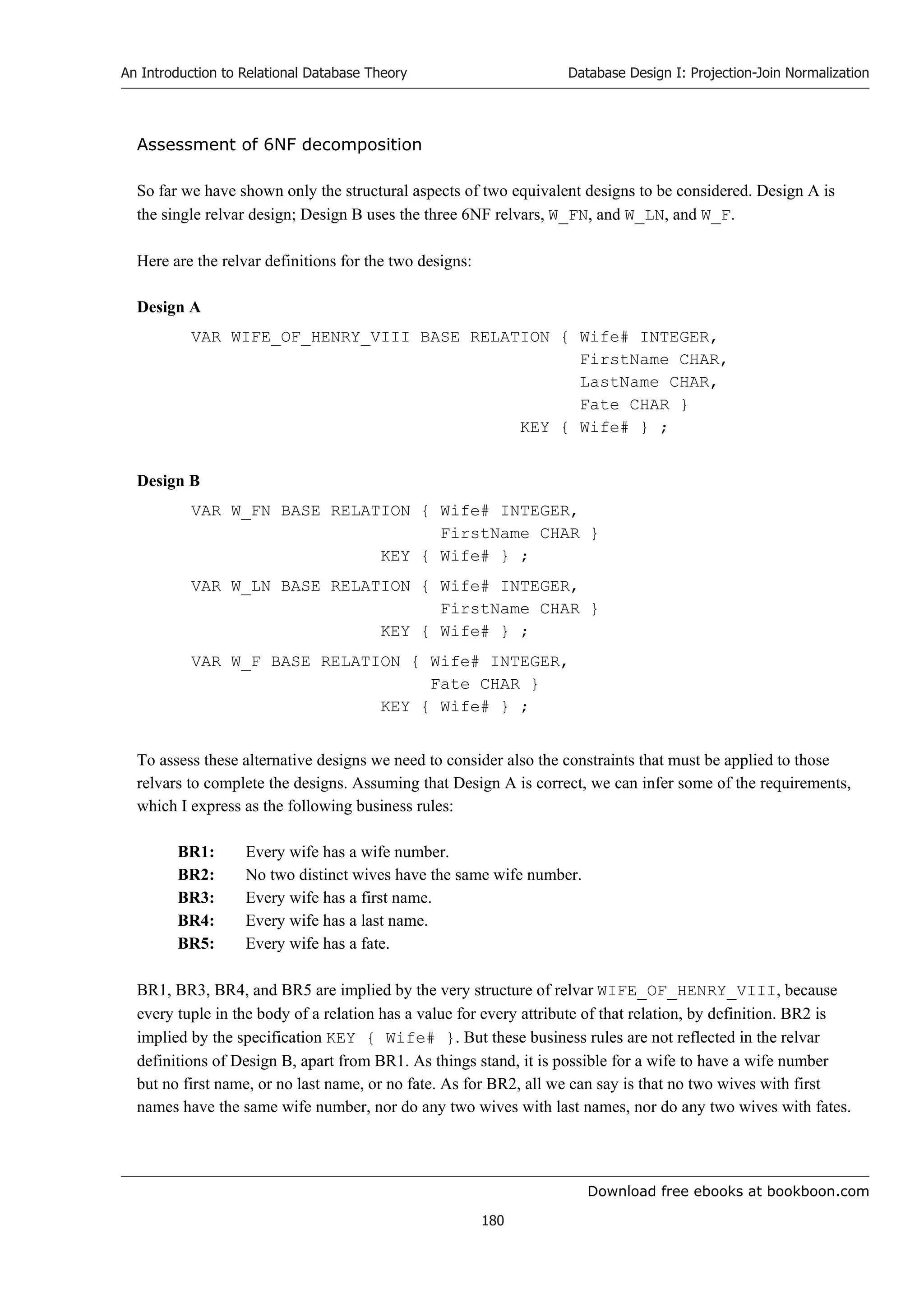
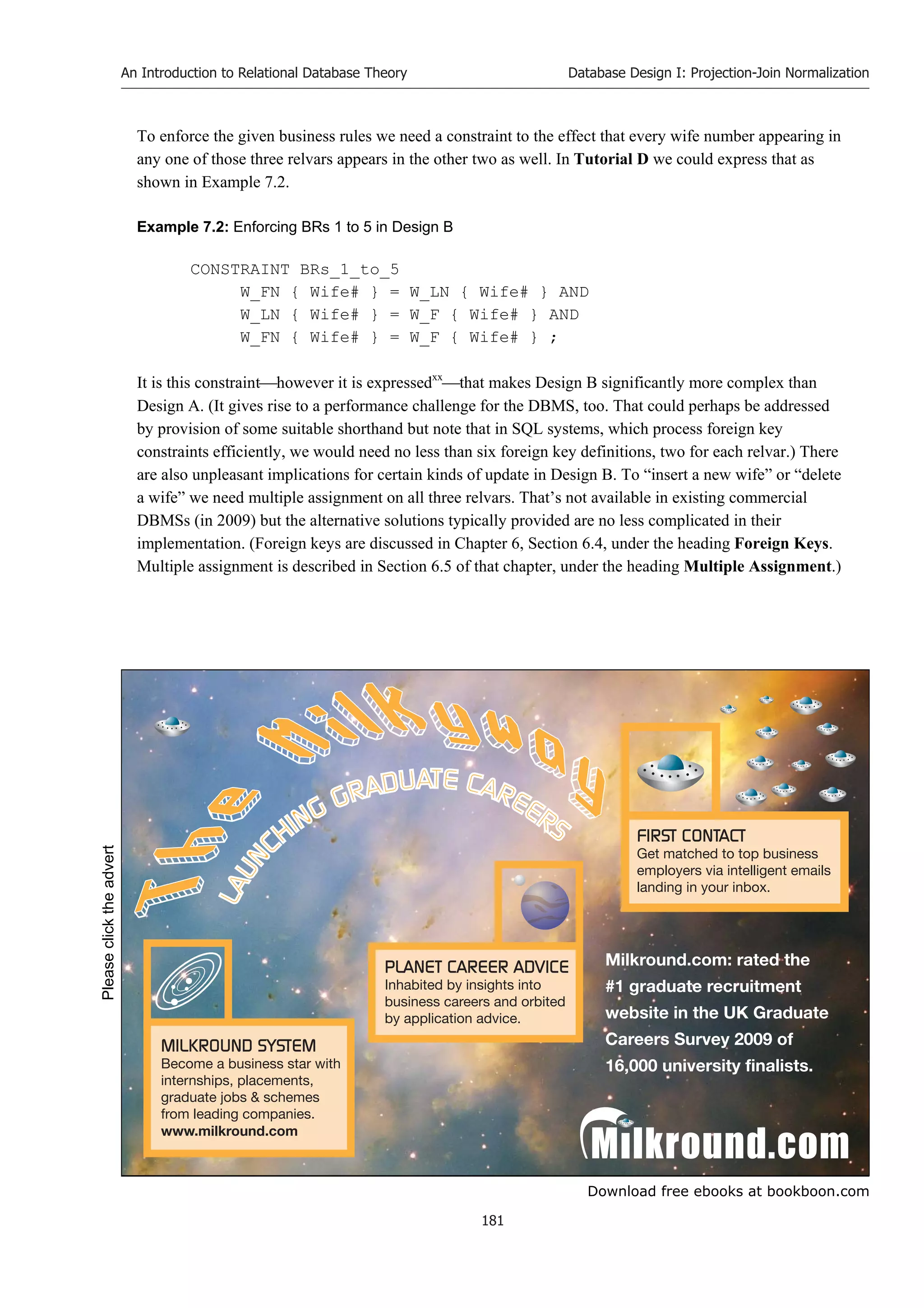
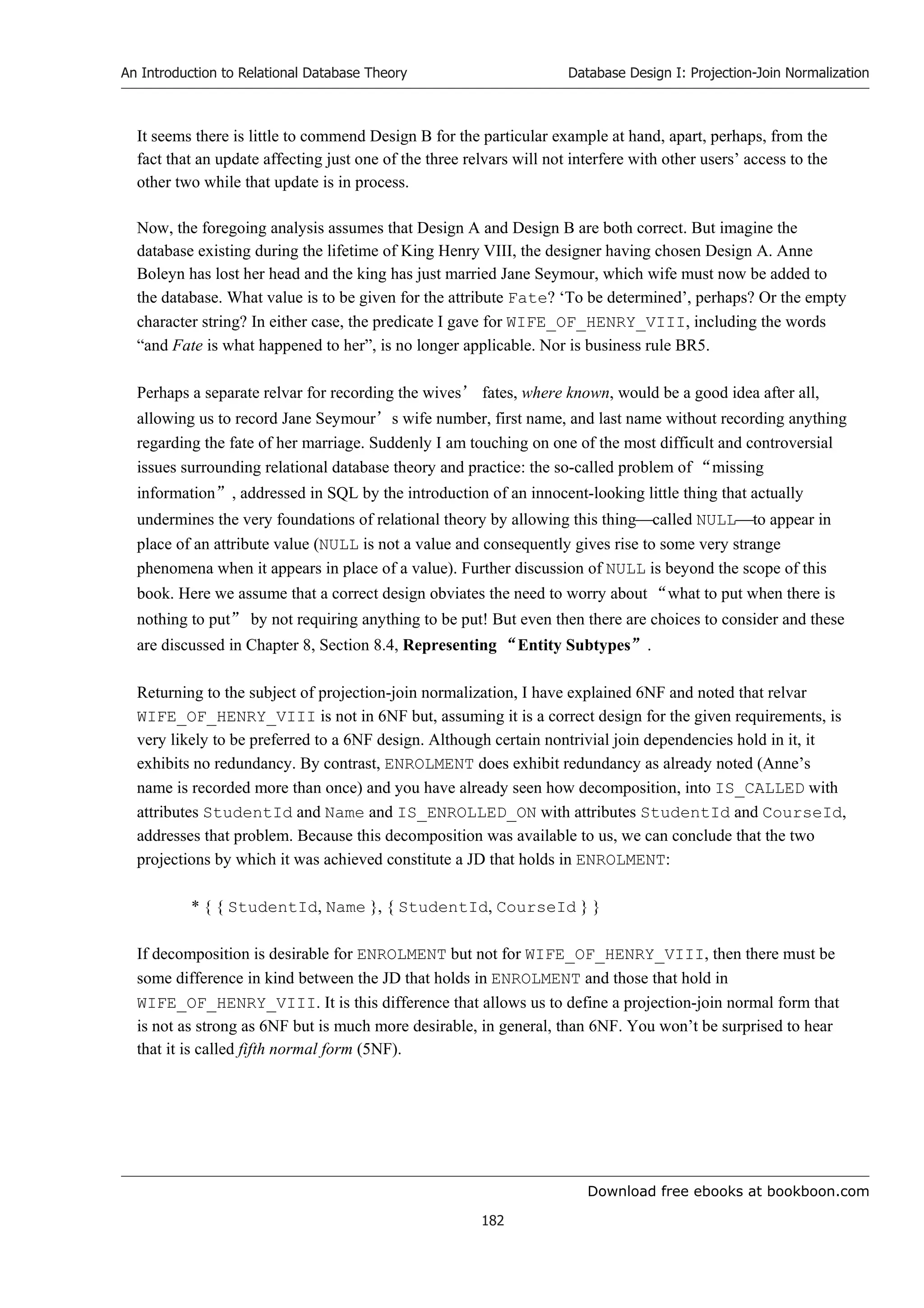
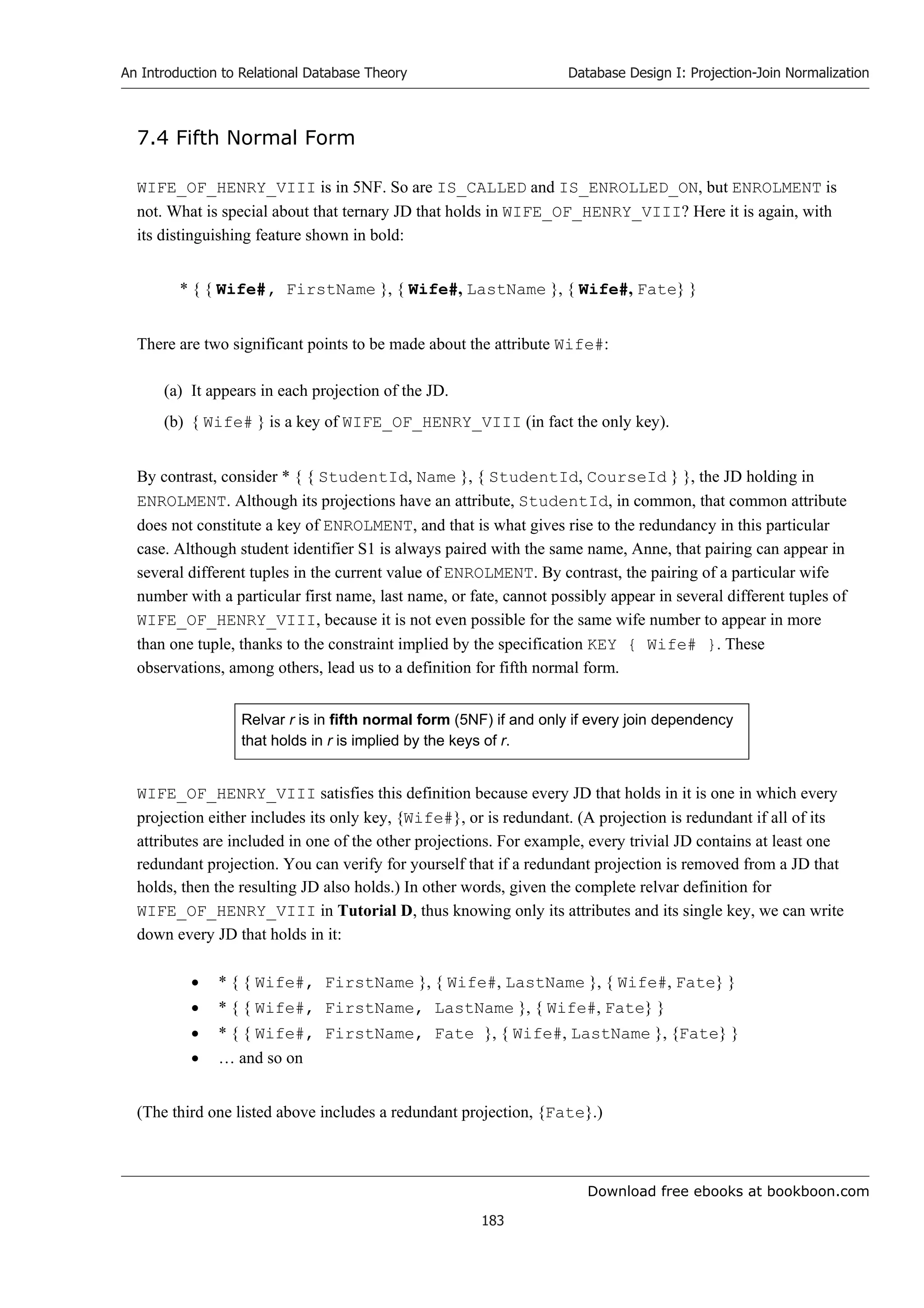
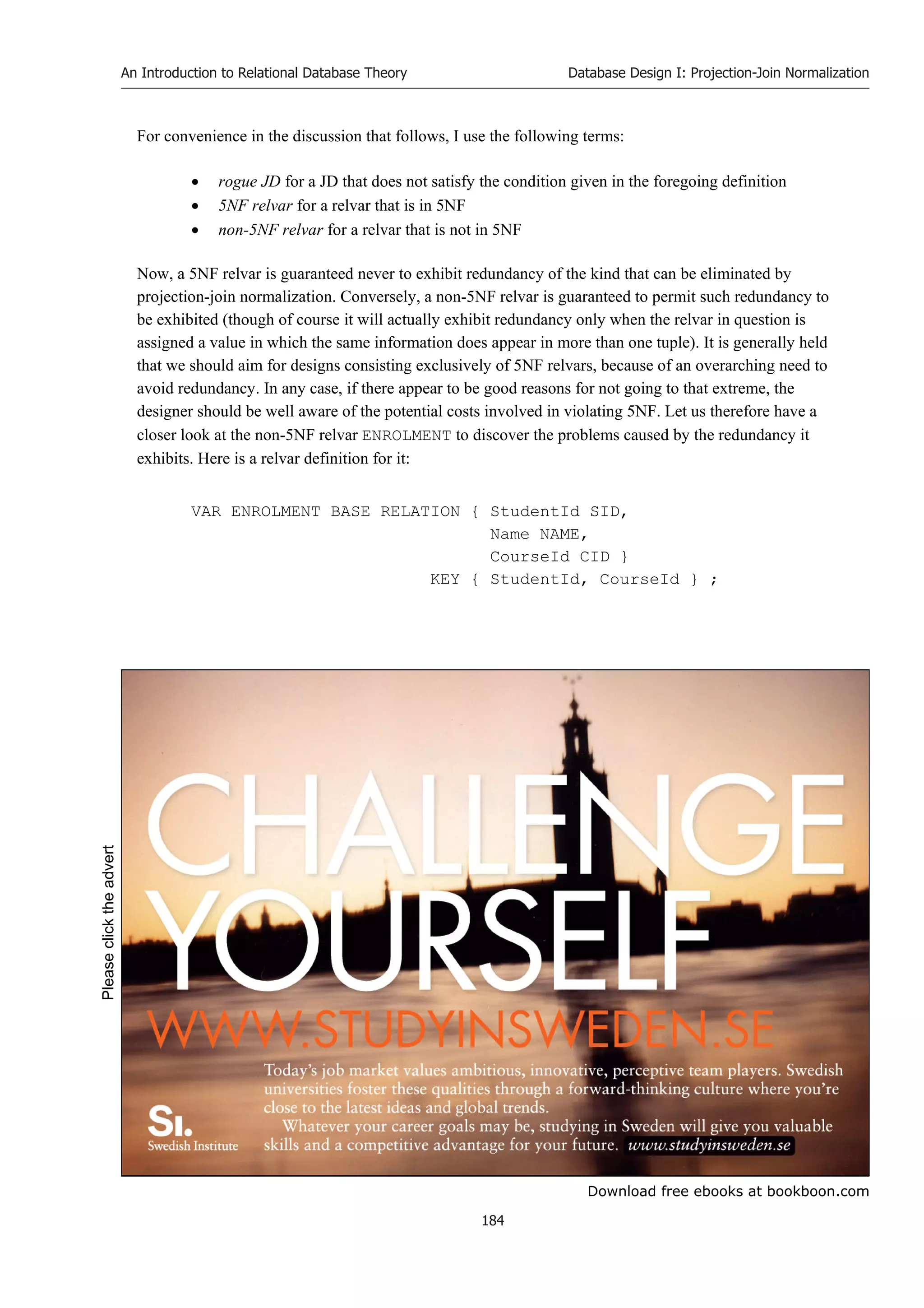

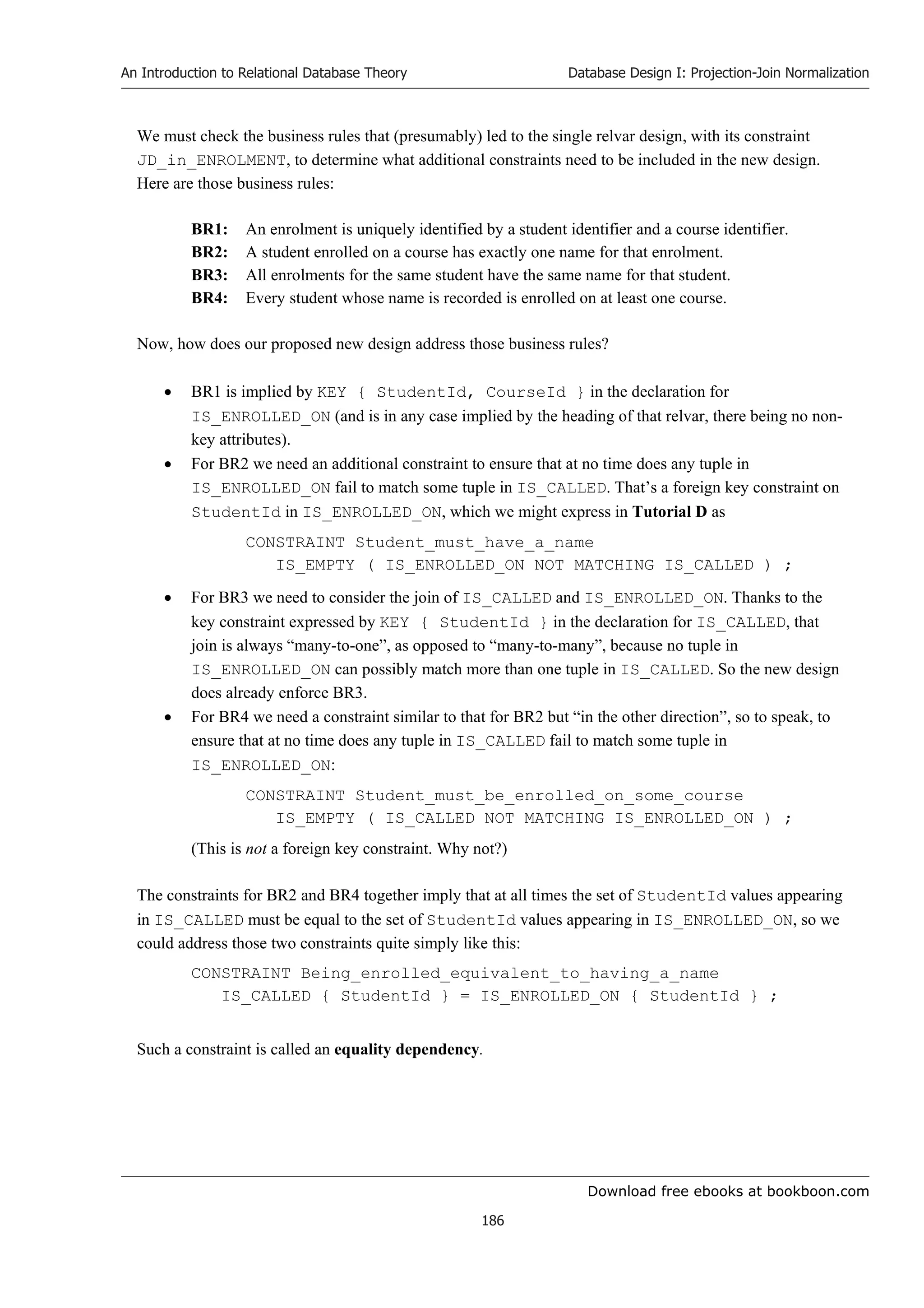
![Download free ebooks at bookboon.com
An Introduction to Relational Database Theory
187
Database Design I: Projection-Join Normalization
As we have already seen, equality dependencies are a bit of a challenge for the DBMS and in most
commercial DBMSs existing in 2009 it cannot even be expressed. However, in those same DBMSs the JD
constraint required for ENROLMENT cannot be expressed either, so neither of the designs is fully
implementable in the current technology!xxi
If we can express both of those constraints, then, on the
evidence so far, there doesn’t seem to be a lot to choose between the two designs and our decision is more
likely to be based on how well the DBMS supports multiple assignments; if we can’t express the
constraints, then the stated requirements cannot be met and we will have to compromise (and perhaps rely
on application code to maintain integrity). But efficacy of constraint checking isn’t the only criterion to
guide our choice. What if, for example, student S1’s name is incorrectly recorded as “Ann” and needs to
be corrected to “Anne”? In the unnormalized design that correction will entail updates to several tuples in
ENROLMENT, whereas in the 5NF design just one tuple in IS_CALLED is affected. On the other hand, a
query to give the names of all the students enrolled on course C1 is simpler to express (and might run
faster) in the unnormalized design. A frequent complaint about rigorous application of 5NF is that the
decomposition causes too many joins to have to be used in queries. Advocates of 5NF respond by pointing
out that the query to find the names of all the students is simpler to express (and might run faster) in the
5NF design!
It does seem that the 5NF design has a certain aesthetic appeal, giving a structure that is reduced to
simpler terms and is thus in a sense more flexible. Also, an abiding motivation for the relational approach
is that in principle the database designer need not anticipate the kinds of queries that will be presented to
the DBMS. A 5NF design “levels the playing field” in keeping with that principle. Moreover, the
discussion so far has been based on the assumption that the single relvar design, from which we inferred
those business rules, is correct, an assumption we might well question.
In particular, we might question BR4: “Every student whose name is recorded is enrolled on at least one
course”. Does the university really require every student to be always enrolled on at least one course, even
during the annual long vacation? What harm comes if that rule is relaxed? In that case the single relvar
design becomes incorrectand in any case we still need that complex and difficult constraint to express
the JD. With the 5NF design the difficult equality dependency becomes replaced by a simple foreign key
constraint to address BR2 and BR3.
Now, if 5NF is indeed a goal to be earnestly pursued, then some questions arise. How does the designer
discover that a relvar under consideration is not in 5NF? How do we spot the rogue JDsthe nontrivial
ones that do not arise simply as a consequence of keys? Well, there is an algorithm, given by Fagin (see
the annotation for reference [12] in Appendix B) for determining whether a given JD is implied by the
keys of the relvar to which it pertains; but to spot the JD in the first place you just have to examine the
business rules, and that’s not always very easy. However, a certain special kind of JD has been identified
such that when it holds in a given relvar r, r is not in 5NF. Not all 5NF-violating JDs are of this kind, but
in practice most of them are. If we can eliminate such JDs we stand a reasonable chance of achieving 5NF
by that action alone and any remaining rogue JDs should be quite easy to detect. A useful theory has been
developed around this special kind of JD, making it possible to mechanize certain important aspects of
relational database design.](https://image.slidesharecdn.com/an-introduction-to-relational-database-theory-230210032734-035be350/75/an-introduction-to-relational-database-theory-pdf-187-2048.jpg)
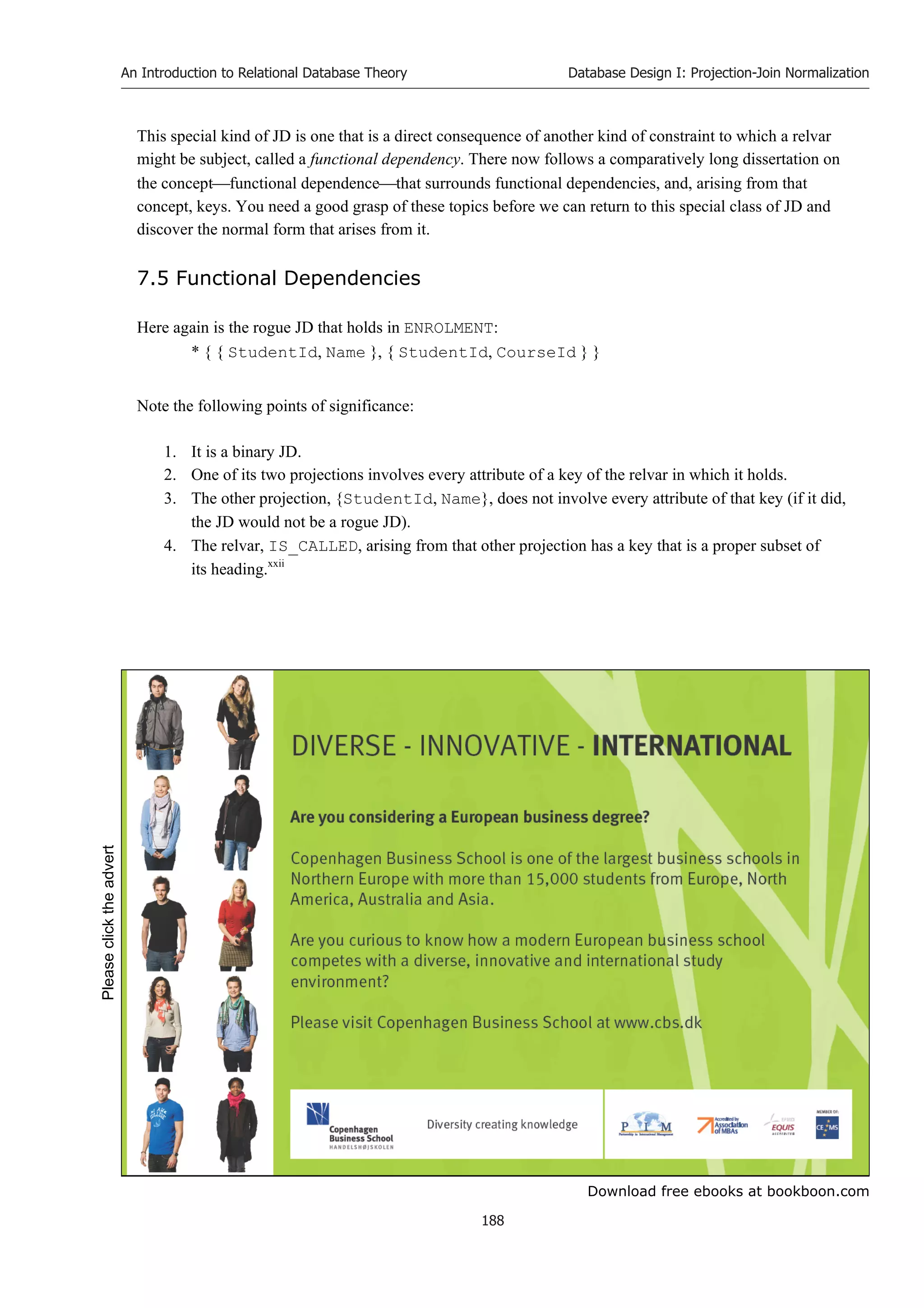
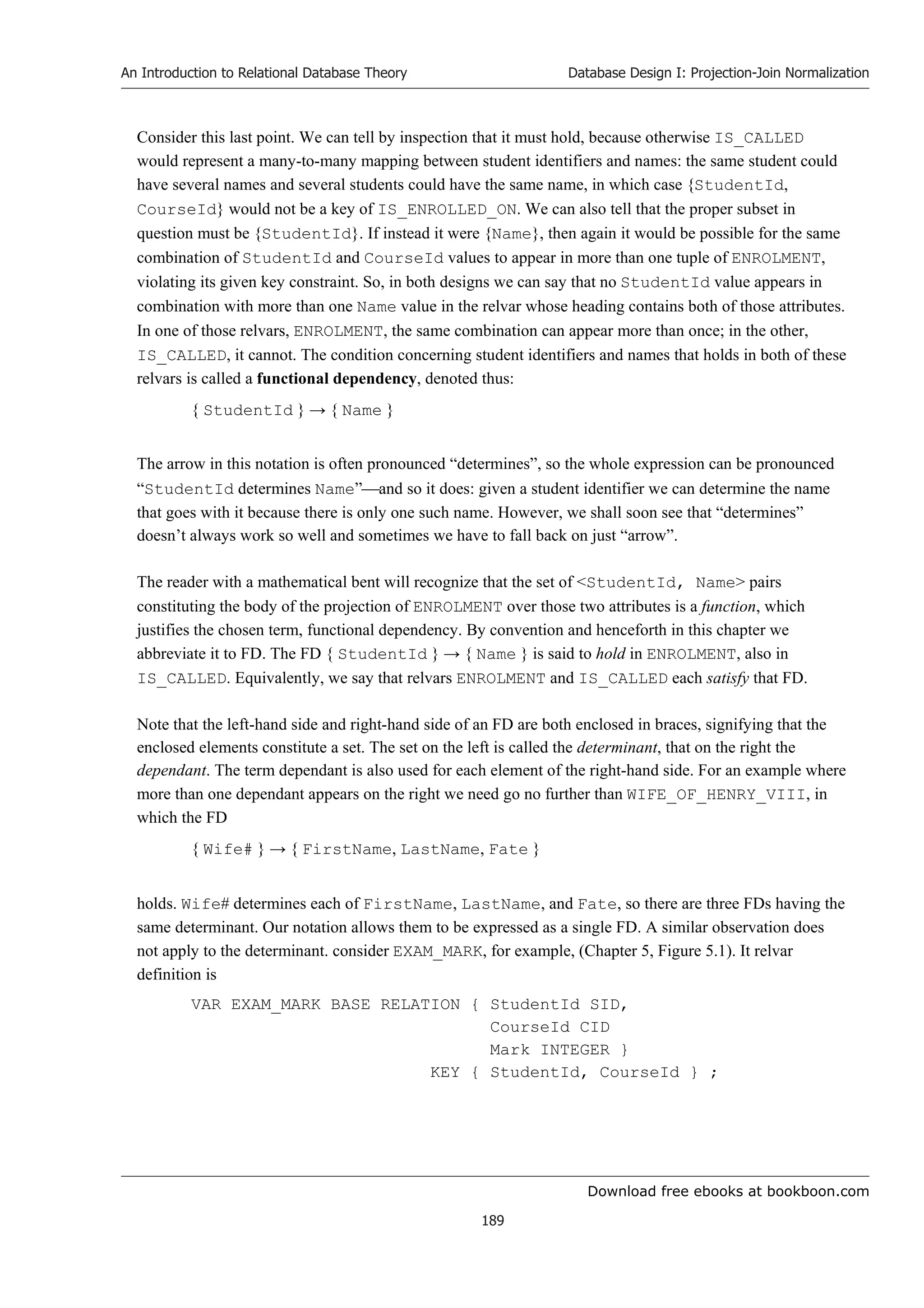
![Download free ebooks at bookboon.com
An Introduction to Relational Database Theory
190
Database Design I: Projection-Join Normalization
So the following FD holds in EXAM_MARK:
{ StudentId, CourseId } → { Mark }
Now we see why the pronunciation “arrow” is safer in general than “determines”. The pronunciation
“StudentId, CourseId determines Mark” doesn’t work so well, but nor does making the verb plural
to match its subject: “StudentId, CourseId determine Mark”. The latter pronunciation might lead
the listener to conclude, incorrectly, that StudentId determines Mark and CourseId determines
Mark. For each pairing of a StudentId value with a CourseId value in EXAM_MARK there is exactly
one mark, but the same student can obtain different marks for different courses and the same course can
have different marks for different students. So neither of the FDs { StudentId } → { Mark } and
{ CourseId } → { Mark } holds in EXAM_MARK.
In the following formal definition for FD, note the parallels with the definition of superkey given in
Chapter 6, Section 6.4 under the heading Keys. It uses both relational projection and tuple projection
Definition of FD
Let A and B be subsets of the heading of relvar r. Then the FD A → B
holds in r if and only if, at all times, if tuples t1 and t2 both appear in the
body of the projection r{AB}, and the projection t1{A} is equal to the
projection t2{A}, then t1 = t2 (they are the same tuple)
Given a set of FDs assumed to hold in relvar r, we can infer further FDs that must also hold in r. The
inference rules used for this purpose are known as Armstrong’s Axioms because they first appeared in a
paper by Armstrong [2]. One way of expressing these rules is as follows. Let A, B, and C be arbitrary
subsets of the heading of r. Then we have the following theorems (using the symbols “” and “–” for set
union and set difference, respectively):
1. Reflexivity: If B is a subset of A, then A → B
2. Augmentation: If A → B, then A C → B C
3. Transitivity: If A → B and B → C, then A → C
From these three we can derive:
4. Self-determination: A → A
5. Decomposition: If A → B and C is a subset of B, then A → C and A → B – C
6. Union: If A → B and A → C, then A → B C
7. Composition: If A → B and C → D, then A C → B D
All of these except the first and fourth can be seen as special cases of
8. Unification: If A → B and C → D, then A (C – B) → B D](https://image.slidesharecdn.com/an-introduction-to-relational-database-theory-230210032734-035be350/75/an-introduction-to-relational-database-theory-pdf-190-2048.jpg)
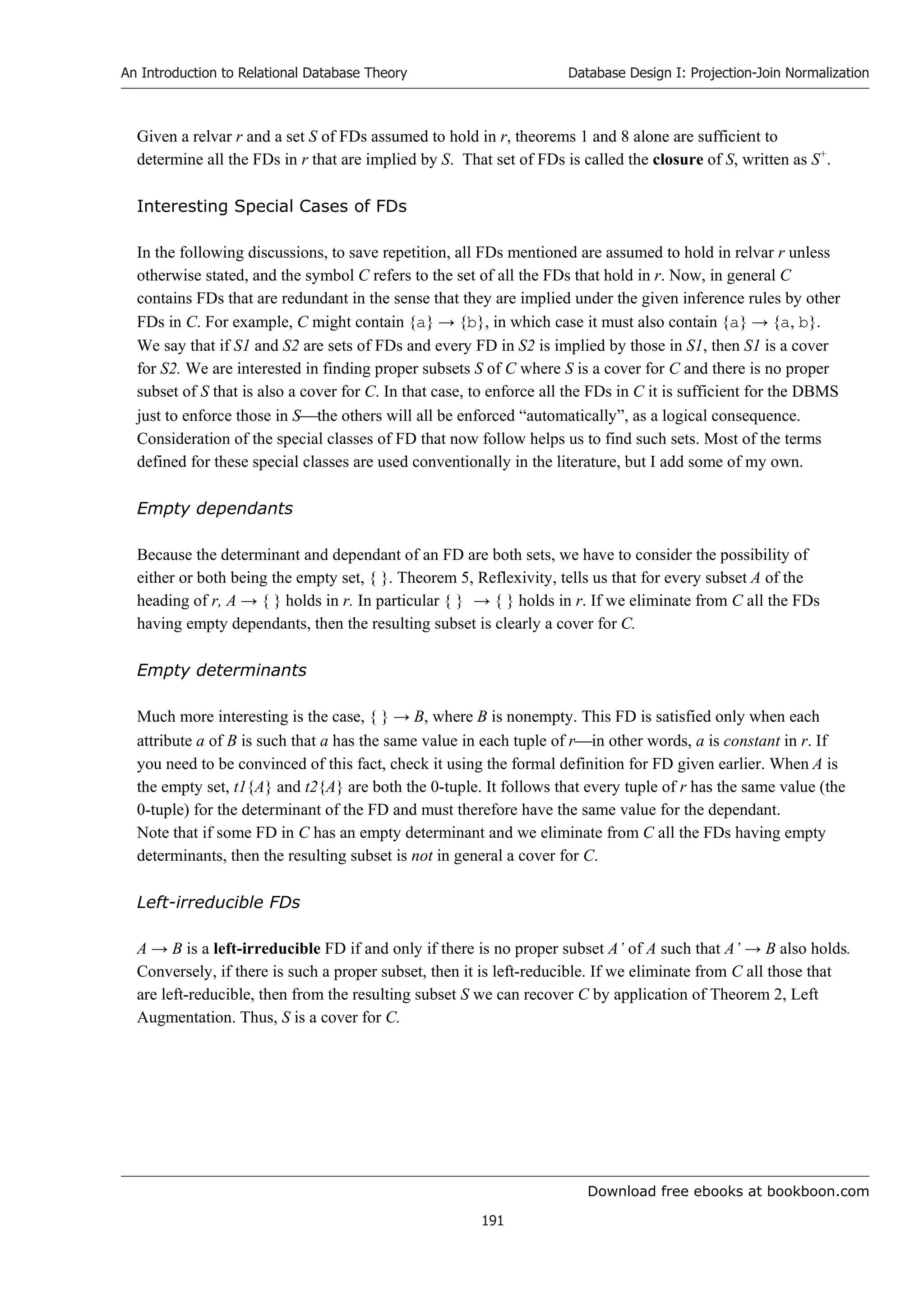
![Download free ebooks at bookboon.com
An Introduction to Relational Database Theory
192
Database Design I: Projection-Join Normalization
Right-irreducible FDs
A → B is a right-irreducible FD if and only if B contains at most one attribute. If B contains more than
one attribute, then the FD is right-reducible. If we eliminate from C all those that are right-reducible, then
from the resulting subset S we can recover C by application of Theorem 6, Union. Thus, S is a cover for C.
Right-extendible FDs
A → B is a right-extendible FD if and only if there is some proper superset B’ of B such that A → B’ also
holds. If we eliminate from C all those that are right-extendible, then from the resulting subset S we can
recover C by application of Theorem 3, Decomposition. Thus, S is a cover for C.
Overlapping FDs
The FD A → B is overlapping if A B (where “” denotes set intersection) is nonempty; otherwise it is
non-overlapping. If we eliminate from C all those that are overlapping, then from the resulting subset S we
can recover C by application of Theorem 6, Union. Thus, S is a cover for C.
Trivial FDs
The FD A → B is trivial if B is a subset of A; otherwise it is nontrivial. Note that if B is empty, then
A → B is trivial but non-overlapping. If we eliminate from C all those that are trivial, then from the
resulting subset S we can recover C by application of Theorem 5, Reflexivity. (Note that this elimination
subsumes the elimination of FDs with empty dependants.) Thus, S is a cover for C.
Interesting Cases of Sets of FDs
We are interested in sets S of FDs, where no proper subset of S is a cover for the closure S+
of S. In
general there can be many such subsets of S, of which two kinds are particularly useful.
Irreducible covers
A set S of FDs is irreducible if and only if it satisfies the following three conditions:
1. Every FD is S is right-irreducible.
2. Every FD is S is left-irreducible.
3. No proper subset of S is a cover for the closure S+
of S.
If S does satisfy those three conditions, then it is an irreducible cover for S+
. Note that condition 3 implies
that S contains no overlapping FDs, no trivial ones, and none that are implied by others under Theorem 4,
Transitivity. Some texts[3], for exampleuse the term nonredundant for sets that satisfy condition 3
but do not necessarily satisfy conditions 1 and 2.](https://image.slidesharecdn.com/an-introduction-to-relational-database-theory-230210032734-035be350/75/an-introduction-to-relational-database-theory-pdf-192-2048.jpg)

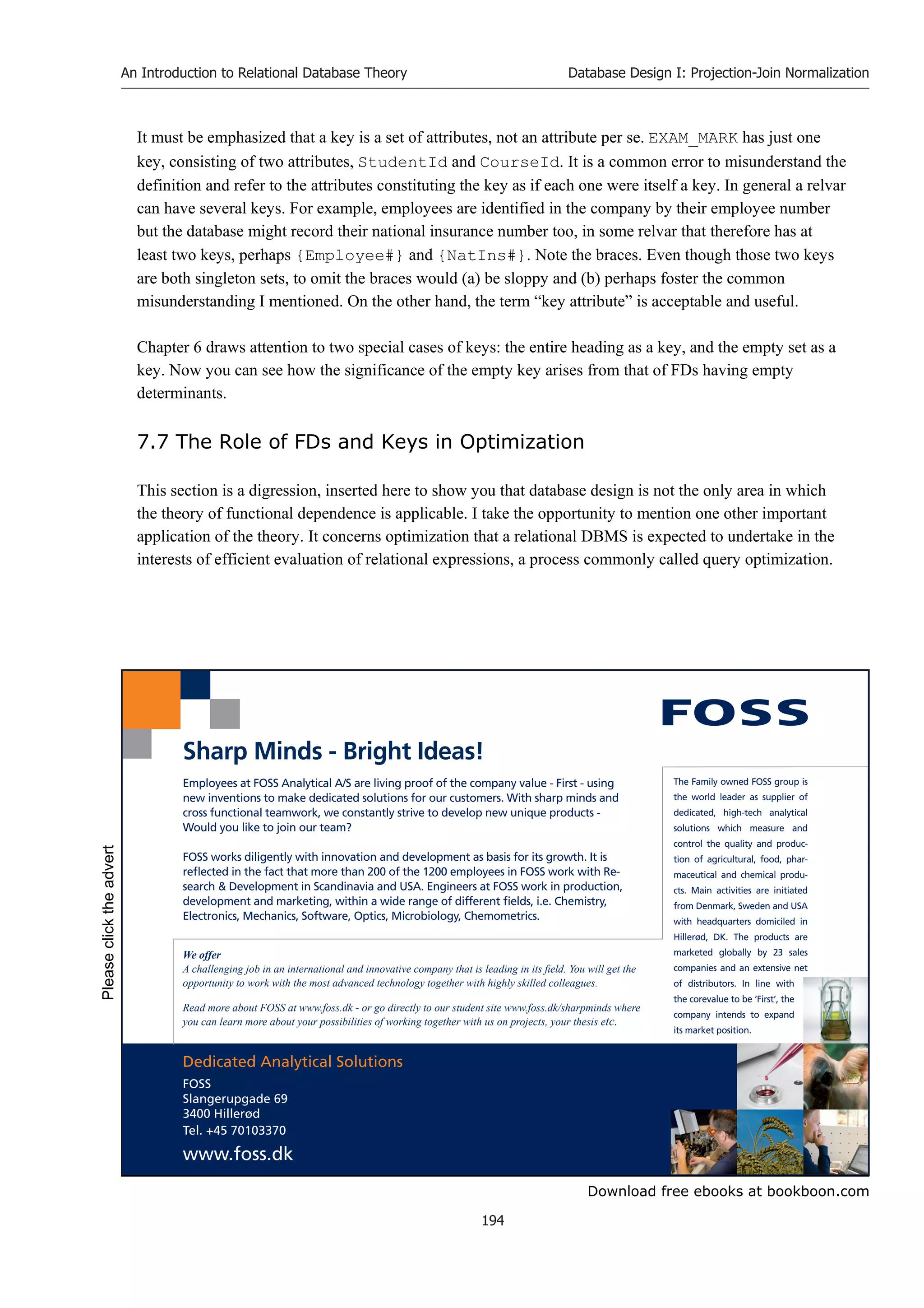
![Download free ebooks at bookboon.com
An Introduction to Relational Database Theory
195
Database Design I: Projection-Join Normalization
Just as the value assigned to a variable, by definition, varies from time to time, so also, as a consequence,
does the relation denoted by a relational expression that references one or more relvars. Therefore our
definition of “key” can be generalized to apply to relational expressions as well as to relvars. For example,
given that { StudentId, CourseId } is a key of EXAM_MARK, we can conclude (for example) that
{ StudentId } is a key of (for example) EXAM_MARK WHERE CourseId = CID('C1').
Constraining CourseId values to be constant in the result of that expression means that the FD { } →
{ CourseId } holds in it, because application of Theorem 8, Unification, to { } → { CourseId } and
{ StudentId, CourseId } → { Mark } yields { StudentId } → { Mark, CourseId }. A
subsequent projection over just StudentId and Mark (likely to be given because the constant
CourseId value is known) can be performed efficiently just by dropping the CourseId attribute with
no need to incur the overhead of detecting redundant duplicate tuplesthere cannot be anyand
eliminating them. If the DBMS can detect projections that preserve at least one key of the operand, then it
can evaluate those projections more efficiently.
Now consider the expression EXAM_MARK JOIN COURSE. Because { CourseId } is a key of
COURSE and CourseId is a common attribute for the join, there cannot be more than one matching
tuple in COURSE for any given tuple of EXAM_MARK. When the DBMS, evaluating this join, discovers a
matching COURSE tuple for a given EXAM_MARK tuple, it doesn’t need to look for another one: thanks to
its knowledge of keys, derived from its application of FD theory, it knows there cannot be oneand
looking for something that doesn’t exist usually takes rather longer than looking for and finding something
that does!
That completes the discussion of functional dependence and we can now return to projection-join
normalization, that special class of JDs that are implied by FDs. In so doing we will discover the normal
form that arises from it, called Boyce-Codd normal form after Raymond F. Boyce and E.F. Codd who
jointly first defined it, in [6].
7.8 Boyce-Codd Normal Form (BCNF)
Boyce-Codd normal form (BCNF) is important because (a) in practice, relvars that are in BCNF but not in
5NF are few and far between, and (b) we have a procedure for deriving, from a relvar that is not in BCNF,
an equivalent set of relvars that are in BCNF, and that procedure can be automated (there is no known
procedure for guaranteeing 5NF). BCNF is defined as follows.
Relvar r is in Boyce-Codd normal form (BCNF) if and only if the
determinant of every nontrivial functional dependency that holds in r is a
superkey of r.
Recall that an FD A → B is trivial if and only if B is a subset of A. To test for BCNF it is sufficient to
consider just the left-irreducible, non-overlapping FDs, whose determinants must then be not merely
superkeys, but keys of r. For convenience, I use the term rogue FD for a left-irreducible, non-overlapping
FD that holds in r but whose determinant is not a key of r.](https://image.slidesharecdn.com/an-introduction-to-relational-database-theory-230210032734-035be350/75/an-introduction-to-relational-database-theory-pdf-195-2048.jpg)
![Download free ebooks at bookboon.com
An Introduction to Relational Database Theory
196
Database Design I: Projection-Join Normalization
I introduced the subject of functional dependence by showing the special kind of JD from which a
corresponding FD can be derived. In practice the database designer will be looking for FDs that cause
BCNF to be violated. When such an FD is discovered, the designer needs to be able to derive the
corresponding JD to determine the decomposition needed to rectify the situation.
Let A, B and C be subsets of the heading of relvar r such that every attribute of r appears in at least one of
those subsets and the FD A → B holds in r. Then, thanks to a theorem due to Heath [14], we can conclude
that the JD *{AB, BC} holds in r. Heath’s theorem applies to relations, not relvars. It effectively states
that as a consequence of the FD A → B holding in the current value of r, that value is equal to the join of
its projections on AB and BC. As that FD must hold in every value that r can take, we can conclude that
the relvar itself is indeed subject to the JD *{AB, BC}.
Use of Heath’s theorem is advocated in many texts for determining decompositions to yield relvars that
are all in BCNF. In particular, if the following conditions on A, B, and C all hold, then r is not in BCNF:
Every attribute of r is an element of exactly one of A, B, and C.
A is not a key of r.
B is nonempty.
The FD A → B is nontrivial and left-irreducible.
In that case A → B is a rogue FD in r and a decomposition of r into relvars s with heading AB and t with
heading AC can be considered. If that decomposition is taken, then A → B holds in s rather than r and,
because A is a key of s, is no longer a rogue FD.
For example, consider ENROLMENT again. Then A = {StudentId}, B={Name}, and C = {CourseId},
giving us the decomposition we adopted into IS_CALLED with heading {StudentId, Name} and
IS_ENROLLED_ON with heading {StudentId, CourseId}. In this case the two relvars resulting
from the decomposition are both in BCNF, but it does not follow in general that s and t are in BCNF, for
there might be other rogue FDs in r, propagated in s or t and remaining as rogues. In any case, when there
is more than one rogue FD in r, decomposition into s and t is not always a well-advised step to take
towards a design in which each relvar is in BCNF, as you will see in the next section, Dependency
preservation.
It is easy to see that ENROLMENT is not in BCNF. The determinant, { StudentId }, of the only FD in
its minimal cover of FDs is a proper subkey and therefore by definition not a superkey of ENROLMENT.
Such FDs formed a basis for the definition, by Codd, of second normal form (2NF). Relvars in 2NF are
not necessarily in BCNF but it was thought that decomposition to “just 2NF” might be a useful first step
in a procedure to derive a complete BCNF design. Codd also defined third normal form (3NF), which
covered some additional rogue FDs not covered by 2NF. 3NF was at one time thought to eliminate all
cases of redundancy arising from FDs but Boyce showed that conclusion to be incorrecthence the
eventual arrival of BCNF. Some texts still advance 2NF and 3NF as useful steps on the way to BCNF but
the rationale for that escapes the present author and this book shall have no more to say about those
normal forms.](https://image.slidesharecdn.com/an-introduction-to-relational-database-theory-230210032734-035be350/75/an-introduction-to-relational-database-theory-pdf-196-2048.jpg)
![Download free ebooks at bookboon.com
An Introduction to Relational Database Theory
197
Database Design I: Projection-Join Normalization
Dependency preservation
Consider relvar SCDF with attributes S (for student), C (for course), D (for department), and F (for
faculty). Throughout the following discussion relvar names reflect the relevant attribute names in similar
fashion, allowing a relvar’s heading to be inferred from its name for convenience. Assume that the set {{C}
→ {D}, {D} → {F}} is a minimal cover for the FDs in SCDF. Then {S,C} is a key of SCDF (exercise:
prove that) and SCDF is clearly not in BCNF. If we apply Heath’s theorem to the FD {C} → {D}, we will
decompose SCDF into relvars CD and SCF with keys {C} and {S,C}, respectively. CD is in BCNF but
SCF is not. Applying Heath’s theorem to the rogue FD in SCF, we obtain relvars CF and SC, both in
BCNF. We now have three relvars, all in BCNF, but no relvar whose heading includes both D and F. As a
consequence, the constraint represented by the FD {D} → {F} cannot be expressed as a constraint on a
single relvar in this BCNF designthe FD has been “lost” in the decomposition. On the other hand, if
instead we start by applying Heath’s theorem to the FD {D} → {F}, then the resulting relvars are DF and
SCD with keys {D} and {S,C}, respectively. The FDs of the given cover are both “preserved” in this
decomposition, {D} → {F} in DF and {C} → {D} in SCD. DF is in BCNF but SCD is not. Applying
Heath’s theorem to the rogue FD in SCD, we obtain relvars CD and SC, both in BCNF. This time, both of
the original FDs are preserved in the decomposition.
A conclusion from the foregoing observations is that if repeated application of Heath’s theorem is the
procedure adopted for achieving BCNF designs, then sometimes one has to take care of the order in which
binary decompositions are taken if one wishes to avoid needlessly complex constraints. The problem is
neatly avoided, where possible, in the following procedure, given by Date in [8], Chapter 12,xxiv
which
guarantees to preserve all FDs but in some comparatively rare cases yields relvars that are still not in
BCNF. Let r be a relvar and let S be a minimal cover for the FDs that hold in r. Then:
1. Initialize D to the empty set.
2. For each FD X → Y in S, form the relvar XY with heading XY and replace D by the union of D
and {XY}.
3. Let Z be a relvar whose heading consists of the attributes of r that are not included in the heading
of any relvar in D; if the heading of Z is nonempty, replace D by the union of D and {Z}.
4. If no relvar in D includes in its heading some key of r, then let K be a relvar whose heading
consists of the attributes of some key of r, arbitrarily chosen, and replace D by the union of D
and {K}.
Under Date’s procedure each FD in S is guaranteed to be preserved in some relvar in D. However, there
might be some relvars in D that are still not in BCNFwe will come to the circumstances in which these
can arise later. To derive a complete BCNF design from D we must add the following step:
5. If D contains any relvars that do not satisfy BCNF, then:
(a) Let T be any one of those relvars, let H be the heading of T, and let X → Y be a rogue
FD in T.
(b) Replace T in D by two relvars, T' resulting from the projection of T over XY and T''
resulting from the projection of T over H-Y (an application of Heath's Theorem).](https://image.slidesharecdn.com/an-introduction-to-relational-database-theory-230210032734-035be350/75/an-introduction-to-relational-database-theory-pdf-197-2048.jpg)
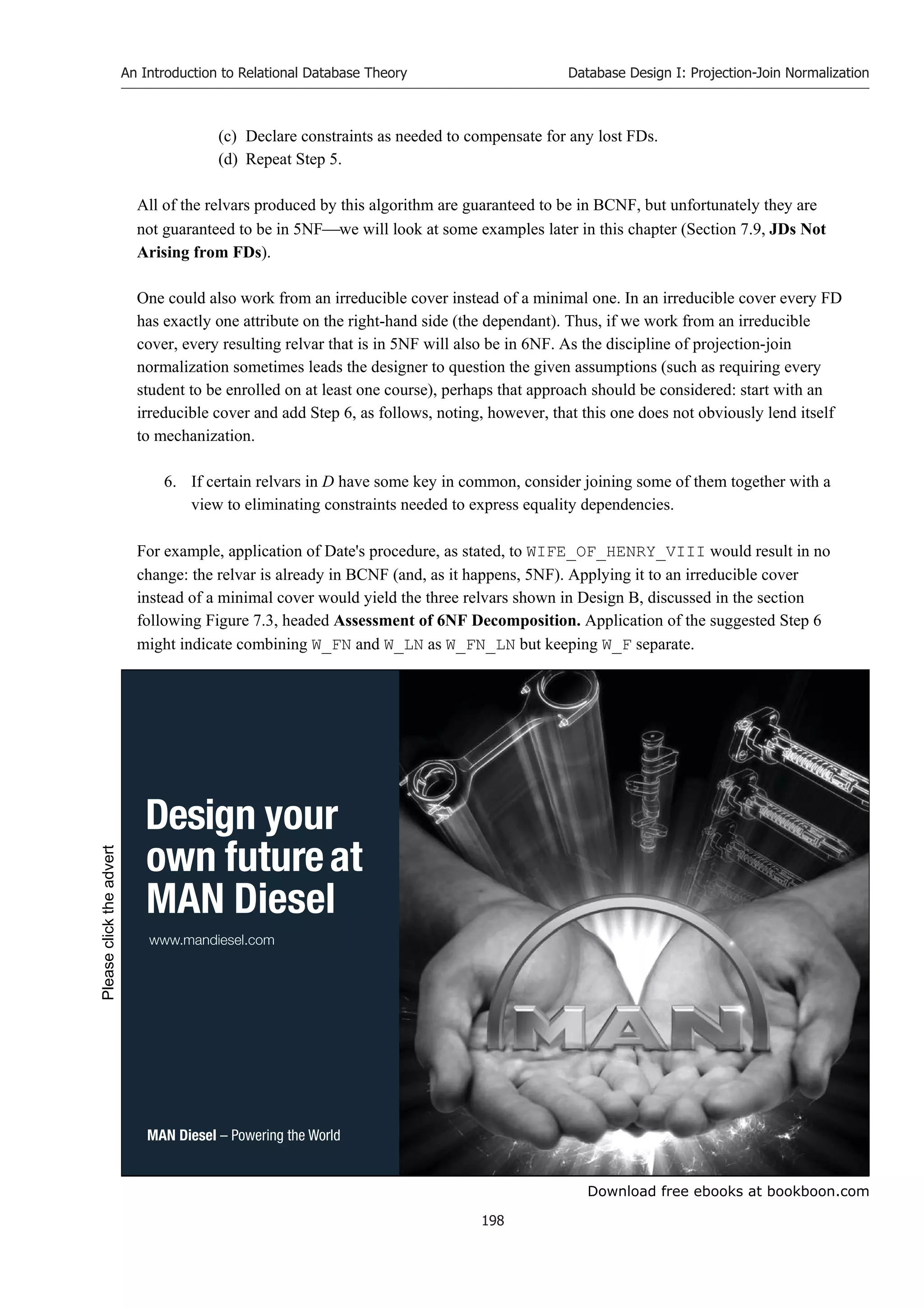
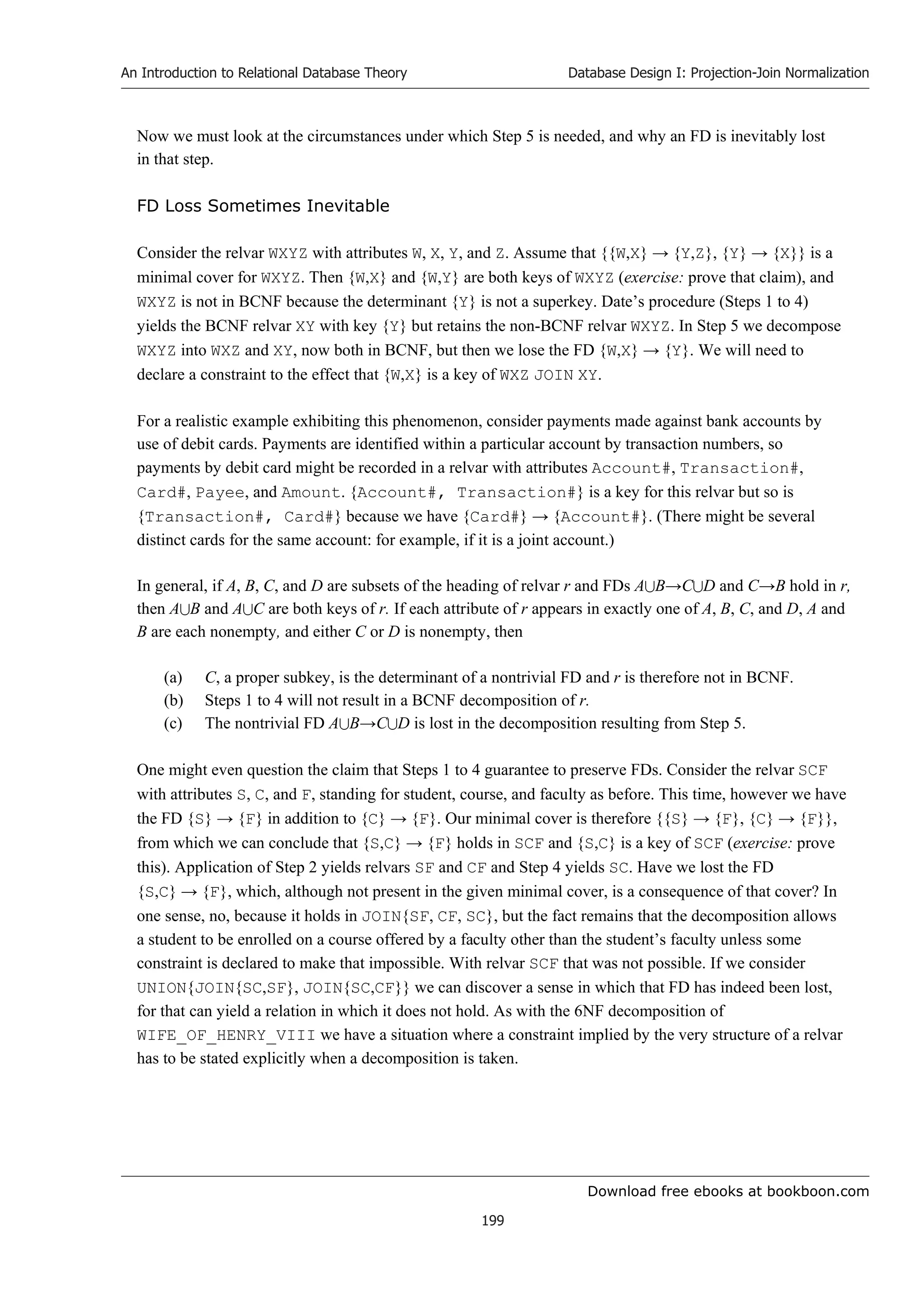
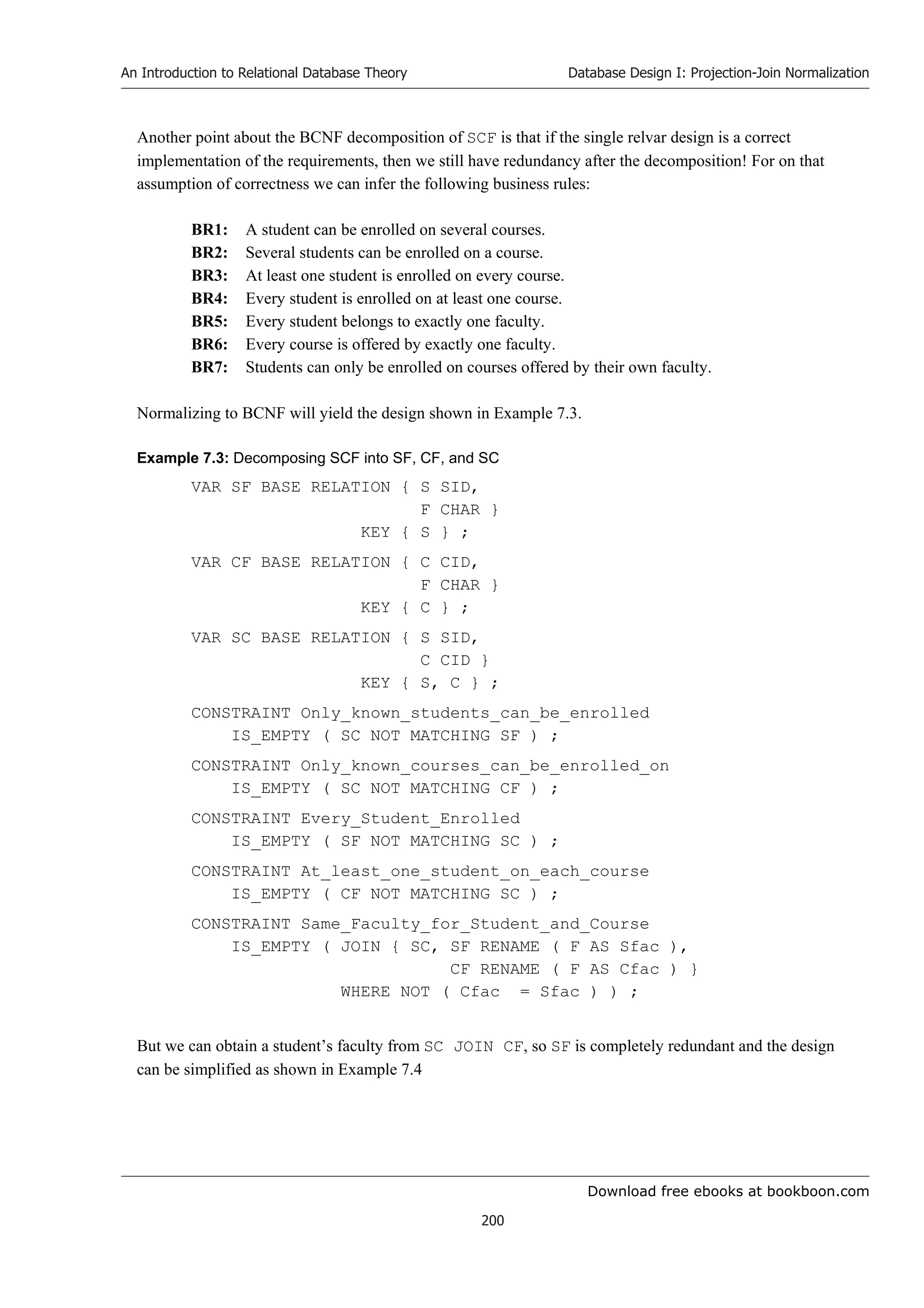

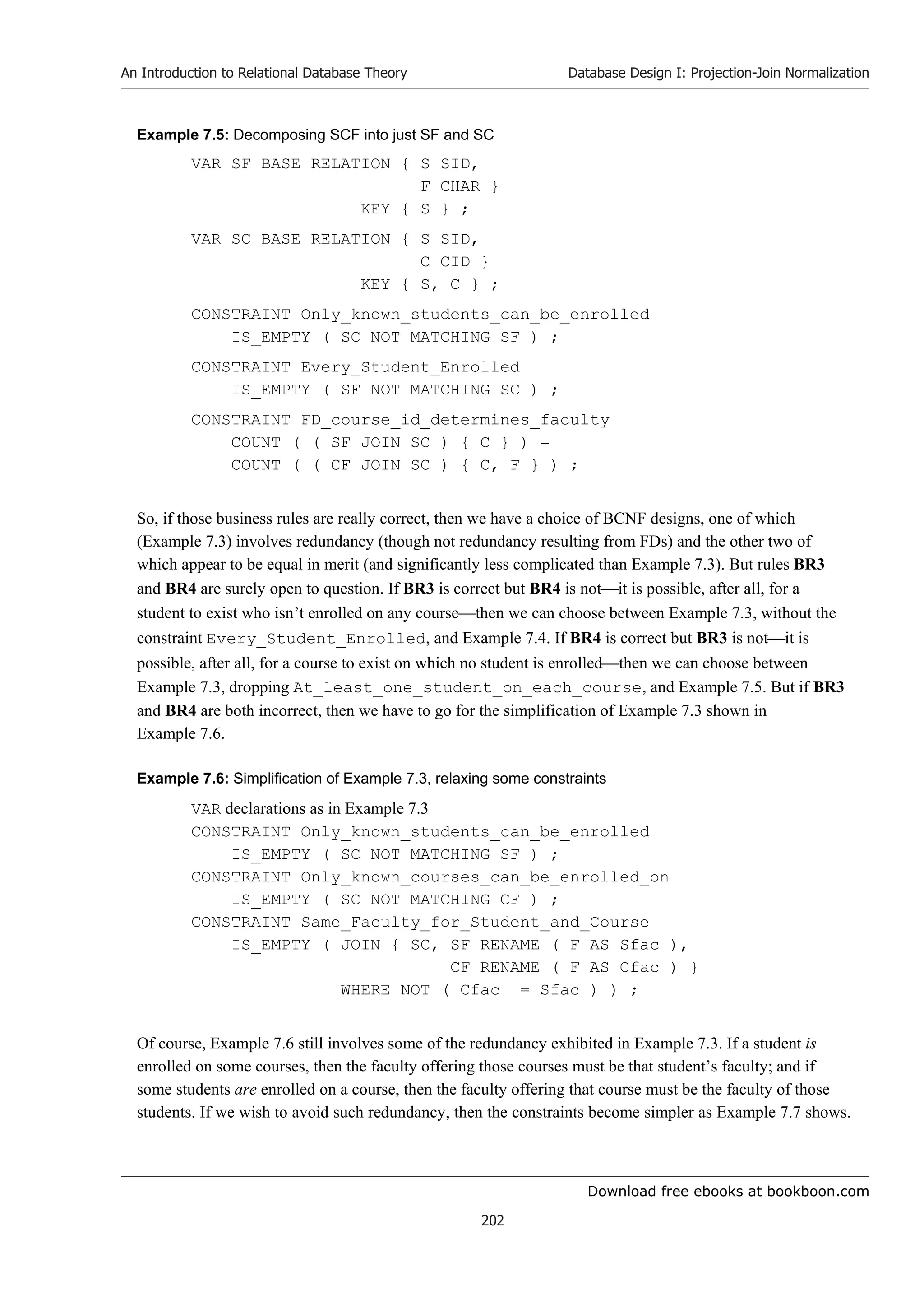
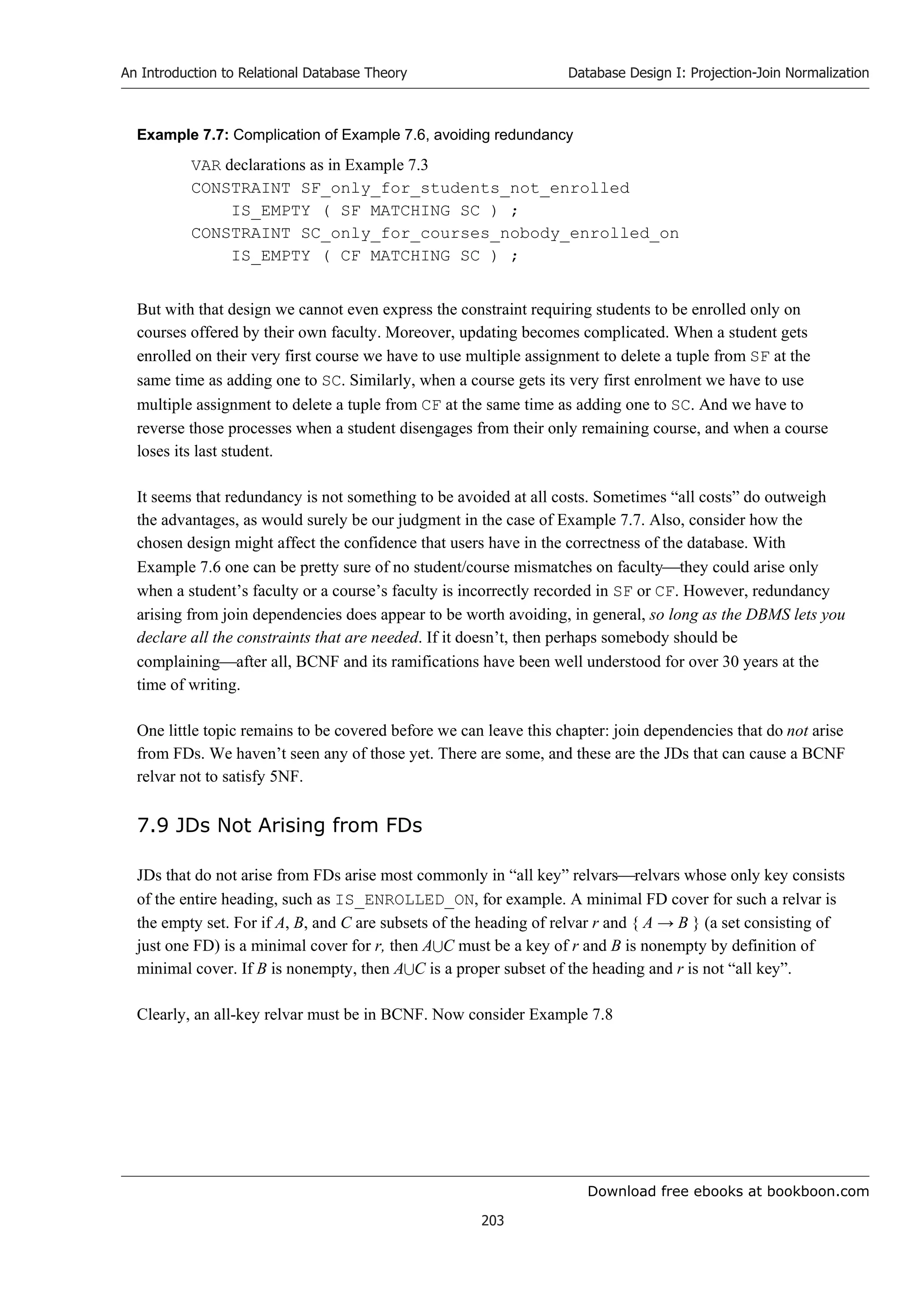
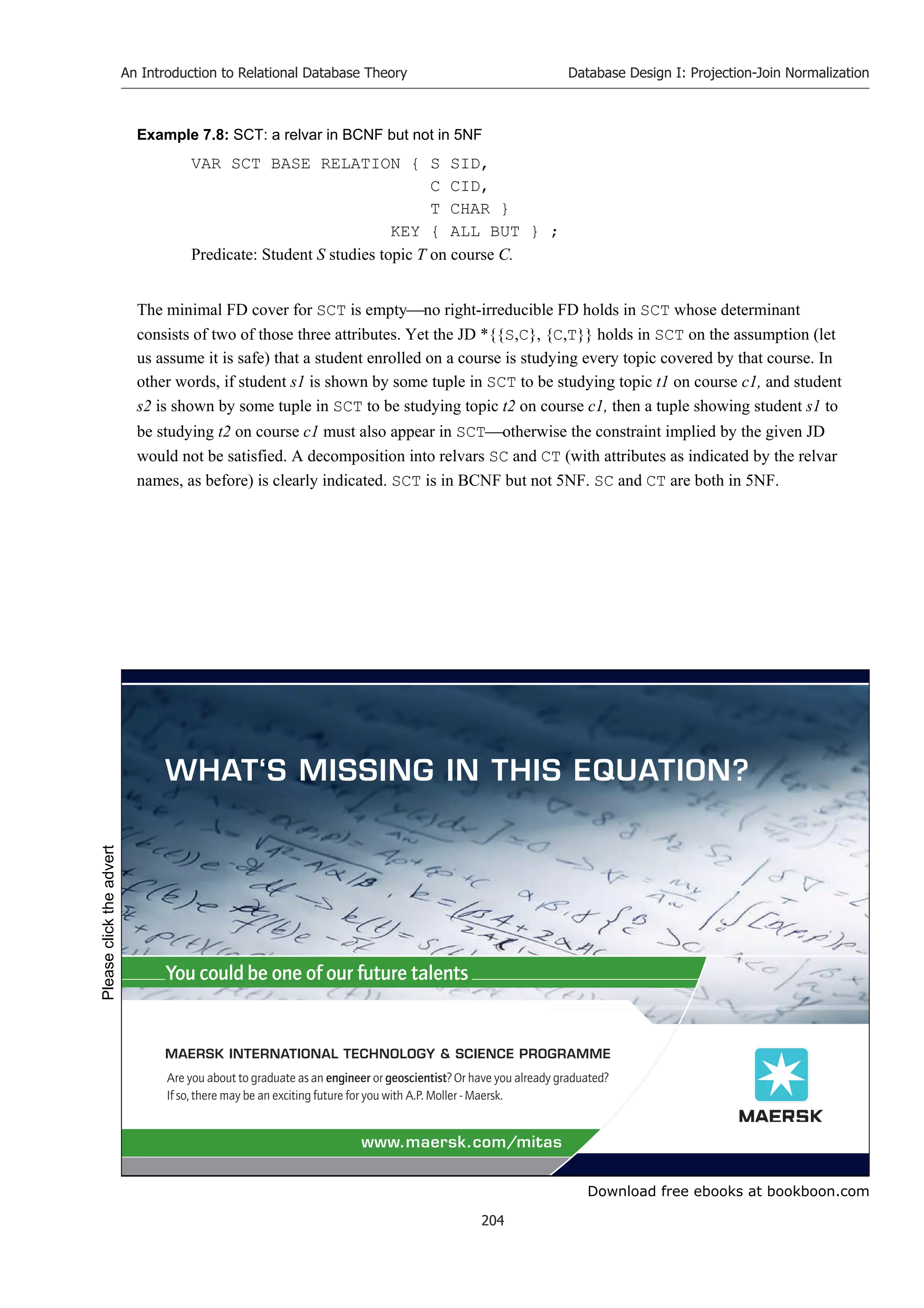
![Download free ebooks at bookboon.com
An Introduction to Relational Database Theory
205
Database Design I: Projection-Join Normalization
Observations similar to those made in connection with decompositions indicated by FDs apply here too. If
the decomposition into SC and CT really is required to be equivalent to SCT, then every course that covers
at least one topic must have at least one student on it, and every course on which at least one student is
enrolled must cover at least one topic. A constraint with condition equivalent to SC{C} = CT{C} needs to
be declared. But the putative business rule giving rise to a requirement for such a constraint is
questionable. Can’t a course exist before any students are enrolled on it? Does every course have to be
subdivided into topics? The decomposition allows enrolments and coverage of topics to be recorded
independently of each otherwhich seems intuitively sensible in any case.
Now, when BCNF was first introduced it was known that relvars like SCT existed that are in BCNF and
yet exhibit redundancy that can be avoided by taking projections. It was some time later that these cases
were carefully studied, the concept of JD was formulated as a generalization of FD, and even stronger
normal forms were defined to fill the remaining gaps left by BCNF. As 2NF and 3NF have already been
mentioned as concepts previously essayed but later superseded (by BCNF), you must be wondering about
the apparent numerical gap between 3NF and 5NF. Well, SCT is in fact in violation of 4NF as well as 5NF.
Observe that the JD *{{S,C}, {C,S}} that causes SCT to violate 5NF is a binary JD in particular. It is
because that JD is binary that SCT violates 4NF. 4NF was originally defined, not in terms of JDs in
general, but in terms of a kind of dependency called multi-valued dependency (MVD), of which a
functional dependency is a special case. However, it turns out that every MVD is equivalent to a certain
binary JD, so we no longer really need to study MVDsthe interested reader can easily find out about
them in the literature.
It follows from the definition of 4NF that any relvar that is in 4NF but not 5NF must be subject to a
nonredundant JD of degree greater than two (where a JD is redundant if and only if at least one of its
projections is redundant). Moreover, that JD must be such that it’s not merely a consequence of two or
more binary JDs, unlike the nontrivial ternary JD we noted in WIFE_OF_HENRY_VIII. A relvar subject
to such a JD cannot be decomposed into 5NF relvars by a succession of two-way decompositionsagain,
unlike WIFE_OF_HENRY_VIII, which we decomposed in two stages. The study of such relvars
eventually led to 4NF being subsumed by 5NF. We must now complete the story of projection-join
normalization by showing that such JDs (let’s call them irreducible non-binary JDs), and therefore such
relvars, do indeed exist.
Irreducible non-binary JDs
Here again is the definition I gave earlier for fifth normal form:
Relvar r is in fifth normal form (5NF) if and only if every join dependency
that holds in r is implied by the keys of r.
We can retrospectively define 4NF just by inserting the word “binary” immediately before “join” in the
definition of 5NF. The JD *{{S,C}, {C,T}} holds in SCT and it is intuitively clear that, given that the only
key of SCT is the entire heading, we cannot deduce from that fact alone that this JD holds (as is confirmed
by application of the algorithm given under reference [12] in Appendix B).](https://image.slidesharecdn.com/an-introduction-to-relational-database-theory-230210032734-035be350/75/an-introduction-to-relational-database-theory-pdf-205-2048.jpg)
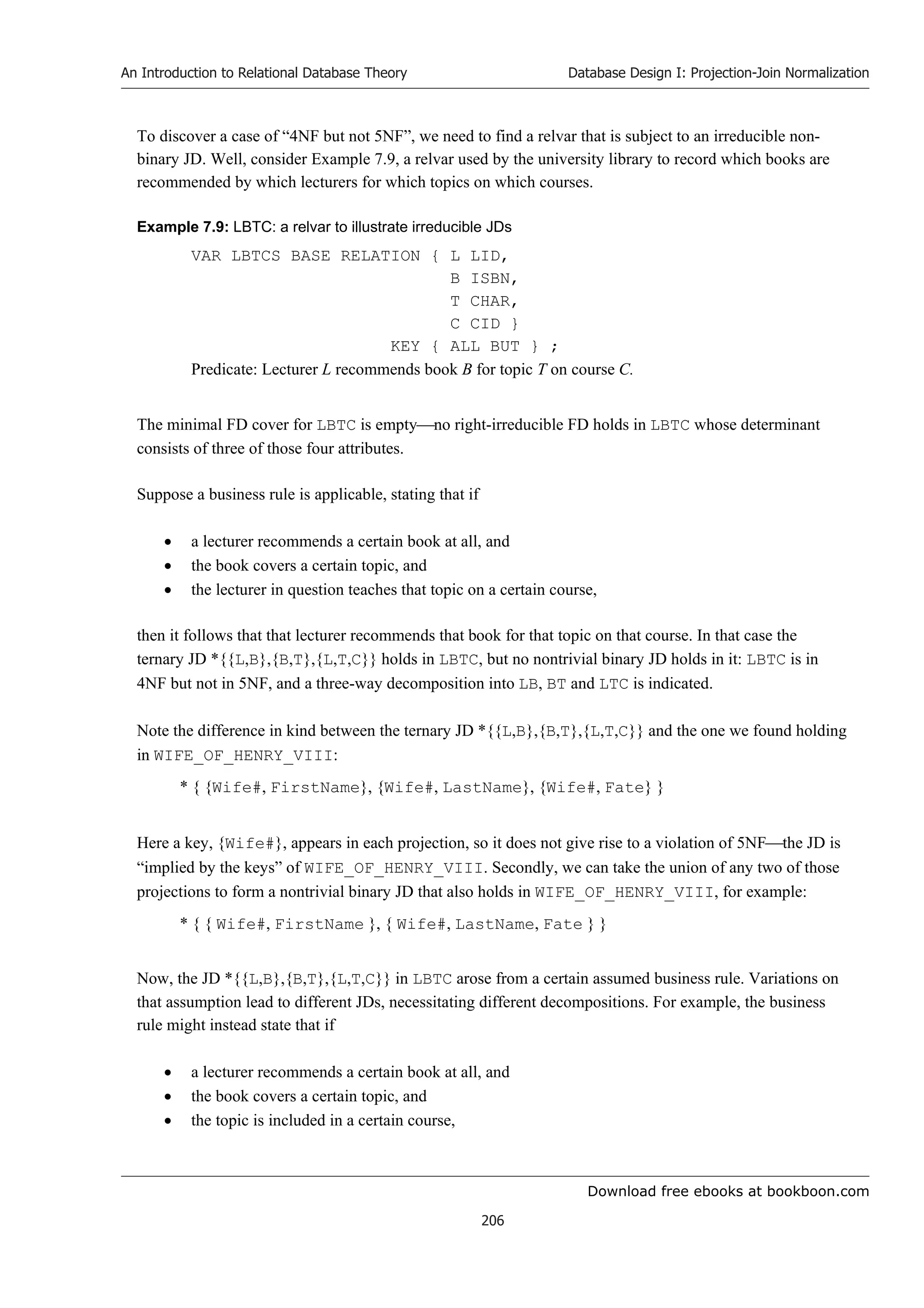
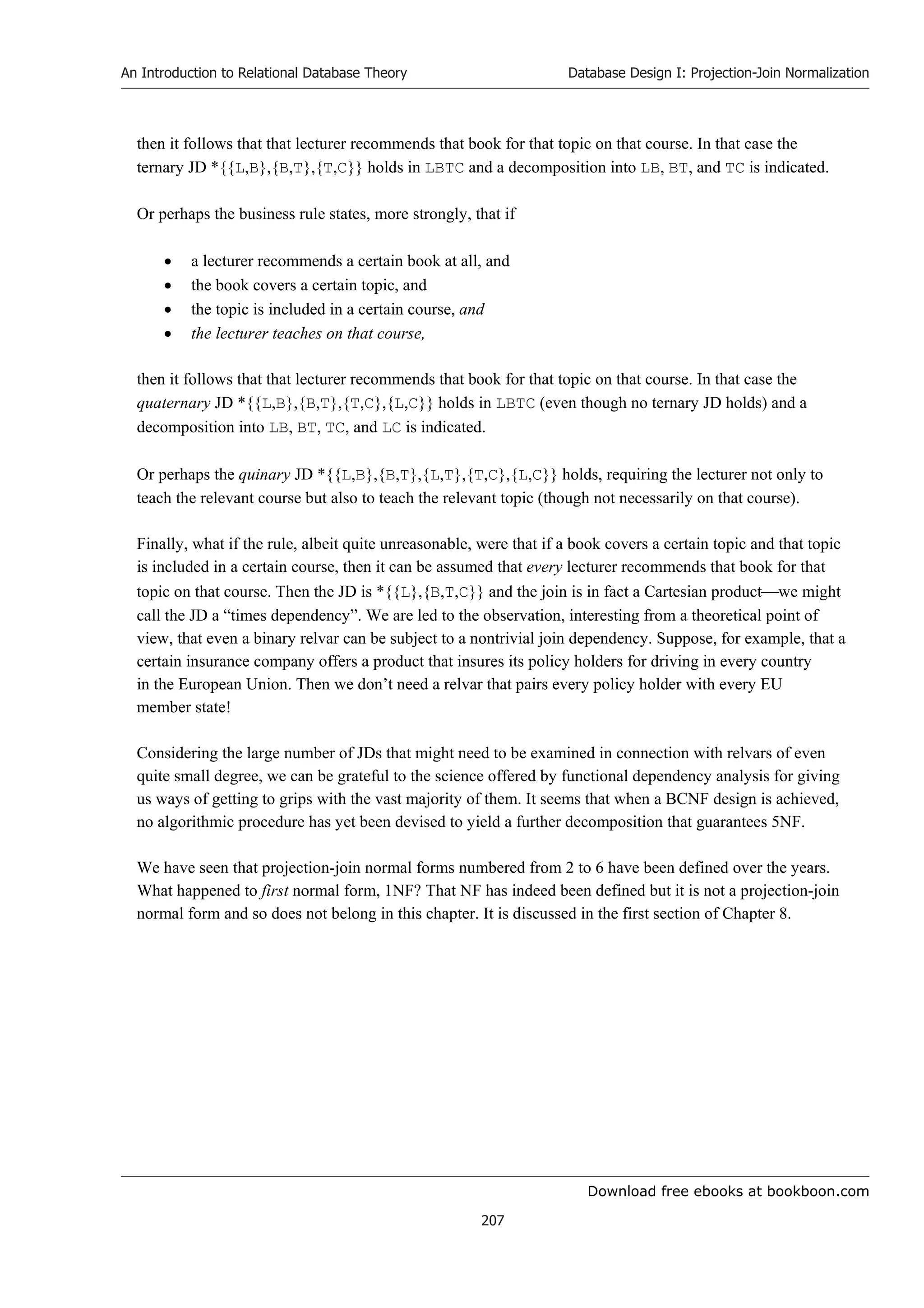
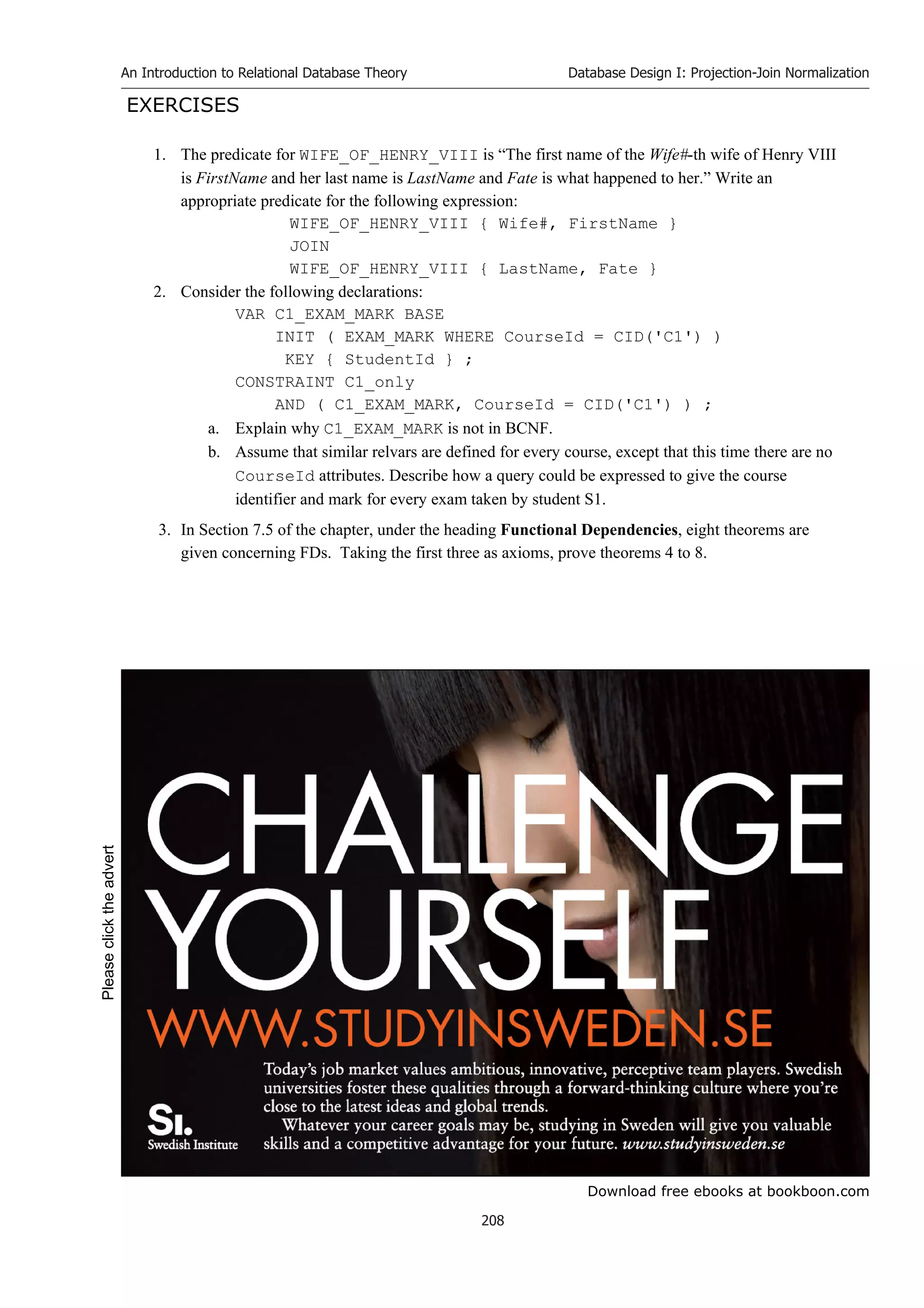
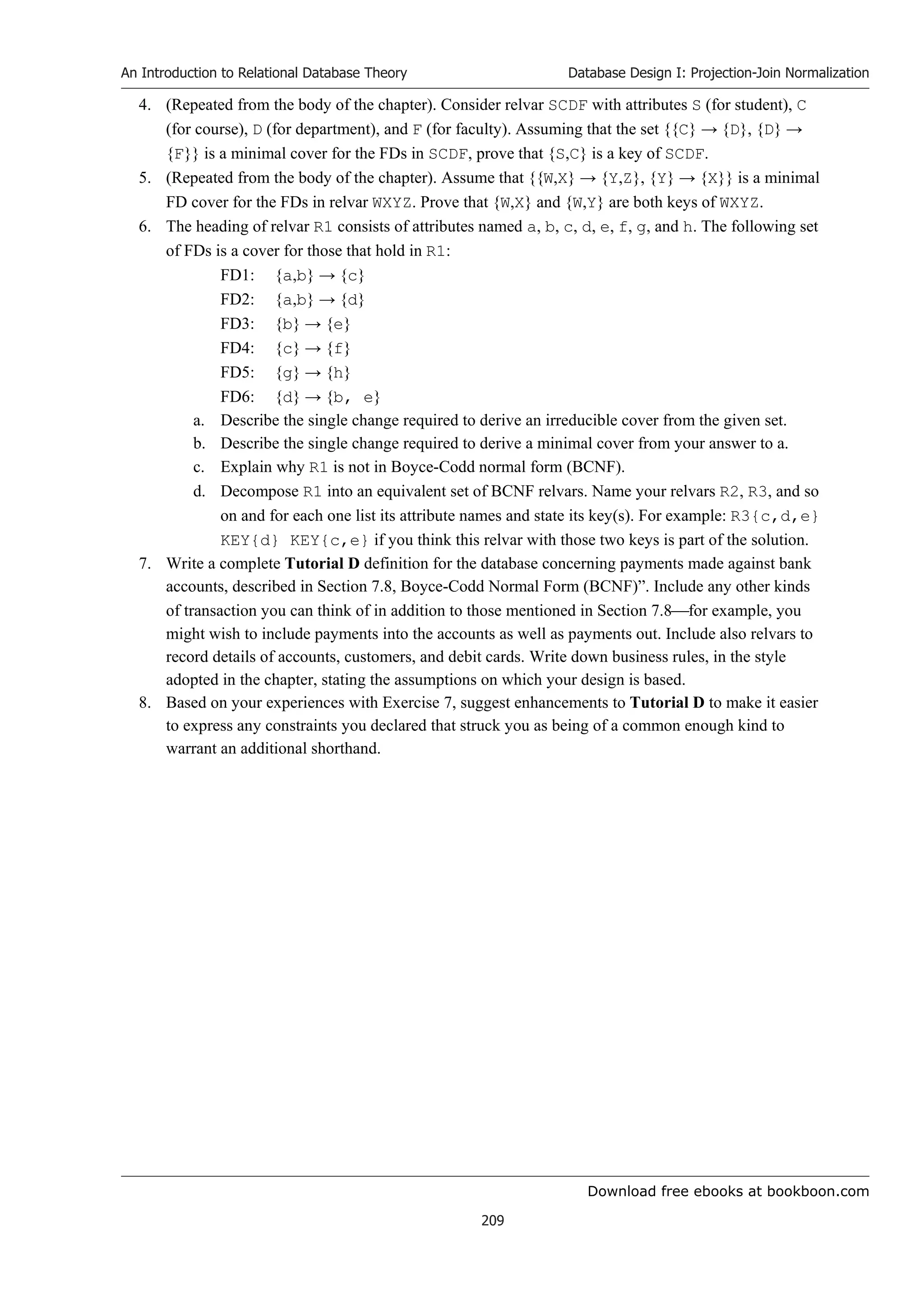
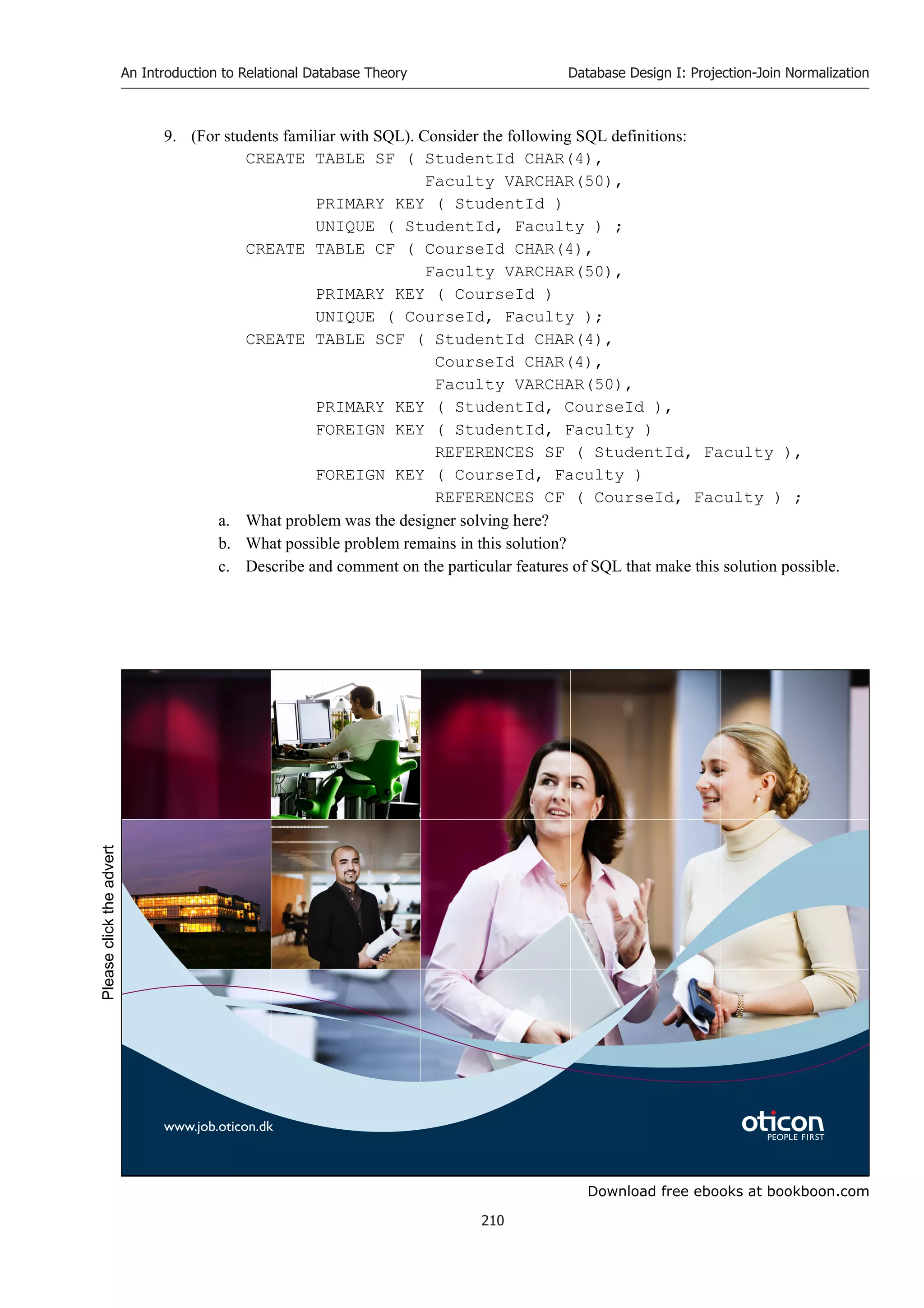
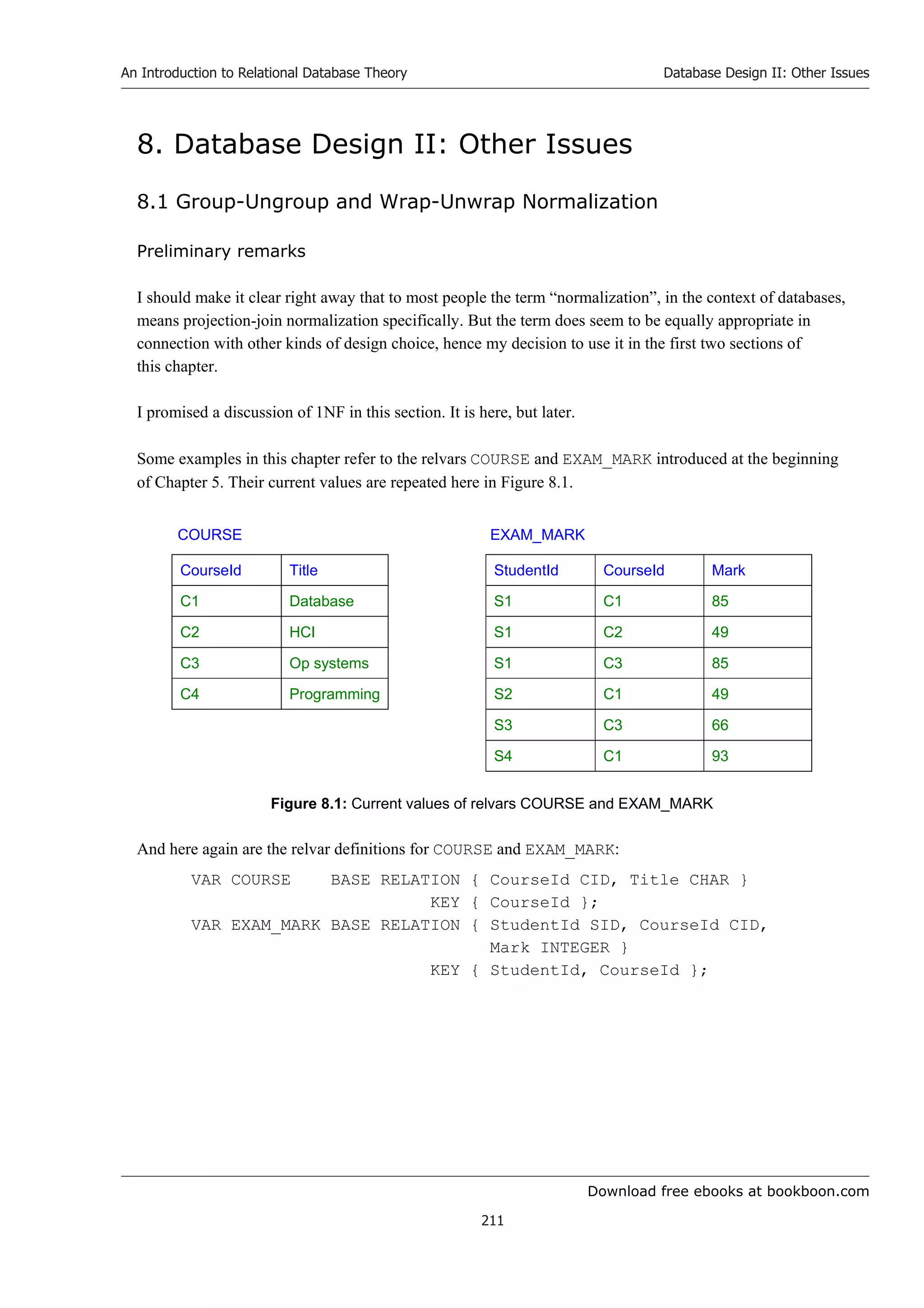

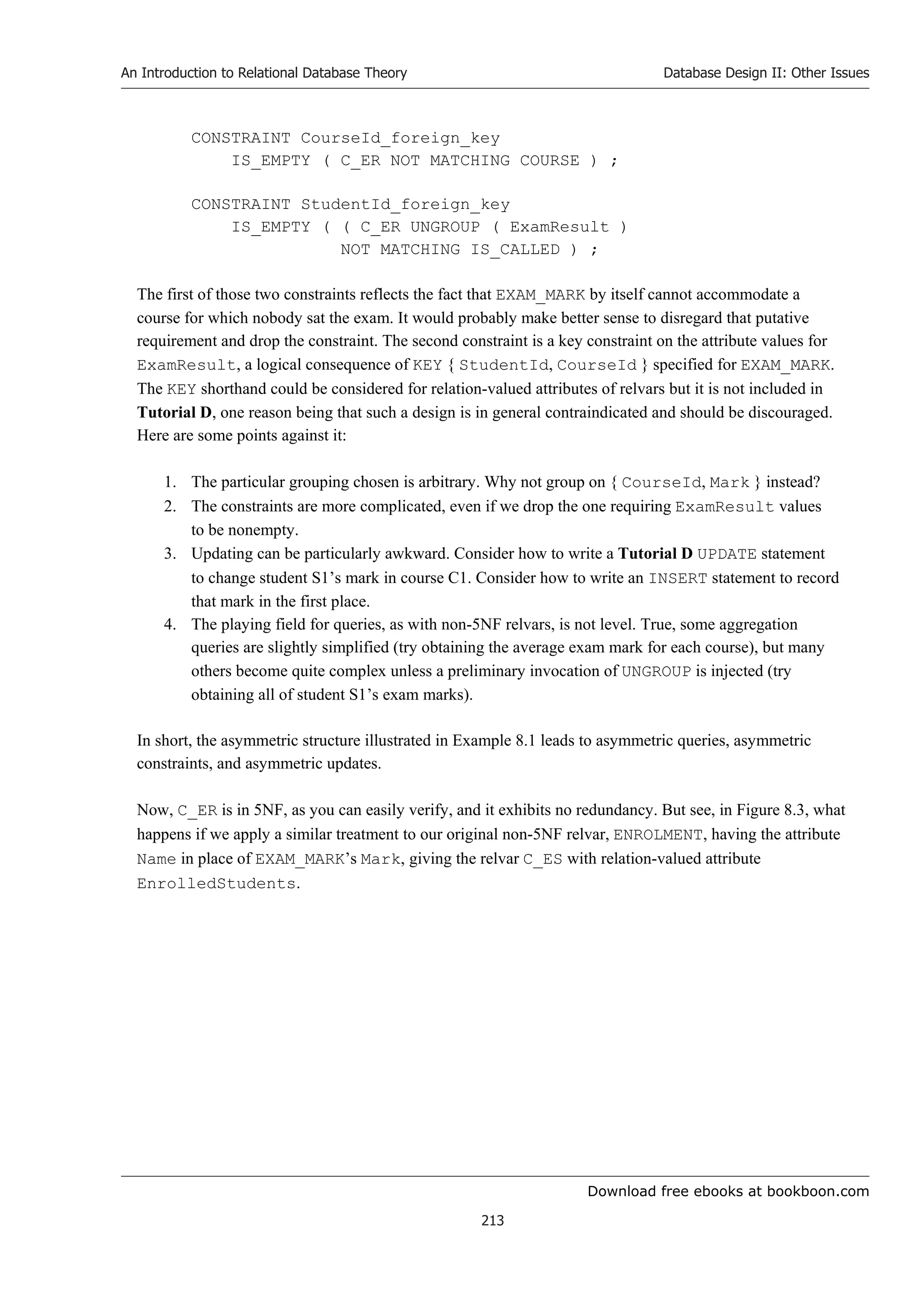
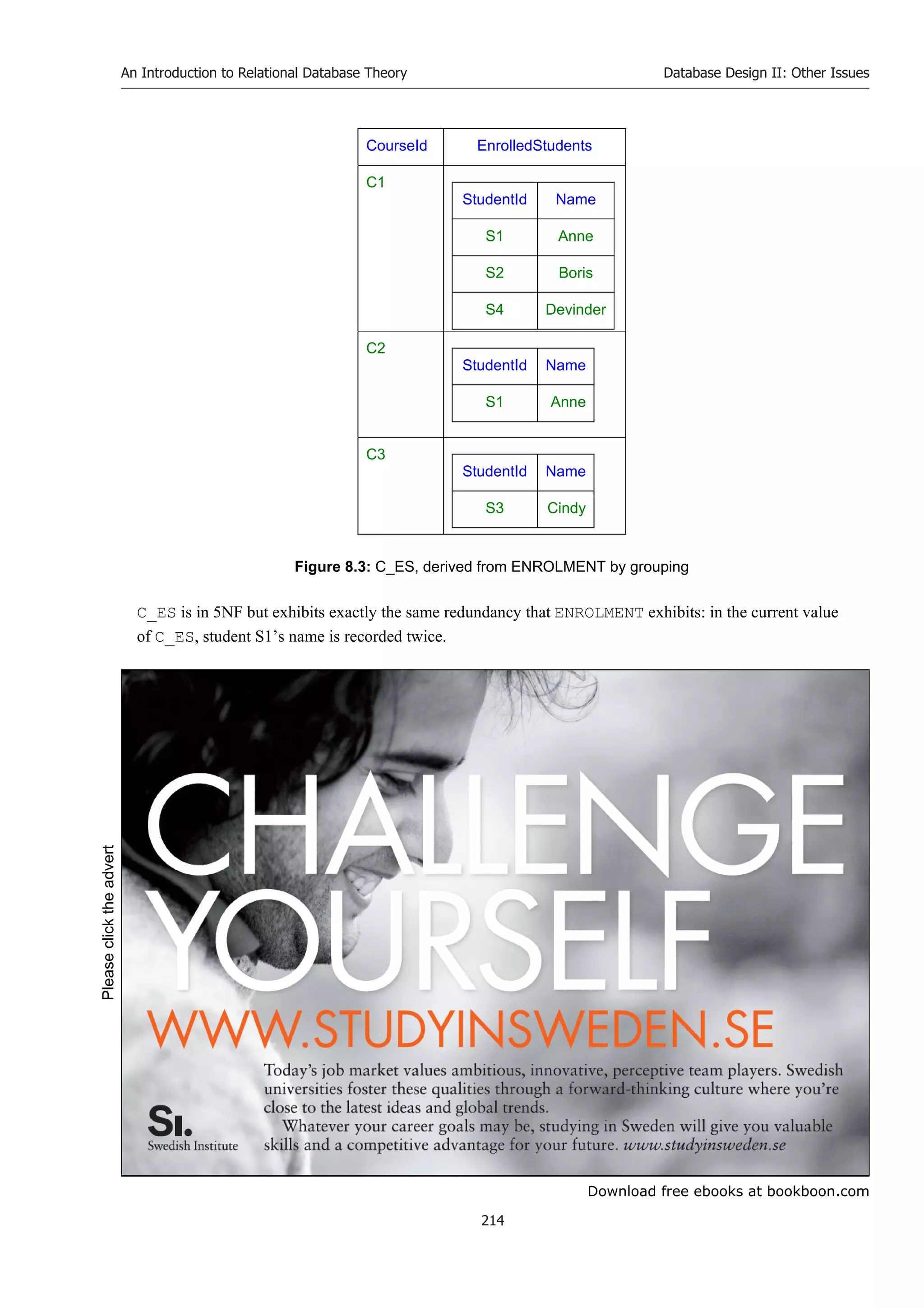
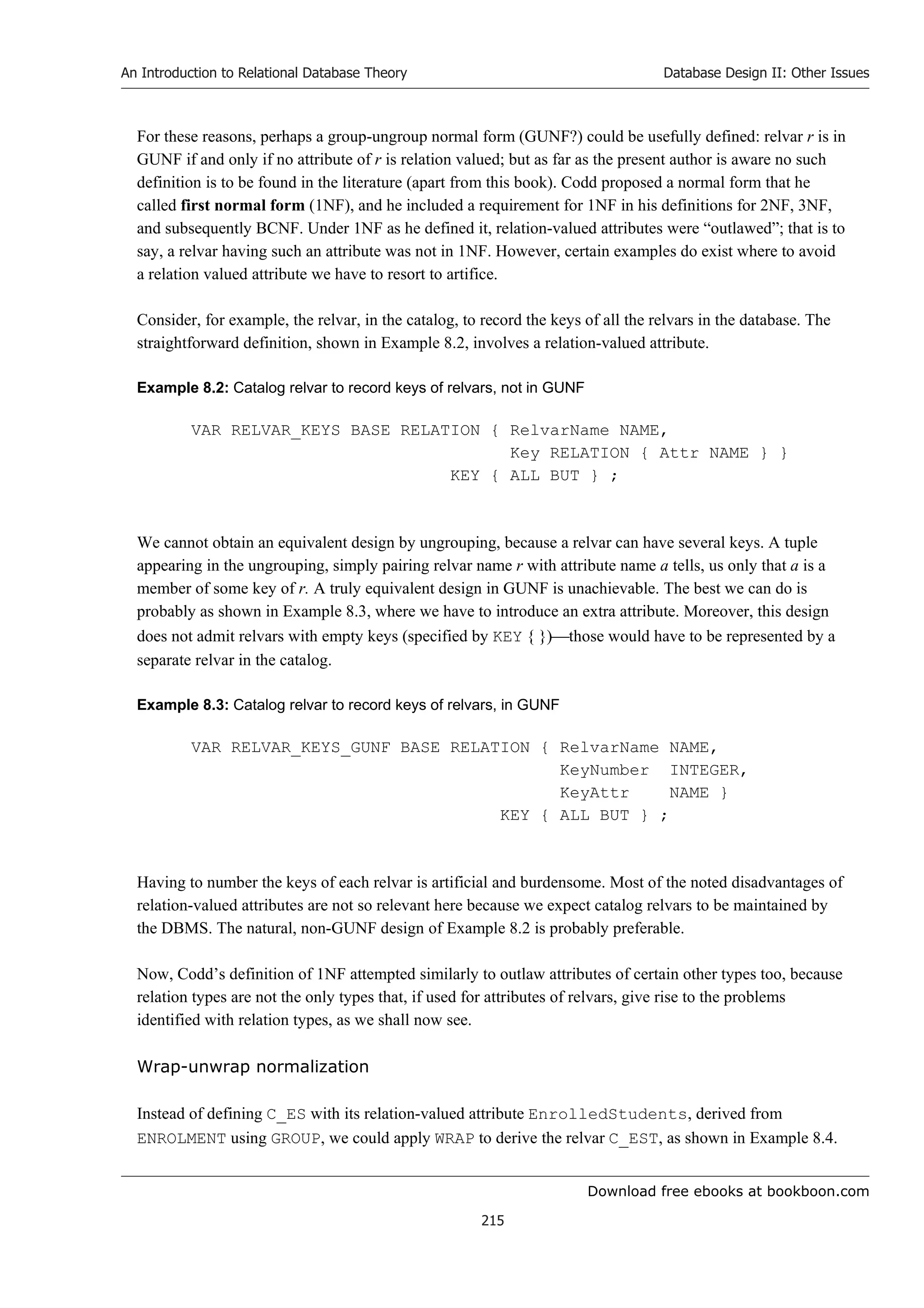
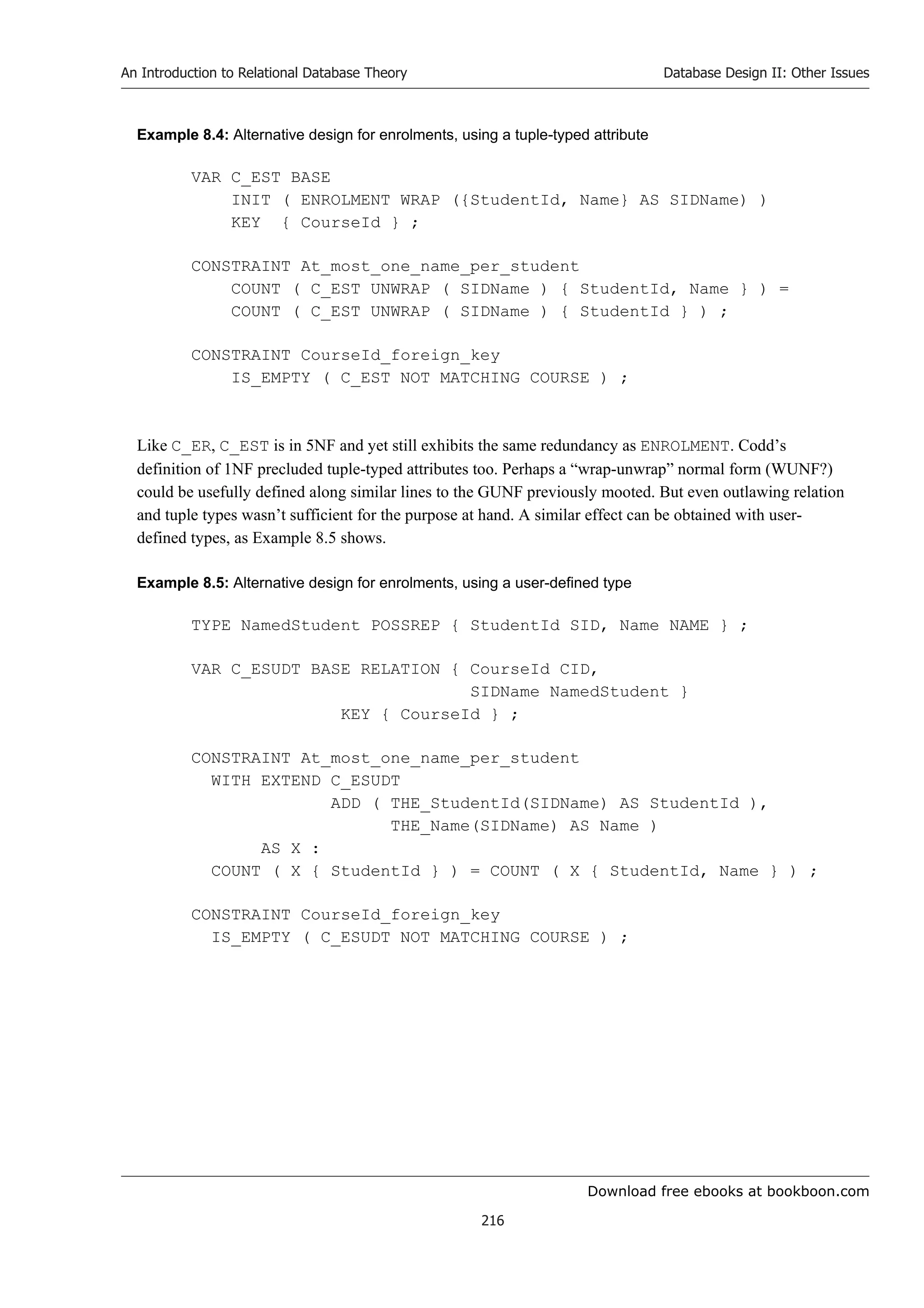
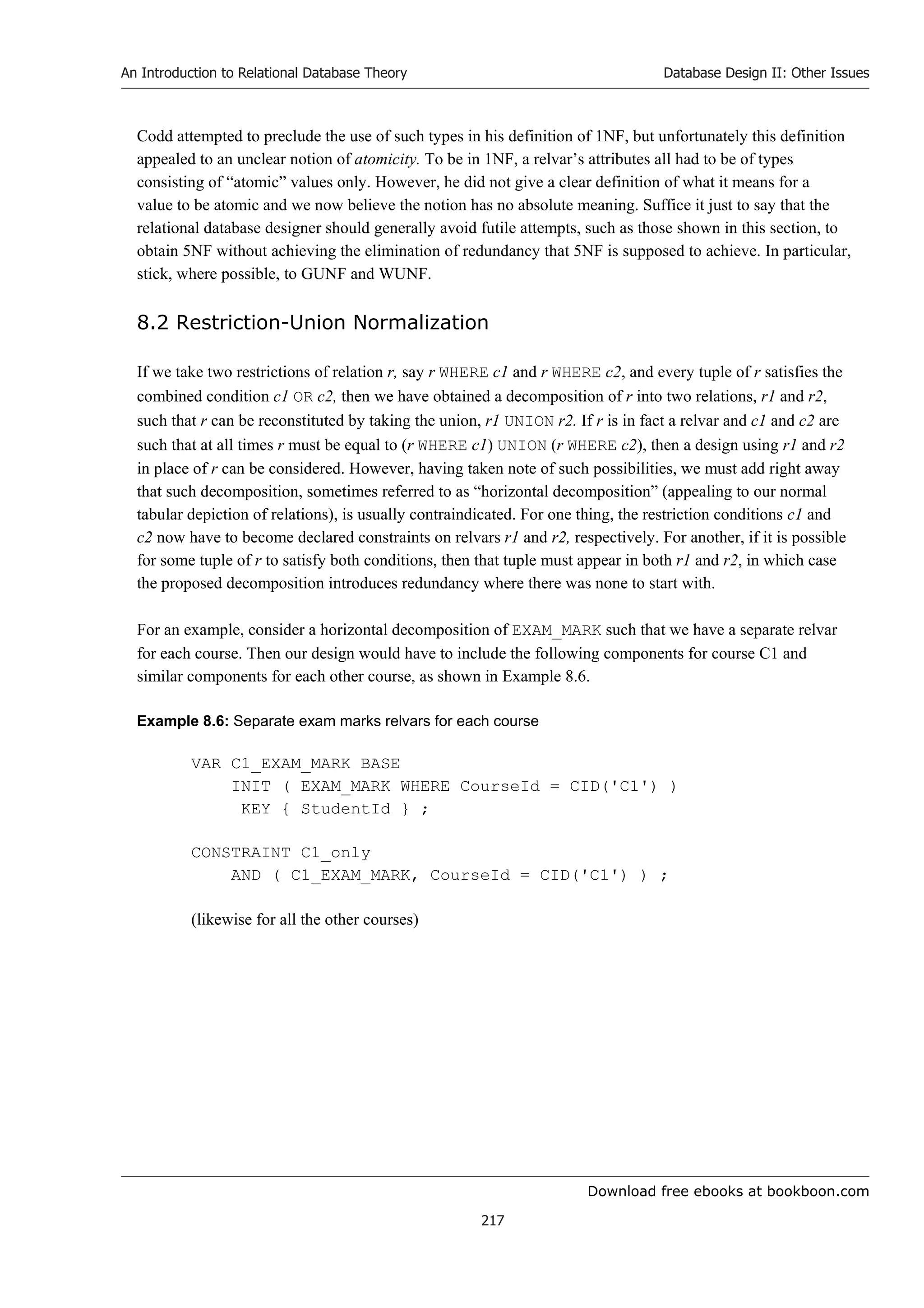

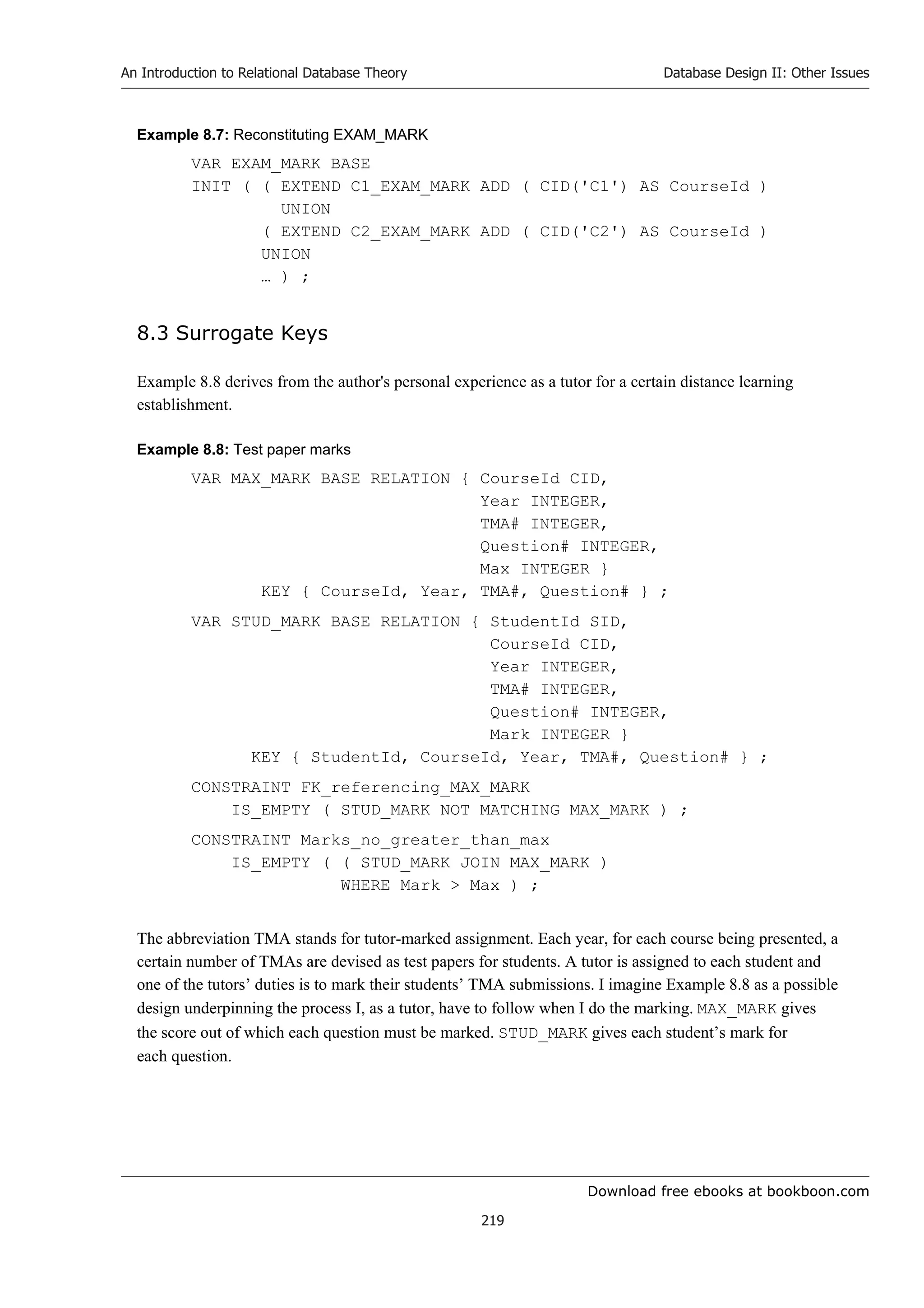
![Download free ebooks at bookboon.com
An Introduction to Relational Database Theory
220
Database Design II: Other Issues
Now, some designers would worry about the repetition of attributes CourseId, Year, TMA#, and
Question# in the two relvars of Example 8.8, these attributes constituting the foreign key defined by
the constraint FK_referencing_MAX_MARK. (In the actual scenario from which this example was
derived the situation is exacerbated because questions are divided into separately marked parts and
subparts, adding two more attributes to both keys.) Somehow it would seem more efficient if MAX_MARK
had a key consisting of just one attribute, and then STUD_MARK’s foreign key would in turn consist of a
single attribute corresponding to that singleton key in MAX_MARK.
Example 8.9: Test paper marks, using a surrogate key
VAR MAX_MARK BASE RELATION { QuestionId QID,
CourseId CID,
Year INTEGER,
TMA# INTEGER,
Question# INTEGER,
Max INTEGER }
KEY { CourseId, Year, TMA#, Question# }
KEY { QuestionId } ;
VAR STUD_MARK BASE RELATION { QuestionId QID,
StudentId SID,
Mark INTEGER }
KEY { QuestionId, StudentId } ;
CONSTRAINT FK_referencing_MAX_MARK
IS_EMPTY ( STUD_MARK NOT MATCHING MAX_MARK ) ;
CONSTRAINT Marks_no_greater_than_max
IS_EMPTY ( ( STUD_MARK JOIN MAX_MARK )
WHERE Mark Max ) ;
The singleton key of MAX_MARK is called, slightly inappropriately, a surrogate key. (A surrogate is a
person or thing taking the place of another. The key in question here must clearly sit alongside, not in
place of, the one that must be specified in any casea point sometimes overlooked by advocates of
surrogate keys. The thing that really “take[s] the place of another” is the foreign key attribute of
STUD_MARK.)
Now, it might well be the case that the performance characteristics of the DBMS are such that the design
in Example 8.9 speeds up most of the anticipated tasks in maintaining and using the database. But in
general the technique should be viewed circumspectly, taking into account the following considerations,
possibly negating those perceived performance gains:
Example 8.9 involves an extra key constraint.
Many queries on STUD_MARK need a join with MAX_MARK in Example 8.9, not needed in
Example 8.8.](https://image.slidesharecdn.com/an-introduction-to-relational-database-theory-230210032734-035be350/75/an-introduction-to-relational-database-theory-pdf-220-2048.jpg)
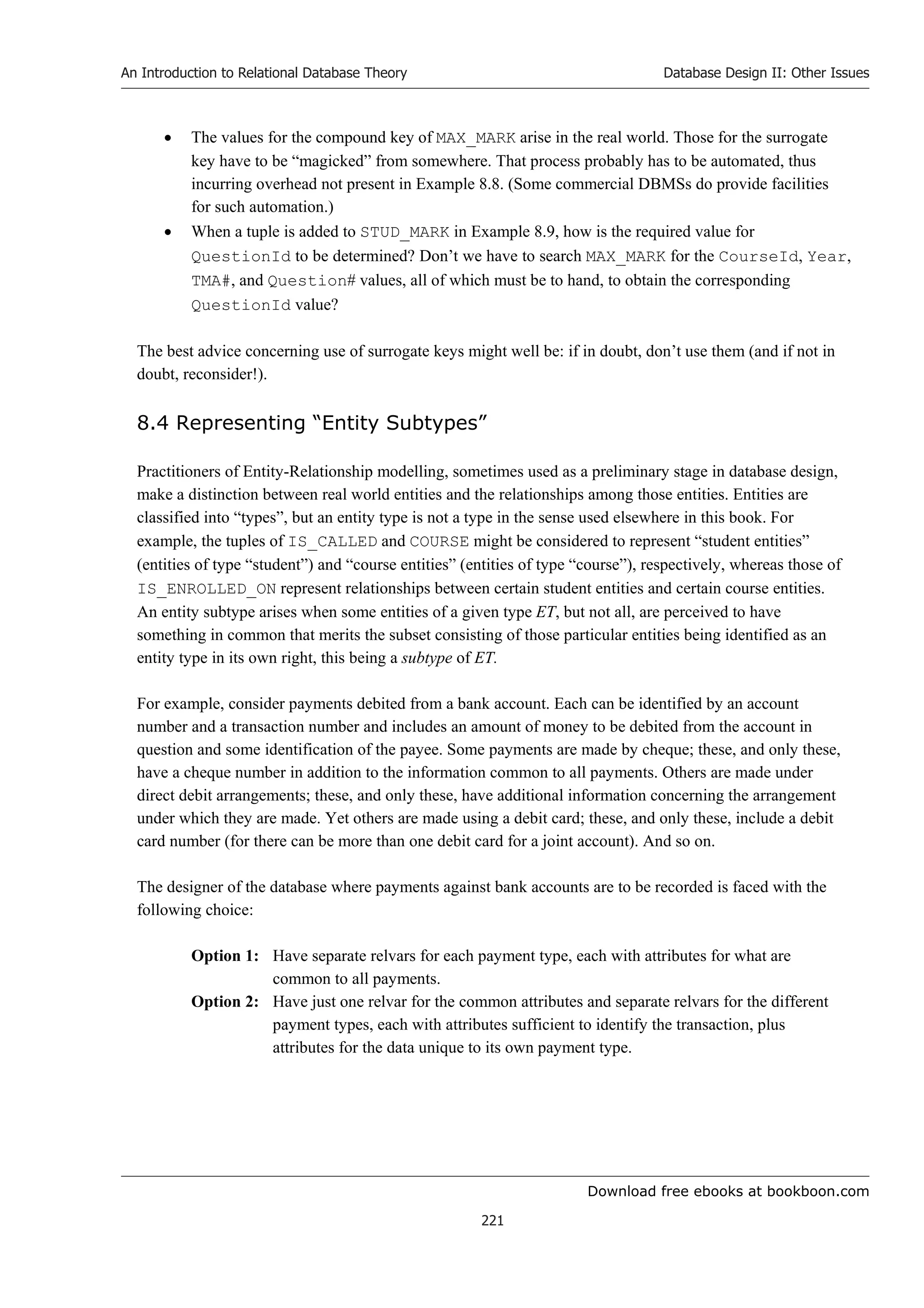

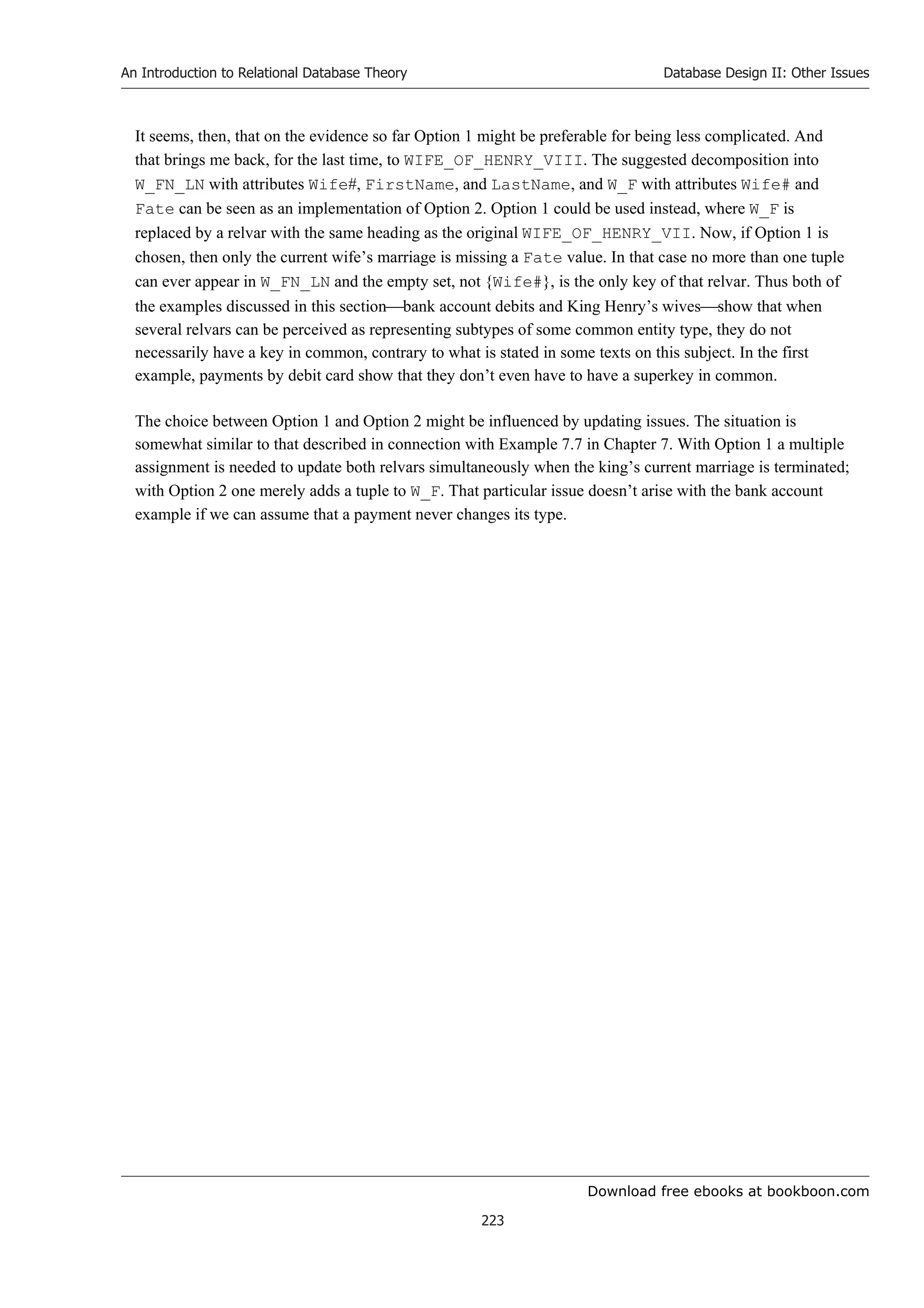
![Download free ebooks at bookboon.com
An Introduction to Relational Database Theory
224
Appendix A: Tutorial D Version 2
Appendix A: Tutorial D Version 2
The Tutorial D examples in this book use the syntax of Version 1 of that language, as defined in
reference [11] and implemented in the version of Rel that was current when this book was being drafted.
That drafting period coincided with the development of Version 2, subsequently published in reference
[10].
In this appendix I give just the changes in Version 2 that affect examples given in this book. I use the
abbreviations V1 and V2 for the two versions.
Please note that, contrary to what is stated in reference [9] under image relations, the syntax described
there does not appear in V2 but remains a suggestion under consideration.
Abbreviations
In V1 the type name CHARACTER can be abbreviated to CHAR. The following additional abbreviations
are defined in V2:
INT for INTEGER
RAT for RATIONAL
BOOL for BOOLEAN
REL for RELATION
TUP for TUPLE
DEE for TABLE_DEE
DUM for TABLE_DUM
Example values for scalar types
The syntax for a scalar type definition is extended to require an example value to be specified for the type
being defined, using the key word INIT (because the example value then becomes the default INIT value
in declarations of variables of the type in question). Suppose the supplier number S1 is to be the example
value for type SID. Then the definition for type SID given in Chapter 2 would be extended like this:
TYPE SID POSSREP SID { C CHAR
CONSTRAINT LENGTH(C) = 5
AND
STARTS_WITH(C, 'S')
AND
IS_DIGITS(SUBSTRING(C,1)))
}
INIT SID('S1');](https://image.slidesharecdn.com/an-introduction-to-relational-database-theory-230210032734-035be350/75/an-introduction-to-relational-database-theory-pdf-224-2048.jpg)
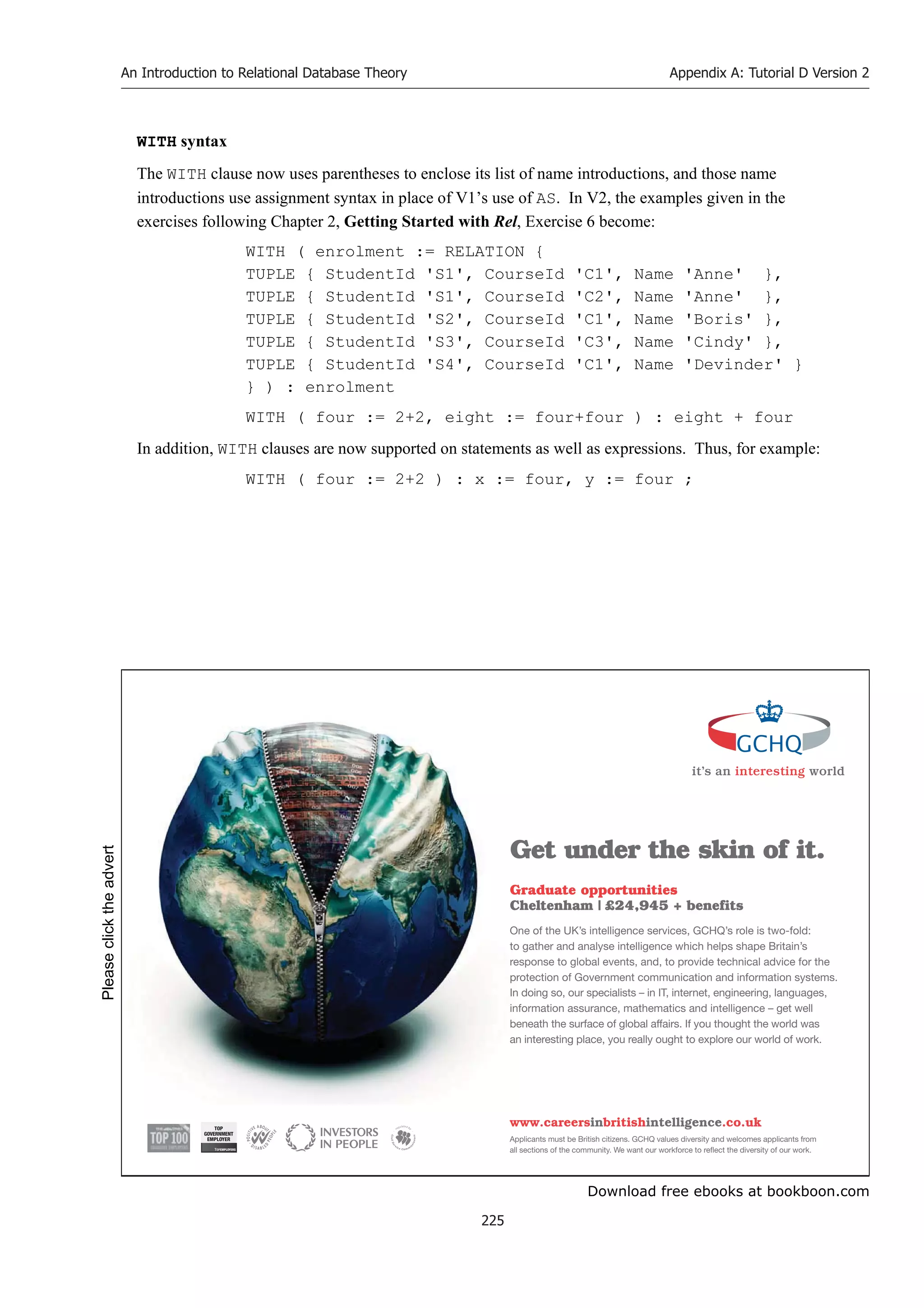
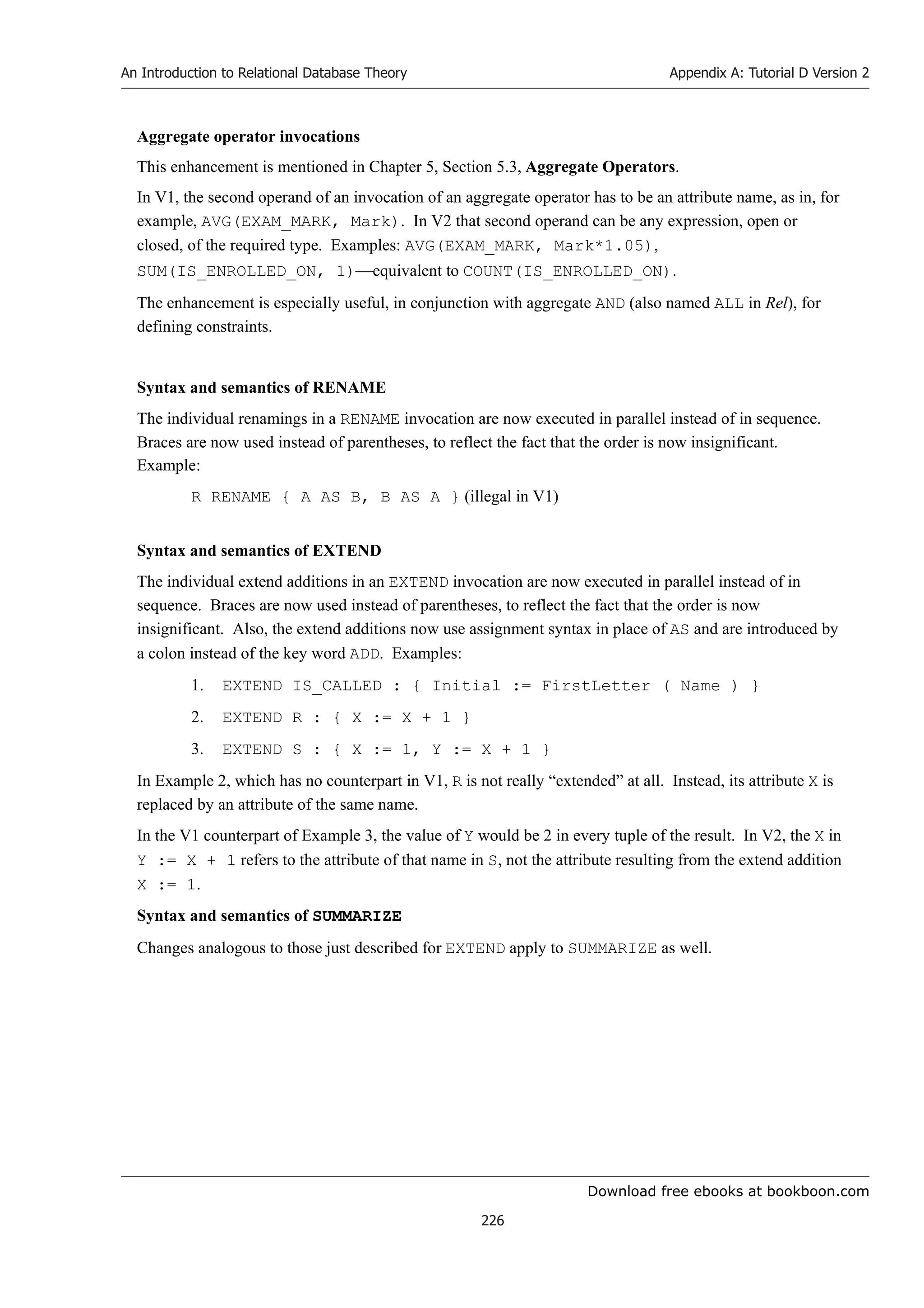
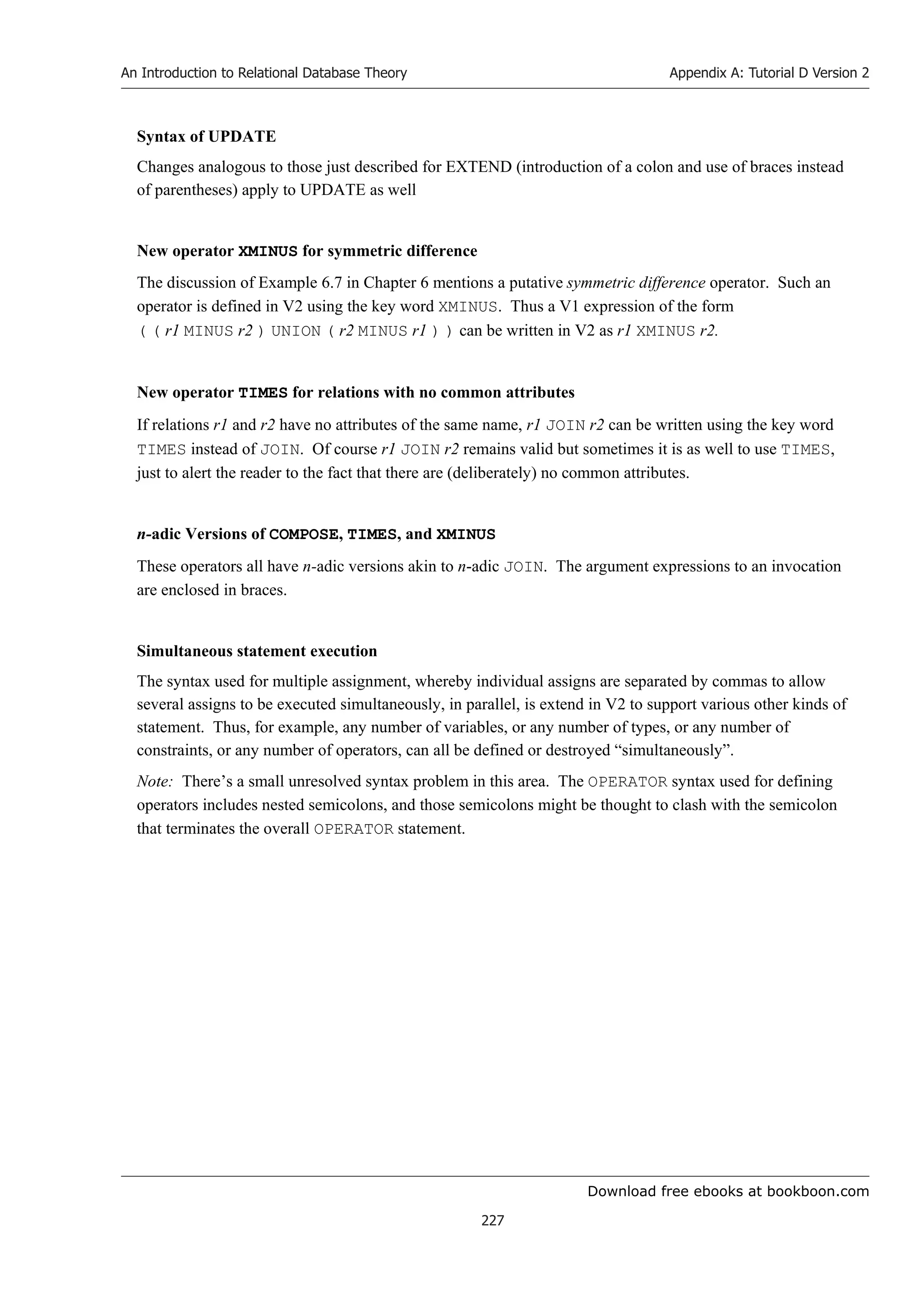
![Download free ebooks at bookboon.com
An Introduction to Relational Database Theory
228
Appendix B: References and Bibliography
Appendix B: References and Bibliography
In addition to the books and papers referenced in the body of the book I include three textbooks ([3], [7],
and [13]) that I have chosen from my own collection.
[1] http://en.wikipedia.org/wiki/Database
The article that caused me to reference Wikipedia in Chapter 1 has been significantly revised and
no longer includes the text I cited. The article should be treated with caution. For example, in
case it still refers to “Date’s Information Principle”, please note that the principle in question
actually originates from E.F. Codd.
[2] W.W. Armstrong: “Dependency Structures of Data Base Relationships”, Proc. IFIP Congress,
Stockholm, Sweden (1974).
[3] Paolo Atzeni and Valeria De Antonellis: Relational Database Theory. Redwood City, Ca.: The
Benjamin/Cummings Publishing Company, Inc. (1993).
The Preface begins, “This book presents a systematic treatment of the formal theory of the
relational model of data.” Here you will find many of the topics of the present bookand some
moretreated formally. You will need a good grounding in logic. Plenty of exercises. 386
pages.
[4] Luca Cardelli and Peter Wegner: “On Understanding Types, Data Abstraction, and
Polymorphism”, ACM Comp. Surv. 17, No. 4 (December 1985).
[5] E.F. Codd. “A Relational Model of Data for Large Shared Data Banks”, CACM 13, no. 6 (June
1970). Republished in “Milestones of Research”, CACM 25, No. 1 (January 1982).
Usually cited as the seminal paper that first introduced the relation model of data. Actually, Codd
originally published his idea a year earlier, in an IBM research report.
[6] E.F. Codd: “Recent Investigations into Relational Data Base Systems”, Proc. IFIP Congress,
Stockholm, Sweden (1974) and elsewhere.
[7] Thomas M. Connelly and Carolyn E. Begg: Database Systems, A Practical Approach to Design,
Implementation, and Management (3rd edition). Harlow, England: Pearson Education Limited
(2002).
A massive tome and a popular recommendation for the serious student or practictioner. 1236
pages.
[8] C.J. Date: An Introduction to Database Systems (8th edition). Reading, Mass: Addison-Wesley
(2004).
Perhaps the best known book on the subject, by the best known author. A sine qua non for all
database professionals in industry or academe. 983 pages. (But beware of its definition of 5NF,
which is not quite correct. It fails to take account of JDs containing redundant projections.)](https://image.slidesharecdn.com/an-introduction-to-relational-database-theory-230210032734-035be350/75/an-introduction-to-relational-database-theory-pdf-228-2048.jpg)
![Download free ebooks at bookboon.com
An Introduction to Relational Database Theory
229
Appendix B: References and Bibliography
[9] C.J. Date: The Relational Database Dictionary (extended edition). Berkeley, Ca.: Apress (2008).
An invaluable booklet for quick reference. (But again, beware of its definition of 5NF. Its
condition (a) propagates the error of [8] and its condition (b) is also erroneous.)
[10] C.J. Date and Hugh Darwen: Database Explorations: Essays on The Third Manifesto and Related
Topics. Bloomington, IN: Trafford Publishing (2010). See http://www.trafford.com/Bookstore.
[11] C.J. Date and Hugh Darwen: Databases, Types, and The Relational Model: The Third Manifesto
(3rd edition). Reading, Mass: Addison-Wesley (2007).
Related material, including a complete grammar for Tutorial D, can be found at
www.thethirdmanifesto.com.
[12] Ronald Fagin: “Normal forms and relational database operators”, Proc. 1979 ACM-SIGMOD (ed.
P.A. Bernstein) 153-160. Available at
http://www.almaden.ibm.com/cs/people/fagin/sigmod79.pdf
Here, slightly paraphrased, is the algorithm referred to in Chapter 7, Section 7.4, for determining
whether a given JD is implied by the keys of the applicable relvar.
Given a relvar R, a set S of keys {K1, …, Kn} of R, and a JD *{P1, …, Pm}: Initialize set T as
{P1, …, Pm}. Apply the following rule until it can no longer be applied: If Ki is a subset
of the intersection of Y and Z for some i (1in) and for distinct member Y and Z of T,
then replace Y and Z in T by the set that is the union of Y and Z (so the number of
members of T decreases by one). If, when the algorithm terminates, some member of T
contains every attribute of R, then the algorithm succeeds and the given JD is implied by
the keys of R; otherwise the algorithm fails and the given JD is not implied by the keys of
R.
[13] Lex de Haan and Toon Koppelaars: Applied Mathematics for Database Professionals. Berkeley,
Ca.: Apress (2007).
An “interestingly different” book on the theory and practice of relational databases that I
personally recommend. The book includes an excellent treatise on the design of procedural
methods for overcoming the deficiencies, in the area of integrity checking, of current SQL
implementations. These deficiencies are mentioned in Chapters 6 and 7of the present book.
[14] I.J. Heath: “Unacceptable File Operations in a Relational Database”, Proc. 1971 ACM SIGFIDET
Workshop on Data Description, Access, and Control, San Diego, Calif. (November 1971).](https://image.slidesharecdn.com/an-introduction-to-relational-database-theory-230210032734-035be350/75/an-introduction-to-relational-database-theory-pdf-229-2048.jpg)
![Download free ebooks at bookboon.com
An Introduction to Relational Database Theory
230
Notes
Notes
i
SQL is just a name and no great significance attaches to that name. The standard pronunciation, by the way, is
“ess-cue-ell”, not “sequel”. Hence, a DBMS that supports it is an SQL DBMS, not a SQL DBMS.
ii
Actually, there are two very special relations which cannot sensibly be depicted in tabular form. You will
encounter these two in Chapter 4.
iii
The precise meaning of this mathematical term is given in Chapter 3, “Predicates and Propositions”.
iv
An attribute also has a type but I defer discussion of that concept to Chapter 2, “Values, Types, Variables,
Operators”.
v
The less appropriate term statement is very commonly used instead of command, especially for certain kinds of
command; I use that term sometimes in this book, as you will see. The term imperative is also occasionally used.
vi
Some texts use the term query for such a command, and some even use it to refer to any command that might be
given to the DBMS, including commands that update the database.
vii
C.J. Date (co-designer of Tutorial D) makes a slightly different suggestion for granting permissions in his
Introduction to Database Systems (8th edition), on page 506.
viii
Some textbooks use the term full instantiation, regarding substitution of some but not all of the parameters as
“partial” instantiation. Personally, I find the notion of a “partial instance” (of a kind) rather weird!
ix
Russell considered the set whose elements are precisely those sets whose elements do not include themselves
(unlike, for example, the set of all sets, which clearly is one of its own elements). Is this set, or is it not, an element
of itself?
x
There is only one 0-tuple, . It is denoted by the literal TUPLE { } in Tutorial D.
xi
By the present author, in a journal article published in 1988.
xii
Recall that if a value i exists such that whenever i is one of the operands of a dyadic operator the result of invoking
that operator is the other operand, then i is said to be an identity value under that operator.
xiii
That is still a little loose, however. Recall that in general we speak of the image relation of a given tuple, not a
given attribute value, in a given relation. Strictly speaking, then, for each CourseId value appearing in
EXAM_MARK we take the tuple t consisting of just that attribute value and extend t with its image relation in
EXAM_MARK.
xiv
Tables are SQL’s nearest approximation to relations.
xv
The term “state” is used by some writers but that term carries extra connotations we don’t need. For consider, if
the collection of attribute values we call a tuple is itself a value, and if a relation, containing a set of tuples, is a value,
then the relations assigned to the relvars of a relational database might as well be collectively referred to as a single
value too.
xvi
Despite the fact that certain commercially available systems that call themselves DBMSs but nevertheless do
allow such intermediate states to be visible.
xvii
Recall that r1 MINUS r2 is equivalent to r1 NOT MATCHING r2 but requires r1 and r2 to be relations of the same
type.
xviii
They don’t support the international standard’s CREATE ASSERTION statement, which would be SQL’s
counterpart of Tutorial D’s CONSTRAINT statement, and they don’t permit table expressions to appear inside
SQL’s so-called “table constraints”.
xix
SQL uses parentheses instead of braces.
xx
Obviously it can be simplified by eliminating any one of the three conjuncts.
xxi
Workarounds for SQL databases, using triggered procedures, are described in depth in reference [13].
xxii
Strictly speaking a heading is a set of attribute name, type name pairs, but types are largely irrelevant in this
chapter and, for convenience and following common practice, I use the term heading to refer to a set of just attribute
names when no confusion can arise.](https://image.slidesharecdn.com/an-introduction-to-relational-database-theory-230210032734-035be350/75/an-introduction-to-relational-database-theory-pdf-230-2048.jpg)
